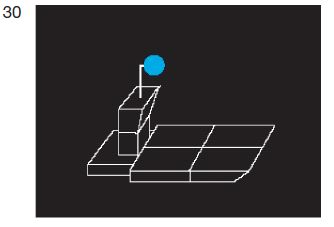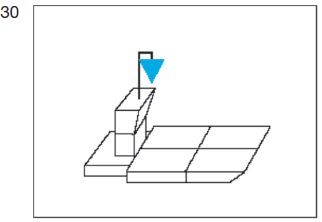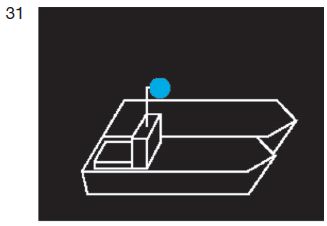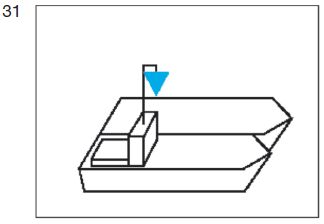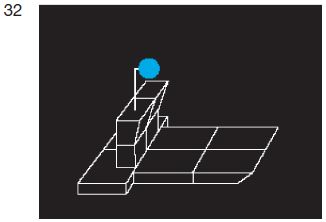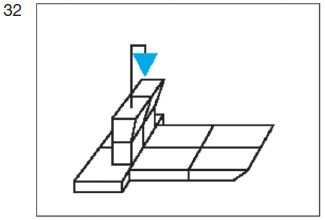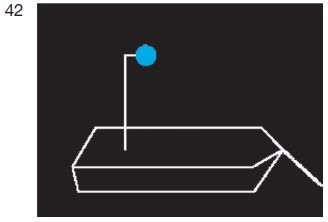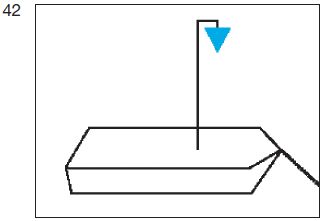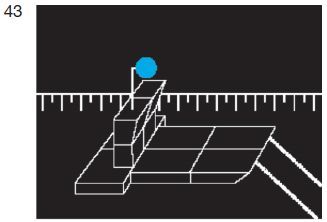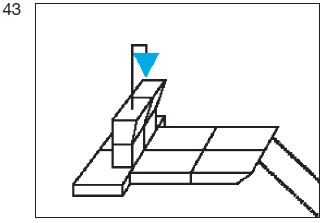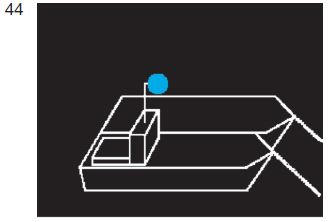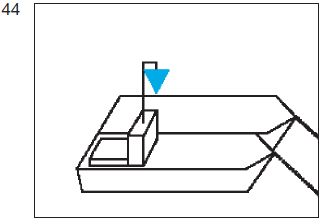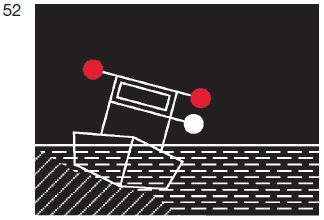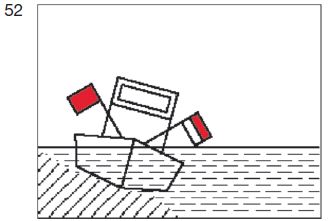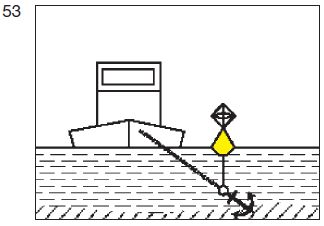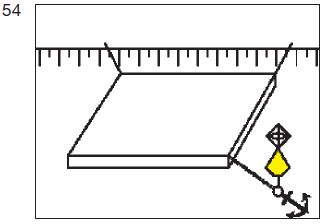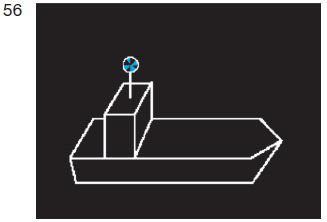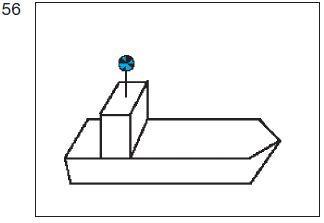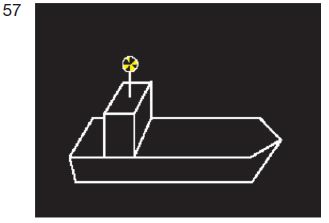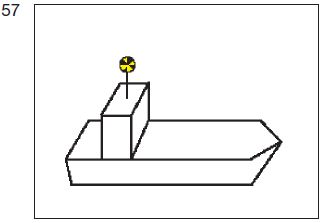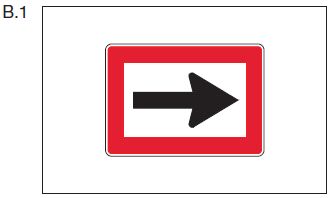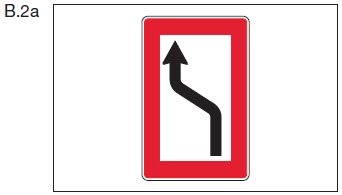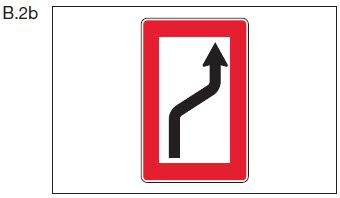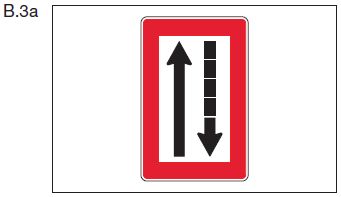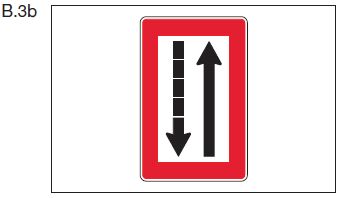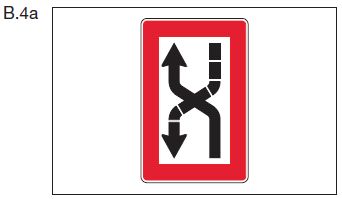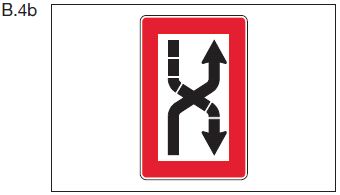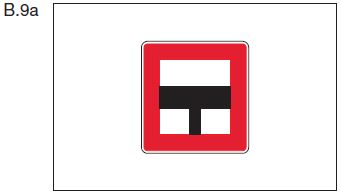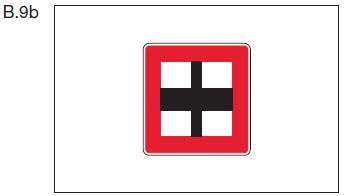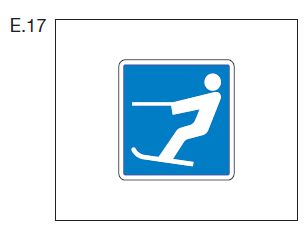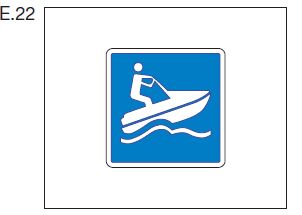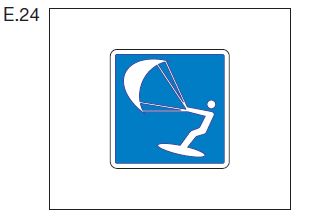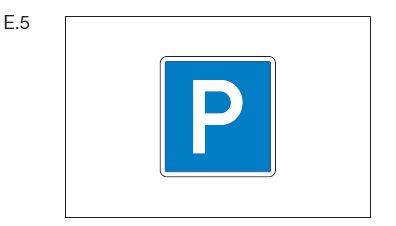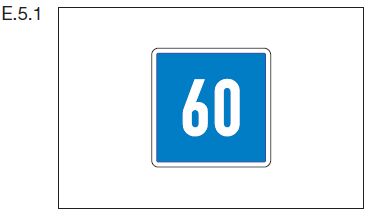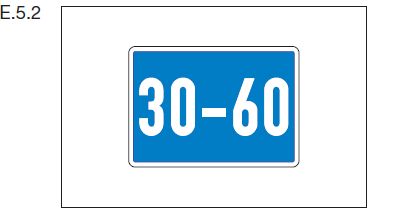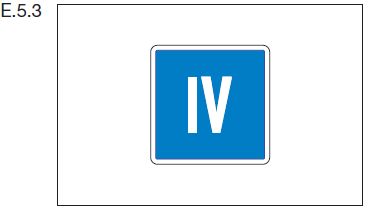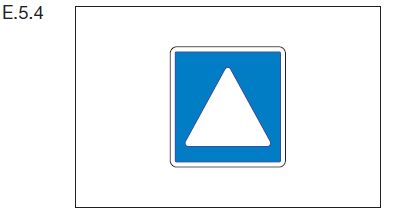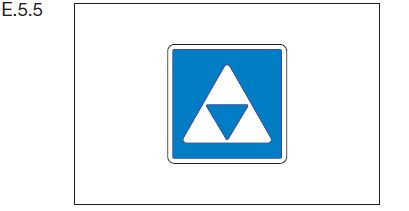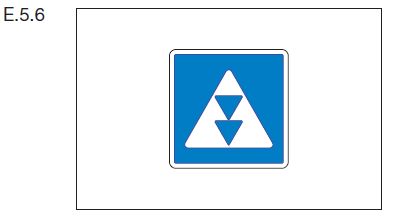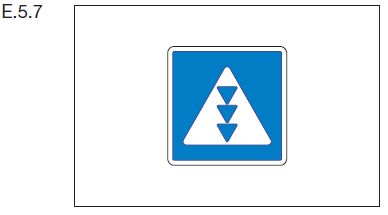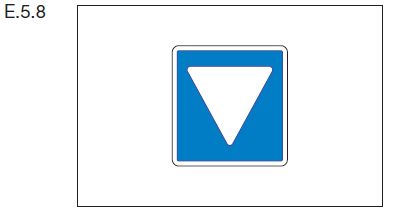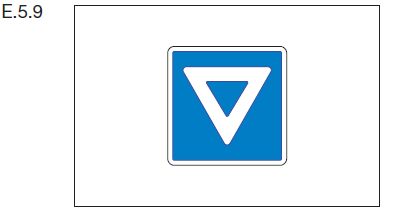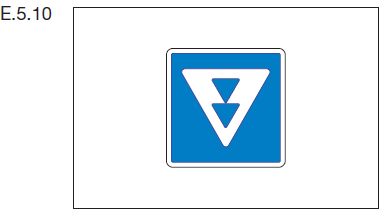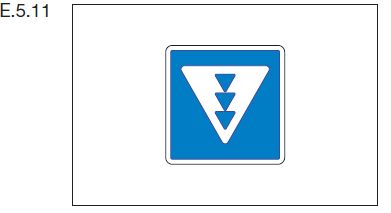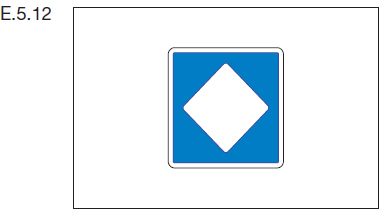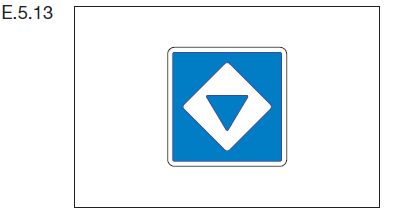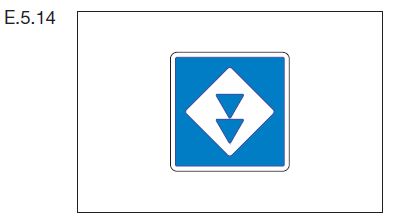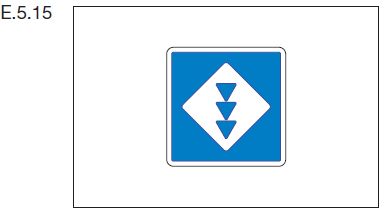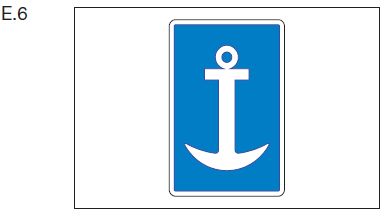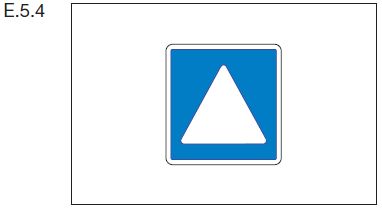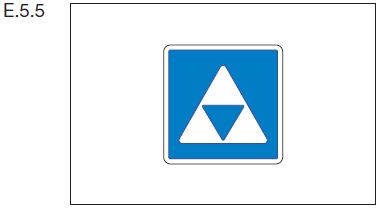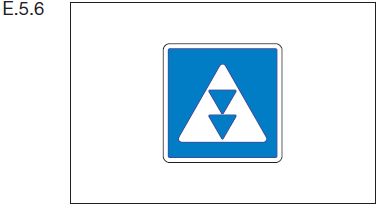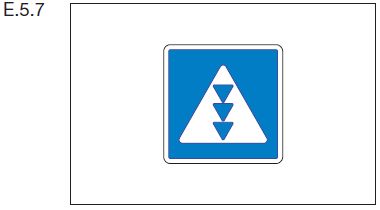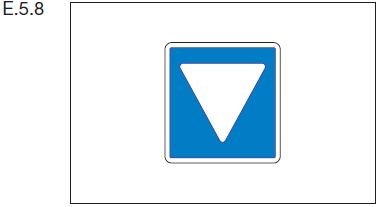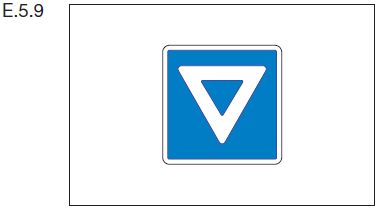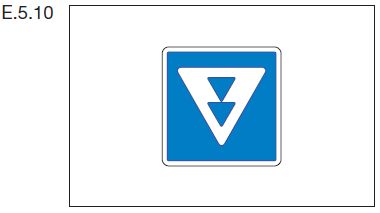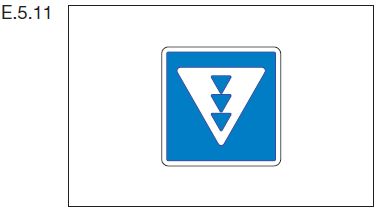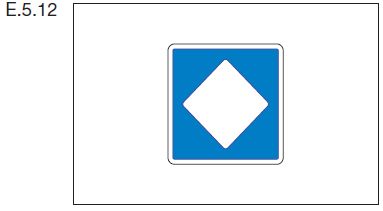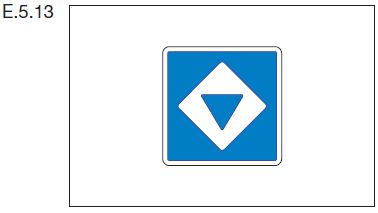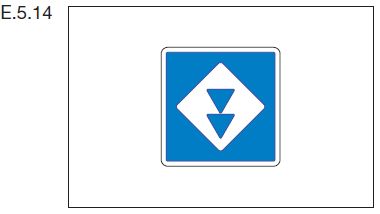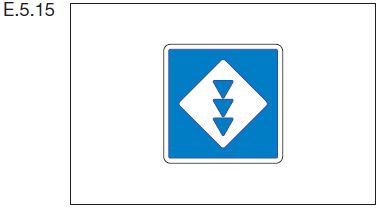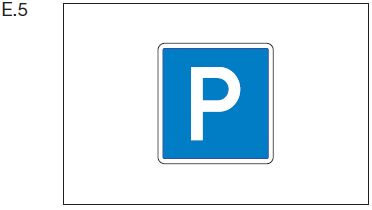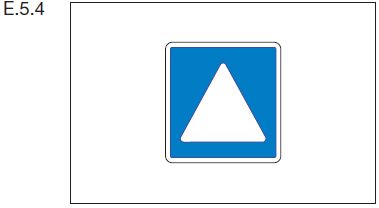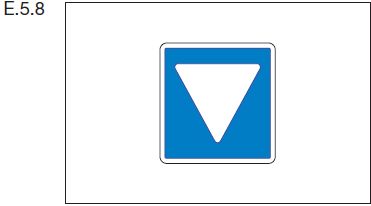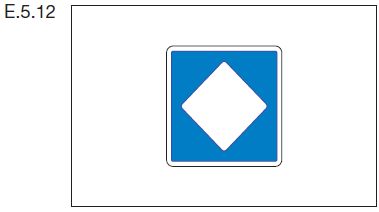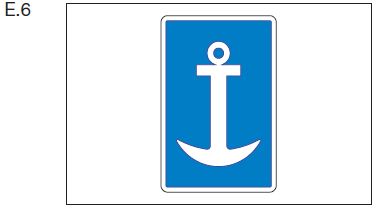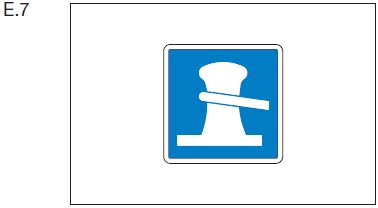Inland waterways order (BinSchStrO)
Unofficial table of contents
BinSchStrO
Date of completion: 16.12.2011
Full quote:
" Inland waterways order of 16 December 2011 (BGBl. 2012 I p. 2, 1666), as defined by Article 1 of the Regulation of 13 February 2015 (BGBl. 142) has been amended "
| Status: |
Last amended by Art. 2 § 9 V v. 20.12.2012 I 2802 |
| Note: |
Amendment by Art. 2 § 4 V v. 30.5.2014 I 610 (No. 23) in a textual, documentary form not yet concludedly edited |
| |
Amendment by Art. 1 V v. 13.2.2015 I 142 (No 6) in the form of a text, documentary evidence not yet concludedly processed |
For more details, please refer to the menu under
Notes
The obligations laid down in Directive 98 /34/EC of the European Parliament and of the Council of 22 June 1998 laying down a procedure for the provision of information in the field of technical standards and regulations and of the provisions relating to the services of The Information Society (OJ C 37), as last amended by Directive 2006 /96/EC (OJ L 327, 21.12.2006, p. 81), has been complied with.
Footnote
(+ + + Text evidence from: 1.2.2012 + + +)
(+ + + Official note from the norm-provider on EC law:
Consideration of
ERL 34/98 (CELEX Nr: 31998L0034) + + +)
(+ + + Text of the introductory regulation see: BinSchStrEV 2012 + + +)
Unofficial table of contents
table of contents
| Part one |
Common provisions for all
Inland waterways |
| |
|
|
| Chapter 1 |
| General provisions |
| |
|
|
| § § § |
|
|
| 1.01 |
Definitions |
| 1.02 |
Ship Guide |
| 1.03 |
Duties of crew and other persons on board |
| 1.04 |
General due diligence |
| 1.05 |
Behavior under special circumstances |
| 1.06 |
Use of the waterway |
| 1.07 |
Requirements for the loading and maximum number of passengers |
| 1.08 |
Construction, equipment and crew of the vehicles |
| 1.09 |
Occupation of the rudder |
| 1.10 |
Carrying out documents and other documents |
| 1.11 |
Driving the inland waterway system |
| 1.12 |
Hazards arising from items on board; loss of objects; shipping obstacles |
| 1.13 |
Protection of shipping signs |
| 1.14 |
Damage to the waterway or to installations |
| 1.15 |
Prohibition of the introduction of objects and other substances into the waterway |
| 1.16 |
Rescue and assistance |
| 1.17 |
Fixed or sunken vehicles; indication of accidents |
| 1.18 |
Freeming of the running water |
| 1.19 |
Special instructions |
| 1.20 |
Monitoring |
| 1.21 |
Special transport |
| 1.22 |
Temporary arrangements |
| 1.23 |
Permission of special events |
| 1.24 |
Special arrangements for vehicles in the public service and for water rescue vehicles |
| 1.25 |
Loading, deleting and lighters |
| 1.26 |
Speed |
| 1.27 |
Associations |
| |
|
|
| Chapter 2 |
the characteristics and the draught indicators of the vehicles;
Shipyards |
| |
|
|
| 2.01 |
Characteristics of vehicles, other than small vehicles and sea-ships |
| 2.02 |
Identification of small vehicles |
| 2.03 |
Shipyards |
| 2.04 |
Sunset marks and draught indicators |
| 2.05 |
Anchor tag |
| 2.06 |
Behavioural duties |
| |
|
|
| Chapter 3 |
| Name of vehicles |
| |
|
|
| Section I. General |
| |
| 3.01 |
Definitions and applications |
| 3.02 |
Lights and Signalleuchten |
| 3.03 |
Flags, plates and whimps |
| 3.04 |
Cylinders, balls and cones |
| 3.05 |
Forbidden or exceptionally approved lights and visual signs |
| 3.06 |
(no content) |
| 3.07 |
Forbidden use of lights, spotlights, visual signs and other objects |
| |
|
|
| Section II. Night and Tag Name |
| |
|
|
| |
Title A. Title during the journey |
| |
|
|
| 3.08 |
Designation of individually moving vehicles with machine drive |
| 3.09 |
Name of trawls in voyage |
| 3.10 |
Description of the drawers ' associations |
| 3.11 |
Description of coupled vehicles in voyage |
| 3.12 |
Designation of vehicles under sail |
| 3.13 |
Designation of small vehicles in voyage |
| 3.14 |
Additional designation of vehicles in the carriage of certain dangerous goods |
| 3.15 |
Description of vehicles registered for the carriage of more than 12 passengers and whose hull has a maximum length of less than 20.00 m |
| 3.16 |
Name of the ferries in voyage |
| 3.17 |
Additional designation of vehicles in travel which shall have priority |
| 3.18 |
Additional designation of maneuverable vehicles in voyage |
| 3.19 |
Name of floating bodies and floating installations in voyage |
| |
|
|
| |
Title B. Label when breastfeeding |
| |
|
|
| 3.20 |
Designation of vehicles when they are still in use |
| 3.21 |
Additional designation of stationary vehicles for the transport of certain dangerous goods |
| 3.22 |
Name of the ferries which are still at their landing place |
| 3.23 |
Name of the floating bodies and floating installations when they are still lying |
| 3.24 |
Description of certain stationary fishing vessels and of the nets or booms |
| 3.25 |
Designation of floating equipment at work, as well as fixed or cunted vehicles |
| 3.26 |
Additional designation of the vehicles, floating bodies and floating installations, the anchors of which may endanger the shipping, and their anchors |
| |
|
|
| Section III. Other name |
| |
|
|
| 3.27 |
Name of vehicles of the surveillance authorities |
| 3.28 |
Additional designation of the vehicles running in the waterway |
| 3.28a |
Designation and driving rules for multi-purpose vehicles of the Bundeswehr |
| 3.29 |
Protection against sog and wave impact |
| 3.30 |
NotCharacter |
| 3.31 |
Notice of the ban on entering the vehicle |
| 3.32 |
Indication of the ban to smoke, use unprotected light or fire |
| 3.33 |
Reference to the ban on breastfeeding side-by-side |
| |
|
|
| Section IV. Obligations |
| |
|
|
| 3.34 |
Behavioural duties |
| |
|
|
| Chapter 4 |
sound signs of the vehicles;
Voice radio, navigation devices |
| |
|
|
| Section I. Sound signs |
| |
|
|
| 4.01 |
General |
| 4.02 |
Use of the sound signals |
| 4.03 |
Forbidden Sound |
| 4.04 |
NotCharacter |
| |
|
|
| Section II. Voice Radio |
| 4.05 |
Voice Radio |
| |
|
|
| Section III. Navigation Devices |
| |
|
|
| 4.06 |
Radar |
| 4.07 |
|
Inland AIS Devices |
| |
|
|
| Chapter 5 |
shipping signs and
Name of the waterway |
| |
|
|
| 5.01 |
Shipping signs |
| 5.02 |
Name of the waterway |
| |
|
|
| Chapter 6 |
| Driving Rules |
| |
|
|
| Section I. General |
| |
|
|
| 6.01 |
(no content) |
| 6.02 |
Mutual behaviour of small vehicles and other vehicles |
| 6.02a |
Special driving rules for small vehicles |
| |
|
|
Section II. Encounter, crosses
and overtaking |
| |
|
|
| 6.03 |
General principles |
| 6.03a |
Cross |
| 6.04 |
General provisions for the Encounter |
| 6.05 |
Exceptions to the general provisions governing the encounter |
| 6.06 |
(no content) |
| 6.07 |
Encounter in tight drivings |
| 6.08 |
Counter-forbidden by shipping signs |
| 6.09 |
General provisions for overtaking |
| 6.10 |
Behaviour and drawing of vehicles during overtaking |
| 6.11 |
Ban on overtaking by shipping signs |
| |
|
|
| Section III. More rules for driving |
| |
|
|
| 6.12 |
Travel on routes with pre-written course |
| 6.13 |
Apply |
| 6.14 |
Behaviour on departure |
| 6.15 |
Ban on moving into the distances between parts of an entrainers ' association |
| 6.16 |
Crossing the waterway; driveway in and exit from ports and side waterways |
| 6.17 |
Driving at the same level; Prohibition of approximation to vehicles |
| 6.18 |
Prohibition of the looping of anchors, trosses or chains |
| 6.19 |
Shipping by driver classes |
| 6.20 |
Avoidance of wave impact |
| 6.21 |
Compilation of associations |
| 6.22 |
Closure of shipping and blocked water areas |
| 6.22a |
Passing by floating equipment at work and on fixed or sunken vehicles |
| |
|
|
| Section IV. Ferries |
| |
|
|
| 6.23 |
Behaviour of ferries |
| |
|
|
Section V. Passing through bridges,
Rifles and locks |
| |
|
|
| 6.24 |
General rules for the passage of bridges and weirs |
| 6.25 |
Passage under solid bridges |
| 6.26 |
Moving through moving bridges |
| 6.27 |
Passing the weirs |
| 6.28 |
Passing through the locks |
| 6.28a |
Lock-in and exit |
| 6.29 |
Order of the floodgates |
| 6.29a |
Passing the ship's lift |
| |
|
|
Section VI. Unsatiable weather;
Use of radar |
| |
|
|
| 6.30 |
General rules for driving in unsatiable weather |
| 6.31 |
Stationary vehicles |
| 6.32 |
Vehicles travelling with radar |
| 6.33 |
Vehicles not travelling with radar |
| 6.34 |
Deviating rules for driving in unsatiable weather |
| |
|
|
| Section VII. Obligations |
| |
|
|
| 6.35 |
Behavioural duties |
| |
|
|
| Chapter 7 |
rules for breastfeeding,
the anchorage and the celebration |
| |
|
|
| 7.01 |
General principles governing the standstill |
| 7.02 |
Ban |
| 7.03 |
Anchors and use of piles |
| 7.04 |
Commit |
| 7.05 |
Berths |
| 7.06 |
Special berths |
| 7.07 |
Minimum distances for the transport of certain dangerous goods during the standstill |
| 7.08 |
Wache and supervision |
| 7.09 |
Behavioural duties |
| |
|
|
| Chapter 8 |
| Additional provisions |
| |
|
|
| 8.01 |
Maximum dimensions of the vehicles |
| 8.02 |
Dragged drawers and dragged drawers |
| 8.03 |
Drawers ' associations carrying other vehicles as a shoe |
| 8.04 |
Drawers ' associations carrying carrier ships more easily |
| 8.05 |
Movement of thrust chords outside of a pusher band |
| 8.06 |
Clutches of the drawers |
| 8.07 |
Speaking connection to associations |
| 8.08 |
Walkability of the Drawers ' Associations |
| 8.09 |
Lead-away signal |
| 8.10 |
Bade and swimming ban |
| 8.11 |
Description of fishing gear |
| 8.12 |
Name when used by divers |
| 8.13 |
Ban on kitesurfing |
| 8.14 |
Behavioural duties |
| |
|
|
| Chapter 9 |
| Passenger shipping |
| |
|
|
| 9.01 |
Timetables |
| 9.02 |
Landing Points |
| 9.03 |
Ship traffic at the landing places |
| 9.04 |
Passengers ' boarding and boarding |
| 9.05 |
Dismissal of passengers |
| 9.06 |
Safety on board and at the landing sites |
| 9.07 |
Safety on board of vehicles registered for the carriage and overnight accommodation of more than 12 passengers |
| 9.08 |
Passenger Barkers |
| |
|
|
| Part two |
Additional provisions for
single inland waterways |
| |
|
|
| Chapter 10 |
| Neckar |
| |
|
|
| 10.01 |
Scope |
| 10.02 |
Dimensions of vehicles and federations, driverine depth |
| 10.03 |
Compilation of associations |
| 10.04 |
Speed |
| 10.05 |
Uphill |
| 10.06 |
Encounter |
| 10.07 |
Overtaking |
| 10.08 |
Apply |
| 10.09 |
Anchor |
| 10.10 |
Quiesce |
| 10.11 |
Shipping at high tide |
| 10.12 |
Shipping on ice |
| 10.13 |
Night shipping |
| 10.14 |
Use of carrier ship lighters |
| 10.15 |
Reporting obligation |
| 10.16 |
Height of bridges, other fixed superstructures and overhead lines |
| 10.17 |
Marking of bridges and weir passes |
| 10.18 |
Passing through the bridges, locking mechanisms, weirs, locks and individual power lines |
| 10.19 |
Use of floodgates, boat locks and boat transfer systems |
| 10.20 |
Sailing |
| 10.21 |
Name of vehicles |
| 10.22 |
Rules on transport |
| 10.23 |
Rules for speech radio |
| 10.24 |
Special provisions for small vehicles |
| 10.25 |
Transport of waste water, canals and individual waterways |
| 10.26 |
Protection of the channels and installations |
| 10.27 |
Traffic restrictions on shipping |
| 10.28 |
Use of waterways |
| 10.29 |
Behavioural duties of the skipper, the crew on board, the owner and the exporter |
| |
|
|
| Chapter 11 |
| Main |
| |
|
|
| 11.01 |
Scope |
| 11.02 |
Dimensions of vehicles and associations, depth of travel and width |
| 11.03 |
Compilation of associations |
| 11.04 |
Speed |
| 11.05 |
Uphill |
| 11.06 |
Encounter |
| 11.07 |
Overtaking |
| 11.08 |
Apply |
| 11.09 |
Anchor |
| 11.10 |
Quiesce |
| 11.11 |
Shipping at high tide |
| 11.12 |
Shipping on ice |
| 11.13 |
Night shipping |
| 11.14 |
Use of carrier ship lighters |
| 11.15 |
Reporting obligation |
| 11.16 |
Height of bridges, other fixed superstructures and overhead lines |
| 11.17 |
Marking of bridges and weir passes |
| 11.18 |
Passing through the bridges, locking mechanisms, weirs, locks and individual power lines |
| 11.19 |
Use of floodgates, boat locks and boat transfer systems |
| 11.20 |
Sailing |
| 11.21 |
Name of vehicles |
| 11.22 |
Rules on transport |
| 11.23 |
Rules for speech radio |
| 11.24 |
Special provisions for small vehicles |
| 11.25 |
Transport of waste water, canals and individual waterways |
| 11.26 |
Protection of the channels and installations |
| 11.27 |
Traffic restrictions on shipping |
| 11.28 |
Use of waterways |
| 11.29 |
Behavioural duties of the skipper, the crew on board, the owner and the exporter |
| |
|
|
| Chapter 12 |
| Main-Danube Canal |
| |
|
|
| 12.01 |
Scope |
| 12.02 |
Dimensions of vehicles and associations, depth of travel and unloading depth |
| 12.03 |
Compilation of associations |
| 12.04 |
Speed |
| 12.05 |
Uphill |
| 12.06 |
Encounter |
| 12.07 |
Overtaking |
| 12.08 |
Apply |
| 12.09 |
Anchor |
| 12.10 |
Quiesce |
| 12.11 |
Shipping at high tide |
| 12.12 |
Shipping on ice |
| 12.13 |
Night shipping |
| 12.14 |
Use of carrier ship lighters |
| 12.15 |
Reporting obligation |
| 12.16 |
Height of bridges, other fixed superstructures and overhead lines |
| 12.17 |
Marking of bridges and weir passes |
| 12.18 |
Passing through the bridges, locking mechanisms, weirs, locks and individual power lines |
| 12.19 |
Use of floodgates, boat locks and boat transfer systems |
| 12.20 |
Sailing |
| 12.21 |
Name of vehicles |
| 12.22 |
Rules on transport |
| 12.23 |
Rules for speech radio |
| 12.24 |
Special provisions for small vehicles |
| 12.25 |
Transport of waste water, canals and individual waterways |
| 12.26 |
Protection of the channels and installations |
| 12.27 |
Traffic restrictions on shipping |
| 12.28 |
Use of waterways |
| 12.29 |
Behavioural duties of the skipper, the crew on board, the owner and the exporter |
| |
|
|
| Chapter 13 |
| Lahn |
| |
|
|
| 13.01 |
Scope |
| 13.02 |
Dimensions of vehicles and federations, driverine depth |
| 13.03 |
Compilation of associations |
| 13.04 |
Speed |
| 13.05 |
Uphill |
| 13.06 |
Encounter |
| 13.07 |
Overtaking |
| 13.08 |
Apply |
| 13.09 |
Anchor |
| 13.10 |
Quiesce |
| 13.11 |
Shipping at high tide |
| 13.12 |
Shipping on ice |
| 13.13 |
Night shipping |
| 13.14 |
Use of carrier ship lighters |
| 13.15 |
Reporting obligation |
| 13.16 |
Height of bridges, other fixed superstructures and overhead lines |
| 13.17 |
Marking of bridges and weir passes |
| 13.18 |
Passing through the bridges, locking mechanisms, weirs, locks and individual power lines |
| 13.19 |
Use of floodgates, boat locks and boat transfer systems |
| 13.20 |
Sailing |
| 13.21 |
Name of vehicles |
| 13.22 |
Rules on transport |
| 13.23 |
Rules for speech radio |
| 13.24 |
Special provisions for small vehicles |
| 13.25 |
Transport of waste water, canals and individual waterways |
| 13.26 |
Protection of the channels and installations |
| 13.27 |
Traffic restrictions on shipping |
| 13.28 |
Use of waterways |
| 13.29 |
Behavioural duties of the skipper, the crew on board, the owner and the exporter |
| |
|
|
| Chapter 14 |
| Navigating the Rhine-Kleve |
| |
|
|
| 14.01 |
Scope |
| 14.02 |
Dimensions of vehicles and federations, driverine depth |
| 14.03 |
Compilation of associations |
| 14.04 |
Speed |
| 14.05 |
Uphill |
| 14.06 |
Encounter |
| 14.07 |
Overtaking |
| 14.08 |
Apply |
| 14.09 |
Anchor |
| 14.10 |
Quiesce |
| 14.11 |
Shipping at high tide |
| 14.12 |
Shipping on ice |
| 14.13 |
Night shipping |
| 14.14 |
Use of carrier ship lighters |
| 14.15 |
Reporting obligation |
| 14.16 |
Height of bridges, other fixed superstructures and overhead lines |
| 14.17 |
Marking of bridges and weir passes |
| 14.18 |
Passing through the bridges, locking mechanisms, weirs, locks and individual power lines |
| 14.19 |
Use of floodgates, boat locks and boat transfer systems |
| 14.20 |
Sailing |
| 14.21 |
Name of vehicles |
| 14.22 |
Rules on transport |
| 14.23 |
Rules for speech radio |
| 14.24 |
Special provisions for small vehicles |
| 14.25 |
Transport of waste water, canals and individual waterways |
| 14.26 |
Protection of the channels and installations |
| 14.27 |
Traffic restrictions on shipping |
| 14.28 |
Use of waterways |
| 14.29 |
Behavioural duties of the skipper, the crew on board, the owner and the exporter |
| |
|
|
| Chapter 15 |
| North German channels |
| |
|
|
| 15.01 |
Scope |
| 15.02 |
Dimensions of vehicles and federations, unloading depth |
| 15.03 |
Compilation of associations |
| 15.04 |
Speed |
| 15.05 |
Uphill |
| 15.06 |
Encounter |
| 15.07 |
Overtaking |
| 15.08 |
Apply |
| 15.09 |
Anchor |
| 15.10 |
Quiesce |
| 15.11 |
Shipping at high tide |
| 15.12 |
Shipping on ice |
| 15.13 |
Night shipping |
| 15.14 |
Use of carrier ship lighters |
| 15.15 |
Reporting obligation |
| 15.16 |
Height of bridges, other fixed superstructures and overhead lines |
| 15.17 |
Marking of bridges and weir passes |
| 15.18 |
Passing through the bridges, locking mechanisms, weirs, locks and individual power lines |
| 15.19 |
Use of floodgates, boat locks and boat transfer systems |
| 15.20 |
Sailing |
| 15.21 |
Name of vehicles |
| 15.22 |
Rules on transport |
| 15.23 |
Rules for speech radio |
| 15.24 |
Special provisions for small vehicles |
| 15.25 |
Transport of waste water, canals and individual waterways |
| 15.26 |
Protection of the channels and installations |
| 15.27 |
Traffic restrictions on shipping |
| 15.28 |
Use of waterways |
| 15.29 |
Behavioural duties of the skipper, the crew on board, the owner and the exporter |
| 15.30 |
Closure of the locking gate at Artlenburg (Elbe-Seitenkanal) |
| |
|
|
| Chapter 16 |
| Weseriet |
| |
|
|
| 16.01 |
Scope |
| 16.02 |
Dimensions of vehicles and associations, depth of travel and unloading depth |
| 16.03 |
Compilation of associations |
| 16.04 |
Speed |
| 16.05 |
Uphill |
| 16.06 |
Encounter |
| 16.07 |
Overtaking |
| 16.08 |
Apply |
| 16.09 |
Anchor |
| 16.10 |
Quiesce |
| 16.11 |
Shipping at high tide |
| 16.12 |
Shipping on ice |
| 16.13 |
Night shipping |
| 16.14 |
Use of carrier ship lighters |
| 16.15 |
Reporting obligation |
| 16.16 |
Height of bridges, other fixed superstructures and overhead lines |
| 16.17 |
Marking of bridges and weir passes |
| 16.18 |
Passing through the bridges, locking mechanisms, weirs, locks and individual power lines |
| 16.19 |
Use of floodgates, boat locks and boat transfer systems |
| 16.20 |
Sailing |
| 16.21 |
Name of vehicles |
| 16.22 |
Rules on transport |
| 16.23 |
Rules for speech radio |
| 16.24 |
Special provisions for small vehicles |
| 16.25 |
Transport of waste water, canals and individual waterways |
| 16.26 |
Protection of the channels and installations |
| 16.27 |
Traffic restrictions on shipping |
| 16.28 |
Use of waterways |
| 16.29 |
Behavioural duties of the skipper, the crew on board, the owner and the exporter |
| |
|
|
| Chapter 17 |
| Elbe |
| |
|
|
| 17.01 |
Scope |
| 17.02 |
Dimensions of vehicles and associations, depth of travel and unloading depth |
| 17.03 |
Compilation of associations |
| 17.04 |
Speed |
| 17.05 |
Uphill |
| 17.06 |
Encounter |
| 17.07 |
Overtaking |
| 17.08 |
Apply |
| 17.09 |
Anchor |
| 17.10 |
Quiesce |
| 17.11 |
Shipping at high tide |
| 17.12 |
Shipping on ice |
| 17.13 |
Night shipping |
| 17.14 |
Use of carrier ship lighters |
| 17.15 |
Reporting obligation |
| 17.16 |
Height of bridges, other fixed superstructures and overhead lines |
| 17.17 |
Marking of bridges and weir passes |
| 17.18 |
Passing through the bridges, locking mechanisms, weirs, locks and individual power lines |
| 17.19 |
Use of floodgates, boat locks and boat transfer systems |
| 17.20 |
Sailing |
| 17.21 |
Name of vehicles |
| 17.22 |
Rules on transport |
| 17.23 |
Rules for speech radio |
| 17.24 |
Special provisions for small vehicles |
| 17.25 |
Transport of waste water, canals and individual waterways |
| 17.26 |
Protection of the channels and installations |
| 17.27 |
Traffic restrictions on shipping |
| 17.28 |
Use of waterways |
| 17.29 |
Behavioural duties of the skipper, the crew on board, the owner and the exporter |
| |
|
|
| Chapter 18 |
| Ilmenau |
| |
|
|
| 18.01 |
Scope |
| 18.02 |
Dimensions of vehicles and federations, unloading depth |
| 18.03 |
Compilation of associations |
| 18.04 |
Speed |
| 18.05 |
Uphill |
| 18.06 |
Encounter |
| 18.07 |
Overtaking |
| 18.08 |
Apply |
| 18.09 |
Anchor |
| 18.10 |
Quiesce |
| 18.11 |
Shipping at high tide |
| 18.12 |
Shipping on ice |
| 18.13 |
Night shipping |
| 18.14 |
Use of carrier ship lighters |
| 18.15 |
Reporting obligation |
| 18.16 |
Height of bridges, other fixed superstructures and overhead lines |
| 18.17 |
Marking of bridges and weir passes |
| 18.18 |
Passing through the bridges, locking mechanisms, weirs, locks and individual power lines |
| 18.19 |
Use of floodgates, boat locks and boat transfer systems |
| 18.20 |
Sailing |
| 18.21 |
Name of vehicles |
| 18.22 |
Rules on transport |
| 18.23 |
Rules for speech radio |
| 18.24 |
Special provisions for small vehicles |
| 18.25 |
Transport of waste water, canals and individual waterways |
| 18.26 |
Protection of the channels and installations |
| 18.27 |
Traffic restrictions on shipping |
| 18.28 |
Use of waterways |
| 18.29 |
Behavioural duties of the skipper, the crew on board, the owner and the exporter |
| |
|
|
| Chapter 19 |
| Elbe-Lübeck-Canal and Canal Trave |
| |
|
|
| 19.01 |
Scope |
| 19.02 |
Dimensions of vehicles and federations, unloading depth |
| 19.03 |
Compilation of associations |
| 19.04 |
Speed |
| 19.05 |
Uphill |
| 19.06 |
Encounter |
| 19.07 |
Overtaking |
| 19.08 |
Apply |
| 19.09 |
Anchor |
| 19.10 |
Quiesce |
| 19.11 |
Shipping at high tide |
| 19.12 |
Shipping on ice |
| 19.13 |
Night shipping |
| 19.14 |
Use of carrier ship lighters |
| 19.15 |
Reporting obligation |
| 19.16 |
Height of bridges, other fixed superstructures and overhead lines |
| 19.17 |
Marking of bridges and weir passes |
| 19.18 |
Passing through the bridges, locking mechanisms, weirs, locks and individual power lines |
| 19.19 |
Use of floodgates, boat locks and boat transfer systems |
| 19.20 |
Sailing |
| 19.21 |
Name of vehicles |
| 19.22 |
Rules on transport |
| 19.23 |
Rules for speech radio |
| 19.24 |
Special provisions for small vehicles |
| 19.25 |
Transport of waste water, canals and individual waterways |
| 19.26 |
Protection of the channels and installations |
| 19.27 |
Traffic restrictions on shipping |
| 19.28 |
Use of waterways |
| 19.29 |
Behavioural duties of the skipper, the crew on board, the owner and the exporter |
| |
|
|
| Chapter 20 |
| Saar |
| |
|
|
| 20.01 |
Scope |
| 20.02 |
Dimensions of vehicles and federations, driverine depth |
| 20.03 |
Compilation of associations |
| 20.04 |
Speed |
| 20.05 |
Uphill |
| 20.06 |
Encounter |
| 20.07 |
Overtaking |
| 20.08 |
Apply |
| 20.09 |
Anchor |
| 20.10 |
Quiesce |
| 20.11 |
Shipping at high tide |
| 20.12 |
Shipping on ice |
| 20.13 |
Night shipping |
| 20.14 |
Use of carrier ship lighters |
| 20.15 |
Reporting obligation |
| 20.16 |
Height of bridges, other fixed superstructures and overhead lines |
| 20.17 |
Marking of bridges and weir passes |
| 20.18 |
Passing through the bridges, locking mechanisms, weirs, locks and individual power lines |
| 20.19 |
Use of floodgates, boat locks and boat transfer systems |
| 20.20 |
Sailing |
| 20.21 |
Name of vehicles |
| 20.22 |
Rules on transport |
| 20.23 |
Rules for speech radio |
| 20.24 |
Special provisions for small vehicles |
| 20.25 |
Transport of waste water, canals and individual waterways |
| 20.26 |
Protection of the channels and installations |
| 20.27 |
Traffic restrictions on shipping |
| 20.28 |
Use of waterways |
| 20.29 |
Behavioural duties of the skipper, the crew on board, the owner and the exporter |
| |
|
|
| Chapter 21 |
Spree-Or-waterway,
Berliner and Brandenburger Waterways |
| |
|
|
| 21.01 |
Scope |
| 21.02 |
Dimensions of vehicles and federations, unloading depth |
| 21.03 |
Compilation of associations |
| 21.04 |
Speed |
| 21.05 |
Uphill |
| 21.06 |
Encounter |
| 21.07 |
Overtaking |
| 21.08 |
Apply |
| 21.09 |
Anchor |
| 21.10 |
Quiesce |
| 21.11 |
Shipping at high tide |
| 21.12 |
Shipping on ice |
| 21.13 |
Night shipping |
| 21.14 |
Use of carrier ship lighters |
| 21.15 |
Reporting obligation |
| 21.16 |
Height of bridges, other fixed superstructures and overhead lines |
| 21.17 |
Marking of bridges and weir passes |
| 21.18 |
Passing through the bridges, locking mechanisms, weirs, locks and individual power lines |
| 21.19 |
Use of floodgates, boat locks and boat transfer systems |
| 21.20 |
Sailing |
| 21.21 |
Name of vehicles |
| 21.22 |
Rules on transport |
| 21.23 |
Rules for speech radio |
| 21.24 |
Special provisions for small vehicles |
| 21.25 |
Transport of waste water, canals and individual waterways |
| 21.26 |
Protection of the channels and installations |
| 21.27 |
Traffic restrictions on shipping |
| 21.28 |
Use of waterways |
| 21.29 |
Behavioural duties of the skipper, the crew on board, the owner and the exporter |
| |
|
|
| Chapter 22 |
| Lower Havel waterway and Havelkanal |
| |
|
|
| 22.01 |
Scope |
| 22.02 |
Dimensions of vehicles and associations, depth of travel and unloading depth |
| 22.03 |
Compilation of associations |
| 22.04 |
Speed |
| 22.05 |
Uphill |
| 22.06 |
Encounter |
| 22.07 |
Overtaking |
| 22.08 |
Apply |
| 22.09 |
Anchor |
| 22.10 |
Quiesce |
| 22.11 |
Shipping at high tide |
| 22.12 |
Shipping on ice |
| 22.13 |
Night shipping |
| 22.14 |
Use of carrier ship lighters |
| 22.15 |
Reporting obligation |
| 22.16 |
Height of bridges, other fixed superstructures and overhead lines |
| 22.17 |
Marking of bridges and weir passes |
| 22.18 |
Passing through the bridges, locking mechanisms, weirs, locks and individual power lines |
| 22.19 |
Use of floodgates, boat locks and boat transfer systems |
| 22.20 |
Sailing |
| 22.21 |
Name of vehicles |
| 22.22 |
Rules on transport |
| 22.23 |
Rules for speech radio |
| 22.24 |
Special provisions for small vehicles |
| 22.25 |
Transport of waste water, canals and individual waterways |
| 22.26 |
Protection of the channels and installations |
| 22.27 |
Traffic restrictions on shipping |
| 22.28 |
Use of waterways |
| 22.29 |
Behavioural duties of the skipper, the crew on board, the owner and the exporter |
| |
|
|
| Chapter 23 |
| Havel-Oder-Waterway |
| |
|
|
| 23.01 |
Scope |
| 23.02 |
Dimensions of vehicles and bandages, depth of diving, depth of driveway and depth of unloading |
| 23.03 |
Compilation of associations |
| 23.04 |
Speed |
| 23.05 |
Uphill |
| 23.06 |
Encounter |
| 23.07 |
Overtaking |
| 23.08 |
Apply |
| 23.09 |
Anchor |
| 23.10 |
Quiesce |
| 23.11 |
Shipping at high tide |
| 23.12 |
Shipping on ice |
| 23.13 |
Night shipping |
| 23.14 |
Use of carrier ship lighters |
| 23.15 |
Reporting obligation |
| 23.16 |
Height of bridges, other fixed superstructures and overhead lines |
| 23.17 |
Marking of bridges and weir passes |
| 23.18 |
Passing through the bridges, locking mechanisms, weirs, locks and individual power lines |
| 23.19 |
Use of floodgates, boat locks and boat transfer systems |
| 23.20 |
Sailing |
| 23.21 |
Name of vehicles |
| 23.22 |
Rules on transport |
| 23.23 |
Rules for speech radio |
| 23.24 |
Special provisions for small vehicles |
| 23.25 |
Transport of waste water, canals and individual waterways |
| 23.26 |
Protection of the channels and installations |
| 23.27 |
Traffic restrictions on shipping |
| 23.28 |
Use of waterways |
| 23.29 |
Behavioural duties of the skipper, the crew on board, the owner and the exporter |
| |
|
|
| Chapter 24 |
Upper Havel waterway,
Müritz-Havel-Wasserstraße and Müritz-Elde-Wasserstraße |
| |
|
|
| 24.01 |
Scope |
| 24.02 |
Dimensions of vehicles and associations, depth and depth of unloading |
| 24.03 |
Compilation of associations |
| 24.04 |
Speed |
| 24.05 |
Uphill |
| 24.06 |
Encounter |
| 24.07 |
Overtaking |
| 24.08 |
Apply |
| 24.09 |
Anchor |
| 24.10 |
Quiesce |
| 24.11 |
Shipping at high tide |
| 24.12 |
Shipping on ice |
| 24.13 |
Night shipping |
| 24.14 |
Use of carrier ship lighters |
| 24.15 |
Reporting obligation |
| 24.16 |
Height of bridges, other fixed superstructures and overhead lines |
| 24.17 |
Marking of bridges and weir passes |
| 24.18 |
Passing through the bridges, locking mechanisms, weirs, locks and individual power lines |
| 24.19 |
Use of floodgates, boat locks and boat transfer systems |
| 24.20 |
Sailing |
| 24.21 |
Name of vehicles |
| 24.22 |
Rules on transport |
| 24.23 |
Rules for speech radio |
| 24.24 |
Special provisions for small vehicles |
| 24.25 |
Transport of waste water, canals and individual waterways |
| 24.26 |
Protection of the channels and installations |
| 24.27 |
Traffic restrictions on shipping |
| 24.28 |
Use of waterways |
| 24.29 |
Behavioural duties of the skipper, the crew on board, the owner and the exporter |
| |
|
|
| Chapter 25 |
| Saale and Saale-Leipzig-Kanal |
| |
|
|
| 25.01 |
Scope |
| 25.02 |
Dimensions of vehicles and associations, depth of travel and unloading depth |
| 25.03 |
Compilation of associations |
| 25.04 |
Speed |
| 25.05 |
Uphill |
| 25.06 |
Encounter |
| 25.07 |
Overtaking |
| 25.08 |
Apply |
| 25.09 |
Anchor |
| 25.10 |
Quiesce |
| 25.11 |
Shipping at high tide |
| 25.12 |
Shipping on ice |
| 25.13 |
Night shipping |
| 25.14 |
Use of carrier ship lighters |
| 25.15 |
Reporting obligation |
| 25.16 |
Height of bridges, other fixed superstructures and overhead lines |
| 25.17 |
Marking of bridges and weir passes |
| 25.18 |
Passing through the bridges, locking mechanisms, weirs, locks and individual power lines |
| 25.19 |
Use of floodgates, boat locks and boat transfer systems |
| 25.20 |
Sailing |
| 25.21 |
Name of vehicles |
| 25.22 |
Rules on transport |
| 25.23 |
Rules for speech radio |
| 25.24 |
Special provisions for small vehicles |
| 25.25 |
Transport of waste water, canals and individual waterways |
| 25.26 |
Protection of the channels and installations |
| 25.27 |
Traffic restrictions on shipping |
| 25.28 |
Use of waterways |
| 25.29 |
Behavioural duties of the skipper, the crew on board, the owner and the exporter |
| |
|
|
| Chapter 26 |
Border Waters Or,
West or Lausitzer Neisse |
| |
|
|
| 26.01 |
Scope |
| 26.02 |
Dimensions of vehicles and associations, depth of travel and unloading depth |
| 26.03 |
Compilation of associations |
| 26.04 |
Speed |
| 26.05 |
Uphill |
| 26.06 |
Encounter |
| 26.07 |
Overtaking |
| 26.08 |
Apply |
| 26.09 |
Anchor |
| 26.10 |
Quiesce |
| 26.11 |
Shipping at high tide |
| 26.12 |
Shipping on ice |
| 26.13 |
Night shipping |
| 26.14 |
Use of carrier ship lighters |
| 26.15 |
Reporting obligation |
| 26.16 |
Height of bridges, other fixed superstructures and overhead lines |
| 26.17 |
Marking of bridges and weir passes |
| 26.18 |
Passing through the bridges, locking mechanisms, weirs, locks and individual power lines |
| 26.19 |
Use of floodgates, boat locks and boat transfer systems |
| 26.20 |
Sailing |
| 26.21 |
Name of vehicles |
| 26.22 |
Rules on transport |
| 26.23 |
Rules for speech radio |
| 26.24 |
Special provisions for small vehicles |
| 26.25 |
Transport of waste water, canals and individual waterways |
| 26.26 |
Protection of the channels and installations |
| 26.27 |
Traffic restrictions on shipping |
| 26.28 |
Use of waterways |
| 26.29 |
Behavioural duties of the skipper, the crew on board, the owner and the exporter |
| |
|
|
| Chapter 27 |
| Peene |
| |
|
|
| 27.01 |
Scope |
| 27.02 |
Dimensions of vehicles and federations, driverine depth |
| 27.03 |
Compilation of associations |
| 27.04 |
Speed |
| 27.05 |
Uphill |
| 27.06 |
Encounter |
| 27.07 |
Overtaking |
| 27.08 |
Apply |
| 27.09 |
Anchor |
| 27.10 |
Quiesce |
| 27.11 |
Shipping at high tide |
| 27.12 |
Shipping on ice |
| 27.13 |
Night shipping |
| 27.14 |
Use of carrier ship lighters |
| 27.15 |
Reporting obligation |
| 27.16 |
Height of bridges, other fixed superstructures and overhead lines |
| 27.17 |
Marking of bridges and weir passes |
| 27.18 |
Passing through the bridges, locking mechanisms, weirs, locks and individual power lines |
| 27.19 |
Use of floodgates, boat locks and boat transfer systems |
| 27.20 |
Sailing |
| 27.21 |
Name of vehicles |
| 27.22 |
Rules on transport |
| 27.23 |
Rules for speech radio |
| 27.24 |
Special provisions for small vehicles |
| 27.25 |
Transport of waste water, canals and individual waterways |
| 27.26 |
Protection of the channels and installations |
| 27.27 |
Traffic restrictions on shipping |
| 27.28 |
Use of waterways |
| 27.29 |
Behavioural duties of the skipper, the crew on board, the owner and the exporter |
| |
|
|
| Part Three |
| Environmental provisions |
| |
|
|
| Chapter 28 |
Water protection and waste disposal
on vehicles |
| |
|
|
| 28.01 |
Treatment of ship's waste |
| 28.02 |
General due diligence |
| 28.03 |
Duty of care in the case of bunkers |
| 28.04 |
Painting and exterior cleaning of the vehicles |
| |
|
|
| Assets |
| |
|
|
| Appendix 1 |
Distinguishing letter or letter group of the State in which the home or register place of the vehicle is situated |
| Appendix 2 |
(no content) |
| Appendix 3 |
Name of vehicles |
| Appendix 4 |
(no content) |
| Appendix 5 |
(no content) |
| Appendix 6 |
Sound character |
| Appendix 7 |
Shipping signs |
| Appendix 8 |
Name of the waterway |
Part one
Common rules for all inland waterways
Chapter 1
General provisions
Unofficial table of contents
Section 1.01 Definitions
This Regulation shall be deemed to be:
-
1.
-
"Vehicle":
an inland waterway vessel, including a small vehicle and a ferry, as well as a floating device and a seagoing vessel;
-
2.
-
"Vehicle with machine drive":
a vehicle with its own driving engine, other than such a vehicle, the engine of which is limited to small changes in location, in particular in a port or at a point of transfer or to increase the capacity of the vehicle to be able to control is used in towing or drawers;
-
3.
-
"Association":
a towed body, a thrust dressing or a coupled vehicle;
-
4.
-
"Trafficking association":
a combination of one or more vehicles, floating installations or floating bodies which are towed by one or more vehicles belonging to the association with a machine drive;
-
5.
-
"Thrust bandage":
a rigid connection between vehicles, at least one of which is located in front of the vehicle or vehicles with a machine drive, which move the dressing up and are referred to as the "boat of the vehicle" or "moving vehicles", including: Joint federations whose clutches permit controlled kinks at no more than one location;
-
6.
-
"Schubleichter":
a vehicle designed to move by sliding or specially equipped for this purpose;
-
7.
-
"Carrier ship lighter":
a leeway built for carriage on board a sea and for driving on inland waterways;
-
8.
-
"coupled vehicles" means:
a combination of vehicles which are coupled in the longitudinal direction and none of which are located in front of the vehicle or vehicles with a machine drive which move the assembly;
-
9.
-
"Joint bandage":
a combination of vehicles which are connected at least at one point by means of a joint coupling, irrespective of which vehicle is the main driving force;
-
10.
-
"floating device":
a floating structure with mechanical means intended to be used on waterways or in ports for work, in particular excavators, elevators, hoists or cranes;
-
11.
-
"floating plant":
a floating facility, which is not normally intended for movement, in particular a bathing establishment, a dock, a landing bridge or a boathouse;
-
12.
-
"Float":
a raft and other items which are individually or in connection with the vehicle, in so far as they are not a vehicle or a floating facility;
-
13.
-
"Ferry":
a vehicle which is used to transport translation from one bank to another on the waterway and is treated as a ferry by the competent authority;
-
14.
-
"Small vehicle":
a vehicle whose hull, without ruder and bow spriet, has a maximum length of less than 20.00 m, including sailing surfboard, amphibious vehicle, air-cushion vehicle and hydrofoil, with the exception of:
-
a)
-
a vehicle registered in accordance with its vehicle registration certificate (travel certificate) issued in accordance with Article 6 of the Inland Waterway Examination Regulations and which is authorised to tow other vehicles which are not small vehicles, or to be coupled together in the longitudinal direction,
-
b)
-
a vehicle registered for the carriage of more than 12 passengers;
-
c)
-
a ferry
-
d)
-
a school subsidiary and
-
e)
-
a floating device;
-
15.
-
"Vehicle under sail":
a vehicle driving only under sail; a vehicle travelling under sail and at the same time using a driving machine shall be considered to be a vehicle with a machine drive;
-
16.
-
"passenger ship" means:
a vehicle built or set up for the carriage of passengers;
-
17.
-
"Day-of-day ship":
a passenger ship without cabins for the accommodation of passengers;
-
18.
-
"Person barkeel":
a vehicle registered in accordance with Annex X, Chapter 5 of the inland waterway search order, for the carriage of passengers against payment;
-
19.
-
"Zeesboot":
a passenger ship approved in accordance with Chapter 8 of Annex X to the inland waterway search order;
-
20.
-
"Taxiboat":
a passenger ship approved in accordance with Chapter 9 of Annex X to the inland waterway search order;
-
21.
-
"Sports vehicle":
a vehicle which is used for sports or recreational purposes and is not a passenger ship;
-
22.
-
"Vorspann":
a vehicle with a machine drive at the top of a vehicle or an association of towing assistance;
-
23.
-
"quiesce":
a vehicle, a floating body or a floating facility, the vehicle, which is either directly or indirectly anchored on the shore or is fixed on the shore;
-
24.
-
"driving" or "in driving":
a vehicle, a floating body or a floating installation which, or which does not directly or indirectly anchor, is directly or indirectly fixed to the shore, or is fixed;
-
25.
-
"Anchors":
the holding of a vehicle on the water in position with the aid of an object attached to a rope or a chain and which is liable to the ground by its weight or shape;
-
26.
-
"Length/width of a vehicle, of an association":
the length or breadth of everything within the meaning of section 1.01 (56) and (59) of Annex II to the Regulation on the subject of the inland waterway search;
-
27.
-
"Radar":
a ride in unsatiable weather with radar;
-
28.
-
"unsafe weather":
a condition in which the view is restricted by fog, snowfall, heavy rainfall or other similar causes;
-
29.
-
"Night":
the period between sunset and sunrise;
-
30.
-
"Day":
the period between sunrise and sunset;
-
31.
-
"white light", "red light", "green light", "yellow light" and "blue light":
a light whose colour meets the requirements of Table 2 of the standard DIN EN 14744 :2006-01 *) ;
-
32.
-
"strong light", "bright light" and "ordinary light":
a light whose strength meets the requirements of Table 1 of the standard DIN EN 14744 :2006-01 *) ;
-
33.
-
"Funkellicht":
a light whose number of regular light appearances corresponds to the requirement of row 1 of Table 3 of the standard DIN EN 14744 :2006-01 *) ;
-
34.
-
"short sound":
a tone of about one second duration;
-
35.
-
"Long sound":
a sound of about four seconds duration, with the pause between two consecutive tones being about one second;
-
36.
-
"Follow very short notes":
a sequence of at least six tones of about a quarter of a second duration, with the breaks between the successive tones also being about a quarter of a second;
-
37.
-
"Driving water":
the part of the waterway which is used for the local circumstances after the continuous shipping traffic;
-
38.
-
"Travel channel":
the part of the water in which there are certain latitudes and depths for continuous shipping, the conservation of which shall be sought within the limits of the possible and reasonable;
-
39.
-
"Right side/left side":
the "right hand side" or "left side" of the driveway/lane, in relation to the direction "descent";
-
40.
-
"to mountain" or "mountain ride":
on a river the direction to the source, on a shipping channel the direction referred to in the second part of this regulation for each inland waterway as a "mountain ride", and the journey from the port entrance to the port;
-
41.
-
"to valley" or "descent":
the direction opposite to the direction "to mountain" or the "mountain ride";
-
42.
-
"substance number":
Number for the identification of substances which have not yet been assigned a UN number or which cannot be assigned to a collection name with a UN number, in accordance with ADN, in the respective version in force. This four-digit number shall begin with paragraph 9;
-
43.
-
"UN Number":
four-digit number as a number for the identification of substances or objects in accordance with ADN, as in force in each case;
-
44.
-
"Asset":
national
-
a)
-
Maritime transport system, in particular a lock, a lock channel, a weir or a ship lift,
-
b)
-
water-based plant, in particular a basic threshold, a buhne, a parallel work, a deckwork, a dam or a bridge;
-
45.
-
"kilometre specification (km-indication)":
in the case of a route, the kilometre end shall include the kilometre specification and the kilometre catch shall indicate the kilometre specification;
-
46.
-
"Service Minimum Crew":
the crew referred to in Annex XI of the Inland Waterway Search Order, or in accordance with § § 3.15 to 3.23 of Appendix 1 to Article 1, second sentence, of the Rhine Navigation Ordinance of 16 December 2011 (BGBl). 1300), in the version in force and applicable, which is not in the rest period;
-
47.
-
"Inland AIS Device":
a device fitted on a vehicle and used for the purposes of the Central Commission for the Navigation of the Rhine within the meaning of the "Ship tracking and detection in inland waterway (decision 2006-I-21)";
-
48.
-
"ADN":
the Regulation (BGBl) annexed to the European Convention on the International Carriage of Dangerous Goods by Inland Waterways (ADN) of 26 May 2000. 2007 II p. 1906, 1908-investment band), most recently by Article 1 of the Regulation of 17 December 2010 (BGBl. 1550), as amended in the current version;
-
49.
-
"inland waterway search order" means:
Regulation on ship safety in inland waterway transport of 6 December 2008 (BGBl. 2450), as last amended by Article 38 (2) of the Regulation of 16 December 2011 (BGBl I). 2012 I p. 2), as amended, in the applicable and applicable version;
-
50.
-
"Regulation on the granting of radar patents on the federal waterways outside the Rhine":
Regulation on the granting of radar patents on the federal waterways outside the Rhine of 26 June 2000 (BGBl. 1018), as last amended by Article 14 of the Regulation of 16 December 2011 (BGBl I). 2011 II p. 1300), as amended;
-
51.
-
"Internal Schifferpatentverordnung":
Regulation on certificates of competency in inland waterway transport of 15 December 1997 (BGBl. 3066), as last amended by Article 38 (4) of the Regulation of 16 December 2011 (BGBl I). 2012 I p. 2), as amended, in the applicable and applicable version;
-
52.
-
"Regional agreement on inland waterway radio":
Regional agreement of 6 April 2000 on inland waterway radio (BGBl. 1213, 1214), as amended;
-
53.
-
"Inland Waterway Communication":
Regulation on the operation of speech radio equipment on ultra-short waves in inland waterway transport and the acquisition of the FM radio certificate for the inland waterway radio of 18 December 2002 (BGBl. 4569; 2003 I p. 130), which was last amended by Article 38 (6) of the Regulation of 16 December 2011 (BGBl. 2012 I p. 2), as amended in the current version.
Unofficial table of contents
§ 1.02 Shipyards
-
1.
-
A vehicle and a floating body may only lead (skipper), who is suitable for this purpose. Its suitability shall be deemed to exist if it has a certificate of competency or other permission to drive vehicles for the type of vehicle and the route to be covered, as well as being physically and mentally suitable for the guidance of the vehicle. Where a number of persons on board a vehicle meet the requirements set out in the second sentence, the ship's guide shall be determined in good time.
-
2.
-
An association may only carry out who is suitable for this purpose. If a vehicle with a machine drive is the main driving force, its ship's guide is also the leader of the association. If several vehicles have the main driving force, the leader of the association shall be determined in good time. In the case of a pusher assembly which is moved next to each other by means of two pushing vehicles, the guide of the association of the shipyards of the moving vehicle is on the starboard side.
-
3.
-
In a thrust dressing, the pushed vehicles do not require their own ship's guide, but are subject to the guidance of the moving vehicle. In the case of coupled vehicles, the driver of the coupled vehicles can simultaneously perform the duties of the driver of the ship's ship.
-
4.
-
The skipper must be on board during the journey, and on a floating device, also during operation.
-
5.
-
Without prejudice to the responsibility of other persons, the skipper shall be responsible for compliance with this Regulation. The leader of an association shall be responsible for compliance with the provisions in force; in this respect, he shall be equal to the ship's guide. In a towed vehicle, the skipper of a towed vehicle must follow the instructions of the operator of the tractor; however, without such instructions, he shall take all the measures necessary to ensure the safe guidance of his vehicle. because of the circumstances. The same applies to the drivers of coupled vehicles, which are not at the same time leaders of the association.
-
6.
-
If a person is appointed as a guard or as a supervisor in accordance with § 7.08 for a stationary vehicle or a stationary floating body, that person shall replace the ship's guide.
-
7.
-
The skipper must not be affected by fatigue, alcohol, drugs, drugs, or any other reason. At 0.25 mg/l or more alcohol in the breathing air or at 0.5 promille or more alcohol in the blood or an amount of alcohol in the body that leads to such a concentration of breath or blood alcohol, it is forbidden for the ship's guide to lead the vehicle.
-
8.
-
The ship's guide has to make the necessary travel preparations before departure. In particular, he has to inform himself about the conditions and conditions of the waterway, such as water levels, passage heights, which he wants to drive, and to ensure that the vehicle with the start of the journey is notorious and operationalsafe.
-
9.
-
The owner and the equipment supplier shall each have to ensure that a vehicle or a floating body is under the guidance of a person suitable for this purpose and that the leader of an association is determined in good time.
Footnote
Section 1.02 No. 6 italic print: should be correctly "still"
Unofficial table of contents
Section 1.03 Obligations of crew and other persons on board
-
1.
-
Each member of the crew shall comply with the instructions of the ship ' s guide, which shall be issued within the framework of his responsibility. It shall, in turn, contribute to compliance with this Regulation.
-
2.
-
All other persons on board shall comply with the instructions given to them by the skipper or his representative or his/her mission by a member of the crew, in the interests of safety and lightness of navigation, and of the crew members. Order and safety on board.
-
3.
-
Members of the crew and other persons on board who temporarily determine the course and speed of a vehicle on a temporary basis shall also be responsible for compliance with the provisions of this Regulation and of those within the scope of § 1.22 Regulations and arrangements of a temporary nature.
-
4.
-
The members of the minimum service provided for in the inland waterway search order and other persons on board, who temporarily determine the course and speed of the vehicle on a temporary basis, shall not be allowed to act as a result of fatigue, exposure of alcohol, drugs, drugs, or for any other reason. In the case of 0.25 mg/l or more alcohol in the breathing air or 0.5 promille or more alcohol in the blood or an amount of alcohol in the body leading to such a concentration of breath or blood alcohol, the person referred to in the first sentence shall be prohibited from taking the course and: to determine the speed of the vehicle. The provisions of sentences 1 and 2 shall also apply to the members of the crew who carry out other activities necessary for the safe participation of the vehicle on the market.
-
5.
-
The skipper shall ensure that no one is self-employed to determine the course and speed of the vehicle or to carry out other activities necessary for the safe participation of the vehicle on the market, the 0.25 mg/l or more alcohol in the vehicle. Breathing air or 0.5 promille or more alcohol in the blood, or an amount of alcohol in the body that leads to such a concentration of breath or blood alcohol.
Unofficial table of contents
§ 1.04 General due diligence
In addition to the requirements laid down in this Regulation, each road user shall take all precautionary measures on inland waterways which are subject to the general duty of care and to the exercise of navigation, in particular:
-
1.
-
to avoid the danger of human life,
-
2.
-
to avoid damage to other vehicles or bodies, to the shore, to the control structures and to installations of any kind in the waterway or on their shores,
-
3.
-
to avoid the obstruction of navigation and
-
4.
-
to prevent any avoidable deterioration of the environment.
Unofficial table of contents
§ 1.05 Behaviour in special circumstances
In the event of a risk of imminent danger, the ship's guide shall take all measures which may affect the circumstances, even if it is forced to depart from this Regulation.
Unofficial table of contents
§ 1.06 Use of the waterway
-
1.
-
Without prejudice to the restrictions applicable to inland waterways, the ship's guide shall ensure that the length, width, height, draught and speed of its vehicle or association take account of the conditions of the waterway and of the Plants shall be adapted in accordance with the rules applicable to the depth of the river and the heights of the bridge. The first sentence shall apply in respect of the speed of the person responsible for the course and speed in accordance with Section 1.03 (3). The owner and the equipment supplier may only arrange or permit the entry into service of a vehicle or association if the length, width, height, draught and speed of its vehicle or association are to be taken into account in the conditions of the waterway and the plants shall be adjusted in accordance with the rules applicable to the depth of the river and the heights of the bridge.
-
2.
-
The competent authority may authorise a vehicle or an association which exceeds the dimensions and discharge depths laid down in the additional provisions relating to the individual inland waterways, if this means that the condition or condition of the vehicle is not exceeded. the use of waterways, as well as the rest of the shipping, are not subject to a fee. The authorisation may be limited in time and place.
Unofficial table of contents
Section 1.07 Requirements for the loading and maximum number of passengers
-
1.
-
A vehicle shall not be less than the lower edge of the countersunk marks.
-
2.
-
The load shall not endanger the stability of a vehicle and the strength of the hull.
-
3.
-
In the case of a vehicle carrying containers, a special stability check shall be carried out in the following cases before the journey takes place:
-
a)
-
in the case of a vehicle having a width of less than 9,50 m, when the containers are loaded in more than one position,
-
b)
-
in the case of a vehicle with a width of 9,50 m to less than 11.00 m, when the containers are loaded in more than two layers, and
-
c)
-
in the case of a vehicle having a width of 11.00 m or more,
-
aa)
-
if the containers are loaded in more than three latitudes and more than two layers, or
-
bb)
-
when the containers are loaded in more than three layers.
-
4.
-
A vehicle intended for the carriage of passengers shall not have more than the number of passengers on board registered in its certificate of driving licence.
-
5.
-
The ship's guide and the person responsible for course and speed in accordance with section 1.03 (3) shall each ensure that a vehicle is not lower than the lower edge of the countersunk marks and that a vehicle is Carriage of passengers shall not be more than the number of passengers on board registered in his certificate of driving licence. In addition, the ship ' s guide shall ensure that the load does not endanger the stability of the vehicle and the strength of the hull and, in the case of the transport of containers prior to driving, the special verification of the stability shall be carried out in accordance with Number 3.
-
6.
-
The owner and the equipment supplier may only order or permit the putting into service of a vehicle if the vehicle is not lower than the lower edge of the countersunk marks, a vehicle used for the carriage of passengers the number of passengers on board, not more than the number of passengers on board, the cargo does not endanger the stability of the vehicle and the strength of the hull and, in the case of the transport of containers, the ship ' s hull shall not be at risk of being transported the special verification of the stability referred to in point 3 is carried out before the start of the journey .
Unofficial table of contents
Section 1.08 Construction, equipment and crew of the vehicles
-
1.
-
A vehicle must be constructed and equipped in such a way as to ensure the safety of persons on board and to ensure that the obligations arising out of this Regulation can be fulfilled.
-
2.
-
The crew of a vehicle shall be sufficient in terms of number and suitability to ensure the safety of all persons on board and of shipping.
-
3.
-
The conditions set out in points 1 and 2 shall be deemed to be fulfilled if the vehicle is accompanied by a certificate of travel certificate, the construction and equipment of the vehicle is in conformity with the information on the certificate of travel and the crew and the holding. comply with the rules of the Inland Waterway Investigation Order.
-
4.
-
Without prejudice to the provisions of point 3, the owner and the equipment supplier shall ensure that the individual rescuers registered in the travel certificate under point 44 are in accordance with the requirements of a passenger's distribution of the individual rescue services. Number of adults and children on board, with children up to 30 kg of body weight or age up to six years of age only solid vests referred to in section 10.05 (2) of Annex II of the Inland Waterway Ordination Standards are permitted. The skipper shall only be allowed to carry a passenger ship if the individual rescuers are available on board in sufficient numbers and in the prescribed manner, in accordance with the first sentence.
Unofficial table of contents
§ 1.09 occupation of the rudder
-
1.
-
The ship's guide shall be responsible for ensuring that the oar is occupied by a suitable person aged at least 16 years on any vehicle in the course of the journey.
-
2.
-
The requirement for the minimum age referred to in point 1 shall not apply to a small vehicle, provided that the vehicle is not equipped with a driving machine.
-
3.
-
For the safe control of the vehicle, the rowing driver must be able to receive all the information and instructions arriving at the control station or to give information from there. In particular, it must be able to carry out all the sound signals and have sufficient free visibility on all sides. If a sufficiently free view is not possible, this can be compensated for by means of an optical aid which provides a clear and undistorted picture in a sufficient field of view.
-
4.
-
In so far as special circumstances so require, the ship's guide shall ensure that the information to be provided and that of the rudder commuters is drawn up.
-
5.
-
For the journey on the inland waterway routes referred to in the following table:
| |
|
|
| Bundeswasserstraße |
Km |
Limitations |
| All |
0.25-49,65 (sluice
Hademstorf)
49,65-117,00 |
only up to a water level
from 200 cm at the level Celle
only up to a water level
from 210 cm at the level of Rethem |
| Altenplathower Altkanal |
0.00-2,10 |
|
| Beetzsee-Riewendsee-Wasserstraße |
1.00-21.80 |
|
| Dahme-Wasserstraße |
10,30-14,75 (Krimnicksee,
Krüpelsee) |
|
| Ems |
44.78 to 124.00 |
only up to a water level
of 320 cm at the level Rheine |
| Ems page channel |
full length |
|
| Fulda |
up to 108.78 |
|
| Hohennauener Wasserstraße |
1.50 (Street bridge B 102)-10,40 |
|
| Lahn |
-11.08-135.96 |
|
| Main |
Altarm Steinheimer Bogen
57.90-58.30 |
|
| Upper Havel waterway |
Large Lake Labus of 86,35-92,08,
Wangnitzsee from 0,00-0,40 |
|
| Peene |
0.95-104.60 |
|
| Regnitz |
7.43-6.41 |
|
| Roßdorfer Altkanal |
0.90-6.86 |
|
| Ruhr |
11.70-12.21 |
only up to a water level
of 267 cm at the level Hattingen |
| Saale |
36.65-93.60
95.80-120,00 |
|
| Sawn Ems |
Leda injunction to
Elisabethfehnkanal |
|
| City Trave |
0.09-2.65 |
|
| Osnabrück stitch channel |
1.56 (bridge 72)-6.05 (bridge 76) |
|
| Disruptive waterway |
20.00-44.70 |
|
| Storkower Waters |
0,00-2,70 (Langer See)
3.90-7.00 (Wolziger See) |
only if accompanied by a suitable
Person aged at least
18 years |
| Teupitzer waters |
0,00-6.63 (Huschtesee,
Schmöldesee, Hölzerner See) |
only if accompanied by a suitable
Person aged at least
18 years |
Small Wend Waterway-
lake-Wusterwitzer See |
1.50 (Großer Wusterwitzer See,
Street Bridge Plaue-
Wusterwitz)-km 3,93 |
|
| Werra |
0.78-89,00 |
|
| Weser |
0,00-204,30 |
|
| Zernsdorfer Lanke |
0.00-3.00 |
|
| Ziegelsee |
26.50-30.37 |
|
| |
|
|
by way of derogation from point 1, a minimum age of twelve years shall be sufficient if:
-
a)
-
the rudder geese
-
aa)
-
the identification of a club affiliated to a top association of the German water sports association, provided that the top association guarantees a basic traffic safety concept, and
-
bb)
-
comply with the restrictions set out in column 3 of the above table; and
-
b)
-
the vehicle does not exceed 5 m in length and is equipped with a driving machine with an effective power output of 3.68 kW or less.
-
The Federal Ministry of Transport, Building and Urban Development announcates the top associations in accordance with sentence 1 (a) (aa) of the double letter aa in the traffic sheet. In this respect, the rudder is the ship's guide.
Unofficial table of contents
§ 1.10 Mitconduct of documents and other documents
-
1.
-
The following documents and other documents must be on board as long as they are required under special regulations:
-
a)
-
the certificate of travel certificate or the certificate approved as a substitute;
-
b)
-
the certificate of competency or other permission to carry vehicles and the ship ' s licence, as well as for the other members of the crew, of the duly completed qualification certificate or certificate or certificate, or other permission to drive vehicles and the extended licence;
-
c)
-
the duly completed boarding book or travel book;
-
d)
-
the certificate of the issue of the boarding books;
-
e)
-
the duly completed oil control book;
-
f)
-
the calibration certificate of the vehicle;
-
g)
-
the certificate relating to the installation and functioning of the tachograph and the required records of the tachograph;
-
h)
-
the certificate of installation and function of radar systems and turn-over indicators;
-
i)
-
the radar patent or another certificate recognised as equivalent to the Regulation on the grant of radar patents on the federal waterways outside the Rhine; these documents shall not be required on board if the certificate of the certificate of the certificate is not required the registration of 'radar' or another certificate of the ship ' s guide which has been approved in accordance with the Internal Schifferpatentverordnung and which contains the relevant registration;
-
j)
-
the certificate "frequency allocation" or the certificate "dispatch certificate";
-
k)
-
a radio communication certificate for inland waterway radio;
-
l)
-
an impression of the manual inland waterway radio, general part and regional part of Germany for the waterway, in the current version; as an impression, an electronic text version is also valid if it is made legible at any time can be used;
-
m)
-
Certificates for boilers and other pressure vessels;
-
n)
-
the certificate for liquefied gas installations;
-
o)
-
the documents relating to electrical installations;
-
p)
-
the certificate of inspection of fire-extinguishing systems permanently installed;
-
q)
-
the certificate of inspection of cranes;
-
r)
-
the documents required by the ADN subsections 8.1.2.1, 8.1.2.2 and 8.1.2.3;
-
s)
-
in the case of container transport, the stability documents of the vehicle, which have been verified by the Central Office of the Submission Commission/Shipyards, including the stowage plan or the load list for the respective loading case and the result of the the calculation of stability for the respective, earlier comparable or a standardised loading case, indicating the calculation method used;
-
t)
-
the certificate of duration and local limitation of the construction site on which the construction site vehicle may be used;
-
u)
-
the certificate relating to the registration of small vehicles or the certificate issued for the replacement of the mark.
-
2.
-
However, the ship's documents referred to in point 1 (a) and (f) shall not be carried on a sabre on which a metal panel shall be fitted in accordance with the following pattern:
-
| |
|
|
|
| |
|
SINGLE EUROPEAN SHIP NUMBER: .................. |
|
| |
|
|
|
| |
|
SCHIFFSATTEST/SCHIFFSCERTIFICATE |
|
| |
|
|
|
| |
|
-NUMBER: ....................................................................................... |
|
| |
|
|
|
| |
|
-SUK: ....................................................................................... |
|
| |
|
|
|
| |
|
-VALID UP TO: ...................................................................................
|
|
| |
|
|
|
-
In so far as the sabre has an official vessel number, it shall be indicated on the metal board by way of derogation from the model above, under the name "official vessel number". The required information must be placed on the metal board in legible letters of at least 6 mm height, or be graded. The metal panel shall be at least 60 mm high and 120 mm long. It must be clearly visible and permanently attached to the rear side of the rear control board of the shoe. The conformity of the information on the metal plate with those in the driver's certificate of travel certificate must be confirmed by a ship investigation commission by the fact that its sign is taken on the metal board. The ship's documents referred to in point 1 (a) and (f) shall be kept by the owner of the vessel.
-
3.
-
Point 2 shall also apply to another vehicle without a prime mover, which does not have living spaces, wheelhouses or lodgings, provided that the certificate of travel certificate does not contain any conditions or otherwise the recognition of conditions can be ensured. In addition to the information referred to in point 2, the minimum crew shall be indicated.
-
4.
-
In the case of a floating device, the ship's documents referred to in point 1 (a) need not be carried along when a metal panel is attached to it in accordance with the provisions of point 2.
-
5.
-
The ship's documents referred to in points 1 (a) and (f) need not be carried on board on a construction site vehicle in accordance with Annex II to the inland waterway search order, in which neither a wheelhouse nor an apartment is present. The owner and equipment supplier shall ensure that they are available at any time in the area of the construction site.
-
6.
-
The ship's documents referred to in points 1 (a), (b) and (f) in the construction site area need not be carried on board on a floating device or a construction site vehicle in accordance with Annex II to the inland waterway search order. The owner and the equipment supplier shall ensure that they are available at any time in the area of the construction site.
-
7.
-
The ship ' s guide shall ensure that the documents, the boarding book and the other documents referred to in points 1 (a) to (c), (e) to (n), (s) and (t) are carried on board and, on request, are handed over to the persons authorised to control the ship.
-
8.
-
The owner and the supplier shall ensure that the documents and other documents referred to in point 1 (a), (e), (f) to (h), (j), (l), (m), (n), (s) and (t) as well as the on-board log book are carried on board.
Unofficial table of contents
§ 1.11 Order of the Inland Waterways Order
The ship's guide shall ensure that, on board each vehicle, an imprint of this Regulation, as amended, including any other legal regulations adopted pursuant to section 1.22 (3) of this Regulation, shall be issued. . An electronic text version shall also be deemed to be printed if it can be made legible at any time. The rates 1 and 2 shall not apply to:
-
1.
-
small vehicles and
-
2.
-
Sliders and other vehicles without a prime mover, which do not have living spaces, tax houses or lounges.
Unofficial table of contents
§ 1.12 Rising of objects on board; loss of objects;
Obstacles to navigation
-
1.
-
An item which may cause a hazard, damage, disability or impairment within the meaning of § 1.04 shall not project beyond the side wall of a vehicle, a float or a floating installation.
-
2.
-
A raised anchor must not reach below the ground or the keel of the vehicle.
-
3.
-
If a vehicle or a floating body has lost an object and can thereby be impeded or endangered, the ship's guide shall immediately be required to do so to the next service of the Federal Water and Shipping Administration, or provide the nearest service to the water protection police and indicate the location of the loss as accurately as possible. In addition, it shall identify the post where possible.
-
4.
-
If the skipper of a vehicle encounters an obstacle during the journey on a waterway, he must immediately inform the next department of the Federal Waterways and Shipping Administration or the next service of the water protection police, where it has indicated where the obstacle has been found to be as precise as possible.
-
5.
-
The skipper shall ensure that an object which can cause a hazard, damage, disability or impairment within the meaning of § 1.04 does not cover the board of a vehicle, a float or a body of a vehicle, or a body or a body. floating facility, and a raised anchor not reaching below the ground or keel of a vehicle.
Unofficial table of contents
§ 1.13 Protection of shipping signs
-
1.
-
It is forbidden to use a ship's sign, in particular a ton, a floating pole, a beacon, or a fortune buckle with a shipping sign, to arrest or to be picked up, to damage it, or to make it unusable.
-
2.
-
If a ship's guide has moved a ship's sign from its place or damaged a device to designate the waterway with the vehicle or float it is guided, it shall immediately become the nearest service to the ship. inform the Water and Shipping Administration of the Federal Government or the next service of the Water Protection Police.
-
3.
-
Each ship's guide shall be obliged to notify the next office of the Water and Shipping Administration of the Federal Government or the nearest department of the water protection police immediately if it has been caused by accidents or other Changes to the shipping sign, in particular the erasing of a light, incorrect position of a ton or destruction of a character, determines.
Unofficial table of contents
§ 1.14 Damage to the waterway or to installations
If a ship's driver has damaged the waterway or a plant with the vehicle or float he is running, he shall immediately be required to do so to the next service of the Water and Shipping Administration of the Federal Government or the next service. of the Water Protection Police.
Unofficial table of contents
Section 1.15 Prohibition of the introduction of objects and
other substances in the waterway
-
1.
-
It shall be prohibited to cast, cast or otherwise contribute to the waterway a solid object or other substance likely to impede or endanger shipping or other users of the waterway; or .
-
2.
-
If such an object or other substance has become or threatens to become free, the ship's guide must immediately become the next service of the Water and Shipping Administration of the Federal Government or the next service of the Federal Government. Water protection police; he shall indicate the location of the incident and the nature of the object or the liquid as accurately as possible.
Unofficial table of contents
§ 1.16 Rescue and assistance
-
1.
-
In the event of an accident which endangers the crew or passengers, the skipper must offer all available means to rescue them.
-
2.
-
If, in the event of the accident of a vehicle or swimming body, persons are in danger or, as a result of the accident, a blocking of the running water or a lock in accordance with section 6.28 (1), the skipper of any vehicle located in the vicinity shall be obliged to: , to the extent that this is compatible with the safety of its own vehicle.
-
3.
-
In the event of a ship accident, each party concerned shall be responsible for the consequences of the accident and the determination of his/her person, his vehicle and the nature of his or her participation in the accident in favour of the other persons involved in the accident and the injured party. . Involved in a ship accident is anyone whose behavior may have contributed to the accident after the circumstances.
Unofficial table of contents
Section 1.17 Fixed or sunken vehicles; indication of accidents
-
1.
-
The skipper of a fixed or sunken vehicle or a fixed or sunken floating body must be able to notify the next service of the Federal Water and Shipping Administration as soon as possible. or the next office of the water protection police. He or the crew member of the crew must remain on board or in the vicinity of the site of the accident until such time as employees of the electricity and shipping office, a subordinated service or the water protection police are allowed to take part in the remove.
-
2.
-
If it is not manifestly unnecessary, the skipper of a fixed or sunken vehicle or body shall, without prejudice to Section 3.25, be immediately responsible for a visual inspection of the vehicles or bodies which are to be used, or Bodies and at such a distance from the accident site shall ensure that they can take the necessary measures in good time.
-
3.
-
If the accident occurs within the meaning of point 1 or § 1.16 in a lock according to § 6.28 (1), the ship's driver must notify the authorities of the lock immediately.
-
4.
-
Where the accident occurs within the meaning of point 1 or section 1.16 or a disturbance of the traffic or operation in the area of a self-employed or automated lock, the ship ' s guide shall immediately be responsible for the next service of the water, Notify the Federal Maritime Administration of the Federal Government or the next service of the Water Protection Police.
-
5.
-
Points 1 to 4 shall also apply if, as a result of an accident, the safety and lightness of the ship's traffic is affected.
Unofficial table of contents
§ 1.18 Freirender of the running water
-
1.
-
If a fixed or sunken vehicle, a fixed or sunken floating body, or an object lost by a vehicle or a floating body, obstructs or threatens to lock or block the water in whole or in part, the ship's guide shall: to take the necessary measures to ensure that the water is released in the shortest possible time.
-
2.
-
Number 1 shall apply if a vehicle or a float is liable to sink or become manoeuvrable.
Unofficial table of contents
§ 1.19 Special instructions
The skipper must comply with a statement issued by an employee of the Electricity and Shipping Bureau, a staff member of a subordinated service or an employee of the Water Protection Police for the safety and security of the ship. the ease of transport or of the prevention of navigation hazards.
Unofficial table of contents
§ 1.20 Monitoring
The skipper shall give the necessary support to an employee of the electricity and shipping office, an employee of a subordinated service, or an employee of the water protection police, to be in particular to facilitate the monitoring of the compliance with the provisions of this Regulation and of the other rules applicable to inland waterways.
Unofficial table of contents
Section 1.21 Special transport
-
1.
-
As a special transport, the locomoing movement applies
-
a)
-
of a vehicle or association which does not comply with the requirements of section 1.06 (1) and 1.08 (1);
-
b)
-
a floating facility, a watercraft or a flying boat outside approved airfields in accordance with § 6 of the Air Traffic Act or the external landing and landing sites in accordance with Section 25 of the Air Transport Act, a ground-effect vehicle, an air cushion vehicle, a wing vehicle or a vehicle which is capable of operating under water, in so far as it is not a vehicle which is subject to authorisation under the Inland Waterway Investigation Order;
-
c)
-
of a floating body, provided that it is not evidently prevented from obstructing or endangering shipping or damage to an installation.
-
2.
-
Special transport may only be carried out with the permission of the authorities responsible for the routes to be traverted. Permission shall be granted with the conditions necessary to ensure the safety and lightness of the shipping traffic. § 1.06 Number 2 shall remain unaffected. For each special transport, the owner and the equipment supplier shall determine a ship's guide in each case, taking into account the provisions of § 1.02.
Unofficial table of contents
Section 1.22 Order of temporary nature
-
1.
-
The skipper must comply with a temporary arrangement issued by the competent authority, which has been made known on special occasions for the safety and lightness of traffic.
-
2.
-
An arrangement in accordance with point 1 may in particular be caused by work on the waterway, military exercises, public events according to § 1.23 or by means of the conditions of the water. It may prohibit driving at night or with a vehicle to be too deep on certain routes where special care is required and which are designated by tonnes, beacons or other signs or by the erasers of verials.
-
3.
-
Point 1 shall also apply to a regulation which is necessary in order to take measures of a ship-to-ship basis until such time as this Regulation is amended or for experimental purposes. The legal regulation shall not exceed three years.
Unofficial table of contents
§ 1.23 Permission of special events
A sporting event, waterfestivity or other event, which may affect the safety and ease of transport, shall be subject to the authorisation of the competent authority. Permission shall be granted with the conditions necessary to ensure the safety and lightness of the shipping traffic.
Unofficial table of contents
Section 1.24 Special arrangements for vehicles
in the public service and for water rescue vehicles
-
1.
-
A vehicle of the Water and Shipping Administration of the Federal Government, the Water Protection Police, the Civil Order Police, the Federal Police, the Federal Criminal Police Office, the Armed Forces, the Customs Service, the Fire Brigade, the Civil and Civil Protection, the Water management administrations or the fisheries supervision of the countries shall be exempt from the observance of the inland waterway order, to the extent that this is necessary for the performance of public tasks with due regard to public security and Order is urgently needed.
-
2.
-
This also applies to a water rescue vehicle of a public service institution or body, or a body recognized as a non-profit-making body in the rescue mission.
Unofficial table of contents
§ 1.25 Load, Delete and Lighter
-
1.
-
The ship ' s guide shall ensure that a vehicle is not loaded, erased or pond to bodies without the permission of the competent authority, in which the vessel may be impeded or endangered.
-
2.
-
The ship ' s guide shall ensure that a vehicle is loaded, erased or pond by the competent authority only with the permission of the competent authority, on shipping channels and in lock-in channels outside ports and transhipment points.
-
3.
-
The owner and the equipment supplier shall not order or permit a vehicle to be loaded, erased or pond in accordance with the requirements of point 1 or 2.
Unofficial table of contents
§ 1.26 Driving speed
The speed limits according to § 10.04 number 1 and 2, § § 11.04, 12.04 number 1, § 13.04 number 1, § § 14.04, 15.04 number 1 to 4, § 16.04 number 1 to 3, § § 18.04, 19.04 number 1 and 2, § 20.04 number 1, § 21.04 number 1 to 3, 4 sentence 1, § § § § § 20.04 Points 1 to 3, 4 sentence 1, § 23.04 number 1 and 2 sentence 1, § 24.04 number 1, 2 sentence 1 and number 3, 4, 5 sentence 1, § 25.04 number 1 and 2, § 26.04 number 1 and § 27.04 points 1 and 2 do not apply
-
1.
-
in the case of a small vehicle which draws one or more water skiers on the routes set for water skiing by the sign E.17,
-
2.
-
for a water motorcycle on the lines released by the sign E.22,
-
3.
-
for a special permit vehicle issued by the competent authority.
Unofficial table of contents
§ 1.27 Associations
The provisions of this Regulation relating to a vehicle shall apply mutatily to an association in so far as this Regulation does not expressly determine otherwise for an association.
Chapter 2
Registration plates and draught indicators of the vehicles; shipyards
Unofficial table of contents
Section 2.01 marks of the vehicles, excluding small vehicles and sea-ships
-
1.
-
The following markings shall be affixed to each vehicle, either on the hull or on permanently fixed plates or signs on the outside:
-
a)
-
His name, which can also be a motto.
The name shall be displayed on both sides of the vehicle and, with the exception of sabers, also visible from the rear. If such an inscription is concealed in the case of a vehicle, the coupled vehicles or a thrust assembly, the name shall be clearly visible on boards in the direction in which the inscription is concealed. In the absence of a name for the vehicle, either the name of the organisation which owns the vehicle or its common abbreviation, in the case of several vehicles of the organisation followed by a number, or the register number, shall be affixed, which is followed by the letter or group of letters of the State in which the place of residence or register is situated (Appendix 1).
-
b)
-
His home or register location.
The name of the home or register location shall be either on either side or at the rear of the vehicle, followed by the letter or group of letters of the State in which the place of origin or register is situated (Appendix 1).
-
c)
-
Its uniform European ship number, which consists of eight Arabic numerals. The first three digits are the name of the State and the issuing office of the single European ship number. This marking shall be binding only on a vehicle to which a single European ship number has been issued.
-
d)
-
If a single European ship number is not issued, its official vessel number, consisting of seven Arabic numerals, may be followed by a small letter. The first two digits are the name of the State and the issuing office of the official vessel number. This marking shall be binding only on a vehicle to which an official vessel number has been issued.
-
The uniform European ship number and the official vessel number shall be affixed in accordance with the requirements set out in point (a) of the first sentence. The rates 1 and 2 shall not apply to a small vehicle or a seagoing vessel.
-
2.
-
In addition, each vehicle must have a
-
a)
-
the carrying capacity in tonnes shall be visible on both sides of the vehicle either on the hull or on permanently fixed plates or signs, visible on both sides of the vehicle,
-
b)
-
Transport of passengers, the maximum number of passengers on board to the outside in a clearly visible place
-
be specified. Sentence 1 shall not apply to a small vehicle or a seagoing vessel.
-
3.
-
The marks referred to in points 1 and 2 shall, in so far as they contain letters, be affixed in legible and legible Latin characters. The size of the characters must be at least 20 cm in the case of the name, the single European vessel number and the official vessel number, and at least 15 cm for the other characters.
The width of the characters and the thickness of the strokes must correspond to the height. The characters must be in bright colour on a dark background or in a dark colour on a bright ground.
-
4.
-
When travelling through locks, the length and width of the vehicle must be clearly indicated by both sides. Sentence 1 shall not apply to a small vehicle or a seagoing vessel.
Unofficial table of contents
Section 2.02 marks of small vehicles
-
1.
-
If a small vehicle does not have to have an official or officially recognized license plate on the basis of special provisions, it is, with the exception of a sailing surfboard, to be permanently marked as follows:
-
a)
-
with his name or his motto.
The name shall be affixed on both outsides of the small vehicle to a legible Latin character of at least 10 cm in height. In the absence of a name for the small vehicle, either the name of the organisation to which it belongs, or its common abbreviation, shall be indicated in the case of several vehicles of the organisation followed by a number in Arabic numerals. The characters must be in bright colour on a dark background or in a dark colour on a bright ground. If, in a case of sentence 3, a small-scale vehicle is marked with a number in Latin digits, this marking may be continued.
-
b)
-
with the name and address of the owner.
The name and address of the owner shall be affixed to the inside or outside of the small vehicle.
-
2.
-
However, a dinghy of a vehicle must bear on the inside or outside only a mark permitting the identification of the owner.
Unofficial table of contents
§ 2.03 Shipyards
Any inland waterway vessel intended for the carriage of goods, with the exception of a small vehicle, must be calibrated.
Unofficial table of contents
§ 2.04 Einsenkungsmarken and draught indicators
-
1.
-
Each vehicle-with the exception of a small vehicle-must be fitted with marks indicating the level of the largest reduction. In the case of a seagoing ship, the "freshwater mark in the summer" replaces the countersunk marks. The details of the fixing of the largest reduction and the principles governing the affixing of the containment marks shall be laid down in accordance with the Rules of the Internal Inland Waterway examination.
-
2.
-
In the case of each vehicle, with the exception of a small vehicle, the draught of which may exceed 1.00 m, the draught indicator must be fitted. The principles for their affixing are based on the inland waterway search order.
Unofficial table of contents
§ 2.05 Anchor of the anchors
-
1.
-
A ship's anchor must bear a permanent license plate. This must include either the number of the travel certificate and the distinguishing letters of the ship investigation commission, or the name and place of residence of the owner of the vehicle. If the anchor is used on another vehicle of the same owner, it may remain on the first marking.
-
2.
-
Point 1 shall not apply to anchors of a sea or a small vehicle. In the case of a seagoing ship, it is sufficient for the anchors to be marked with the distinguishing signal of the ship.
Unofficial table of contents
§ 2.06 Behaviour duties
-
1.
-
The owner and the equipment supplier may only order or permit the putting into service of a vehicle, if:
-
a)
-
the vehicle is marked in accordance with § § 2.01 or 2.02 in the manner prescribed there,
-
b)
-
the vehicle is calibrated in accordance with § 2.03,
-
c)
-
In the case of a draught of the vehicle of more than 1.00 m in the case of a draught of more than 1,00 m, the vehicle shall be fitted with a draught mark in accordance with Section 2.04 (2), and
-
d)
-
the ship anchors in accordance with section 2.05 (1), also in conjunction with the second sentence of point 2, are identified in the manner prescribed there.
-
2.
-
The ship's guide shall only be allowed to carry a vehicle if:
-
a)
-
the vehicle is marked in accordance with § § 2.01 or 2.02 in the manner prescribed there,
-
b)
-
the vehicle is calibrated in accordance with § 2.03,
-
c)
-
In the case of a draught of the vehicle of more than 1.00 m in the case of a draught of more than 1,00 m, the vehicle shall be fitted with a draught mark in accordance with Section 2.04 (2), and
-
d)
-
the ship anchors in accordance with section 2.05 (1), also in conjunction with the second sentence of point 2, are identified in the manner prescribed there.
Chapter 3
Name of vehicles
Section I.
General
Unofficial table of contents
Section 3.01 Definitions and applications
(Annex 3: Figure 1)
-
1.
-
This Chapter shall be considered as:
-
a)
-
"Topplicht":
a white strong light that has a horizontal arc of 225 °
from advance to both sides 22 ° 30 ' behind the transverse line,
and that is visible only in this arc;
-
b)
-
"Page lights":
on starboard a green light and a red bord with a red
bright light, each of which is above a horizontal arc of
112 ° 30 ', that is to say from advance to 22 ° 30' behind the transverse line
the side on which the light is attached, and only in this arc
is visible;
-
c)
-
"tail light":
a white ordinary light or a white bright light,
which is about a horizontal arc of 135 °, 67 ° 30 '
Is visible after each side and only visible in this arc;
-
d)
-
"visible light from all sides":
a light that is visible through a 360 ° horizon arc.
|
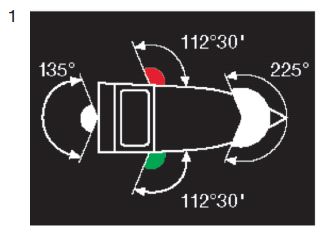 |
-
2.
-
If the visibility conditions require, the lights prescribed for the night must be additionally set by day.
-
3.
-
For the purposes of this Chapter, a thrust assembly, the length of which shall not exceed 110,00 m and the width of which shall not exceed 12,00 m, shall be considered to be an individually moving vehicle with a machine drive of the same length and width and an association of coupled vehicles, the latter of which shall be: Length of 140,00 m, than a thrust dressing of equal length.
-
4.
-
A vehicle waiting for lock, which is stationary, may retain the name prescribed for the journey.
-
5.
-
The names prescribed in this Chapter are shown in Appendix 3.
Unofficial table of contents
§ 3.02 Lichter and Signalleuchten
-
1.
-
Unless otherwise specified, the lights prescribed in this Regulation must be visible from all sides and shed a uniform, uninterrupted light.
-
2.
-
Only signalling lights shall be used whose lights in horizontal radiation, colour and strength correspond to the provisions of this Regulation and to the requirements of Annex II, Section 7.05 of the Inland Waterway Investigation Order. Signal lamps which comply with the requirements of the version of the inland waterway system applicable on 30 June 2011 or the version of the inland waterway system in force on 31 December 2012 may continue to be used.
-
3.
-
The night description of a stationary non-motorised vehicle does not need to comply with the requirements of point 2; however, it shall have a bearing width of at least 1 000.00 m in the case of a clear vision and a dark background.
Unofficial table of contents
§ 3.03 Flags, plates and pimple
-
1.
-
Unless otherwise specified, a flag or table prescribed in this Regulation shall be rectangular.
-
2.
-
The colours of a flag, a blackboard or a wimpel must not be faded or polluted.
-
3.
-
The dimensions of the points of sight referred to in point 2 shall be so large that they can be considered well; this condition shall be deemed to have been fulfilled in any case.
-
a)
-
in the case of a flag or blackboard, if it is at least 1.00 m high and 1.00 m wide, in the case of small vehicles it is at least 0.60 m high and 0.60 m wide,
-
b)
-
in the case of a wimpel, if its length is at least 1.00 m and its width is at least 0.50 m on the side to which the wimpel is attached.
Unofficial table of contents
§ 3.04 cylinder, balls and cone
-
1.
-
A cylinder, ball or cone prescribed in this Regulation may be replaced by facilities which have the same appearance from the distance.
-
2.
-
The colours of the points of sight referred to in paragraph 1 shall not be faded or polluted.
-
3.
-
The dimensions of the visual signs referred to in paragraph 1 shall be at least:
-
a)
-
for a cylinder 0,80 m in height and 0,50 m in diameter;
-
b)
-
for a ball 0,60 m in diameter;
-
c)
-
for a cone 0,60 m in height and 0,60 m in diameter of the base area;
-
d)
-
for a double cone 0.80 m in height and 0.50 m in diameter of the base area.
-
4.
-
In the case of a small vehicle, it is necessary to use, contrary to point 3, visual signs with smaller dimensions, which are appropriate in relation to the size of the small vehicle. However, they have to be so large that they can be seen well.
Unofficial table of contents
§ 3.05 Prohibited Or Exceptionally Approved Lights and Visible Signs
-
1.
-
It shall be prohibited to use other than the lights or signs provided for in this Regulation, or to use lights or visual signs in circumstances for which they are not prescribed or authorised.
-
2.
-
However, other lights or visual signs may also be used to communicate vehicle to vehicle or between the vehicle and the country, provided that this does not lead to confusion with the lights or visual signs provided for in this Regulation. can.
Unofficial table of contents
§ 3.06
(no content)
Unofficial table of contents
§ 3.07 Forbidden use of lights, spotlights, visual signs and other objects
-
1.
-
It shall be prohibited to use a light, a pig, a visual sign or any other object in such a way that it or it can be confused with the names provided for in this Regulation, the visibility of which may be is impaired or can make it difficult to recognize them.
-
2.
-
It shall be prohibited to use a light or a headlight in such a way that it or it blinds and thereby endangers or impedes shipping or traffic on land.
Section II.
Night and Tag Name
Title A.
Description during the journey
Unofficial table of contents
Section 3.08 Designation of individual vehicles with machine drive
(Annex 3: Figure 2, 3)
-
1.
-
An individually moving vehicle with a machine drive must be carried out at night:
-
a)
-
a topping light set on the front part of the vehicle
,
-
b)
-
the side lights, which are at the same height and in a plane perpendicular
to the longitudinal plane of the vehicle. On
Cruises on rivers must be at least 1,00 m
deeper than the topplight is set. For journeys on channels
The side lights, if possible, must be 1.00 m lower than the
Topplicht, however, they may not be set higher than this.
You have to put at least 1.00 m behind the topplight
and binnenbords are grayed out in such a way that the green
Light not seen by backbord, the red light not seen by starboard
can be used;
-
c)
-
a rear light on the aft ship.
|
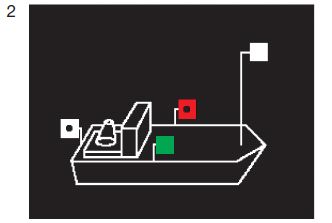 |
-
2.
-
An individually moving vehicle with a machine drive with more than
110,00 m Length must also lead to a second topplight at night
on the aft ship, and at a height greater than the front
Light.
|
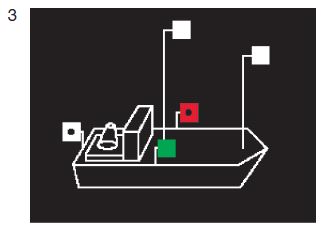 |
-
3.
-
Points 1 and 2 do not apply to a small vehicle or to a ferry; for a small vehicle, § 3.13 applies, for a ferry § 3.16.
Unofficial table of contents
Section 3.09 Designation of trawls in voyage
(Annex 3: Figure 4, 5, 6, 7, 8, 9, 10)
-
1.
-
At the top of a tractor in the drive the vehicle must be equipped with a machine drive:
-
a)
-
at night:
-
aa)
-
except the topplight and the side lights according to § 3.08
Point 1 (a) and (b) a second topple; this
has to be about 1.00 m below the first topplight, but after
Possibility of at least 1.00 m higher than the side lights set
,
-
bb)
-
instead of taillights in accordance with section 3.08 (1) (c)
yellow tail light at a suitable location and sufficient
Height, so that it is seen from the following annex
can be.
|
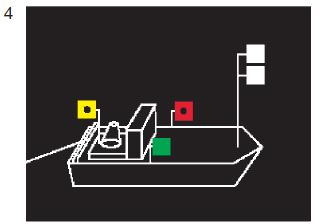 |
-
The vehicle must retain these lights even if it is temporarily moving forward on a short stretch of road; the pre-tensioning must also lead to the lights.
-
b)
-
by day:
a yellow cylinder, the top and bottom with a black one
and one white strip each -- the latter at the outer ends --
, the cylinder must be vertical on the forward vessel
and set so high that it is from all sides
is visible. |
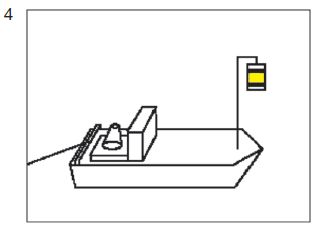 |
-
The vehicle must retain the cylinder even if it temporarily moves forward on a short distance, and the pre-tensioning must also lead to the cylinder.
-
2.
-
Where a towed dressing has a number of vehicles with a machine drive that are driven alongside each other, whether coupled or not, each of these vehicles shall lead:
-
a)
-
at night:
a third topplight; this must be about 2.00 m below the first
Topplicht, but if possible at least 1.00 m higher than
the page lights are set; |
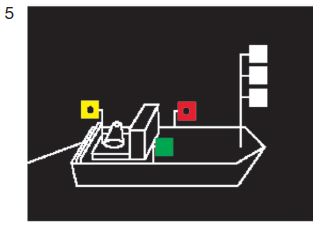 |
-
b)
-
by day:
| the cylinder referred to in point 1 (b) |
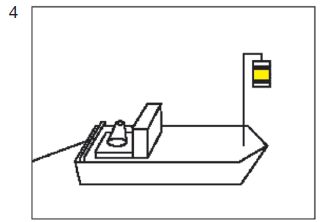 |
-
The same applies to all vehicles with a machine drive, which together bugze a vehicle, a floating body or a floating system.
-
3.
-
The towed vehicles of an entrainment belt must be carried in motion:
-
a)
-
at night:
a white light, visible from all sides; this must be
to the rear and can be grayed out after the sides by a matt glass pane; |
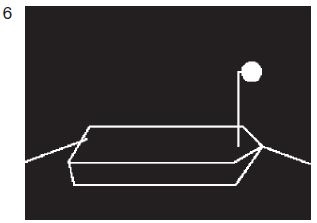 |
-
b)
-
by day:
a yellow ball at a suitable location and so high that it
is visible from all sides. |
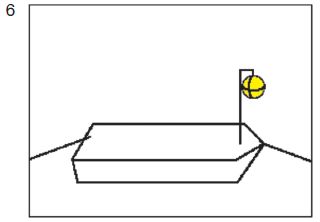 |
-
The same applies to towed floating bodies or towed floating installations. However,
-
a)
-
An attachment length of the band exceeds 110,00 m, must
they carry two lights in accordance with the first sentence at night, one on the other
the front and one on the rear half of the vehicle;
|
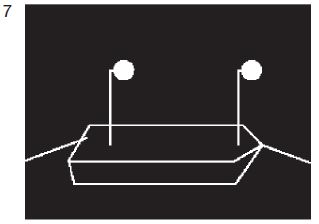 |
-
b)
-
An attachment length of the bandage from more than two sides
connected vehicles, the lights or the balls are
in accordance with the first sentence, only by the two outer vehicles.
|
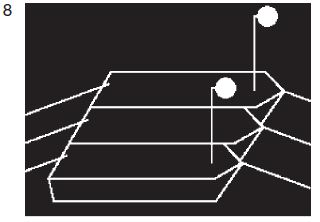 |
| |
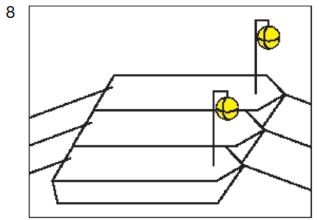 |
-
The lights and balls of all hauled vehicles of an association shall be set in such a way that they are at the same level above the water level.
-
4.
-
The vehicle or the vehicles which form the last hangout length of an entrainers ' belt must be carried out at night:
-
a)
-
the light referred to in point 3 or the headlight in accordance with section 3.08 (1) (a);
|
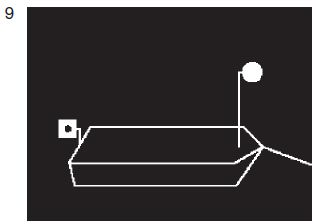 |
-
b)
-
the tail light in accordance with section 3.08 (1) (c); form more
as two vehicles connected on the longitudinal side, the end of the
Association, only the two outer vehicles of this
Light to lead.
|
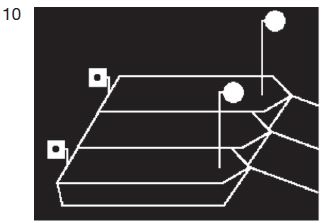 |
-
If one or more small vehicles form the closure of an association, they shall not be taken into account when applying the provisions of this point.
-
5.
-
In the case of a talk, a towing assembly consisting of a vehicle with a machine drive and a single attachment length does not need to have the tag name according to points 1 to 4.
-
6.
-
Points 1 to 5 do not apply to a small vehicle which only drags small vehicles, and not to a towed small vehicle. Such small vehicles shall be subject to section 3.13 (2) and (3).
Unofficial table of contents
Section 3.10 Designation of the drawers ' associations
(Annex 3: Figure 11, 12, 13, 14)
-
1.
-
A wheelset in the course of a journey must be carried out at night
-
a)
-
as Topplichter
-
aa)
-
three topplights on the vessel of the vehicle or, in the case of
several vehicles, on the foreship of the left of the vehicles
at the top of the association; these topplights must
in the form of an equilateral triangle with horizontal
Base line in a plane perpendicular to the longitudinal plane of the
The two lower topplichters
shall be at a distance of 1.25 m from each other and
1,10 m are placed under the highest topplight; they
In addition, on a river at least 2,00 m
above the level of the Einsenkungsmarken and at least
1.00 m above the side lights, on a shipping channel
or in a sluice channel as high as possible, but
shall be set at least at the level of the page lights;
|
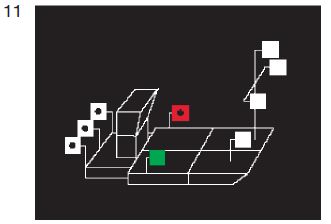 |
-
bb)
-
a topping light on the front vessel of any other vehicle, the whole width of which is visible from the front; this topplight, if possible, shall be set at 3.00 m lower than the uppermost double-letter (aa) thereof.
-
The masts of these topplights must be located in the longitudinal plane of the vehicle on which they are guided;
-
b)
-
as page lights
on the widest part of the association, at most 1.00 m from its outsides, as close as possible to the pushing vehicle and at least 2,00 m above the water level;
-
c)
-
as rear lights
-
-
aa)
-
Three rear lights on the axle ship of the moving vehicle
in a horizontal line perpendicular to the longitudinal plane,
a lateral distance of about 1.25 m and sufficient
height, so that they do not go through one of the other vehicles of the
they can be hidden;
-
bb)
-
a tail light on the aft vessel of any other vehicle,
whose entire width is visible from behind, are located in
the Federation other than the pushing vehicle more than two
vehicles that are visible from the rear, this rear light is only of
to carry the two outer vehicles.
|
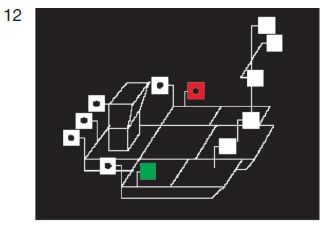 |
-
2.
-
A thrust bandage, juxtaposed by two pushing vehicles
, by night, must be moved to the rear of the rear light according to point 1
Letter c, double letter aa on the starboard side
Moving the vehicle, the other moving vehicle
the tail light as specified in point 1 (c) must be double-letter
bb.
|
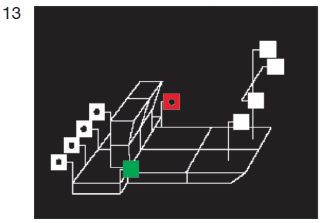 |
-
3.
-
Number 1 shall also apply to a thrust body when it is at night.
but, the three rear lights shall be referred to in point 1
Letter c, double letter aa, be yellow.
|
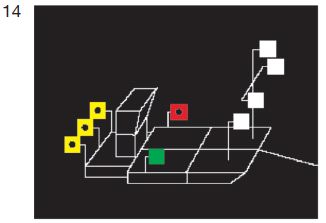 |
-
4.
-
If a pushing body is towed at day, the pushing
Guide the vehicle:
a yellow ball at a suitable location and so high that it
is visible from all sides.
|
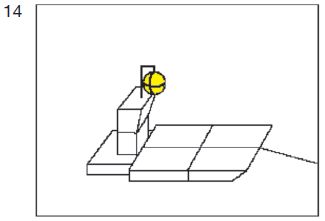 |
Unofficial table of contents
Section 3.11 Designation of coupled vehicles in voyage
(Annex 3: Figure 15, 16)
-
1.
-
Coupled vehicles in driving must be carried out at night:
-
a)
-
on each vehicle, the toppinglight in accordance with section 3.08 (1) (a);
on vehicles without a machine drive, however, this topple can
at a suitable location and not higher than the topple of the
Vehicle or vehicles with machine drive through the light
in accordance with Section 3.09 (3);
|
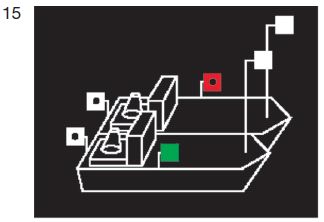 |
-
b)
-
the side lights in accordance with section 3.08 (1) (b); these lights
shall be placed on the outside of the outer vehicles, and
if possible at the same height and at least 1.00 m lower than the
lowest topplight;
-
c)
-
a rear light in accordance with section 3.08 (1) (c) on each vehicle.
|
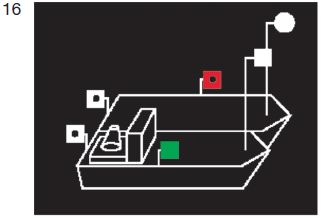 |
-
2.
-
Point 1 shall not apply to a small vehicle which only guides small vehicles on the longitudinal side of the vehicle and not for a small vehicle which is coupled on the longitudinal side. Such small vehicles shall be subject to section 3.13 (2) and (3).
Unofficial table of contents
Section 3.12 Designation of the vehicles under sail
(Annex 3: Figure 17)
-
1.
-
A vehicle under sail in driving must lead at night:
-
a)
-
the side lights according to § 3.08 (1) (b), but may
these ordinary lights;
-
b)
-
a tail light in accordance with section 3.08 (1) (c).
|
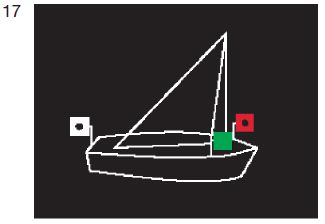 |
-
2.
-
Point 1 shall not apply to a small vehicle; for a small vehicle under sail, the provisions of sections 3.13 (4) and (6) shall apply.
Unofficial table of contents
Section 3.13 Designation of small vehicles in voyage
(Annex 3: Pic 18, 19, 20, 21, 22, 23, 24, 25, 26)
-
1.
-
An individually moving small vehicle with a machine drive must be carried out at night:
either
-
a)
-
a topplight, but bright instead of strong, at the same height as the side lights
and at least 1,00 m in front of them;
-
b)
-
Side lights, which may be ordinary lights; they must be in
of the same height and in a plane perpendicular to the longitudinal axis of the
to be set and to be so grayed out by the inside of the vehicle,
that the green light is not from the backboard, the red light not from
Starboard can be seen;
-
c)
-
a tail light;
|
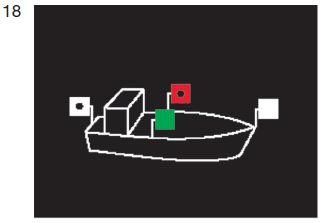 |
-
or
-
d)
-
a topplight, but bright instead of strong, at least 1.00 m higher than
the side lights;
-
e)
-
Side lights, which may be ordinary lights; these can be
-
aa)
-
at the same height and in a plane perpendicular to the longitudinal axis
of the vehicle
-
or
-
bb)
-
directly side by side or in a single lantern on the
or close to the bow in the ship's axis
-
, in the case of the double letter aa,
inner bords are so grayed out that the green light is not
Backbord, the red light cannot be seen from starboard;
|
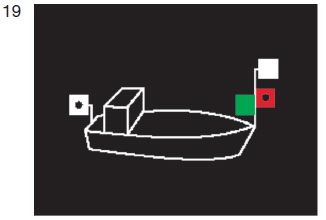 |
-
f)
-
a tail light; this light may be omitted from the condition that:
that instead of the topping-light referred to in point (d), one of all
Pages visible white bright light is guided.
|
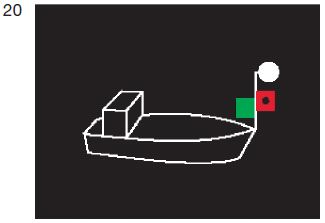 |
-
2.
-
If a small vehicle only drags small vehicles, or if it only couples it on the longitudinal side, it must lead the lights in accordance with point 1 at night.
-
3.
-
A towed vehicle which is either towed or coupled in the longitudinal direction must be
at night a white ordinary light visible from all sides
. This shall not apply to the boats of the vehicle.
|
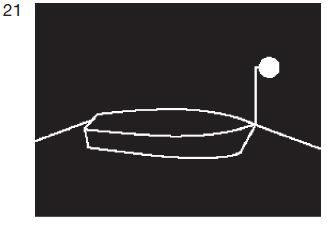 |
-
4.
-
An individually moving small vehicle under sail must lead at night: either:
-
a)
-
the lateral lights referred to in point 1 (e) and a rear light
|
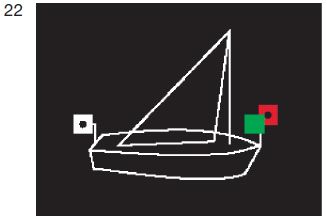 |
or
-
b)
-
those side lights and the tail light in a single lantern
at the pot
|
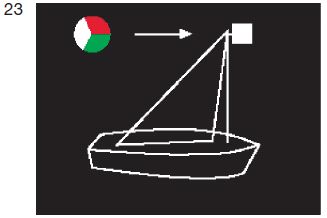 |
or
-
c)
-
a white common light visible from all sides, and
in addition, a second vehicle for the approximation of other vehicles
show white-white light.
|
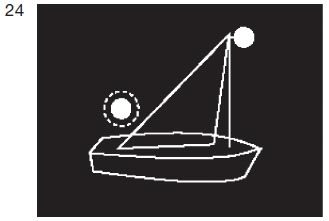 |
-
5.
-
One individual neither with machine drive nor under sails
Small vehicle must have a white white from all sides at night
ordinary light. A dinghy, on which the same advance-
However, this light only needs to be used in the approximation process
of another vehicle.
|
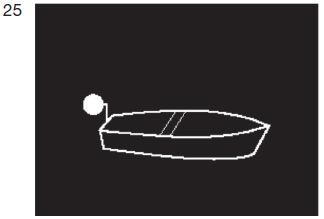 |
-
6.
-
A small vehicle under a sail that is simultaneously equipped with a machine drive
leaves a black cone with the tip down at day,
as high as possible in a place where it is best visible,
.
|
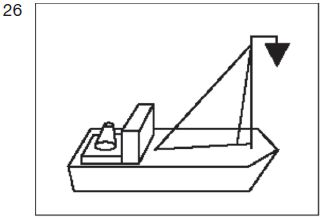 |
Unofficial table of contents
Section 3.14 Additional designation of vehicles in the carriage of certain dangerous goods
(Annex 3: picture 27a, 27b, 28a, 28b, 29, 30, 31, 32)
-
1.
-
In addition to the other name prescribed in accordance with this Regulation, a vehicle which carries certain flammable substances in accordance with Chapter 3.2, Table A ADN, shall lead to ADN subsection 7.1.5.0 or 7.2.5.0 in addition to the name prescribed by this Regulation:
-
a)
-
at night:
| a blue light; |
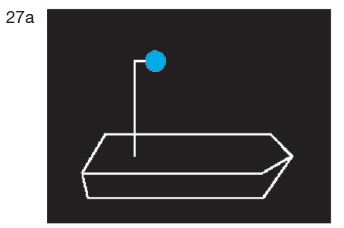 |
-
b)
-
by day:
| a blue cone with the tip down. |
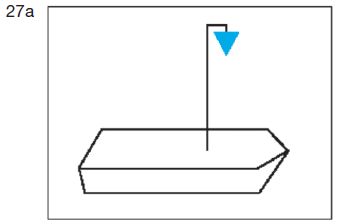 |
The character must be kept at a suitable location and so high
is that it is visible from all sides. Instead of the blue
Kegel according to the first sentence of 1 (b) may also be a blue cone
the forship and the aft vessel and so high,
that the cone on
-
a)
-
at least in one area of the back-board
querab in advance until tax-bord,
-
b)
-
on the roller coaster at least in one area of the backboard
querab querab via Achteraus to Steuerbord querab
|
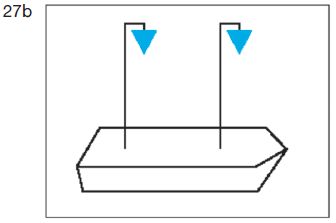 |
| is visible. |
|
-
2.
-
In addition to the other name prescribed in accordance with this Regulation, a vehicle in driving which carries certain harmful substances referred to in Chapter 3.2, Table A ADN, shall be replaced by the following name in accordance with ADN subsection 7.1.5.0, or 7.2.5.0 lead:
-
a)
-
at night:
| two blue lights; |
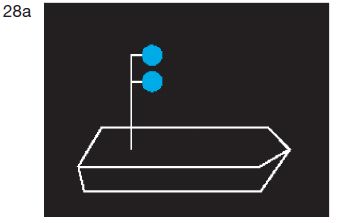 |
-
b)
-
by day:
| two blue cones with the tip down. |
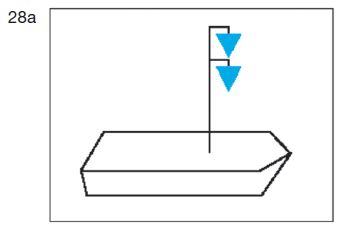 |
The characters must be superimposed on each other at a distance of 1.00 m
an appropriate place and so high that it is
all sides are visible. By way of derogation from the second sentence, the distance
between the characters as a function of the circumstances
If this does not result in their recognizability
is restricted. Instead of the two blue cones according to sentence 1
Point (b) in conjunction with sentences 2 and 3 may also be
two blue cones on the front ship and the roller coaster and so on
high enough to keep the cones up
-
a)
-
at least in one area of the back-board
querab in advance until tax-bord,
-
b)
-
on the roller coaster at least in one area of the backboard
querab querab via Achteraus to Steuerbord querab
|
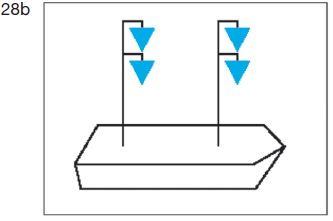 |
| are visible. |
|
-
3.
-
In addition to the other name prescribed in accordance with this Regulation, a vehicle which carries certain explosive substances referred to in Chapter 3.2, Table A ADN, shall lead to ADN subsection 7.1.5.0 or 7.2.5.0 in addition to the name prescribed by this Regulation:
-
a)
-
at night:
| three blue lights; |
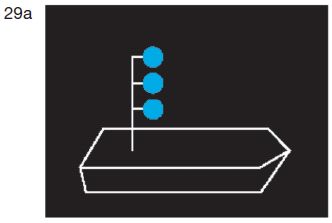 |
-
b)
-
by day:
| three blue cones with the top down. |
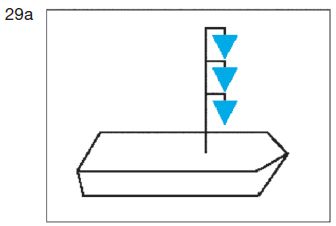 |
The characters must be superposed at a distance of 1.00 m
at a suitable location and so high that they are
all sides are visible. By way of derogation from the second sentence, the distance
between the characters as a function of the circumstances
If this does not result in their recognizability
is restricted. Instead of the three blue cones according to sentence 1 book-
B in conjunction with the sentences 2 and 3 may also be three
Blue cone on the front ship and the roller coaster and so high
that the cones are kept on
-
a)
-
at least in one area of the back-board
querab in advance until tax-bord,
-
b)
-
on the roller coaster at least in one area of the backboard
querab querab via Achteraus to Steuerbord querab
|
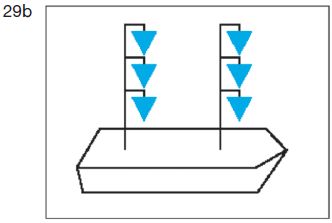 |
| are visible. |
|
-
4.
-
If a vehicle or several vehicles within the meaning of points 1, 2 or 3 are used in a thrust assembly or in a combination of coupled vehicles, the description referred to in the number 1, 2 or 3 shall be taken on the vehicle which shall: Bandage or the compilation.
-
5.
-
A thrust body, which is moved next to each other by means of two pushing vehicles, must lead to the designation according to point 4 on the control-board-side, sliding vehicle.
-
6.
-
A vehicle, a thrust assembly or coupled vehicles, the vehicle or the various dangerous goods referred to in points 1, 2 or 3 together carry the name of the dangerous product, which is the largest number of blue lights or Blue cone requires.
-
7.
-
A vehicle which does not have to be designated in accordance with points 1, 2 or 3 but has a certificate of approval pursuant to ADN section 8.1.8 and complies with the safety regulations applicable to a vehicle as defined in point 1 shall have the effect of approximating locks the name referred to in point 1, if it wishes to be carried out together with a vehicle which must be designated as number 1.
-
8.
-
The light intensity of the blue lights prescribed in points 1 to 7 shall be at least equal to that of the usual blue lights.
Unofficial table of contents
Section 3.15 Designation of the vehicles in motion,
authorised for the carriage of more than 12 passengers
and the hull of which has a maximum length of less than 20.00 m
(Annex 3: Figure 33)
A vehicle registered for the carriage of more than 12 passengers and whose hull has a maximum length of less than 20.00 m shall be subject to travel by day.
a yellow double cone at a suitable location and so high,
that it's visible from all sides, |
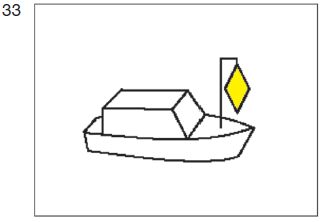 |
. Set 1 does not apply to a ferry.
Unofficial table of contents
§ 3.16 Designation of Ferries in voyage
(Annex 3: Figure 34, 35, 36)
-
1.
-
A non-free ferry in the course of a journey must be carried out at night:
-
a)
-
a white bright light visible from all sides
at least 5,00 m above the level of the Einsenkungsmarken; the height may be
, however, if the length of the ferry is 15,00 m
does not exceed;
-
b)
-
a green light, visible from all sides, about 1.00 m
above the light referred to in (a).
|
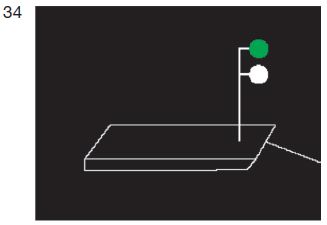 |
-
2.
-
In the case of a yawing ferry on the longitudinal cable, it must be carried out at night
top beechnachs or dogboats with a white bright light
at least 3.00 m above the water.
|
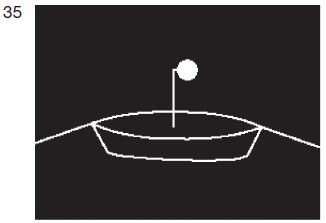 |
-
3.
-
A free-running ferry to travel must lead at night:
-
a)
-
the lights referred to in point 1;
-
b)
-
the lights according to § 3.08 (1) (b) and (c).
|
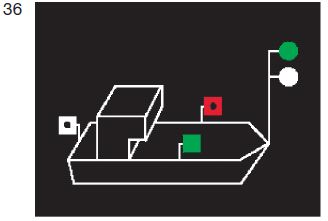 |
Unofficial table of contents
Section 3.17 Additional designation of vehicles in driving, which shall have priority
(Annex 3: Figure 37)
A vehicle to which the competent authority has given priority to transit through a body in which a particular order applies shall, in the case of a journey other than the other name prescribed by this Regulation, be used on a day-to-day basis.
| a red wimpel on the front ship and so high that it is well visible. |
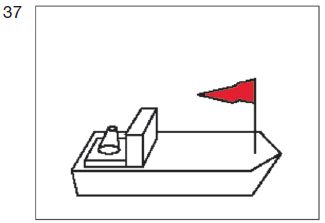 |
Unofficial table of contents
Section 3.18 Additional designation of maneuverable vehicles in voyage
(Annex 3: Figure 38)
-
1.
-
In addition to the other name prescribed by this Regulation, a manoeuvrable vehicle must be used in addition to the other name required by this Regulation
-
a)
-
at night:
| show a red light, which is swung in the lower half circle; |
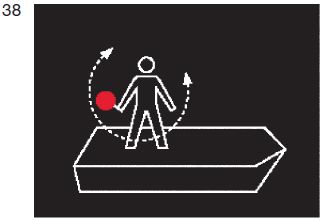 |
-
b)
-
by day:
show a red flag, which swings in the lower half-circle
. |
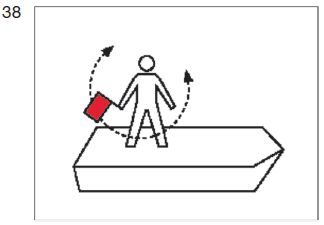 |
-
In place of the term referred to in the first sentence, the prescribed audible symbol may be given, or both.
-
2.
-
The flag referred to in point 1 (b) may be replaced by a plate of the same colour.
Unofficial table of contents
Section 3.19 Designation of floating bodies and floating installations in voyage
(Annex 3: Figure 39)
Without prejudice to the specific requirements which may be laid down in accordance with Article 1.21, a swimming body or a floating facility shall be required to travel at night.
from all sides visible white bright lights in sufficient numbers,
in order to make their outlines recognizable. |
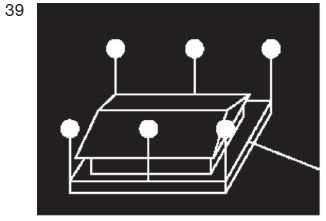 |
Title B.
Name when breast-feeding
Unofficial table of contents
Section 3.20 Designation of vehicles during the standstill
(Annex 3: Figure 40, 41)
-
1.
-
With the exception of a small vehicle and the vehicles referred to in § § 3.22 and 3.25, a vehicle must be stopped during the standstill at night.
a white common light visible from all sides on the
Waterside at least 3,00 m above the level of the
Sunset marks |
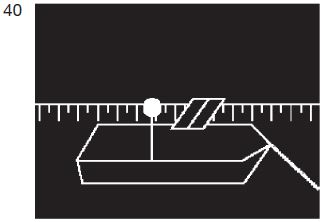 |
. Instead of the designation as set out in the first sentence, two white ordinary lights visible from all sides can also be guided on the water side at the same height on the front and the roller coaster.
-
2.
-
A small vehicle-with the exception of a ding-boat-must be closed at night when breastfeeding
a white common light visible from all sides
on the water side. |
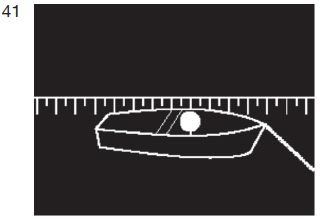 |
-
3.
-
The name prescribed in paragraphs 1 and 2 shall not be used if:
-
a)
-
the vehicle belongs to a set of vehicles which is not expected to be dissolved before the end of the night and the vehicles in this compilation shall, on the water side, lead the light in accordance with point 1;
-
b)
-
the vehicle is located completely between unflooded buoys or is stationary behind a longitudinal work projecting out of the water; or
-
c)
-
the vehicle is at a standstill on the shore and is sufficiently illuminated by it.
-
4.
-
Where vehicles are drawn together at a point specially designated for this purpose, the competent authority may, in special cases, free a part of them from the light guidance provided for in points 1 or 2.
Unofficial table of contents
Section 3.21 Additional designation of stationary vehicles for the transport of certain dangerous goods
(Annex 3: Figure 42, 43, 44)
The designation prescribed in accordance with § 3.14 shall also be carried out by the vehicles referred to there, the thrust and the coupled vehicles, even when the vehicle is still in the standstill.
Unofficial table of contents
Section 3.22 Designation of the ferries decommissioned at their landing site
(Annex 3: Figure 45, 46)
-
1.
-
A non-free ferry must carry the lights according to § 3.16 (1) during the operation at night when it is still lying at the point where it is to be taken.
In addition, in the case of a Gierseil ferry at the longitudinal cable at night, the
top beechnachs or dogboats lead the light according to § 3.16 number 2. |
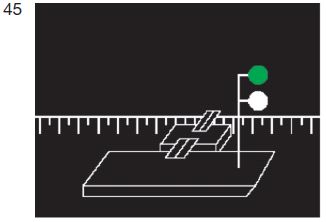 |
-
2.
-
A free-running ferry during the operation at night must carry the lights in accordance with section 3.16 (1) at the point of standstill at the point of landing; they may also keep the lights in accordance with section 3.08 (1) (b) and (c).
The green light in accordance with section 3.16 (1) (b) and the lights
in accordance with Section 3.08 (1) (b) and (c), it shall be deleted
as soon as the ferries are no longer in operation. |
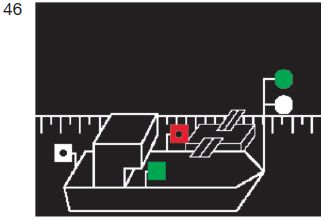 |
Unofficial table of contents
Section 3.23 Designation of floating bodies and floating installations during standstill
(Annex 3: Figure 47)
Without prejudice to the special conditions which may be laid down in accordance with § 1.21, a floating body or a floating facility shall be required for the decommissioning at night.
White ordinary lights visible from all sides in sufficient
number in order to make their waterways side-by-side outlines, |
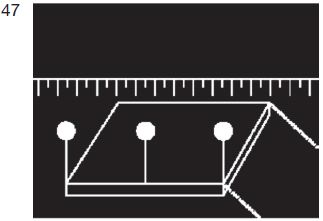 |
. The lights prescribed in the first sentence shall not be required if the conditions of Section 3.20 (3) (b) or (c) or (4) are fulfilled. If the location of the swimming pool or of the floating facility prevents the ship from being obstructed and the vessel or the floating facility is not at risk of being charged by navigation, the competent authority may, for individual swimmers, or floating systems which allow decommissioning without lighting.
Unofficial table of contents
Section 3.24 Designation of certain
standing fishing vessels and nets or outriggers
(Annex 3: Figure 48)
-
1.
-
A fishing vessel, including a small vehicle, which has designed its nets or jibs in the water or in the vicinity thereof, shall, in the case of a standstill at night, be called the name in accordance with Section 3.20 (1).
-
2.
-
The nets or booms of the vehicle referred to in paragraph 1 shall be referred to as:
-
a)
-
at night:
white ordinary lights visible from all sides in
a sufficient number to make their situation clear; |
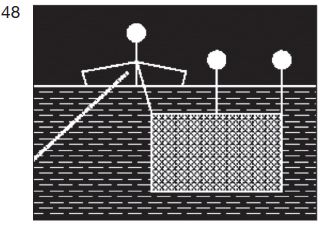 |
-
b)
-
by day:
by yellow dippers in sufficient numbers to identify their location
to make it. |
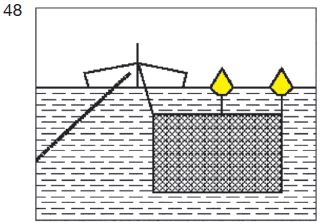 |
-
3.
-
The competent authority may prescribe or permit a name other than that of point 2 (b).
Unofficial table of contents
Section 3.25 Designation of floating equipment
in the case of work as well as fixed or cunted vehicles
(Annex 3: Pic. 49a, 49b, 50a, 50b, 51, 52)
-
1.
-
A floating device at work or a vehicle carrying out work, commutation or other measurements on the waterway, and which is still in the process of being shut down, must lead:
-
a)
-
according to the page or the pages on which the passage is free:
-
aa)
-
at night:
on top of each other two green ordinary lights or two
green light lights; |
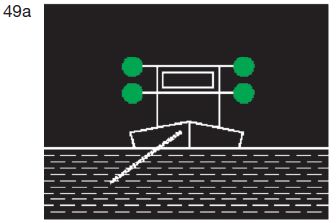 |
-
bb)
-
by day:
either
-
aaa)
-
Table sign E.1 (Appendix 7)
|
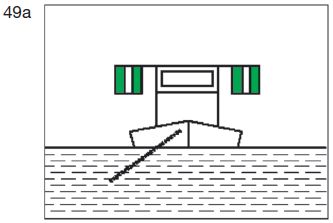 |
-
or
-
bbb)
-
two green double cones one above the other in a
Distance of 1.00 m
|
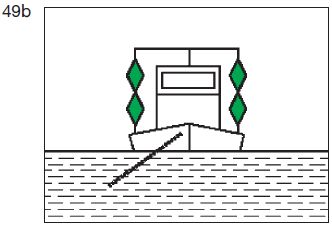 |
-
and where appropriate
-
b)
-
according to the page where the passage is not free:
-
aa)
-
at night:
a red ordinary light or a red bright light in
of the same height and of the same strength as the
(a) A double letter aa top green light; |
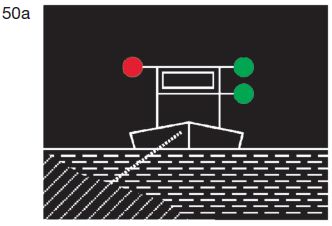 |
-
bb)
-
by day:
either
-
aaa)
-
the Table mark A.1 (Appendix 7) at the same level as
the table character referred to in point (a), double letter
bb Three-letter letter aaa
|
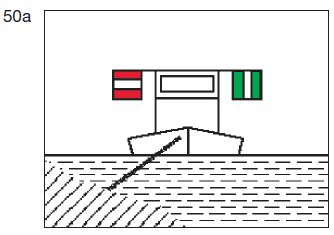 |
-
or
-
bbb)
-
a red ball at the same height as the top double-cone according to letter a double letter bb triple letter bbb.
|
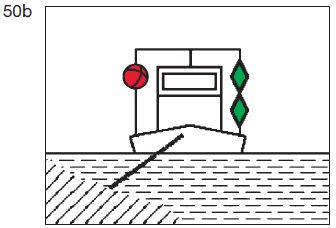 |
-
If the vehicle referred to in the first sentence has to be protected against sog or wave impact, it must:
-
a)
-
according to the page or the pages at which the passage is free:
-
aa)
-
at night:
a red ordinary light and a white ordinary
Light or a red light and a white bright light that
red light 1,00 m above the white; |
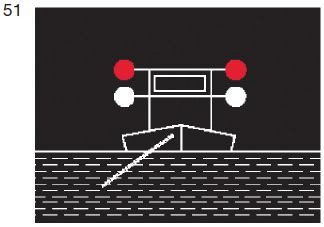 |
-
bb)
-
by day:
a flag, the upper half of which is red and its lower half
is white, or two flags on top of each other
upper red, the lower white, |
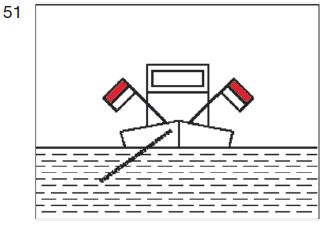 |
-
b)
-
according to the page where the passage is not free:
-
aa)
-
at night:
a red light of the same height and of the same strength as the red light shown in (aa) a double letter;
-
bb)
-
by day:
a red flag at the same height as the white red flag or the red flag on the other side.
-
The term referred to in sentences 1 and 2 shall be so high that it is visible from all sides. The flags can be replaced by panels of the same colour.
-
2.
-
A fixed or sunken vehicle shall be designated in accordance with the second sentence of point 1 (2) (a) and (b). If a sunken vehicle is located in such a way that the characters cannot be affixed to it, they must be placed on the nache, tonnes or in other appropriate ways.
-
3.
-
The competent authority may exempt the name referred to in the first sentence of point 1 (a) and (b) from the name of the name.
Unofficial table of contents
Section 3.26 Additional designation of vehicles, floating bodies
and floating installations, the anchors of which may endanger shipping, and their anchors
(Annex 3: Picture 53, 54, 55)
-
1.
-
A stationary vehicle, the anchor of which is designed so that an anchor, an anchor cable or an anchor chain may endanger shipping, must, in addition to the other name prescribed in accordance with this Regulation, lead at night:
an additional white ordinary common to all sides
Light 1.00 m under the light according to § 3.20 (1) or (1) if two
Set of decommissioned lights, under the light that the anchor is
is next. |
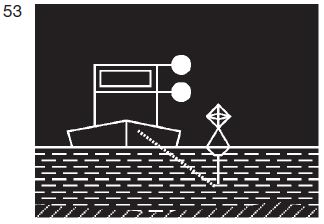 |
-
2.
-
If, in the cases of Section 3.23, an anchor is ejected in such a way that the shipping may be at risk, the light closest to that anchor shall be:
two white ordinary lights visible from all sides, which in
a distance of 1.00 m is superposed on top of each other, replaces
. |
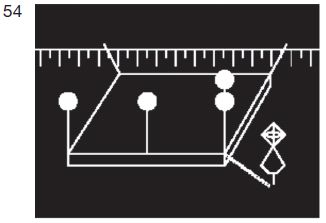 |
-
3.
-
In the cases of points 1 and 2, each of these anchors shall be designated by a yellow dogboat with a radar reflector.
-
4.
-
If an anchor, an anchor cable or an anchor chain of a floating device may endanger shipping, he or she shall designate it:
-
a)
-
at night:
| by a ton with a radar reflector and a white normal light visible from all sides; |
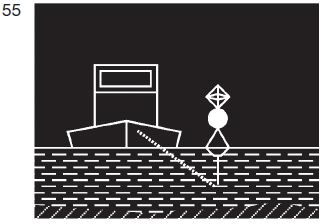 |
-
b)
-
by day:
| by a yellow Döpper with radar reflector. |
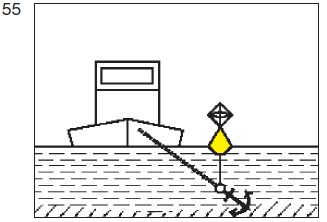 |
Section III.
Other name
Unofficial table of contents
Section 3.27 Designation of the vehicles of the supervisory authorities
(Annex 3: Figure 56)
A vehicle of the surveillance authorities according to § 1.20 may show a blue sparkle at night and day in order to be recognizable. This also applies to a fire extinguishing boat or a water rescue vehicle according to § 1.24 number 2 in the rescue mission as well as for a customs boat, a vehicle of the Federal Police or a vehicle of the Federal Criminal Police Office.
Unofficial table of contents
Section 3.28 Additional designation of the vehicles in driving, carrying out work on the waterway
(Annex 3: Figure 57)
A vehicle running on the waterway, carrying out work, commutations or other measurements, may, with the permission of the competent authority, at night and on the day in addition to the other name prescribed by this Regulation. lead:
a yellow normal sparkle visible from all sides, or a yellow bright sparkle visible from all sides.
Unofficial table of contents
§ 3.28a designation and driving rules for multi-purpose vehicles of the Bundeswehr
-
1.
-
A multi-purpose vehicle of the German Armed Forces shall carry out during the journey at night the lights according to § 3.08 number 1 and 1.00 m above the Topplichtes additionally a yellow ordinary radio light visible from all sides or a visible from all sides. Yellow light, which must be switched on at night and by day.
-
2.
-
The vehicle referred to in point 1 shall, in principle, behave as a small vehicle during the journey. § § 6.02 and 6.02a numbers 1 and 4 apply.
Unofficial table of contents
§ 3.29 Protection against sog and wave strike
(Annex 3: Figure 58)
-
1.
-
A vehicle which is in use or is stationary, a floating or stationary floating body, or a floating or stationary floating facility, the one or the other, the one or the other of the body, the body or the body, the body or the body, the body or the body, the body or the body of the float, the body or the body In addition to the other name prescribed by this Regulation, a vehicle or a floating body may be protected in addition to the other name prescribed by this Regulation
-
a)
-
at night:
a red ordinary and a white ordinary light, or
a red light and a white bright light, the red light 1,00 m
above the white one, in a place where they are well seen and
cannot be confused with other lights; |
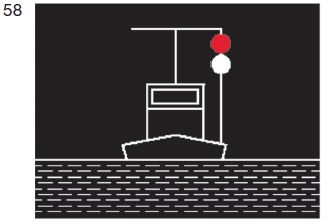 |
-
b)
-
by day:
a flag, the upper half of which is red and the lower half of which is white
is, at a suitable location and so high that it is from all sides
is visible. The flag can be placed on top of each other by two flags,
the upper red, the lower white is replaced.
The flags can be replaced by panels of the same colour. |
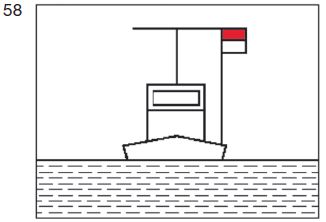 |
-
2.
-
Only use shall be made of the name referred to in point 1:
-
a)
-
a vehicle, a floating body or a floating installation, which is seriously damaged or which is involved in rescue operations, and a vehicle that is not capable of manoeuvring;
-
b)
-
a vehicle, a floating body or a floating facility with the written permission of the competent authority.
-
§ 3.25 shall remain unaffected.
Unofficial table of contents
§ 3.30 Notzeichen
(Annex 3: Figure 59)
-
1.
-
A vehicle in distress, which wants to call for help by means of visual signs, can show:
-
a)
-
at night:
| a light that is swung in a circle; |
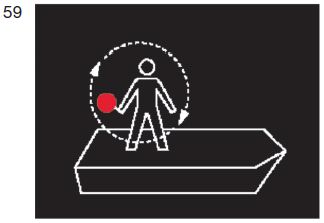 |
-
b)
-
by day:
a red flag, which is pivoted in a circle, or another red flag
appropriate object, which is pivoted in a circle. |
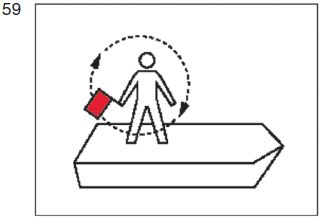 |
-
2.
-
The visual signs referred to in point 1 shall replace or supplement the sound signs in accordance with § 4.04.
Unofficial table of contents
Section 3.31 Note on the prohibition to enter the vehicle
(Annex 3: Figure 60)
-
1.
-
In the event that persons not engaged on board are prohibited by other regulations from entering the vehicle, this prohibition shall be replaced by round white panels with a red border, a red slash and a
-
a)
-
a black symbol of the pedestrian, or
|
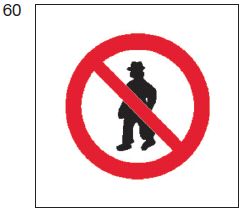 |
-
b)
-
a black symbol of a calling person holding up a hand defensively,
|
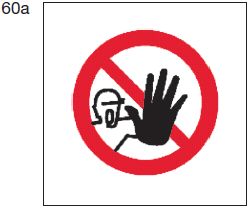 |
-
are displayed. The panels shall be placed on board or on the catwalk, as required. By way of derogation from Section 3.03 (3), its diameter shall be at least 0.60 m.
-
2.
-
If necessary, the panels must be illuminated so that they are clearly visible at night.
Unofficial table of contents
Section 3.32 Note to the ban to use unprotected light or fire
(Annex 3: Figure 61)
-
1.
-
Provided that it is prohibited by other provisions, on board
-
a)
-
to smoke,
-
b)
-
to use unprotected light or fire,
-
this ban has to be made by round white panels with a red border and a red slash, on which
-
a)
-
a burning cigarette in black paint or
|
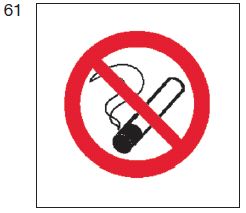 |
-
b)
-
an inflamed stringed wood in black
|
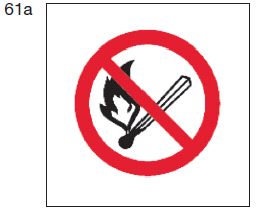 |
-
is shown. The panels shall be placed on board or on the catwalk, as required. By way of derogation from Section 3.03 (3), its diameter shall be at least 0.60 m.
-
2.
-
If necessary, the panels must be illuminated so that they are clearly visible at night.
Unofficial table of contents
Section 3.33 Note to the ban on breastfeeding side-by-side
(Annex 3: Figure 62)
-
1.
-
If the lateral standstill is prohibited in the vicinity of a vehicle by other provisions or by special requirements of the competent authority, this vehicle must be mounted on the deck in the longitudinal axis
| a square board, including a triangular additional sign. |
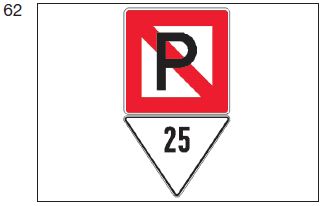 |
-
The square board is white on both sides with red border and carries a red slash from top left to bottom right and a black "P" in midfield. The triangular additional sign is white on both sides and shows in black numbers the distance in meters, within which the standstill is forbidden.
-
2.
-
At night, the panels must be illuminated in such a way that they are clearly visible on both sides of the vehicle.
-
3.
-
This paragraph shall not apply to the vehicles referred to in § 3.21, thrust associations or coupled vehicles.
Section IV.
Obligations
Unofficial table of contents
§ 3.34 Behaviour obligations
-
1.
-
The skipper and the person responsible pursuant to section 1.03 (3) for the course and speed shall each ensure that in the cases of § 3.01 (2) the lights prescribed for the night are also set at daytime.
-
2.
-
The ship ' s guide and the person responsible for course and speed pursuant to section 1.03 (3) shall each ensure that the vehicle, the bandage, the floating body or the floating installation are in accordance with Section 3.08 (1), also in conjunction with the Number 2 and section 3.28a (1), 3.11 (1), 3.12 (1), 3.15 (1), § 3.17, § 3.18 (1), first sentence, and § 3.19, respectively, shall be given as the prescribed name during the journey.
-
3.
-
The ship ' s guide and the person responsible pursuant to section 1.03 (3) for the course and speed shall each ensure that the vehicle, the bandage, the pre-tensioning, the floating body or the floating installation are in accordance with Section 3.09 (1). Up to 4, § 3.10 Number 1 to 4, § 3.13 number 1 to 6, § 3.14 number 1 to 7, also in connection with point 8, and § 3.16 number 1 to 3, the denomination prescribed there during the journey is conducted.
-
4.
-
The ship's guide shall only be allowed to lead the vehicle if:
-
a)
-
whose lights are visible from all sides in accordance with Section 3.02, point 1, and cast a uniform, uninterrupted light,
-
b)
-
whose signs comply with the rules referred to in Article 3.02 (2), first sentence,
-
c)
-
whose name has the scope in accordance with section 3.02 (3).
-
5.
-
The ship's guide shall ensure that the vehicles used on the vehicle are
-
a)
-
Flags, plates and whimps meet the requirements of section 3.03 (1) to (3), section 3.31 (1), third sentence, and § 3.32 (1) sentence 3; and
-
b)
-
Cylinders, balls and cones meet the requirements of sections 3.04 (2) and (3).
-
6.
-
The ship's guide shall ensure that on the vehicle or the association in the in § 3.20 number 1 and 2, § 3.21 in conjunction with § 3.14 number 1 to 7, § 3.22 number 1 and 2 sentence 1, § 3.24 number 1 and 2, § 3.25 number 1 and 2 and § 3.26 number 1 shall be given for the purposes mentioned in each case during the breastfeeding period.
-
7.
-
The ship's guide shall ensure that a ejected anchor of the vehicle is designated in the case referred to in Section 3.26 (1) in accordance with Section 3.26 (3) during the standstill during the standstill.
-
8.
-
The skipper shall ensure that in the case referred to in section 3.22 (2), second sentence, the name referred to therein is deleted.
-
9.
-
The ship's guide shall ensure that on the vehicle the prohibition
-
a)
-
the entry in accordance with section 3.31, point 1, also in conjunction with point 2,
-
b)
-
to smoke and to use unprotected light or fire in accordance with Section 3.32 (1), including in conjunction with point 2; and
-
c)
-
of the decommissioning side by side side by side in accordance with section 3.33 (1), also in conjunction with point 2,
-
is indicated in the manner prescribed in each case.
-
10.
-
The skipper, the owner and the supplier shall each ensure that the name prescribed in § 3.23, first sentence, shall be kept on the floating body or the floating facility at night when it is still in the process of being shut down.
-
11.
-
The skipper, the owner and the supplier shall each ensure that the name prescribed there is kept on the floating body or the floating facility at night in the case referred to in Section 3.26 (2).
-
12.
-
The skipper, the owner and the equipment supplier shall each have to ensure that a ejected anchor of the floating body or floating structure or floating installation at night is referred to in the case referred to in section 3.26 (2) in accordance with Section 3.26 (3). is.
-
13.
-
The skipper, the owner and the supplier shall each have to ensure that an anchor, an anchor cable or an anchor chain of the floating device, which may endanger shipping, is designated in accordance with Section 3.26 (4).
-
14.
-
The owner and the equipment supplier may only arrange or permit the putting into service of a vehicle or of an association, if:
-
a)
-
whose lights according to § 3.02 (1) are visible from all sides and cast a uniform, uninterrupted light,
-
b)
-
whose signalling rights comply with the rules referred to in Section 3.02 (2);
-
c)
-
the night name of which has the scope required in accordance with section 3.02 (3), second sentence, 2.
Chapter 4
Sound signs of the vehicles, radio, navigation devices
Section I.
Sound signs (Appendix 6)
Unofficial table of contents
§ 4.01 General
-
1.
-
To the extent that this Regulation requires the provision of a sound and not the use of the bell, it shall be given as follows:
-
a)
-
on a vehicle with a machine drive, except for a small vehicle, by means of a mechanically operated sound device, which is sufficiently high to allow the sound to spread freely forward and, if possible, also after the axle;
-
b)
-
on a vehicle without a machine drive and on a small vehicle by means of a sonic device, a suitable horn or a suitable horn.
-
2.
-
On a vehicle with a machine drive, a light sign must be given at the same time as a sound signal, which must be yellow, bright and visible from all sides. This does not apply to a small vehicle as well as to bell signs.
-
3.
-
Driving vehicles in an association, shall be a prescribed audible mark only from the vehicle on which the leader of the association is located, in the case of a towing dressing of the motorized vehicle at the top of the association.
-
4.
-
A group of bell-blows must take about four seconds. It can be replaced by blows of metal on metal of the same duration.
-
5.
-
The skipper and the person responsible pursuant to Section 1.03 (3) for the course and speed shall in each case ensure that a prescribed sound character in the 1, 2 sentence 1 and point 4, respectively also in connection with the number 3, is given in a prescribed manner.
Unofficial table of contents
§ 4.02 Use of the sound signals
-
1.
-
Subject to other provisions of this Regulation, each vehicle, with the exception of a small vehicle, shall, in the cases referred to in Annex 6, give the respective sound marks.
-
2.
-
A small vehicle may, if necessary, give the general sound signals referred to in section A of Appendix 6.
-
3.
-
The skipper and the person responsible pursuant to Section 1.03 (3) for the course and speed shall in each case ensure that the sound signals prescribed in accordance with point 1 are given.
Unofficial table of contents
§ 4.03 Forbidden Sound signs
-
1.
-
It may not be necessary to use the sound symbol other than those provided for in this Regulation, or in circumstances where it is not required or authorised by this Regulation.
-
2.
-
However, in order to communicate the vehicle to the vehicle and between the vehicle and the country, a different sound symbol may also be used, provided that this does not lead to confusion with the sound signals provided for in this Regulation.
Unofficial table of contents
§ 4.04 Notzeichen
-
1.
-
A vehicle that wants to call for help by means of a sound signal, in particular, when the vehicle has fallen overboard in distress or a person, can either ring with the bell or repeatedly emit long tones.
-
2.
-
These sound marks replace or supplement the visual signs according to § 3.30.
Section II.
Voice Radio
Unofficial table of contents
§ 4.05 Speaking radio
-
1.
-
Any radio telephone system on board a vehicle or a floating facility shall be
-
a)
-
the Regional Agreement on Inland Waterway Radio and
-
b)
-
Directive 1999 /5/EC of the European Parliament and of the Council of 9 March 1999 on radio equipment and telecommunications terminal equipment and the mutual recognition of their conformity (OJ L 327, 22.3.1999, p. (OJ L 91, 7.4.1999, p. 10)
-
. The radio equipment must comply with the rules
-
a)
-
the agreement referred to in point (a) of the first sentence, as set out in Article 1.10 (1) (l) of the Internal Navigation Manual,
-
b)
-
the provisions of this Regulation and
-
c)
-
of inland waterways-radio regulation
-
are operated. Radio messages and radio messages are to be executed in German. The Federal Ministry of Transport, Building and Urban Development announcises the current status of the inland waterway radio handbook in the traffic bulletin.
-
2.
-
A vehicle with a machine drive, with the exception of a small vehicle, a ferry or a floating device, may only be used if it is equipped with two operating-safe speech-radio equipment. During the journey, a telephone system in the traffic circle Schiff-Schiff and the other communication station in the traffic circle Nautische Information must be constantly on the sending and listening. The Nautical Information traffic circle may only be abandoned for the transmission or reception of messages on other channels in the short term.
-
3.
-
A ferry or a floating device with a machine drive may only be used if it is equipped with an operating-safe speech-finding system. During the journey, the communication station in the traffic circle ship-ship must be constantly sending-and listening. This transport price may only be abandoned for the transmission or reception of messages on other channels in the short term. The rates 1 and 2 also apply during the further operation of the ferry outside the journey.
-
4.
-
Any vehicle equipped with a radio telephone system must be notified in uncluttered routes, waterways or bridge openings on the channel assigned to the ship-ship before entry.
-
5.
-
In order to ensure safe radio traffic, the antennas of the speech funder systems are to be placed vertically in constripation and to be extended as high as possible. Sentence 1 shall not apply in so far as the local conditions do not allow the antennae of the speech radio equipment to be placed vertically.
-
6.
-
Table sign B.11 (Appendix 7) refers to a requirement laid down by the competent authority to use speech radio.
-
7.
-
The ship's guide and the person responsible for course and speed in accordance with section 1.03 (3) shall each have to ensure that the speech sound equipment of the vehicle or of the floating installation is only in the second sentence of the second sentence of paragraph 1 and the second sentence of the second sentence of paragraph 2. and 3, the second sentence of paragraph 3, also in conjunction with the fourth sentence of the fourth sentence of the third sentence of paragraph 4 and the first sentence of the first sentence of paragraph 3, shall be carried out.
-
8.
-
Without prejudice to point 6, the skipper shall ensure that:
-
a)
-
the office equipment of its vehicle or of its floating installation complies with the provisions of point 1, first sentence, point (a) and (b), and
-
b)
-
its vehicle is equipped with the office equipment required by the first sentence of the first sentence of 2 and the third sentence of the first sentence of paragraph 3.
-
9.
-
The owner and the equipment supplier may only arrange or permit the putting into service of a vehicle, an association or a floating installation if:
-
a)
-
the vehicle or the association is equipped with the office equipment required in accordance with the first sentence of the first subparagraph and the first sentence of the third sentence of paragraph 3; and
-
b)
-
the office equipment of the vehicle or of the floating installation complies with the requirements of point 1 (1) (a) and (b) and shall be operated in accordance with the provisions of the second sentence of paragraph 1.
Section III.
Navigation Devices
Unofficial table of contents
§ 4.06 Radar
-
1.
-
A vehicle may only use radar if:
-
a)
-
it is equipped with a radar device and a device for displaying the turning speed of the vehicle in accordance with Article 7.06 of Annex II to the inland waterway examination system, in which the equipment must be in good operating condition and one from the specialist office of the Water and Shipping Administration for transport techniques at the Water and Shipping Office of Koblenz or by the competent authorities of another Rhine-State or Belgium-approved ship safety engineering design; one not free ferry, however, does not need a device to display the to be equipped with a turning speed,
-
b)
-
is on board a person who has a patent in accordance with the Regulation on the granting of radar patents on the federal waterways outside the Rhine or a recognized equivalent by the Federal Ministry of Transport, Building and Urban Development and has a radar certificate that is well known in the traffic sheet.
-
In addition, a small vehicle must be equipped with a radio telephone system in good operating condition for the transport circuit ship-ship. Notwithstanding the provisions of Section 1.09 (3), however, radar may be used for training purposes on a day-to-day basis, notwithstanding sentence 1 (b), even if a person is not on board in accordance with the first sentence of 1 (b).
-
2.
-
In the case of a thrust dressing or vehicle, the number 1 shall apply only to the vehicle on which the leader of the association is located.
-
3.
-
The carrier and the person responsible for course and speed in accordance with section 1.03 (3) shall each ensure that the vehicle uses radar only in accordance with the requirements referred to in the first sentence of point 1, including in connection with the second sentence .
-
4.
-
The owner and the equipment supplier shall only arrange or permit the radar travel of a vehicle or association if:
-
a)
-
the vehicle or the association with a radar equipment suitable for inland waterway transport and a device for indicating the turning speed of the vehicle referred to in point 1, first sentence, point (a), in the case of a small vehicle or association, which shall not be in addition to a radio telephone system referred to in the second sentence of point 1,
-
b)
-
the vehicle or the association is filled with a suitable person in accordance with point 1, first sentence, point (b)
-
is.
Unofficial table of contents
§ 4.07 Inland AIS Devices
-
1.
-
A vehicle, with the exception of a seagoing ship and a small vehicle, which mainly operates the sea waterways, may only use AIS if it is equipped with a domestic AIS device. The equipment must be in good operating condition and comply with a type approved by the authority of a Rhine State or of Belgium according to the Test Standard for Inland AIS (Decision of the Central Commission for the Rhine Navigation 2007-I-15). In addition, a small vehicle must be equipped with a radio telephone system in good operating condition for the transport circuit ship-ship.
-
2.
-
A vehicle may use AIS only if the parameters entered in the AIS device correspond to the actual parameters of the vehicle at any time.
-
3.
-
The carrier and the person responsible for course and speed in accordance with section 1.03 (3) shall each ensure that the AIS vehicle is used only in accordance with the requirements referred to in point 1 in connection with point 2.
Chapter 5
Shipping signs and designation of the waterway
Unofficial table of contents
§ 5.01 Shipping signs
-
1.
-
Appendix 7 contains the shipping signs for prohibitions, bids, restrictions, recommendations and notices, which are ordered by the competent authority in the interests of the safety and lightness of the traffic. At the same time, the meaning of these characters is given there.
-
2.
-
Without prejudice to the other provisions of this Regulation, the skipper or the person responsible for the course and speed referred to in Section 1.03 (3) shall comply with the order and shall respect the recommendation and the indication that he or she shall be responsible for: shall be given or given by a sign referred to in point 1 on the waterway or on its banks.
Unofficial table of contents
Section 5.02 Designation of the waterway
-
1.
-
Appendix 8 shall contain the shipping signs which may be designed or erected to facilitate navigation. It lists the conditions under which the various shipping signs are used.
-
2.
-
Appendix 8 also determines the shipping signs for the designation of temporarily existing dangerous places and obstacles.
Chapter 6
Driving Rules
Section I.
General
Unofficial table of contents
§ 6.01
(no content)
Unofficial table of contents
Section 6.02 Mutual behaviour of small vehicles and other vehicles
-
1.
-
A small car or an association which consists exclusively of small vehicles must:
-
a)
-
a vehicle showing the blue sparkle in accordance with § 3.27, at the time of encounter, crossing and overtaking in good time to the starboard,
-
b)
-
Allow all other vehicles to have the necessary space for their course and for manoeuvring.
-
A small vehicle or an association within the meaning of the first sentence cannot require a vehicle to evodate it. If, for nautical reasons, the driving rule of sentence 1 (a) cannot be complied with, the small vehicle or association liable to be evasive must show in good time and unequivocably by appropriate manoeuvres, such as or he wants to evade.
-
2.
-
§ § 6.03a, 6.04, 6.05, 6.07, 6.08, point 1, sections 6.10, 6.11 and 6.12, except for the regulation by the Table sign B.1 (Appendix 7), shall not apply either to a small vehicle or to an association within the meaning of the first sentence of point 1, nor are they applicable to it. , A vehicle which is not a small vehicle requires section 6.09 (2), § 6.13, 6.14, 6.16, 6.20 (1) (b) and (c) and Section 6.23 (1) not to be applied to a small vehicle or to an association within the meaning of the first sentence of point 1.
-
3.
-
Without prejudice to § § 1.04, 1.06 and 6.20, a small vehicle with a machine drive or an association within the meaning of the first sentence of the first sentence of paragraph 1 may be used in front of a Badeufer or a tent site, as well as in the vicinity of a recognizable fishing or other fishing or other vehicle. Fishing gear only so fast that its fiscal capacity is maintained. Any obstructing or harassing retraction of another vehicle or of a small vehicle or moving around a fishing gear shall be prohibited. When passing by a person, the distance must be so large that it is not endangered by wave impact or suction effect, or that it is more than unavoidable to be harassed in accordance with the circumstances.
Unofficial table of contents
Section 6.02a Special driving rules for small vehicles
-
1.
-
A small vehicle with a machine drive must avoid a small vehicle without a machine drive.
-
2.
-
A small vehicle, which does not travel either with a driving machine or under sail, must avoid a small vehicle running under sail.
-
3.
-
A small vehicle, which is subject to the requirements of number 1 or 2, must, in case of encounter, set its course in good time to the starboard. Provided that this rule cannot be complied with for nautical reasons, the small vehicle, which is subject to an exusive condition, must show in good time and unequivocably through appropriate manoeuvres as to how it wishes to avoid it. In addition, the identity of the evathing intended in accordance with sentence 1 or 2 may be indicated by the giving of the sound signs provided for in Section 4.02 (2).
-
4.
-
Two small vehicles with a machine drive, the courses of which cross each other in such a way that there is a risk of a collision, must avoid each other as follows:
-
a)
-
if they approach on opposite or almost opposite courses, each one has to change its course to starboard so that it passes by the other side of the bord;
-
b)
-
if their courses cross, the one which the other has on his side of the tax board must avoid; the § § 6.13, 6.14 and 6.16 shall not be affected thereby.
-
The first sentence shall also apply to two small-scale vehicles without a machine drive, which do not sail under sail. The third sentence of paragraph 3 shall apply accordingly.
-
5.
-
Two small vehicles under a sail whose courses cross such that there is a risk of a collision, must avoid each other as follows:
-
a)
-
if they don't have the wind from the same side, the vehicle that has the wind from the bord has to yield to the other;
-
b)
-
if they have the wind from the same side, the luvside vehicle must avoid the leesside vehicle;
-
c)
-
if a vehicle with wind of backbord sighs a vehicle in Luv and can't determine with certainty whether the other vehicle has the wind of backbord or of starboard, it has to avoid the other vehicle.
-
A small vehicle under sail overhauls another small vehicle running under sail on the Luvseite. Luvseite is the side that is opposite to the set big sail. The third sentence of paragraph 3 shall apply accordingly.
-
6.
-
A small vehicle under sail must not cross the wind in such a way that it forces another small vehicle, which stops the shore situated on its side of the starboard, to evoke it.
-
7.
-
Points 1 to 6 shall apply in respect of an association within the meaning of section 6.02 (1), first sentence.
Section II.
Encounter, crosses and overtake
Unofficial table of contents
Section 6.03 General principles
-
1.
-
The encounter, crossing or overtaking is only permitted if the drivewater provides sufficient space for the journey, taking into account all local circumstances and the rest of the traffic.
-
2.
-
Driving vehicles in an association, the signs prescribed in sections 3.17, 6.04 and 6.10 shall be given only by the vehicle on which the leader of the association is located, in the case of trawl associations of the motorized vehicle at the top of the vehicle. Association.
-
3.
-
In the event of encounter, crossing or overtaking, vehicles whose courses exclude any risk of a collision shall not change their course or speed in such a way as to create the risk of a collision.
Unofficial table of contents
§ 6.03a Cross
-
1.
-
If the courses of two vehicles cross in such a way that there is a risk of collision, the vehicle which has the other vehicle on the starboard must avoid it and, if circumstances permit, a cross of the course in front of the vehicle. avoid.
-
2.
-
Point 1 shall not apply in the cases of § § 6.02a, 6.13, 6.14 and 6.16.
Unofficial table of contents
§ 6.04 General provisions for the Encounter
(Annex 3: Figure 63)
-
1.
-
In the event of encounter, the mountain driver must, taking account of the local circumstances and the rest of the traffic, leave a suitable way for the driver to leave the valley.
-
2.
-
A mountain driver who lets a valley driver pass by a bord does not give any sign.
-
3.
-
A mountain driver who lets a cyclist pass the starboard to starboard, must show in time for starboard:
-
a)
-
at night:
a white bright sparkle light, which also has a light blue board
may be coupled; |
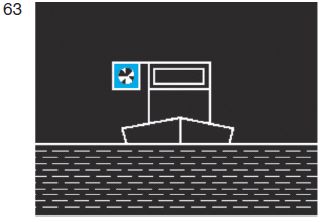 |
-
b)
-
by day:
a light blue blackboard with a white light-coloured light
is coupled. |
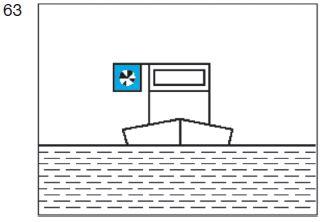 |
-
The light blue panel must have a white margin of at least 5.00 cm wide, frame and linkage as well as the lamp of the sparkle must be of dark colour only. These characters must be visible in advance and from the aft and shown up to the end of the journey. They may no longer be retained unless the mountain driver intends to indicate his intention to continue to let a driver pass by to starboard.
-
4.
-
If it is to be feared that the driver's intention has not been understood by the driver, the mountain driver must give the following signs:
-
a)
-
"a short sound" when the pre-accession is to take place on the backboard;
-
b)
-
"two short notes" if you want to get to the starboard at starboard.
-
5.
-
Without prejudice to § 6.05, the cyclist shall take the road which the mountain driver has in accordance with the above provisions; he must reciprocate the line of sight referred to in point 3 and the sound sign referred to in point 4 which the mountain driver has addressed to them.
Unofficial table of contents
Section 6.05 Exceptions to the general provisions governing the encounter
-
1.
-
By way of derogation from § 6.04
-
a)
-
a passenger ship, travelling to the valley, which has a regular service and whose maximum number of passengers is at least 300 persons, if it wishes to apply to a landing bridge situated on the shore held by the mountain driver,
-
b)
-
a trawl that is going down to the valley, which wants to keep a certain shore for the purpose of spinning,
-
require the mountain driver to release him another way, if the way he has been given in accordance with § 6.04 is not suitable for him. However, he may only do so after he has satisfied himself that his desire can be met without danger.
-
2.
-
In the cases referred to in point 1, the driver must give the following signs in good time:
-
a)
-
"a short sound" when the pre-accession is to take place on the backboard;
-
b)
-
"two short notes" and also the visual signs according to § 6.04 (3), if the pre-accession is to be held on starboard.
-
3.
-
The mountain driver must comply with the driver's request, and confirm this as follows:
-
a)
-
The route to the backboard should take place, they must give "a short sound" and also remove the line of sight according to § 6.04 number 3;
-
b)
-
The route to the starboard is to take place, they must give "two short notes" and also the visual signs according to § 6.04 number 3.
-
4.
-
If it is to be feared that the driver's intentions have not been understood by the mountain driver, the cyclist must repeat the sound signs in accordance with point 2.
Unofficial table of contents
§ 6.06
(no content)
Unofficial table of contents
§ 6.07 Encounter in the narrow running water
-
1.
-
In order to avoid, as far as possible, a meeting on a route or at a point where the water does not provide sufficient space for the passage (waterway), the following shall apply:
-
a)
-
a vehicle must travel through a waterway in as short a time as possible; the overtaking is prohibited;
-
b)
-
in the case of a restricted view, a vehicle must be "sound" before it enters a waterway; it must repeat the sound signal at intervals of not more than one minute during the passage;
-
c)
-
a mountain driver must, when he finds that a cyclist is in the process of moving into a waterway, stop below the limit until the cyclist has passed through it;
-
d)
-
if a vehicle or a bandage has already been driven into a waterway, if possible, it must remain above the end until the mountain driver has passed through it.
-
2.
-
If the encounter in a waterway is unavoidable, the vehicles must take all possible measures to ensure that the meeting takes place in one place and under conditions that close the risk as little as possible.
Unofficial table of contents
§ 6.08 Forbidden by shipping signs
-
1. **)
-
On a route, the beginning of which is indicated by the Table A.4
(Appendix 7) is marked, is the encounter and overtaking
forbidden.
|
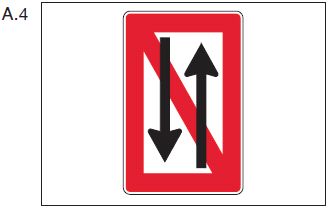 |
-
The prohibition referred to in the first sentence may be restricted to vehicles and associations from a specified length or width, in which case the length or width shall be indicated on a rectangular white additional table below the table A.4 is appropriate. For a route marked in accordance with the first sentence, the provisions of Section 6.07 (1) shall apply mutatily.
-
2.
-
Where the competent authority on a given route is
Countered by the fact that they only pass through the passage
in one direction means:
-
a)
-
a general character A.1 (Appendix 7):
no passage;
|
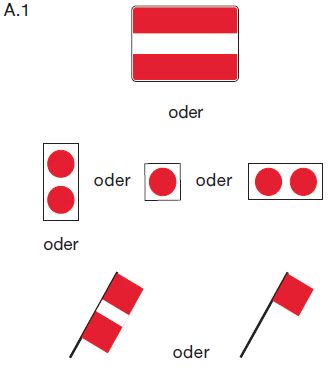 |
-
-
b)
-
a general character E.1 (Appendix 7):
-
Pass free.
|
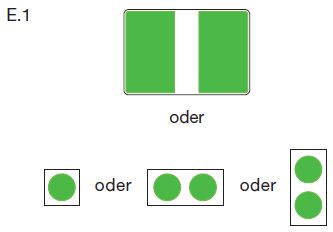 |
Depending on the local circumstances, the sign that the
Pass through, which is used as an early warning sign
Table sign B.8 (Appendix 7) will be announced. |
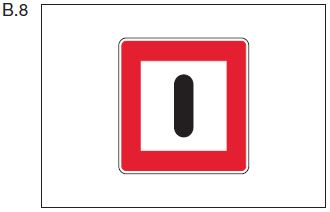 |
Unofficial table of contents
§ 6.09 General provisions for overtaking
-
1.
-
Overtaking is only permitted after the overhaul has verified that this maneuver can be carried out without danger.
-
2.
-
The advance must facilitate the overhaul, as far as this is necessary and possible. It must, if necessary, reduce its speed, so that the overtaking manoeuvre can be carried out safely and so quickly that the rest of the traffic is not obstructed.
Unofficial table of contents
§ 6.10 Behaviour and drawing of vehicles during overtaking
-
1.
-
The overtaking may be overhauled on the back board or on the starboard's starboard control board. If overtaking is possible without having to change the course of the course, the overtaking does not give a sound sign.
-
2.
-
If the overtaking cannot be carried out without the person in advance changing his course, or if it is to be feared that the person in advance has not recognized the intention of the overhaul and thereby the risk of a collision will arise , the overtaking must be subject to the following sound signs:
-
a)
-
"two long tones, two short notes", if he wants to overtake the backbord of the front-running person;
-
b)
-
"two long notes, a short sound" when he wants to overtake the front-line driver's starboard.
-
3.
-
If the person in advance can meet the request of the overhaul, he/she must leave enough room for the overhaul at the desired side, if necessary, by escaping to the other side.
-
4.
-
If the overtaking is not possible on the one hand, but on the other hand, the front end must give the following sound marks:
-
a)
-
"a short sound" when the overtaking on the back board is possible;
-
b)
-
"two short notes", if the overtaking on starboard is possible.
-
The overtaking must, if it still wants to overtake under the circumstances now given, give the following sound signs:
-
a)
-
"two short notes" in the case of sentence 1 (a);
-
b)
-
"a short sound" in the case of sentence 1 (b).
-
The front end must then leave enough room for the overhaul to the side where the overtaking is to take place, if necessary, by way of the other side.
-
5.
-
If a driverless overtake is impossible, the front end must give "five short notes".
Unofficial table of contents
Section 6.11 Prohibition of overtaking by shipping signs
Without prejudice to § 6.08 (1)
-
1.
-
on a route, the beginning of which is indicated by the table sign A.2
(Annex 7) is marked, a general overtaking ban;
|
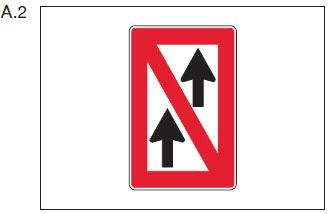 |
-
2.
-
on a route, the beginning of which is indicated by the table sign A.3
(Annex 7) is a ban on the overtaking of associations between them;
this shall not apply, provided that one of the associations is a thrust federation,
the length of which shall not exceed 110,00 m and its width shall not exceed 12,00 m.
|
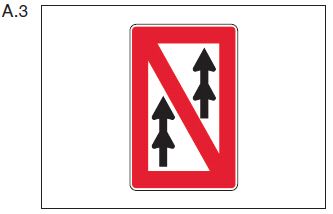 |
Section III.
More rules for driving
Unofficial table of contents
§ 6.12 Ride on routes with prescribed course
-
1.
-
On a route marked with one of the Table Signs B.1, B.2a, B.2b, B.3a, B.3b, B.4a or B.4b (Appendix 7), a vehicle must follow the course prescribed by the panel character.
-
2.
-
On a route marked in accordance with point 1, the following shall apply:
-
a)
-
a mountain driver who stops on the shore on his side of the backboard must constantly show the visual signs in accordance with Section 6.04 (3);
-
b)
-
a mountain driver, in pursuit of the course prescribed for him by the taboo signs referred to in paragraph 1, crosses the water from the starboard to the port, he must set in good time the line of sight referred to in point (a); he shall cross the drip in the opposite direction, it must remove these visual signs in good time;
-
c)
-
a mountain driver must not in any case hinder the ride of the driver; in particular, if he approaches the table marks B.4a or B.4b, he must, if necessary, reduce his speed and even stop so that the driver is his maneuver can complete.
Unofficial table of contents
§ 6.13 Apply
-
1.
-
A vehicle may only apply,
-
a)
-
after having verified that the rest of the traffic, taking into account the following points 2 and 3, does so without danger; and
-
b)
-
another vehicle will not be forced to change its course or its speed immediately.
-
2.
-
If the intended maneuver may force or force another vehicle to deviate from its course or to change its speed, the vehicle that wishes to turn must announce its intention in time as follows:
-
a)
-
by "a long sound, a short sound", when it wants to turn over starboard;
-
b)
-
by "a long sound, two short notes", if it wants to turn over backbord.
-
3.
-
The other vehicle must, if necessary and possible, change its speed and course so that the turn can be carried out without danger.
-
4.
-
On a sign indicated by Table A.8 (Appendix 7)
Distance is forbidden to turn.
|
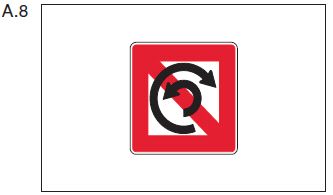 |
-
If a route is marked by Table E.8 (Appendix 7),
the ship's guide shall be recommended to turn there, taking into account the
Points 1 to 3 are to be complied with.
|
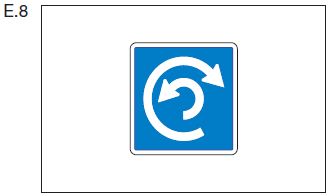 |
-
Is a route through the E.8 table sign (Appendix 7) with one below
attached additional rectangular white panel,
it is recommended to the skipper to use a vehicle up to
the length indicated on the additional board and the length specified on the table
Waterway permissible unloading depth to be used there, where the
Points 1 to 3 shall be complied with.
|
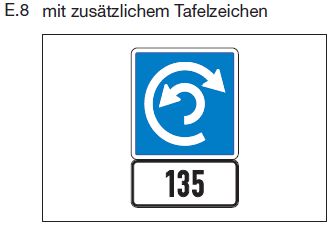 |
Unofficial table of contents
§ 6.14 Behaviour before departure
-
1.
-
Section 6.13 (1) to (3) shall apply, in accordance with point 2 below, for a vehicle leaving its berth or anchorage without turning to the vehicle.
-
2.
-
A vehicle leaving its berth or anchorage shall have the following signs, instead of the sound signs referred to in section 6.13 (2):
-
a)
-
"a short sound" when it sets its course to starboard;
-
b)
-
"two short notes" when it sets its course to backbord.
Unofficial table of contents
Section 6.15 Prohibition of the entry into force of
the distances between parts of a tractor
It is forbidden to move into the spacings between the parts of a towing belt.
Unofficial table of contents
Section 6.16 Cross the waterway;
Entrance to and exit from ports and side-waterways
-
1.
-
A vehicle may be
-
a)
-
only exit from a port or a side waterway and turn into the main waterway,
-
b)
-
cross the main waterway or
-
c)
-
into a port or a side waterway,
-
after making sure that the manoeuvre can be carried out without any risk and without the need for another vehicle to change its course or its speed without any risk. A cyclist, who has to turn up to a port or a side waterway to enter, has a mountain driver who also wants to go in, to leave the ancestor.
A waterway that is to be considered as a side waterway can be marked by a table sign E.9 or E.10 (Appendix 7).
The main waterway used meets one of the two sides
The side waterway that opens up. |
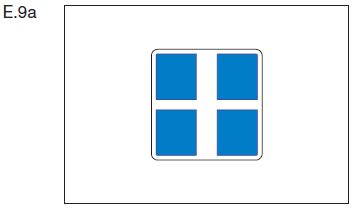 |
The main waterway used meets one of starbord
The side waterway that opens up. |
E.9b |
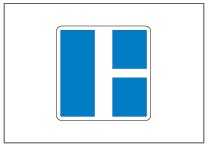 |
The main waterway used meets one of the backbord
The side waterway that opens up. |
E.9c |
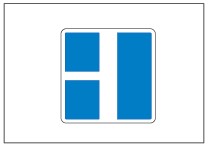 |
The side waterway used meets one of the two sides
the main waterway that opens up. |
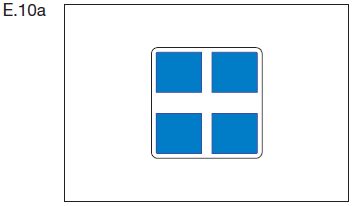 |
The side waterway used opens into a
Main waterway. |
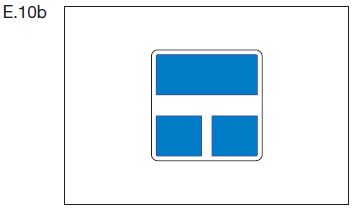 |
-
2.
-
A vehicle, other than a ferry, which intends to force or compel another vehicle to change its course or speed, shall announce its intention in good time as follows:
-
a)
-
by "three long tones, a short sound", if it wants to set its course to starboard before the entrance or after the exit;
-
b)
-
by "three long tones, two short notes", if it wants to set its course to backbord before the driveway or after the exit;
-
c)
-
by "three long tones", if it wants to cross the waterway after the exit; if it wants to change its direction before the end of the cross, there must be:
-
aa)
-
"a long tone, a short sound", if it wants to set its course to starboard;
-
bb)
-
"a long sound, two short notes" if it wants to set its course to backbord.
-
The other vehicle must then change its course and its speed as necessary.
-
3.
-
If a sign B.9a or B.9b (Appendix 7) is attached at the exit of a port or at the mouth of a secondary waterway, a vehicle coming from the port or from the side waterway may only turn into the main waterway or it may be if a vehicle on the main waterway is not forced to change its course or its speed.
-
4.
-
A red light, sign A.1 (Appendix 7), with a white arrow
(Section II, point 2 (c) of Annex 7) indicates that the entry into force
in the port in the direction of the arrow or in the direction in the direction of the arrow
Side waterway is prohibited.
|
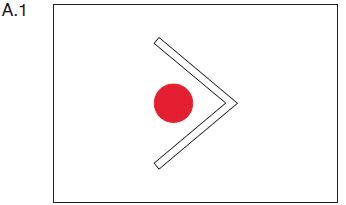 |
-
5.
-
A yellow sparkle light (sign E.12a of Appendix 7) at a port estuary
or the mouth of a side waterway indicates that a
The vehicle is travelling and the driveway is therefore to be used with caution.
shall be made. A vehicle in the main waterway must then,
as far as necessary, change its course and speed.
|
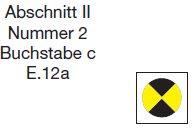 |
-
6.
-
If the signs referred to in points 4 and 5 are not given, enter into a secondary waterway or a port whose mouth or its mouth does not provide sufficient space for a simultaneous entry and exit, unless a vehicle is not in use .
Unofficial table of contents
§ 6.17 Drive on the same level; Prohibition of approximation to vehicles
-
1.
-
Vehicles must not drive at the same level. Small vehicles shall be allowed to travel at the same altitude if the available space is permitted without any disturbance or danger to shipping.
-
2.
-
Except in the case of overtaking, encountering or forgetting, it shall be prohibited to drive closer than 50.00 m to a vehicle or a bandage which shall lead to a name in accordance with section 3.14 (2) or (3).
-
3.
-
The application or attachment to a vehicle or a float in the ride as well as the driving in the sogwater are prohibited without the express permission of the ship's guide. § 1.20 shall remain unaffected.
-
4.
-
Persons who do not operate water sports with a vehicle shall keep from a vehicle or flotation body in driving or from a floating device during work so far that the navigation or the work of the floating device is not disturbed or at risk.
Unofficial table of contents
Section 6.18 Prohibition of the looping of anchors, trosses or chains
-
1.
-
It is forbidden to grind an anchor, a trosse or a chain.
-
2.
-
The prohibition referred to in point 1 shall not apply either to the driver's leave, provided that:
this is permitted, even for small movements on a berth
and transshipment point as well as on a talk. However, it shall apply to such
Movements on a route for which a general ban on anchorage
, and on a route which is referred to in Article 7.03 (1)
Point (b) is indicated by Table A.6 (Appendix 7).
|
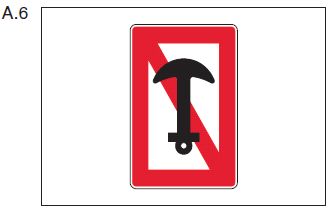 |
Unofficial table of contents
§ 6.19 Shipping by Driveway
-
1.
-
Navigation by driving can be prohibited without the permission of the competent authority.
-
2.
-
The prohibition referred to in point 1 shall not apply to a small vehicle and to small movements on a reclining location, transhipment point, reede and towing area.
-
3.
-
A vehicle that moves Bug to Mount with a forward-running engine to the valley is not considered to be a driving vehicle, but as a mountain driver.
Unofficial table of contents
§ 6.20 avoidance of wave impact
-
1.
-
A vehicle shall set up its speed in such a way as to avoid wastage or soggy which may cause damage to a vehicle or body which is stationary or which is in motion, or which can cause damage to an installation. It must reduce its speed in time, but not to the extent necessary for its safe control:
-
a)
-
in front of a port injunction;
-
b)
-
in the vicinity of a vehicle on the shore or on a landing bridge
is fixed or is being loaded or erased;
-
c)
-
in the vicinity of a vehicle which is stationary on a normal reclining location;
-
d)
-
in the vicinity of a non-free-running ferry;
-
e)
-
on a route marked by the sign A.9 (Appendix 7).
|
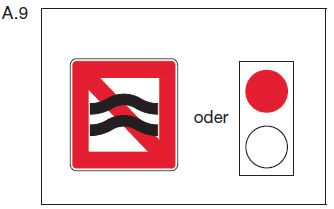 |
-
2.
-
In the case of a small vehicle, the obligation referred to in the second sentence of paragraph 1 (2) (b) and (c) does not apply; § 1.04
-
3.
-
When Passing By
-
a)
-
on a vehicle which is referred to in the second sentence of Article 3.25 (1) (2) (a),
-
b)
-
on a vehicle, a floating body or a floating installation, the name of which shall be referred to in section 3.29 (1), or
-
c)
-
in one place and in a vehicle, which shall be referred to in paragraph 8.12;
-
another vehicle must reduce its speed, as required in point 1. It also has to keep as wide a distance as possible.
Unofficial table of contents
Section 6.21 Compilation of associations
-
1.
-
A vehicle with a machine drive, which moves a dressing, must have sufficient machine power to ensure the good maneuverability of the association.
-
2.
-
Except in the case of rescue or assistance in emergencies, a vehicle equipped with a machine drive may be used for towing, pushing or locomoting vehicles coupled with the vehicle, in so far as this is in its travel certificate is approved. In this case, the vehicle with a machine drive, which in the case of coupled vehicles has the main driving force, must be located on the starboard side. However, if one or more vehicles are carried along without a machine drive, one may be coupled to the control board side.
-
3.
-
A passenger ship and a passenger barge carrying passengers on board shall not be allowed to travel longitudinally; it or it shall not be dragged or towed unless this is necessary for the towing of a damaged vehicle is required.
-
4.
-
Point 2, first sentence, shall not apply
-
a)
-
for the towing of a small vehicle by another vehicle, and
-
b)
-
for the towing and uncoupled movement of a sports vehicle, which is a small vehicle, by another sports vehicle which is a small vehicle, provided that the ship's driver ensures safe towing or coupled forward movement.
Unofficial table of contents
Section 6.22 Locking of shipping and blocked water areas
-
1.
-
If the competent authority has a general character A.1
(Annex 7) announcises that shipping is blocked,
Stop the vehicle before the sign. Specific vehicle garden
may be exempted.
|
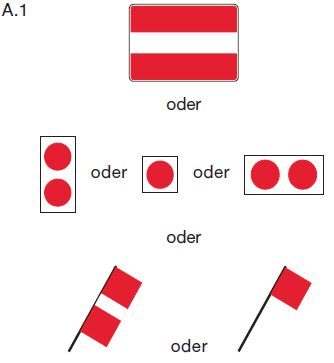 |
-
2.
-
The driving of a water surface, which is caused by the potable sign
A.1a (Appendix 7), is a vehicle or a vehicle
Floating body-with the exception of a small vehicle without
Drive machine-forbidden.
-
3.
-
The driving of a water surface, which is through the straight line
between two or more characters as specified in point 1 or by
a series of yellow tonnes (Annex 8, Section VIII, Figure 33/34)
, all vehicles and floating bodies shall be prohibited.
|
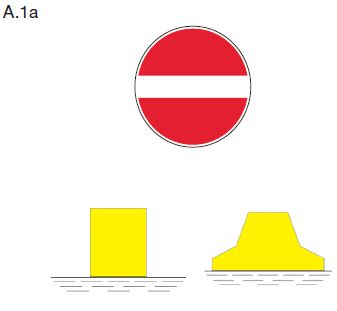 |
Unofficial table of contents
Section 6.22a Pre-travel on floating devices
in the case of work as well as fixed or sunken vehicles
(Annex 3: Pic 50a, 50b, 52)
It shall be prohibited to pass on to one of the vehicles referred to in § 3.25 on the side of the vehicle
-
1.
-
the red light after
Section 3.25 (1)
Sentence 1 (b)
Double letter aa,
Sentence 2 (b)
Double letter aa,
Point 2, sentence 1,
|
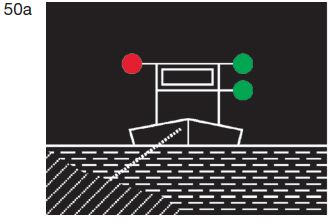 |
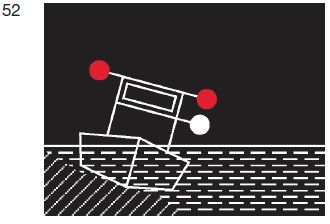 |
-
2.
-
the panel character
A.1 (Annex 7)
or the red ball
in accordance with § 3.25
Sentence 1 (1)
Letter b, double letter bb
|
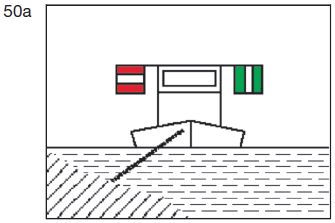 |
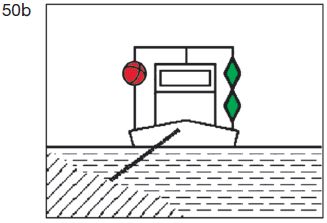 |
or
-
3.
-
the red flag in accordance with section 3.25 (1) sentence 2 (b)
Double letter bb, number 2, sentence 1
|
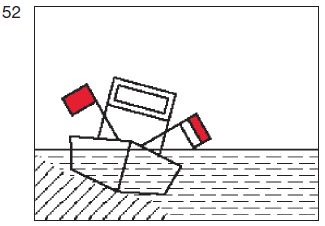 |
shows.
Section IV.
Ferries
Unofficial table of contents
§ 6.23 Behaviour of ferries
-
1.
-
A ferry may only cross a waterway if it has verified that the rest of the traffic permits a safe crossing and another vehicle is not forced to change its course or its speed immediately.
-
2.
-
In addition, the following shall apply to a non-free-running ferry:
-
a)
-
as long as a ferry is not in operation, it shall take the berth assigned to it by the competent authority; if it is not assigned a berth, it shall be so free that the water remains free;
-
b)
-
a ferry with a longitudinal cable, which is anchored in such a way that it can block the water, must be on the side of the waterway which is opposite to the anchorage of the rope, only as long as it is absolutely necessary for loading and loading; this period may require an approaching vehicle, with the exception of a small vehicle or an association consisting exclusively of small vehicles, from the ferry to require the water to be released by giving it a "long sound" in good time;
-
c)
-
the ferry must no longer be in the running water when the operation requires it.
Section V.
Passing through bridges, weirs and locks
Unofficial table of contents
Section 6.24 General regulations for the passage of bridges and weirs
-
1.
-
§ 6.07 shall apply in a bridge opening or a conscription opening, unless the running water provides sufficient space for the simultaneous passage.
-
2.
-
If a bridge opening or a weir opening is marked
-
a)
-
By means of Table A.10 (Appendix 7), the shipping in this
Opening outside of the through the two panels
this character is prohibited from this character;
|
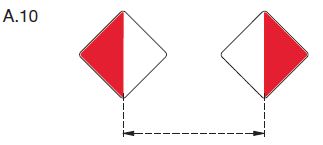 |
-
b)
-
by the Table D.2 (Appendix 7), shipping is recommended,
in this opening in the one by the two panels of this sign
limited space.
|
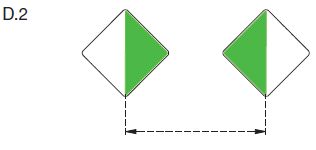 |
Unofficial table of contents
§ 6.25 transit under fixed bridges
-
1.
-
Is a certain opening of fixed bridges through a general
Sign A.1 (Appendix 7), is the passage of this
Opening forbidden.
|
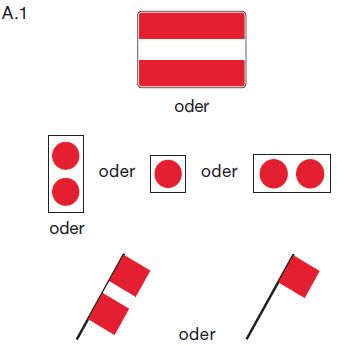 |
-
2.
-
Is a defined opening of fixed bridges
-
a)
-
by the character D.1a (Appendix 7)
|
 |
-
or
-
b)
-
by the character D.1b (Appendix 7)-attached via
the bridge opening-
|
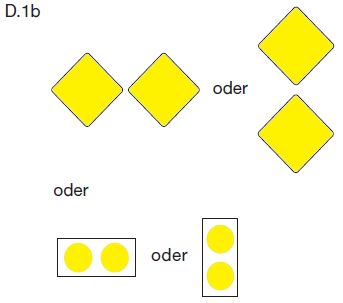 |
-
is recommended, preferably to use this opening. If the opening is indicated in point (a) of the first sentence, the passage in both directions is permitted; if it is marked in accordance with the first sentence of 1 (b), the passage shall be prohibited in the opposite direction.
-
3.
-
Where a defined opening of fixed bridges is identified in accordance with point 2, the shipping may use the unmarked openings at its own risk.
Unofficial table of contents
Section 6.26 Movement of movable bridges
-
1.
-
Without prejudice to § § 6.07, 6.08 and 6.24, the carrier or the person responsible pursuant to section 1.03 (3) for course and speed shall, when approaching a movable bridge and in transit, comply with the instructions given to him or her: it is granted by the bridge supervisor for the safety and lightness of traffic and for speeding up the passage.
-
2.
-
When approaching a movable bridge, a vehicle must be
slow down his ride. It has to be when it's opening the bridge
requires "two long tones". Up to the release of the transit
it must be at least 50.00 m away from the bridge,
unless the table sign B.5 (Appendix 7) is a different distance
. Or if a vehicle cannot or doesn't want to go through the bridge,
it must be marked on the shore by table sign B.5 (Appendix 7),
to stop before this.
|
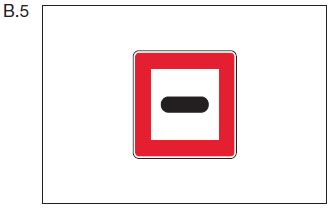 |
-
3.
-
When approaching a movable bridge, the overtaking without special permission of the bridge supervisor is prohibited.
-
4.
-
If the passage is controlled by signal lights by day and by night, these light signals have the following meanings:
-
a)
-
two red lights on top of each other:
no passage (bridge locked);
-
b)
-
three red lights side by side:
no passage (bridge closed, it cannot be opened temporarily);
-
c)
-
Two red lights next to each other:
no passage (bridge closed or cross-traffic);
-
d)
-
a red light:
no passage (bridge in motion);
-
e)
-
Two green lights side by side:
Passage free (bridge open).
-
The lights are visible only in the direction of the passage.
-
5.
-
Where an additional white light is shown above the signal lights referred to in point 4 (b) or (c), a vehicle shall be allowed to pass through the closed bridge if the level of transit or oncoming traffic permits it to be safe.
Unofficial table of contents
§ 6.27 Passage of the weirs
-
1.
-
The passage of a weir opening is forbidden. The ban, a
Through the sign A.1 (Appendix 7), the opening of the defensive opening
are displayed.
|
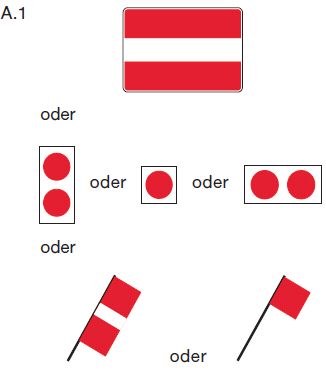 |
-
2.
-
The passage of a conscription opening shall be permitted only if the
on the left and right by a general sign E.1 (Appendix 7)
).
|
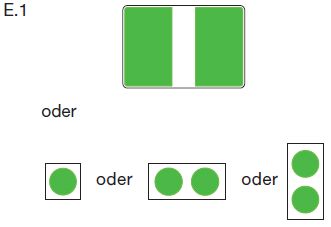 |
-
By way of derogation from the first sentence, in the case of a weir with a weir,
Passing through a weir opening also through the one on the weir
Characters D.1 attached above the opening (Appendix 7)
.
|
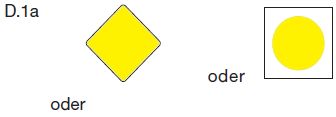 |
| |
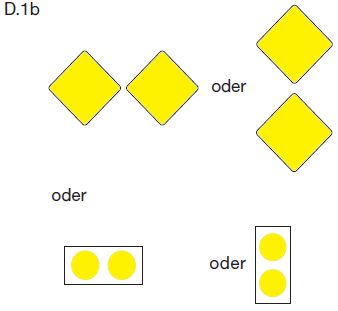 |
-
3.
-
An individually moving vehicle or a bandage must not travel at greater speed through a weir opening than is required for its control. In the area of a pipe, the machine must be kept in such a way that the vehicle or the dressing is manoeuvrable at all times.
-
4.
-
A closed safety gate and a flood barrier door can only be used up to a distance of 100,00 m.
Unofficial table of contents
§ 6.28 transit of the locks
-
1.
-
The lock area includes:
-
a)
-
the sluices and
-
b)
-
the water surfaces above and below the locks, which serve for the celebration, classification and maintenance of vehicles as well as for the assembly and dissolution of associations (Schleusenvorhafen).
-
The competent authority may, by way of derogation from the first sentence, determine the area of the lock; in this case, its definition shall be marked by white panels with a black border and the black inscription "Schleusenbereich" ("Smuggling area").
-
2.
-
When approaching the lock area, a vehicle must be
Slow down. Can or does not want to be immediately into the lock
, if on the shore the table sign B.5 (Appendix 7)
is to be held in front of it.
|
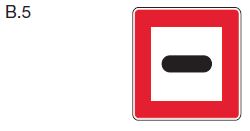 |
-
3.
-
In the smuggling area, overtaking is prohibited. A vehicle may only pass by another vehicle waiting for the lock if it is to be carried forward or in order to place itself in an existing gap. In the lock area, drive and auxiliary machines may only be operated in the extent necessary for the ship and on-board operation. In this case, the doors of the machine room are to be kept closed. Other openings in the machinery space must be closed as far as the operation permits. The landing point of a ferry or a passenger ship shall be kept free.
-
4.
-
In the lock area, a vehicle equipped with a telephone system for the Nautical Information traffic circuit must have switched the channel of the lock to receive it.
-
5.
-
In the lock area, the anchors must be completely taken up. Sentence 1 shall not apply if it is to be used outside the lock.
-
6.
-
If there are several locks, a vehicle has to control the lock assigned to it. The instructions for this can be given by day and by night by the direction wishers described in § 6.28a. A vehicle, the dimensions of which are smaller than those of an existing boat lock, shall be used, provided that the control of the tractors does not give any other instruction.
-
7.
-
Before entry into the lock, the towed trousers must be short-fetched as well as equipment parts-except for such equipment which are required for fending-binnenbords. The driver of a damaged vehicle must draw the attention of the lock to the damage before the entrance to the damage, provided that the damage can endanger the lock area or another vehicle.
-
8.
-
A vehicle must reduce its speed in the event of a ride in the sluice ports and the entrance into the locks in such a way that a safe stopping by means of wire ropes, ropes or other appropriate measures is possible under all circumstances. and an impact to a lock gate or to the protective devices, as well as to another vehicle or to a floating body is excluded. In the floodgates equipped with floats, only the edge and niche poller can be used for stopping. A floating poller may not be occupied until the vehicle or the association has come to a standstill. The ship's guide shall ensure that the vehicle stops in good time by means of supporting the poller or holding crosses of the lock chamber with wire ropes or ropes in an emergency, even without a power force. It shall also ensure that the cover crew, which is required for safe passage through the lock, is from the beginning of the journey into the lock to the end of the exit from the lock on deck. A vehicle or a floating body must move into the lock chamber to such an extent that the following vehicles or floating bodies are not obstructed during the driveway and in the utilization of the lock chamber. In particular, the last or the last vehicle or floating body entering the upper water must advance to such an extent that it or it cannot set up on the rotary arm during emptying of the lock chamber.
-
9.
-
In the Schleusenkammers
-
a)
-
a vehicle has to be kept within these limits, provided that borders are marked on the lock walls,
-
b)
-
a vehicle must be fixed during the filling and emptying of the lock chamber and until the exit is released, and the fixing means must be operated in such a way as to prevent shocks against the sluice walls, the lock gates or the protection devices as well as against another vehicle or a floating body are avoided;
-
c)
-
are to be used for fender, which must be able to swim if they are not firmly connected to the vehicle,
-
d)
-
it is forbidden,
-
aa)
-
to wash off or reverse a vehicle or a floating body,
-
bb)
-
water or float water from a vehicle or a floating body to a lock platform, to another vehicle or to a floating body, or to discharge it,
-
cc)
-
enter and leave passengers without the permission of the lock supervisor,
-
e)
-
it shall be prohibited to use the machine drive and the bow blasting system after the vehicle has been arrested until the exit is released, unless this is necessary in the short term for safety reasons,
-
f)
-
a small vehicle or an association consisting exclusively of small vehicles shall keep sufficient distance from other vehicles.
-
10.
-
In the case of a lock, a distance of at least 10.00 m must be maintained for a vehicle or a bandage which, according to section 3.14 (1), (2) or (3), is designated. However, this shall not apply to a vehicle or an association which carries the same name and for the vehicle referred to in section 3.14 (7).
-
11.
-
A vehicle or an association which carries the name in accordance with section 3.14 (2) or (3) must be carried out on its own. By way of derogation from the first sentence, a dry goods vessel may be transported to ADN, container, bulk packaging (IBC), large packaging, multi-element gas container (MEGC), tank container and transportable tanks according to ADN subsection 7.1.1.18 and the Name in accordance with section 3.14, point 2, together,
-
a)
-
with a similar vehicle,
-
b)
-
with a dry goods vessel, container, bulk packaging (IBC), large packages, gas containers with several elements (MEGC), tank containers and transportable tanks transported in accordance with ADN subsection 7.1.1.18 and the name according to § 3.14 point 1 leading or
-
c)
-
with the vehicle referred to in Section 3.14 (7).
-
A minimum distance of 10,00 m must be maintained between the bow and stern of the vehicles which are being thrown together in accordance with the second sentence.
-
12.
-
A vehicle or an association which carries the name in accordance with section 3.14 (1) shall not be taken together with a passenger ship which has passengers on board.
-
13.
-
A lock, which is not specially designed for operation by the ship's staff, may only be served with the permission of the lock inspection.
-
14.
-
The official notices and instructions provided on a remote or self-contained lock on signs, signs with electronic writing or in a similar manner shall be used, and provided that a self-service is provided, to pay attention to the operation of the lock.
-
15.
-
A vehicle or a floating body which is not intended for smuggling may only be stationary in the lock area if it is generally approved by the competent authority or is permitted in individual cases by the control of the toil.
-
16.
-
The ship's driver of a vehicle that wants to load or delete the next lock on the route, and the leader of an association, who wants to take up or drop other vehicles up to the next lock, must indicate this to the lock inspection.
-
17.
-
For reasons of safety and lightness of traffic, for the purpose of speeding up transit or for the full exploitation of the locks, the control of the toil may give orders which supplement or deviate from this provision. The ship's guide has to comply with these arrangements in the lock area.
Unofficial table of contents
§ 6.28a Schleuseneinfahrt und -ausfahrt
-
1.
-
If there are several locks, the instructions for use are given by directional guides, which consist of two white signal lights next to each other, which have the following meaning:
-
a)
-
Linkes fixed light, right common mode:
Use the right lock;
-
b)
-
right light, left common mode light:
use the left lock;
-
c)
-
both fixed lights:
wait until the briefing;
-
d)
-
both common-mode lights:
the two locks can be used.
-
A vehicle which, because of its dimensions, can only use a certain lock, has to wait until it is allocated to it.
-
2.
-
The entrance into the lock is controlled by signal lights at day and at night, which are shown on one side or on both sides of the lock. These signal lights have the following meanings:
-
a)
-
two fixed red lights on top of each other:
Entry prohibited, lock out of service;
-
b)
-
a fixed red light or two fixed red lights side by side:
Entry prohibited, lock closed;
-
c)
-
the extinguisher of one of the two red lights next to each other or a solid red and a solid green light next to each other or a solid red and a solid green light one on top of the other:
Entry forbidden, opening of the lock is prepared;
-
d)
-
a solid green light or two solid green lights side by side:
Entry allowed.
-
In addition to the first sentence, the entry into the lock can be specially regulated by additional signal lights during the day and at night for a small-and sports-vehicle. The signal lights as set out in the third sentence shall consist of one red and one green common-mode light side-by-side and shall be marked with an additional sign referred to in Annex 7, Section II, point 3, with the reference "Small and sports vehicle"; they shall be together with the signal lights as set out in the first sentence or at the waiting points specially designated for small and sports vehicles. If signal lights are present in accordance with the third sentence, only these are relevant for a small-and sports-vehicle for the entrance. The signal lights as set out in sentence 3 in conjunction with sentence 4 have the following meanings:
-
a)
-
a red common-mode light (repetition frequency 12 seconds):
Entry prohibited for small and sportscars;
-
b)
-
a green common-mode light (repetition frequency 12 seconds):
Entry for small and sports vehicles allowed.
-
The prohibition of entry in accordance with the first sentence in conjunction with the second sentence of the second sentence, including the first sentence of the first sentence of paragraph 4, or the third sentence of the third sentence in conjunction with the fifth sentence and the first sentence of 6 (a), also in conjunction with the first sentence of point 4, shall be taken into account.
-
3.
-
The exit from the sluice is regulated by the following signal lights at night and at night:
-
a)
-
a fixed red light or two fixed red lights:
Exit prohibited;
-
b)
-
a solid green light or two solid green lights:
Exit allowed.
-
The prohibition of the exit referred to in the first sentence of 1 (a) must be observed.
If there are several locks and is released for all the exit, the vehicle coming from starboard has the way forward.
-
4.
-
In place of the red light or the red lights referred to in the first sentence of paragraph 2, in conjunction with the second sentence and the third sentence, the table symbol A.1 (Appendix 7), instead of the green light or the green lights as referred to in the first sentence of the second sentence, may be used in conjunction with the second sentence and the number of the red lights referred to in 3 can be set to Table Sign E.1 (Appendix 7).
|
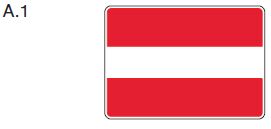 |
| |
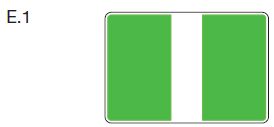 |
-
5.
-
If no signal lights or any table signs are shown, the entry into the lock or the exit from the lock is prohibited without a special arrangement of the lock inspection.
Unofficial table of contents
§ 6.29 Order of the Schleusungen
-
1.
-
Unless otherwise specified below, it will be carried out in the order of arrival in front of the lock, in the case of several locks in front of the selected lock or lock assigned by direction wishers according to § 6.28a. The choice of the lock must not be changed without the special permission of the lock supervisor.
-
2.
-
If a starting position is set up in the lock area, it shall be delimited against the remaining berths by the table symbol B.5 (Appendix 7), which is provided with a white additional sign with the inscription "Startplatz". The starting position is designated as a berth for a vehicle in the train to the next lock and may only be occupied by this vehicle. By way of derogation from the first and second sentences of point 3, a vehicle waiting for smuggling may remain on its berth at the start of the journey to the starting position. If there are several vehicles next to each other, the vehicles on the outside have to allow the inside of the vehicle to take the starting position in time. Any new vehicle entering the lock area must be notified in the case of the lock inspection for the detection of the train of locks. Waiting in the lock area above or below a lock, which is not specially designed for operation by the ship's staff, already more than five vehicles (ship collection), the train of locks shall be determined by way of derogation from point 1. after the order of registration. In the case of a ship's collection, the launch site may only be occupied by the lock supervisor upon prior request.
-
3.
-
A vehicle pending for smuggling shall, subject to the regulation referred to in point 2, be such that it can be moved into the lock immediately after the sign to enter the lock. If a vehicle fails to move on, it will lose its rank for the impending lock. A vehicle that is not ready for entry to the sign for entry will be returned until it has finished its preparations.
-
4.
-
A vehicle of the Federal Water and Shipping Administration of the Federal Republic, a vehicle on the road for the performance of territorial tasks or a vehicle which is seriously damaged in front of all other vehicles shall have the right to smuggling in addition to the series (sluice priority); the same shall apply to a rescue or fire-extinguishing vehicle on the journey to the accident site.
-
5.
-
On request, priority shall be given in the order of precedence over vehicles other than those referred to in paragraph 4 above:
-
a)
-
A day-trip ship which travels according to a fixed timetable according to § 9.01;
-
b)
-
a vehicle with the permission of the competent authority.
-
These vehicles must show the red wimpel according to § 3.17. After each mountain-lock or any trough of a vehicle which has claimed its preroe, the vehicles which have been put back are to be moved in the same direction without any prior right. In no case shall the right to lock the vehicle to be carried at a pre-set time.
-
6.
-
For safety reasons, the control of the towing of a vehicle may give different orders for the smuggling of a vehicle with dangerous goods.
-
7.
-
Small or sports vehicles, unless they can use a boat lock, boat alley or boat transfer system, are only used in groups or in conjunction with other vehicles. Exceptionally, a small or sports car can also be taken individually, provided that the duration of the waiting period is unreasonable. A small-or sports-powered vehicle equipped with speaking radio can also be individually hauled without waiting times after registration at the lock, provided that it is used with the rest of the traffic volume, the traffic situation and measures to be taken. storage of the waterway is compatible. In the event of a joint lock on a small or sports vehicle with other vehicles, a small or sports car must first enter the lock after the other vehicles and when requested by the lock inspection system. If the entry into the lock for a small or sports vehicle is regulated by special signal lights in accordance with section 6.28a (2) sentence 3 in conjunction with the fourth sentence, a small or sports car must not be allowed to enter the lock until after the entry has been released by the special vehicle. Enter the signal lights into the lock.
-
8.
-
For reasons of transport needs or due to operational requirements, the lock-in hours fixed by the regulation may be temporarily dismissed.
Unofficial table of contents
§ 6.29a Transit of the ship's lift
§ § 6.28, 6.28a and 6.29 are also to be applied to a ship lift. In this case, the ship's lift is replaced by the area of the ship's lift and, in the case of the control of the lock, the vessel's lift.
Section VI.
Unsafe weather; use of radar
Unofficial table of contents
§ 6.30 General rules for driving in the event of insecure weather
-
1.
-
In case of unsafe weather, a vehicle must use radar, subject to the number 5.
-
2.
-
In the event of insecure weather, a vehicle must adjust its speed of reduced visibility, traffic and local conditions accordingly. There must be a different vehicle with the necessary messages for security.
-
3.
-
When stopping in the event of insecure weather, the driving trough is to be made free as much as possible.
-
4.
-
In the event of insecure weather, a small vehicle may only drive if it is equipped, in addition to the number 1, with a radio telephone system for inland waterway radio and it shall be on channel 10 or the other channel assigned by the competent authority. has been switched to reception.
-
5.
-
A vehicle or an association that cannot use a radar must immediately search for a berth in case of unsafe weather.
Unofficial table of contents
§ 6.31 Stationary vehicles
-
1.
-
A vehicle which is located in the driving channel or its proximity or-in the case of § 6.34-in the running water or its proximity, must have switched to reception in the event of insecure weather during the still lying. As soon as it is heard via voice radio that another vehicle is approaching or as soon as and as long as it is the sound sign of an approaching vehicle prescribed in section 6.32 (2) (d) (aa), § 6.33 (2) sentence 1 or in section 6.34 (3) It must communicate its position via voice radio.
-
2.
-
A vehicle referred to in paragraph 1 which is not capable of using speech radio shall, as soon as and as long as it is in accordance with section 6.32 (2) (d) sentence 1 (aa), § 6.33 (2) sentence 1 or in section 6.34 (3), of an audible warning sign of a vehicle will take up a group of bell-blows. These sound signals shall be repeated at intervals of not more than one minute.
-
3.
-
The numbers 1 and 2 do not apply to pushed vehicles in a wheelset. In the case of coupled vehicles, points 1 and 2 shall apply only to one of the vehicles of the compilation.
Unofficial table of contents
Section 6.32 Vehicles Travelling With Radar
-
1.
-
A vehicle may only travel with radar if a person who, in addition to the certificate of competency required for the type of vehicle and the route to be covered, has a patent in accordance with the Regulation on the granting of radar patents to the Federal waterways outside the Rhine, or a radar certificate recognised as equivalent by the Federal Ministry of Transport, Building and Urban Development and known in the Official Journal of Transport, and a second person with the use of: Radar in shipping is sufficiently familiar, constantly staying in the wheelhouse. If the travel certificate states that the vehicle has a radar one-man tax status, the second person does not have to stay in the tax house permanently.
-
2.
-
The following must be observed during the encounter and the journey:
-
a)
-
If a vehicle detects an approaching vehicle on the radar screen on the radar screen, or if it approaches a route in which a vehicle that does not yet detect the radar image can be located, it must be the oncoming vehicle. to communicate his vehicle type, his name, his direction of travel and his location and to cancel the journey via voice radio.
-
b)
-
If, however, a vehicle in the radar drive to the valley on the radar screen detects a vehicle whose location or course can cause a hazard and which has not been reported by radio, it must be able to use this vehicle's voice radio to the dangerous Please refer to the situation and talk about the trip.
-
c)
-
A vehicle in the radar ride, which is called via voice radio, must respond via voice radio by notifies its vehicle type, its name, its direction of travel and its location. There must then be a car with an oncoming vehicle; however, a small vehicle may only say to which side it is not in.
-
d)
-
If no radio contact is reached with an oncoming vehicle, the vehicle must be in the radar
-
aa)
-
a "long sound", which is repeated as often as necessary, and
-
bb)
-
reduce its speed and, if necessary, stop.
-
This also applies to a vehicle which travels with radar, in relation to a vehicle which is stationary in the vicinity of the driving channel and with which no speech radio contact is established.
-
3.
-
In the case of a thrust assembly and coupled vehicles, points 1 and 2 shall apply only to the vehicle on which the operator of the association or of the coupled vehicles is located.
Unofficial table of contents
Section 6.33 Vehicles not travelling with radar
A vehicle or an association that cannot use a radar and has to visit a berth must take note of the following during the journey to this place:
-
1.
-
It or he has to drive as far as possible at the edge of the driving channel.
-
2.
-
An individual vehicle and a vehicle on which the leader of an association is located must provide "a long sound" (fog sign) as a sound sign; this sound symbol shall be repeated at intervals of not more than one minute. On this vehicle, an exhaust is to be set up on the front ship, but in the case of an association, only on the first vehicle in the direction of travel. The Ausguck must either be located in sight or in the hearing of the ship's guide or be connected to it by a voice connection.
-
3.
-
As soon as a vehicle is called by another vehicle via voice radio, it has to respond via voice radio by notifies its vehicle type, its name, its direction of travel and its location, indicating that it does not carry out radar travel and search for a berth. It then has to talk to the oncoming vehicle the way forward.
-
4.
-
As soon as a vehicle hears the long sound of another vehicle with which no radio contact comes into effect, it must,
-
a)
-
if it is in the vicinity of a shore, stay on that shore and stop there, if necessary, until the end of the journey,
-
b)
-
when it's just changing from one bank to another, frees up the running channel as far and as quickly as possible.
Unofficial table of contents
§ 6.34 Differing rules for driving in unsatiable weather
In the fields of application of Chapter 16 (without the Weser from km 204.47 to Fuldahafen Bremen, without the Weser from Fuldahafen Bremen to UWe-km 1,38 with Kleiner Weser, without the Aller, without the Leine, without the Swift Digging and without the Him), 18, 19 (without the Trave), 20 (without the waterway section of Saar-km 0,00 to Saar-km 87,20), 21, 22 (without the Lower Havel waterway from km 4.00 to km 66.70), 23 to 25 (without the Saale of km 0.00 to km 88,50), 26 and 27 apply deviating from the § § § § § § § § § § § § § § § § § § § § § § § § § § § § § § § § § § § § § § § § § § § § § § § § 6.30, 6.32 (2) and (3) and § 6.33 for driving in unsatiable weather the following rules:
-
1.
-
In the event of insecure weather, a vehicle must reduce its speed of reduced visibility, traffic and local conditions accordingly. It is necessary to set up a gouge on the front ship, but only on the first vehicle in the direction of travel. The Ausguck must either be in the visual or auditory range of the ship's guide or be connected to it by means of a voice connection.
-
2.
-
In the event of insecure weather, a vehicle shall only be allowed to drive if it is equipped with a telephone system for the ship-ship traffic circle and has been received on channel 10 or on the other channel assigned by the competent authority. There is a need for another vehicle to provide the necessary news for the safety of shipping.
-
3.
-
An individually moving vehicle and a vehicle on which the leader of an association is located must give "a long sound" (fog sign) as a sound sign. This sound shall be repeated at intervals of not more than one minute.
-
4.
-
As soon as a vehicle is called by another vehicle via voice radio, it has to respond via voice radio by notifies its vehicle type, its name, its direction of travel and its location. It then has to talk to the oncoming vehicle the way forward.
-
5.
-
As soon as a vehicle hears the long sound of another vehicle with which no radio contact comes into effect, it has to be
-
a)
-
if it is in the vicinity of a shore, stay on that shore and stop there, if necessary, until the end of the journey,
-
b)
-
when it's just changing from one bank to another, releasing the drip as far and as fast as possible.
-
6.
-
A vehicle must stop as soon as it is unable to continue without any risk, in view of the reduced visibility, the rest of the traffic and the local circumstances. In addition, a towed dressing must stop at the next suitable point if an agreement by visual signs is no longer possible between the towed vehicles and the vehicle with a machine drive at the top of the association.
-
7.
-
When stopping in the event of insecure weather, the water is to be released as much as possible.
-
8.
-
The numbers 1 to 7 also apply to a vehicle in radar travel. When deciding to set or continue the journey, and in determining the driving speed, a vehicle in the radar shall take account of the radar location. However, it must take account of the reduced view of another vehicle.
-
9.
-
Point 8 (2) and (3) shall not apply to a train of trawls in the descent.
Section VII.
Obligations
Unofficial table of contents
§ 6.35 Behaviour obligations
-
1.
-
The carrier and the person responsible pursuant to section 1.03 (3) for course and speed shall each have the person referred to in Article 6.02 (1) (1) (a), also in conjunction with sentence 3, point (b) and (3), § 6.02a (1), (2), (3), first sentence, and (2), Point 4, first sentence, also in conjunction with sentence 2, number 5, first and second sentence, and number 6, also in conjunction with point 7, section 6.03, points 1 and 3, also in conjunction with point 2, section 6.03a, point 1, section 6.04 number 1, 2, 3 sentence 1, 3 and 4, point 4 and 5, § 6.05 (1) sentence 2 and number 2 to 4, § § 6.07, 6.08 (1) sentence 1 and 3, § § 6.09, 6.10, 6.11 number 1 and 2 half sentence 1, § § 6.12, Points 1 to 3, 4 sentence 1, § § 6.14, 6.15, 6.16 Number 1 sentence 1 and 2, number 2, 3, 5 sentence 2 and number 6, § 6.17 number 1 and 2, § 6.18 number 1 and 2 sentence 2, § 6.19 number 1, § 6.20 number 1 and 3, § 6.22 number 1 sentence 1 and number 2 and 3, § § § § § § § § § § § § § § § § § § § § § § § § § § § § § § § § § § § § § § § § § § § § § § § § 6.22a, 6.23, 6.24, points 1 and 2, point (a), section 6.25 (1) and 2 sentence 2, half sentence 2, sections 6.26, points 1 to 3 and 5, section 6.27, point 1, first sentence, point 2, sentence 1, also in conjunction with sentence 2, number 3 and 4, § 6.28, points 2 to 7, number 8, sentence 1 to 3, 6 and 7, number 9 to 14, also in conjunction with § 6.29a, § 6.28a, point 1, also in conjunction with § 6.29a, § 6.28a, point 2, sentence 7, number 3, sentence 2 and 3 and point 5, also in conjunction with point 4 and 6.29a, § 6.29 (1), second sentence, second sentence, second sentence, (4) and (7), third sentence, second sentence, and point 7, sentence 5, also in conjunction with § 6.29a, § 6.30 (1) to (5), § 6.31 (1) and (5), point (1), and (5), 2, also in conjunction with the second sentence of point 3, sections 6.33 and 6.34, points 1 to 7, in each case also in connection with the first sentence of point 8, to comply with the provisions or prohibitions on the conduct on the market as provided for in point 8, first sentence, or in accordance with these provisions. or make sure that they are respected.
-
2.
-
The skipper and the person responsible pursuant to Section 1.03 (3) for the course and the speed shall each ensure that the panel and the lamp of the sparkle according to § 6.04 (3) sentence 1 (a) and (b) respectively meet the requirements of: Section 6.04, point 3, sentence 2.
-
3.
-
The skipper shall comply with the bids or prohibitions laid down in section 6.21 (1) to (3) or, on the basis of these regulations, on the compilation of the associations or ensure that they are complied with.
-
4.
-
The ship's guide shall be entitled to the second sentence of § 6.28, points 15, 16 and 17, sentence 2, in connection with Section 6.29a, Section 6.29, point 2, sentence 5 and point 7, sentence 4, respectively, in conjunction with § 6.29a, § 6.32 (1), first sentence, and points 2 and 3, respectively, or To comply with the requirements laid down in these rules or to comply with the rules on the conduct of the traffic or to ensure that they are complied with.
-
5.
-
The owner and the equipment supplier may only order or permit the entry into service of a vehicle or association if the bids or prohibitions provided for in section 6.21 (1) to (3) are complied with via the compilation of the associations .
-
6.
-
The owner and the equipment supplier may only arrange or permit the radar travel of a vehicle or association if it is properly occupied pursuant to the first sentence of Article 6.32 (1) of the Regulation.
Chapter 7
Rules for the standstill, the anchorage and the arrest
Unofficial table of contents
Section 7.01 General principles governing the standstill
-
1.
-
Without prejudice to other provisions of this Regulation, a vehicle or a swimming body shall choose its berth as close to the shore as its draught and the local conditions. A vehicle or a floating body shall in no way impede shipping. It's a bad slope to drive.
-
2.
-
Without prejudice to the conditions laid down by the competent authority on a case-by-case basis, within the framework of the authorisation granted for decommissioning, the berth for a floating facility shall be chosen so as to allow the navigation channel to remain free for shipping.
-
3.
-
A stationary vehicle, a stationary floating body or a stationary floating system shall be anchored or fixed in such a way that its position or position cannot be altered in a manner that is different from that of another vehicle, or Other floating bodies are endangered or disabled. In particular, wind and water level fluctuations, as well as sog and wave impact, must be taken into account.
-
4.
-
A vehicle or a floating body must be fixed if the seabed is permitted on shipping channels and in lock-in channels.
Unofficial table of contents
§ 7.02 Lounging ban
-
1.
-
A vehicle, a floating body or a floating installation shall not be shut down:
-
a)
-
on a shipping channel, in a lock-in canal or on a section of the waterway for which there is a general ban on breastfeeding;
-
b)
-
on a route notified by the competent authority;
-
c)
-
marked on an A.5 (Appendix 7) by the Table Sign
Route, on the waterway side, on which the table sign stands;
|
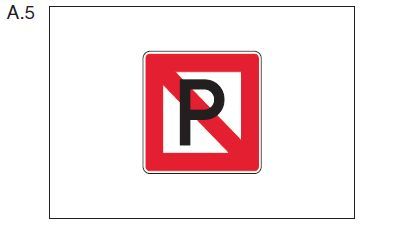 |
-
d)
-
under a bridge or high-voltage line;
-
e)
-
in a waterway within the meaning of § 6.07 and in its vicinity, as well as on a distance which would become a waterway through the standstill, and in the vicinity of such a distance;
-
f)
-
on a driveway in and an exit from a port or a side waterway;
-
g)
-
in the journey line of a ferry;
-
h)
-
in the course that a vehicle can use when it is applied to a landing bridge or when it is driven off;
-
i)
-
at a turning point, marked by the table sign E.8 (Appendix 7)
;
|
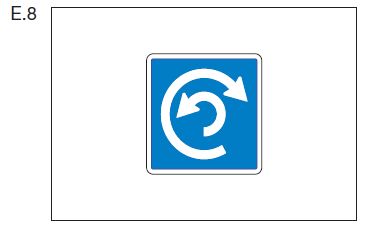 |
-
j)
-
on the side of a vehicle, which is the table sign according to § 3.33
, within the distance, which is on the triangular white
the additional sign in metres is indicated;
|
62 |
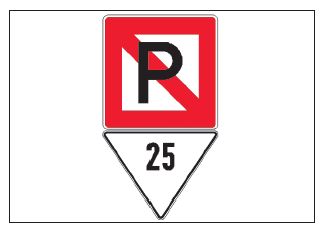 |
-
k)
-
on a table marked by Table A.5.1 (Appendix 7),
Water surface, the width of which is on the table sign in metres
is indicated; the width is measured by the site of the
table signs;
|
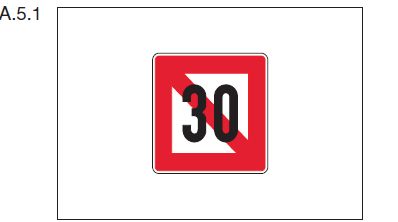 |
-
l)
-
on the water surfaces marked by the E.17, E.22 or E.24 (Appendix 7) table symbol.
-
2.
-
On the sections of a waterway where the decommissioning referred to in point 1 (a) to (d) is prohibited, a vehicle, a floating body or a floating facility shall be suspended only on the reclining sites, which shall be replaced by one of the table marks E.5. to E.7 (Appendix 7). § § 7.03, 7.04, 7.05 and 7.06 are to be observed.
-
3.
-
At a reclining location marked by one of the table symbols E.5 to E.7 (Appendix 7), the stopping of a vehicle or a float is only up to that for the respective vehicle or float after the second one. Part of this Regulation shall be permitted on the relevant route, if not the table marks E.5.1, E.5.2 or E.5.3 or additional panels to the panels E.6 or E.7 allow otherwise.
Unofficial table of contents
§ 7.03 Ankers and use of piles
-
1.
-
A vehicle, a floating body or a floating installation shall not be allowed to anchor:
-
a)
-
on a shipping channel, in a lock-in canal or on the section of a waterway for which there is a general ban on anchorage;
-
b)
-
marked on an A.6 (Appendix 7) by the Table Sign
Route, on the side of the waterway, on which the table sign
; the anchor ban shall be from 50.00 m above the maximum of 50,00 m
below the table sign.
|
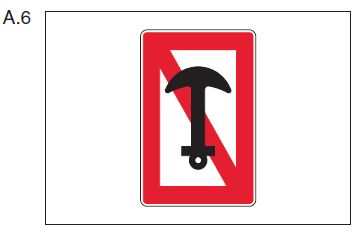 |
On the routes referred to in the first sentence, it shall be prohibited to press a pole in or on the ground. By way of derogation from the second sentence, the competent authority for construction site vehicles may allow the use of a pfahles for the carrying out of construction work.
-
2.
-
On a section on which the anchor referred to in point 1 book-
A vehicle, a swimming body or a vehicle shall be prohibited
floating plant only on a stretch that is caused by the
Table sign E.6 (Appendix 7) is marked, and only on the page
the waterway on which the table sign stands.
|
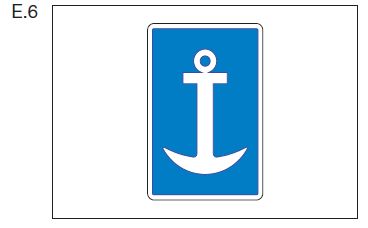 |
Unofficial table of contents
§ 7.04 Fixed
-
1.
-
A vehicle, a floating body or a floating facility shall not be fixed on the shore:
-
a)
-
on a shipping channel, in a lock canal or on the section of a waterway for which there is a general fixed-order ban;
-
b)
-
marked on an A.7 (Appendix 7) by the Table Sign
Route on the side of the waterway on which the table sign stands.
|
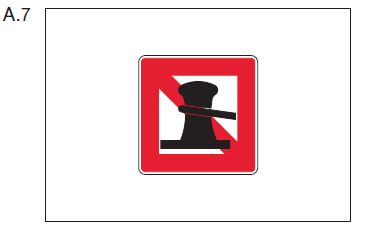
|
-
2.
-
On a section on which the celebration referred to in point 1
Point (a) shall be prohibited, may be a vehicle, a float
or a floating plant, only on a single track,
which are defined by one of the table marks E.7 or E.7.1 (Appendix 7),
is, and only on the side of the waterway, where the
Table characters.
|
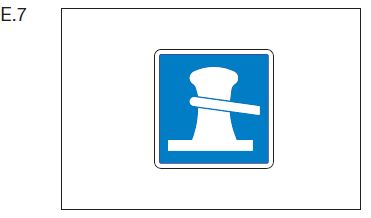
|
| |
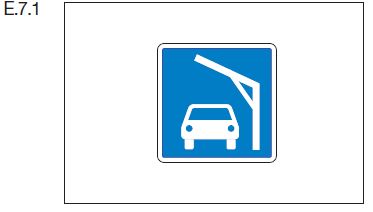
|
-
3.
-
A tree, a railing, a pole, a boundary stone, a column, an iron ladder, a handrail or similar objects may not be used for the celebration or for the time to be collected.
Unofficial table of contents
§ 7.05 Lounging points
| 1. |
At a berth at which the table sign E.5 (Appendix 7) is applied,
, a vehicle, or a floating body, may only be on the side of the vehicle.
The waterway is at a standstill, on which the table sign stands. |
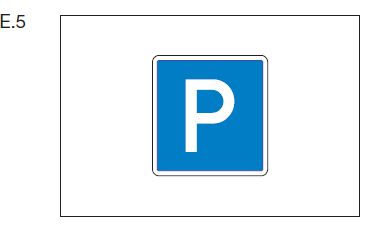 |
| 2. |
At a berth at which the table sign E.5.1 (Appendix 7) is applied,
, a vehicle, or a floating body, may only be placed on a
Water surface, the width of which is on the table sign in Me-
It shall be indicated. The width is measured by the site of the
Table signs. |
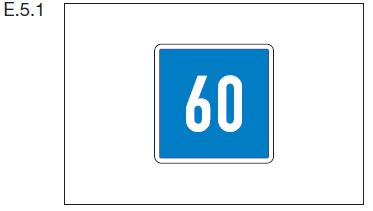 |
| 3. |
At a berth at which the table sign E.5.2 (Appendix 7) is applied,
, a vehicle or a floating body may be used only on the
The water surface between the two distances, which shall be
the table character in metres. Both distances
shall be determined by the place of installation of the plate. |
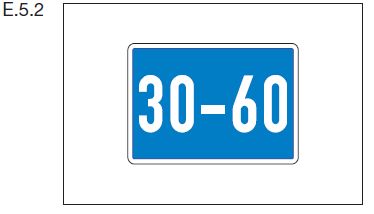 |
| 4. |
At a berth at which the table sign E.5.3 (Appendix 7) is applied,
is placed on the side of the waterway, on which the
Table sign stands, no longer vehicles and floating bodies
are still lying next to each other, than on the table sign in Roman
Numbers specified. |
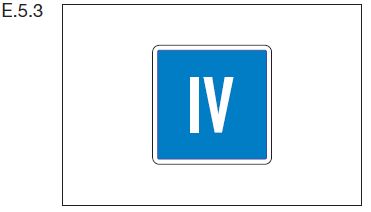 |
Unofficial table of contents
§ 7.06 Special berths
-
1.
-
At a reclining location where one of the table marks E.5.4 to E.5.15 (Appendix 7) is situated, only the type of vehicle for which the table sign is valid shall be allowed to lie down.
-
2.
-
If a vehicle which is to be designated in accordance with section 3.14 (1) to (3) is not provided with a special berth, and if it wishes to use a berth at which the table symbol E.5, E.5.4, E.5.8, E.5.12, E.6 or E.7 (Appendix 7) is situated, it shall be only if a special berth is allocated to it by the competent authority.
-
3.
-
Unless otherwise specified, a berth is situated on the side of the waterway on which the sign is standing, from the shore, and a vehicle next to the other.
Unofficial table of contents
Section 7.07 Minimum distances for the transport of certain dangerous goods during the standstill
-
1.
-
For a vehicle, a thrust assembly or a vehicle to be coupled, a vehicle, a thrust assembly or coupled vehicles must comply with the following minimum distances when the vehicle is still on the road:
-
a)
-
10,00 m, if one or one of them leads the name in accordance with Section 3.14 (1);
-
b)
-
50.00 m if one or one of them leads the name in accordance with Section 3.14 (2);
-
c)
-
100.00 m if one or one of them leads the name according to § 3.14 point 3.
-
2.
-
The obligation referred to in point 1 (a) shall not apply:
-
a)
-
in the case of a vehicle, a thrust assembly or coupled vehicles which have the same name;
-
b)
-
in the case of a vehicle which does not carry this name but which, according to ADN section 8.1.8, has a certificate of approval and complies with the safety provisions applicable to a vehicle in accordance with Section 3.14 (1).
-
3.
-
In special cases, the competent authority may grant derogations.
Unofficial table of contents
Section 7.08 Wache and supervision
-
1.
-
On board a stationary vehicle loaded with dangerous goods in accordance with Chapter 3.2, Table A ADN, which is a name in accordance with § 3.14 or which, after unloading such goods, is not yet free from dangerous gases, it shall be permanently a guard that can be used. However, the competent authority may exempt a vehicle which is in a port basin from that obligation.
-
2.
-
All other vehicles, floats and floating installations must be supervised by a person who is in a position to intervene quickly if necessary. Sentence 1 shall not apply if the supervision is not necessary due to local circumstances or if the competent authority permits an exception.
Unofficial table of contents
§ 7.09 Behaviour duties
-
1.
-
The skipper has the first sentence in § § 7.01, 7.02 number 1, also in conjunction with number 2, and number 3, § 7.03 number 1 sentence 1, also in conjunction with number 2, § 7.04 number 1, also in conjunction with number 2, and number 3, § § 7.05, 7.06 and 7.07 number 1 or to comply with any of the provisions or prohibitions on the conduct of breastfeeding, anchorage or detention, or to ensure that they are complied with, provided or under these rules.
-
2.
-
The skipper, the owner and the supplier shall, in each case, comply with the requirements laid down in Article 7.08 (1), first sentence and point (2), on the basis of these regulations, on the conduct of the standstill, or to ensure that: to be complied with.
Chapter 8
Additional provisions
Unofficial table of contents
§ 8.01 Maximum measurements of vehicles
The permitted maximum dimensions of a vehicle on the respective waterway shall be determined in accordance with Chapters 10 to 27.
Unofficial table of contents
§ 8.02 Gender and sluggishing drawers
-
1.
-
A wheelset must not be dragged. In so far as exceptional, in particular local conditions, it is necessary and the shipping is not impeded by this, a thrust body may be dragged.
-
2.
-
A thrust bandage must not be dragged. This shall not apply if its length and its width on the respective waterway do not exceed the maximum dimensions referred to in Chapters 10 to 27 for vehicles, and a corresponding endorsement is provided in the travel certificate of the The vehicle is registered. A drawer with one or more vehicles in the appendix forms a towing association in accordance with section 1.01, point 4. In this case, the thrust assembly is considered to be a vehicle with a machine drive at the tip of a tow belt.
Unofficial table of contents
§ 8.03 Drawers ' associations that carry other vehicles as a shoe
A thrust body shall only be allowed to carry other vehicles in the form of a school lead if this is permitted in the travel certificate of the sliding vehicle and of the pushed vehicle.
Unofficial table of contents
§ 8.04 Drawers ' Associations, which carry carrier ship more easily
-
1.
-
A thrust dressing may only carry a carrier ship more easily at its tip, if:
-
a)
-
it is a carrier ship lighter with a headpiece,
-
b)
-
the carrier ship lighter has a trained front vessel, or
-
c)
-
the carrier ship is more easily coupled in addition to a thrust guide and has a distance of at least 1.00 m between its greatest sinking and the lowest point, which can no longer be considered watertight.
-
2.
-
The head of the pusher body referred to in paragraph 1 shall be fitted with anchors in accordance with the inland waterway search order, except in the case of a shipping channel.
-
3.
-
The competent authority may authorise, on short distances, a wheelset with a maximum length of up to 86.00 m and a maximum of two carrier ship lighters, with a length of up to 86.00 m.
Unofficial table of contents
§ 8.05 Continuing movement of sabers outside of a drawers ' association
Outside of a wheelset, a shoe abatter may only be moved:
-
1.
-
coupled or towed on the longitudinal side, provided that an appropriate note is entered in the driver's certificate of carriage of passengers and of the moving vehicle;
-
2.
-
on short distances during the assembly or reconstitution of a drawers ' association, in compliance with the rules adopted by the competent authority or with their permission.
Unofficial table of contents
§ 8.06 couplings of the drawers
-
1.
-
The clutches of a pusher band must ensure the rigid connection of all vehicles.
-
2.
-
The connections by means of the couplings must be manufactured quickly and easily and can be released.
-
3.
-
The couplings must be kept uniformly tensioned by suitable devices, preferably special winches.
-
4.
-
In the case of a thrust dressing up to a width of 12,00 m, which consists of a sliding and a pushed vehicle, a coupling system is also considered to be a rigid connection between the two vehicles, which enables a controlled kinking of the dressing, provided that in the A certificate of driving licence for these vehicles shall be entered in the relevant notice. Kinked connections may only be made by means of the equipment specified in the travel certificate, and not by means of aids.
Unofficial table of contents
§ 8.07 Consulate connection to associations
-
1.
-
If a shear assembly is longer than 110,00 m, there must be a speech connection between the control level of the sliding vehicle and the tip of the dressing.
-
2.
-
In the case of a thrust combination which is moved next to one another by means of two pushing vehicles, a speech connection in both directions must exist between the control stands of the two vehicles that are sliding.
-
3.
-
In the case of coupled vehicles, there must be a speech connection between the control stands of both vehicles in both directions.
-
4.
-
In the case of a towed dressing, there must be a speech connection between the control stands of all vehicles. Sentence 1 shall not apply to the extent to which a small vehicle is towed.
-
5.
-
The traffic circle ship-ship must not be used as a voice connection.
Unofficial table of contents
§ 8.08 Begeheability of the Drawers ' Associations
A thrust dressing must be easily accessible and safely accessible. Intermediate spaces between the vehicles must be secured by means of appropriate protective devices.
Unofficial table of contents
§ 8.09 Bleib-weg-Signal
-
1.
-
In the event of an incident or an accident which may cause the transported dangerous goods to be released, the lead-away signal shall be triggered on:
-
a)
-
a tanker which is to be named in accordance with section 3.14 (1) or (2)
and
-
b)
-
a vehicle which has to be designated in accordance with section 3.14 (3);
if the crew is not in a position to prevent the dangers arising from the free movement of these goods for persons or shipping. This shall not apply to a thrust guide or any other vehicle without a machine drive. However, if these belong to an association, the lead-away signal must be given by the vehicle on which the leader of the association is located.
-
2.
-
The lead b-way signal consists of a sound and a light sign. The sound character consists of the continuous repetition of a short and a long tone, which is continuous for at least 15 minutes. At the same time as the sound symbol, the light sign must be given in accordance with Section 4.01 (2). After triggering, the lead-off signal must be automatically executed, and the trigger must be such that it cannot be inadvertently actuated.
-
3.
-
A vehicle that perceives the lead-away signal must take all measures to avert the imminent danger. In particular, it must:
-
a)
-
if it perceives the lead-away signal only acoustically and cannot detect where the danger zone is located, then ask for radio voice radio where the vehicle is located, which triggered the signal;
-
b)
-
if it moves towards the danger zone, keep and, if necessary, turn to the danger zone as far as possible from the danger zone;
-
c)
-
if it has already passed on the danger zone, continue as soon as possible.
-
4.
-
The following measures shall be taken immediately on the vehicles referred to in point 3:
-
a)
-
all windows and openings leading to the outside are to be closed;
-
b)
-
all unprotected fire and lights shall be extinguisher;
-
c)
-
Smoking is to be stopped;
-
d)
-
the auxiliary machinery which is not necessary for the operation must be put to an end;
-
e)
-
in general, any sparking is to be avoided.
When the vehicle is held to hold, all engines and auxiliary machinery still in operation are to be stopped or made currentless.
-
5.
-
As soon as a vehicle close to the danger zone perceives the lead-away signal, it must also take the measures referred to in point 4. If it is safely possible, the vehicle is to be left out if necessary.
-
6.
-
The flow and wind direction shall be taken into account in the implementation of the measures referred to in points 3 to 5.
-
7.
-
The measures referred to in points 3 to 5, in each case in conjunction with point 6, shall be taken on a vehicle even if the lead-away signal is triggered on the shore.
-
8.
-
The ship's guide, who perceives the lead-away signal, must, according to the given possibilities, immediately inform the next department of the Federal Water and Shipping Administration or the next service of the water protection police.
Unofficial table of contents
§ 8.10 Bade and swimming ban
-
1.
-
Swimming and swimming is forbidden
-
a)
-
in the range of up to 100,00 m above and below a bridge, a river, a port entrance, a berth or a landing point for the passenger shipping,
-
b)
-
in the smuggling area,
-
c)
-
in the working area of floating devices,
-
d)
-
at a position indicated by Table A.20.
|
A.20 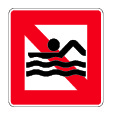 |
-
2.
-
A swimmer and a swimmer must behave in such a way that a vehicle or an association which is in travel is not obstructed.
-
3.
-
Provisions restricting or prohibiting bathing or swimming in rivers and canals other than those referred to in paragraph 1 shall remain unaffected.
-
4.
-
The bathing and swimming ban referred to in point 1 (a) and (b)
and an outspoken one by a rule in accordance with point 3
Bathing or swimming prohibition can be caused by the table sign E.26
(Annex 7).
|
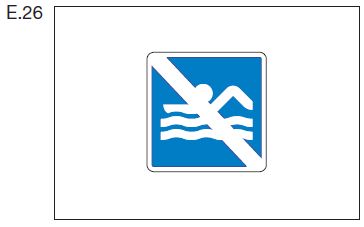 |
Unofficial table of contents
Section 8.11 Designation of fishing gear
-
1.
-
A large fishing gear shall be designated in accordance with Section 3.25 (1), in so far as the lights or sight signs referred to therein may be affixed to the appliance. If this is not the case, the large fishing gear shall be designated in accordance with Section 3.24.
-
2.
-
Another fishing gear shall be designated in accordance with § 3.24 if it is likely to endanger shipping.
-
3.
-
By way of derogation from the second sentence of point 1, a fishing gear, in particular a reuse, may be designated by plug-and-socket rods. If shipping can be jeopardised, the outer push-rods shall be designated by white ordinary lights visible from all sides to the side of the water at night according to § 3.20 (1).
-
4.
-
By way of derogation from the first sentence of paragraph 2, the competent authority may require or permit a different name.
Unofficial table of contents
§ 8.12 Designation in the use of divers
(Annex 3: Figure 64)
A body or a vehicle from which a diver's work is carried out shall, on the day and at night, in addition to the name prescribed by this Regulation, result in:
a white-blue flag
(flag "Alpha" of Inter-
national signal book). |
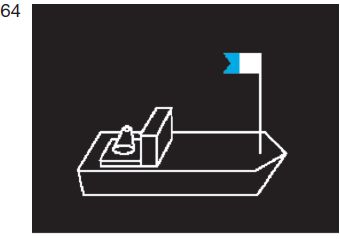 |
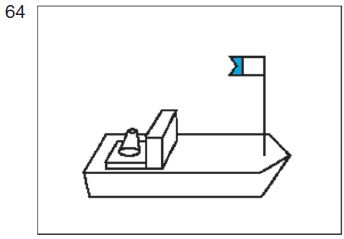 |
This flag must be kept at a suitable location and so high that it is visible from all sides. At night, it's to shine. The flag can be replaced by a blackboard or a ball of the same colour.
Unofficial table of contents
Section 8.13 Prohibition of kitesurfing
-
1.
-
Any activity in which a person, dragon or parachute, slides on a surfboard, on water skis or on other objects over the water (kitesurfing), is forbidden.
-
2.
-
On waterways in the area of water and shipping directorate
East can the water and shipping directorate the kitesurfing
or in part, to the extent that the rest of the shipping industry does not enter into force,
pregnant women. Those in the area of the water and shipping directorate
East routes for kitesurfing are provided by the
The following table signs E.24 are indicated:
|
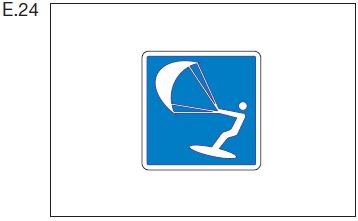 |
Unofficial table of contents
§ 8.14 Behaviour obligations
-
1.
-
The skipper, the person responsible for course and speed in accordance with section 1.03 (3) and the person who is responsible for fishing shall in each case ensure that a large fishing gear of the fishery referred to in Article 8.11 (1) is designated is.
-
2.
-
The skipper and the person responsible pursuant to Section 1.03 (3) for the course and speed shall comply with the bids or bans on the connection to a federation provided for in § 8.07 or arranged pursuant to these regulations. or make sure that they are respected.
-
3.
-
The skipper shall have the bids or bans on the locomotions of an association as provided in § 8.02 (1), first sentence, and (2), first sentence, § 8.03, § 8.04 (1) and (2) (1) and 8.06 (1), also in conjunction with points (4), (2) and (3) or to ensure that they are complied with.
-
4.
-
The ship's guide shall comply with the requirements laid down in § 8.05 on the locomotions of a shoe holder outside a wheeler or to ensure that they are complied with.
-
5.
-
The ship's guide shall have the bids provided for in section 8.09 (1), first sentence, also in conjunction with sentence 3, section 8.09 (2) and (3) to (5), also in conjunction with point 6, and section 8.09 (7) and (8), or ordered pursuant to these regulations. to comply with or to ensure that the lead-away signal is triggered or to ensure that they are complied with.
-
6.
-
The ship's guide shall ensure that the name referred to in § 8.12 is carried out on the vehicle from which the diver's work is carried out.
-
7.
-
The person responsible for fishing shall ensure that a fishing gear is designated in the case referred to in section 8.11 (2) by the name referred to in Article 8.11 (2), also in conjunction with the second sentence of paragraph 3.
-
8.
-
The person responsible for carrying out the diving work shall ensure that the place from which divers work is carried out shall lead to the name in accordance with § 8.12.
-
9.
-
The owner and the supplier may only arrange or permit the movement of an association if the sentence 1 and 2 sentence 1, section 8.03, § 8.04 number 1 and 2 half-sentence 1 and § 8.06 number 1, also in connection with § 8.02 (1), first sentence and Point 4, points 2 and 3, or prohibitions on the conduct of the movement of a federation.
-
10.
-
The owner and the equipment supplier may only arrange or permit the movement of a shoe holder outside of a thrust association if the bids provided for in § 8.05 on the movement of a shoe lead outside of a pusher Shear strip is maintained.
-
11.
-
The owner and the equipment supplier shall only arrange or permit the putting into service of a vehicle in accordance with section 8.09 (1) (1) (a) or (b) if it is equipped to provide the lead-away signal in accordance with section 8.09 (2). .
Chapter 9
Passenger shipping
Unofficial table of contents
§ 9.01 roadmaps
-
1.
-
If you are travelling on a regular basis with a passenger ship (an entreprent), the timetable with departure and arrival times and landing places must be at least four weeks before the start of the travel of the competent authority, from its district to the competent authority. Passenger shipping is operated. The first sentence shall apply to changes in the timetable.
-
2.
-
The operator shall, at the request of the competent authority, modify the timetable so as to avoid traffic disruption.
Unofficial table of contents
§ 9.02 Anlegestellen
The skipper of a passenger ship may, for the purpose of boarding and disembing of passengers, be arrested or arrested only at a point of application approved for this purpose by the competent authority.
Unofficial table of contents
Section 9.03 Ship traffic at the landing sites
The ship's driver of a vehicle other than a passenger ship may, at a point of landing of the passenger ships, be allowed to arrest or have the vehicle arrested only with the permission of the passenger and shall only leave it there, as long as the traffic of the passenger ships is not Passenger ships shall not be obstructed.
Unofficial table of contents
Section 9.04 Passengers boarding and boarding
-
1.
-
The skipper or the crew members designated by him shall not allow entry and exit until the passenger ship has been duly detained and after they have satisfied that the ship's crew has been properly detained.
-
a)
-
the access and departure of the passengers at the landing stage is possible without danger,
-
b)
-
the landing site is in a proper condition,
-
c)
-
the landing stage is sufficiently illuminated in the dark.
-
2.
-
Ascending passengers shall not enter the landing bridge or landing strip until the runway has left the landing bridge or landing strip, unless there is a separate inlet and outlet.
-
3.
-
Passengers may only use the entrants and exits, landing bridges and landing strips, access and stairways to enter and exit. Passengers shall be allowed to enter or exit only as long as the ship's guide or the crew member of the crew expressly grants permission to do so.
Unofficial table of contents
Section 9.05 Rejection of passengers
The skipper or the members of the crew responsible for the ship shall not be able to transport any person who is likely to endanger the operation of the vessel or a serious annoyance of the passengers.
Unofficial table of contents
Section 9.06 Security on board and at the landing sites
-
1.
-
Passengers and the users of a landing site must behave in such a way that they do not endanger the traffic and do not hinder or harass other persons. They must follow the instructions of the ship ' s guide, the members of the crew responsible for the crew, or the supervisor at the landing places.
-
2.
-
The ship's guide shall ensure that passengers are properly distributed in the interests of safety on the vehicle and that access to the places of entry is not hindered.
-
3.
-
In the case of darkness, the rooms intended for passengers must be sufficiently illuminated.
Unofficial table of contents
Section 9.07 Safety on board of vehicles registered for the carriage and overnight accommodation of more than 12 passengers
The following additional requirements shall apply to a vehicle registered for the carriage and overnight accommodation of more than 12 passengers:
-
1.
-
On board there must be a safety role containing the duties of crew and on-board personnel in the event of an emergency. In addition, there is a need for standards of conduct for passengers in the event of a leak, a fire or the clearance of the vehicle. The safety role referred to in the first sentence must be suspended in several places which are capable of informing the crew and the on-board personnel at any time of their content. The standards of conduct referred to in the second sentence shall be suspended in a number of places which are suitable for passengers to be able to inform themselves at any time of their content.
-
2.
-
The crew and the on-board personnel shall be aware of the security role referred to in the first sentence of paragraph 1 and shall be regularly instructed by the ship's guide in their duties.
-
3.
-
During the stay of passengers on board, the escape routes must be completely free of obstacles. The doors and emergency exits of the escape routes must be easy to open from both sides.
-
4.
-
If any journey takes longer than one day, safety instructions shall be issued to the passengers.
-
5.
-
As long as passengers are on board, a control passage by a member of the crew must be carried out every hour at night. The implementation must be demonstrated in a suitable manner.
-
6.
-
The ship's guide shall ensure that the rules on passenger safety in accordance with points 1 to 5 are complied with.
-
7.
-
The owner and the equipment supplier may only order or permit the putting into service of a vehicle only if the crew and the staff have been regularly instructed in their duties following the safety role referred to in point 1.
Unofficial table of contents
§ 9.08 Passenger breeds
§ § 9.01, 9.02, 9.04, 9.05 and 9.06 are to be applied to a passenger cash register accordingly.
Part two
Additional provisions for single inland waterways
Chapter 10
Neckar
Unofficial table of contents
Section 10.01 Scope
The provisions of this chapter apply on the Neckar (Ne) from the estuary in the Rhine (Rh) at Rh-km 428,16 to the municipal border of Wernau-Plochingen (Ne-km 203.01).
Unofficial table of contents
§ 10.02 Dimensions of vehicles and federations, driverine depth
-
1.
-
A vehicle or an association shall not exceed the following dimensions:
| Inland waterway |
Length |
Width |
| |
M |
M |
| 1.1 |
km 0,00 (Neckarmündung) to km 201,49 (port of Plochingen) |
|
|
| |
Vehicle/Association |
90.00 |
11.45 |
| |
unless otherwise specified in the following text |
|
|
| |
|
|
|
| 1.2 |
km 0,00 (Neckarmündung) to km 3,00 (Mannheim-Neckarstadt) |
|
|
| |
a) Vehicle |
135.00 |
22.80 |
| |
b) Association |
186.50 |
22.90 |
| |
|
|
|
| 1.3 |
km 3,00 to km 4,60 |
|
|
| |
Vehicle/Association |
105.50 |
11.45 |
| |
|
|
|
| 1.4 |
km 4,60 to 201,49 (port of Plochingen) |
|
|
| |
Vehicle/Association |
105.50 |
11.45 |
| |
|
|
|
| |
-a vehicle or a bandage of more than 90,00 m in length may only be used if it or it is equipped with an active bow control device, a two-screw drive or a main drive acting in all directions from 0 ° to 360 °, and a The connection between the control stand and the tip of the vehicle or the bandage is provided. |
-
2.
-
The association referred to in point 1 shall be subject to only one thrust assembly and coupled vehicles.
-
3.
-
The driverine depth
-
a)
-
is from the Neckarm mouth to the Schleusengruppe Feudenheim of the driverine depth of the adjacent Rhine stretch,
| b) |
is from the Schleusengruppe Feudenheim to the end of the port of Plochingen (km 201,49) |
2.80 m. |
The restrictions applicable to the locks due to the existing corner stiffenings (voutes) shall be notified by the competent authority.
Unofficial table of contents
§ 10.03 compilation of the associations
Only as many vehicles may be set in a towed dressing, that it does not require more than one lock. In the descent, an empty lighter must be coupled without active bow control "Heck zu Tal".
Unofficial table of contents
§ 10.04 Driving speed
-
1.
-
The maximum permissible speed on the shore is above km 4.60
| a) |
for a vehicle or an association, excluding passenger ships or small vehicles, |
16 km/h, |
| b) |
for a passenger ship or a small vehicle |
18 km/h. |
-
2.
-
By way of derogation from point 1, the maximum permitted speed shall be set against the shore in a sluice duct
| a) |
for a vehicle or an association, excluding passenger ships or small vehicles, |
12 km/h, |
| b) |
for a passenger ship or a small vehicle |
14 km/h. |
-
3.
-
By way of derogation from point 1 (b) and point 2 (b) for a small vehicle, the competent authority may allow higher speeds for individual routes or on a specific occasion, provided that the condition and use of the The waterway and the rest of the shipping traffic are not subject to a fee.
Unofficial table of contents
§ 10.05 Mountain ride
(no special provisions)
Unofficial table of contents
§ 10.06 Encounter
-
1.
-
In the Staustance Hofen (km 176.20 to km 182.70)
-
a)
-
a mountain driver must set up his journey in such a way that he does not meet a driver when passing through the waterway at the Aubrücke (km 178,42). If an encounter cannot be avoided, it must stop below the waterways until the cyclist has passed through it;
-
b)
-
A mountain driver above the Hofen level (at km 176.80) and then several times up to the waterway must call up the cyclists and ask him to inform him of the type, name, location and direction of travel of the vehicle. If a driver does not register, he may enter the waterways;
-
c)
-
A driver must say to the port of construction (km 180,20) and then several times to the route of the running water, name, location and direction of travel of his vehicle. He has to say the same if he is approached by a mountain driver.
-
By way of derogation from point (a) of the first sentence, a small vehicle shall pass through the bridge on the right bank outside the transit opening indicated by the table signs in accordance with section 6.24 (2) (a).
-
2.
-
In the side channel Pleidelsheim (km 150,50 to km 153,25)
-
a)
-
a mountain driver must set up his journey in such a way that he does not meet a valley driver when travelling through the waterways between km 150.50 to km 153.25 (Pleidelsheim side channel). If an encounter cannot be avoided, it must stop below the waterways until the cyclist has passed through it;
-
b)
-
A mountain driver above the Schleuse Pleidelsheim (at km 150,50) and at the avoidance point (km 151.90) must call the cyclists several times to the waterways and ask him to inform him of the type, name, location and direction of travel of the vehicle. If a driver does not register, he may enter the waterways;
-
c)
-
A cyclist must say, at km 154,50 and thereafter as well as in the side channel, several times up to the respective traffic watertight type, name, location and direction of travel of his vehicle. He has to say the same if he is approached by a mountain driver.
-
3.
-
In the perennial Hessigheim (km 143,10 to km 150,00)
-
a)
-
a mountain driver must set up his journey in such a way that he does not meet a valley driver when driving through the waterways between km 146.60 to km 148.00 (Steinbruch Kleiningersheim). If an encounter cannot be avoided, it must stop below the waterways until the cyclist has passed through it;
-
b)
-
A mountain driver above the Hessigheim lock (at km 146.00) must call the cyclists several times to the waterway, and ask him to inform him of the type, name, location and direction of travel of the vehicle. If a driver does not register, he may enter the waterways;
-
c)
-
A cyclist must say the name, location and direction of travel of his vehicle at km 148,50 and then several times until the time of the journey. He has to say the same if he is approached by a mountain driver.
-
4.
-
In the side channel Kochendorf (km 105,40 to km 106,30)
-
a)
-
A mountain driver must set up his journey in such a way that he does not meet a valley driver when driving through the waterways between km 105.40 to km 106.30 (side channel Kochendorf). If an encounter cannot be avoided, it must stop below the waterways until the cyclist has passed through it;
-
b)
-
a mountain driver above the Kochendorf lock (at km 104,00) has to call the cyclists several times to the waterway and ask him to inform him of the type, name, location and direction of travel of the vehicle. If a driver does not register, he may enter the waterways;
-
c)
-
A driver at km 108,00 and then, as well as in the side channel itself, has to say several times to the driving watertight type, name, location and direction of travel of his vehicle. He has to say the same if he is approached by a mountain driver.
-
5.
-
In all areas referred to in points 1 to 4, in order to ensure a safe radio traffic, the mountain and valley driver shall be able to place the antennas of its radio equipment at right angles and to extend it as high as possible.
Unofficial table of contents
§ 10.07 Overhaul
(no special provisions)
Unofficial table of contents
§ 10.08 Contact
(no special provisions)
Unofficial table of contents
§ 10.09 Ankers
(no special provisions)
Unofficial table of contents
§ 10.10 Standstill
-
1.
-
No more than two vehicles shall be allowed to lie close to each other outside the berths designated by the E.5, E.6 or E.7 table symbols (Appendix 7). The first sentence shall also apply to the water surfaces, which are parts of a port or a cover.
-
2.
-
A vehicle is only allowed to stay in the sluice area and stay overnight
-
a)
-
before the smuggling, if it is not carried out because of the end of the sluice operation,
-
b)
-
after the lock, if the next lock to be traverted can no longer be reached before the end of the lock-up period,
-
c)
-
if it is unable to continue its journey in order to comply with the required rest periods or under other conditions,
-
d)
-
with the permission of the control of the smuggling.
-
3.
-
A carrier ship lighter shall not be allowed to remain outside the association only on a place assigned by the competent authority. The provisions of § § 7.01 and 7.08 remain unaffected.
-
4.
-
On the route from the river Neckarm to the underwater of the Schleusengruppe Feudenheim (km 5.80), the breastfeeding is only available at the recumbering points referred to in points (a), (b) and (c) and on the runback of the passenger shipping service under the Prerequisites allowed
-
a)
-
for a vehicle which does not have to be named in accordance with section 3.14;
-
aa)
-
Berth on the left bank
from km 0,83 to km 2,70,
-
bb)
-
Berths on the right bank
from km 0.25 to km 0.45 only for vehicles that want to enter the lock to the industrial port,
from km 0,83 to km 3,00,
in the Schleusenbereich Feudenheim, from km 5.25 to km 5.50 for downhill skiers and from km 5.50 to km 5.80 for mountain drivers, taking into account the number 2,
-
b)
-
in the case of a vehicle which must lead the name in accordance with section 3.14 (1),
-
aa)
-
Berth on the left bank
from km 0,10 to km 0,55,
-
bb)
-
Berth on the right bank
In the Schleusenbereich Feudenheim from km 5,05 to km 5,25,
-
c)
-
in the case of a vehicle which has to be designated in accordance with section 3.14 (2) or (3), a berth shall be assigned by the competent authority on a case-by-case basis.
-
5.
-
A berth may only be occupied by the shore, one vehicle on the other side of the other. Transfer facilities on the shore must be kept free of charge for the traffic of the vehicles loaded or extinguished there.
-
6.
-
The following is valid for the decommissioning in the city of Heidelberg:
-
a)
-
In the water area on the left bank of about 300.00 m above the Theodor-Heuss-Brücke (km 24, 50) to above the Karl-Theodor-Brücke (km 25, 48) between the driving channel and the left bank, only a passenger ship or a small vehicle can drive in The same applies to the water surface on the right bank from below the Theodor-Heuss-Brücke (km 24,00) to km 24,60 between the driving trough and the right bank;
-
b)
-
The city of Heidelberg is granted permission to stop it;
-
c)
-
in the case of a special event within the meaning of section 1.23, the competent authority may order that the water area referred to in point (a), or parts thereof, of vehicles not participating in the events, shall be held for the duration of the event will be cleared.
Unofficial table of contents
§ 10.11 Shipping at high tide
-
1.
-
Between the river Neckarm and the Schleusengruppe Feudenheim, shipping is prohibited if the water level of the Rhine at the level of Mannheim has reached or exceeded 760 cm.
-
2.
-
If the water level reaches or exceeds the flood mark applied in the water of a sluice, the operation of this lock shall be stopped and the shipping shall be kept in the storage holding referred to in point 4, with the exception of the translation traffic forbidden.
-
3.
-
The competent authority may, by way of derogation from paragraphs 1 and 2, allow exceptions.
-
4.
-
The flood mark referred to in point 2 shall be determined by the following levels and levels of water for the associated congestions:
| Storage |
as a rule in the underwater
the sluice |
Flood mark |
| Ladenburg/Feudenheim-Schwabenheim |
Schwabenheim |
370 cm |
Route: Staustufe Wieblingen/Schwabenheim-
Old bridge Heidelberg |
Schwabenheim |
370 cm |
Route: Alte Brücke Heidelberg-
Heidelberg Dam |
Heidelberg |
260 cm |
| Heidelberg-Neckargemünd |
Neckargemünd |
320 cm |
| Neckargemünd-Neckarsteinach |
Neckarsteinach |
375 cm |
| Neckarsteinach-Hirschhorn |
Hirschhorn |
320 cm |
| Hirschhorn-Rockenau |
Rockenau |
395 cm |
| Rockenau-Guttenbach |
Guttenbach |
350 cm |
| Guttenbach-Neckarzimmer |
Neckarrooms |
420 cm |
| Neckarzimmern-Gundelsheim |
Gundelsheim |
380 cm |
| Gundelsheim-Neckarsulm/Kochendorf |
Kochendorf |
400 cm |
| Neckarsulm/Kochendorf-Heilbronn |
Heilbronn |
260 cm |
| Heilbronn-Horkheim |
Horkheim |
320 cm |
| Horkheim-Lauffen |
Lauffen |
270 cm |
| Run-Besigheim |
Besigheim |
330 cm |
| Besigheim-Hessigheim |
Hessigheim |
330 cm |
| Hessigheim-Pleidelsheim |
Pleidelsheim |
300 cm |
| Pleidelsheim-Marbach |
Marbach |
285 cm |
| Marbach-Poppenweiler |
Poppenweiler |
300 cm |
| Poppenweiler-Aldingen |
Aldingen |
280 cm |
| Aldingen-Hofen |
Hofen |
290 cm |
| Hofen-Cannstatt |
Cannstatt |
260 cm |
| Cannstatt-Untertürkheim |
Untertürkheim |
240 cm |
| Untertürkheim-Obertürkheim |
Obertürkheim |
240 cm |
| Obertürkheim-Esslingen |
Esslingen |
266 cm |
| Route: Wehr Oberesslingen-Deizisau |
Deizisau |
244 cm |
| Route: Staustufe Deizisau |
Deizisau |
244 cm |
| Route: km 201 ,49-km 203,01 |
Plochingen |
180 cm. |
Unofficial table of contents
§ 10.12 Shipping on ice
(no special provisions)
Unofficial table of contents
§ 10.13 Night shipping
(no special provisions)
Unofficial table of contents
§ 10.14 Use of carrier ship lighters
A carrier ship lighter must not be placed at the top of a pusher belt. The competent authority may allow exceptions to this.
Unofficial table of contents
Section 10.15 Reporting obligation
(no special provisions)
Unofficial table of contents
§ 10.16 Height of bridges, other fixed superstructures and overhead lines
(no special provisions)
Unofficial table of contents
§ 10.17 Labelling of the bridges and weir runs
(no special provisions)
Unofficial table of contents
§ 10.18 Diing through the bridges, locking mechanisms,
Wehre, sluices and individual power lines
(no special provisions)
Unofficial table of contents
§ 10.19 Use of the locks, boat locks and boat transfer systems
In the case of a passenger ship and a vehicle intended for the carriage of goods jointly, the passenger ship shall not enter the lock until after the passenger ship has been moved.
Unofficial table of contents
§ 10.20 Sailing
(no special provisions)
Unofficial table of contents
Section 10.21 Designation of vehicles
(no special provisions)
Unofficial table of contents
Section 10.22 Regulations on transport
(no special provisions)
Unofficial table of contents
§ 10.23 Rules on speech radio
(no special provisions)
Unofficial table of contents
Section 10.24 Special provisions for small vehicles
(no special provisions)
Unofficial table of contents
§ 10.25 Beating of waste water, canals and individual waterways
(no special provisions)
Unofficial table of contents
Section 10.26 Protection of the channels and installations
(no special provisions)
Unofficial table of contents
Section 10.27 Transport restrictions on shipping
The navigation of the inland waterway above km 201.49 is prohibited. Sentence 1 shall not apply to a small vehicle.
Unofficial table of contents
Section 10.28 Use of waterways
(no special provisions)
Unofficial table of contents
§ 10.29 Behavioural duties of the ship's guide,
the crew on board, the owner and the exporter
-
1.
-
The skipper and the person responsible for the course and speed according to § 1.03 (3) shall each have
-
a)
-
ensure that the vehicle or the association does not exceed the maximum authorised speed in accordance with section 10.04 (1) and (2), also in conjunction with point 3, and
-
b)
-
the rules on
-
aa)
-
The behavior of the encounter according to § 10.06,
-
bb)
-
Shipping in flood waters according to § 10.11 (1) and (2) and (2)
-
cc)
-
the behaviour in the use of the locks according to § 10.19
-
or to ensure that they are complied with.
-
2.
-
The ship's guide has
-
a)
-
to ensure that
-
aa)
-
the vehicle it is running or the association it is guided does not exceed the maximum authorised dimensions in accordance with section 10.02 (1); and
-
bb)
-
in the case of the vehicle or association which it has carried out, in the case referred to in section 10.02 (1.4), the equipment specified therein,
-
b)
-
the rules on
-
aa)
-
the compilation of the associations according to § 10.03,
-
bb)
-
decommissioning in accordance with section 10.10 (1) to (3) sentence 1, points 4, 5 and 6 (a) and
-
cc)
-
the use of a carrier ship lighter in accordance with § 10.14 sentence 1
-
, or to ensure that they are complied with, and
-
c)
-
comply with the prohibition laid down in the first sentence of Article 10.27 of the Regulation on the inland waterway transport route specified therein, or to ensure that it is complied with.
-
3.
-
The owner and the equipment supplier may only order or permit the putting into service of a vehicle or association if:
-
a)
-
the vehicle or the association does not exceed the permitted maximum dimensions in accordance with section 10.02, point 1, and
-
b)
-
on the vehicle or association, in the case referred to in section 10.02 (1.4), the equipment specified therein.
Chapter 11
Main
Unofficial table of contents
Section 11.01 Scope
The provisions of this chapter apply to the river Main (Ma) from the mouth of the Rhine (Rh-km 496.63) to above the railway bridge near Hallstadt (Ma-km 387,69).
Unofficial table of contents
§ 11.02 Dimensions of vehicles and associations, depth of travel and width
-
1.
-
A vehicle or an association shall not exceed the following dimensions:
| Inland waterway |
Length |
Width |
| M |
M |
| 1.1 |
km 0,00 (Main estuary) to km 387,40 |
|
|
| |
(below railway bridge near Hallstadt) |
|
|
| |
Vehicle/Association |
67.00 |
8.20 |
| |
unless otherwise specified in the following text |
|
|
| |
|
|
|
| 1.2 |
km 0,00 to km 37,20 (Osthafen Frankfurt) |
|
|
| |
a) Vehicle |
135.00 |
14,00 |
| |
b) Association |
190.00 |
14,00 |
| |
|
|
|
| 1.3 |
km 37,20 to km 52,00 (Unterwasser Schleuse Mühlheim) |
|
|
| |
a) Vehicle |
135.00 |
12.20 |
| |
b) Association |
190.00 |
12.20 |
| |
|
|
|
| 1.4 |
km 52,00 to km 84,00 (port Aschaffenburg) |
|
|
| |
a) Vehicle |
135.00 |
11.45 |
| |
b) Association |
190.00 |
11.45 |
| 1.5 |
km 84,00 to km 174,20 (Unterwasser Schleuse Lengfurt) |
|
|
| |
Vehicle/Association |
90.00 |
11.45 |
| |
-the permissible length may be increased in the case of a vehicle up to 110,00 m and in the case of a dressing up to 190,00 m if the vehicle and the association are equipped with an active bow control device-in the case of an association at the head of the association-and one The connection between the control stand and the tip of the vehicle or the bandage is equipped with a telephone connection. |
| |
|
|
|
| 1.6 |
km 174.20 to km 384.07 (diversion Main-Donau-Kanal) |
|
|
| |
Vehicle/Association |
90.00 |
11.45 |
| |
-the permissible length may be increased to a maximum of 110.00 m if the vehicle and the association are equipped with an active bow control unit-in the case of an association at the top of the association-and a voice connection between the control stand and the tip of the The vehicle or the association is equipped. |
-
2.
-
The association referred to in point 1 shall be subject to only one thrust assembly and coupled vehicles.
-
3.
-
The driverine depth
-
a)
-
is from the main opening up to the lock group Kostheim of the driverine depth of the adjacent Rhine section,
-
b)
-
is
-
aa)
-
from the Schleusengruppe Kostheim to the Schleuse Lengfurt at least 2,90 m,
-
bb)
-
from the sluice Lengfurt to the junction of the Main-Donau-Canal 2.50 m.
-
4.
-
The channel width is
| a) |
from the Main estuary to the port of Aschaffenburg |
50,00 m, |
| b) |
from the port of Aschaffenburg to the Schleuse Lengfurt |
40,00 m, |
| c) |
from the sluice Lengfurt to the junction of the Main-Donau-Canal |
36.00 m. |
Unofficial table of contents
§ 11.03 compilation of the associations
-
1.
-
Driving with a trawl is prohibited. The first sentence shall not apply to the towing of small vehicles.
-
2.
-
The competent authority may grant derogations from the first sentence of paragraph 1.
Unofficial table of contents
§ 11.04 Driving speed
The maximum permitted speed on the shore is
| 1. |
in the Schleusenkanal Gerlachshausen |
7 km/h, |
| 2. |
On the route from the junction of the Main-Danube Canal to above the railway bridge near Hallstadt |
15 km/h, |
| 3. |
in the Wehrarm Volkach (Mainschleife) |
10 km/h. |
Unofficial table of contents
§ 11.05 Mountain ride
(no special provisions)
Unofficial table of contents
§ 11.06 Encounter
-
1.
-
By way of derogation from § § 6.04 and 6.05 on the route from the Main estuary to the port of Aschaffenburg Backbord, vehicles and federations must pass by the port on the backboard. This does not apply in the lock areas according to § 6.28 (1). The regulations of § 6.07 on the encounter in the confined waters remain unaffected.
-
2.
-
By way of derogation from point 1, it is possible, for important reasons, to require the pre-accession tax board to be set at starboard, if this is possible without danger. In this case, without prejudice to Section 6.04 (3), the prior mutual understanding shall be effected by means of radio communication.
-
3.
-
The ship's guide shall be entitled to the routes or points in the official shipping messages for the Rhine river basin, which may represent waterways within the meaning of § 6.07, depending on the length of the ship, the draught and the water level, consideration.
Unofficial table of contents
§ 11.07 Overhaul
(no special provisions)
Unofficial table of contents
§ 11.08 Contact
(no special provisions)
Unofficial table of contents
§ 11.09 Ankers
(no special provisions)
Unofficial table of contents
§ 11.10 Standstill
-
1.
-
In the case of a small vehicle, the competent authority may, in the case of certain local areas, allow the decommissioning of the vehicle without the name of the night referred to in Section 3.20 (
-
2.
-
The competent authority may, by way of derogation from Section 7.02 (1) (l), allow derogations from the prohibition on coupings.
Unofficial table of contents
§ 11.11 Shipping at high tide
-
1.
-
The water level shall reach or exceed the flood mark I at the guide level for the section of the route referred to in point 4,
-
a)
-
a vehicle or an association must remain as far from the shore as possible,
-
b)
-
the transport of a floating facility or float shall not be carried out,
-
c)
-
the speed of a valley driver must not be greater than is necessary for safe control,
-
d)
-
a federation with a length of more than 110,00 m above the port of Aschaffenburg must not drive.
-
2.
-
If the water level reaches or exceeds the maximum waterlevel (HSW)-Hochwassermarke II-at the level of the reference level for the section of the route listed in point 4, the navigation shall be within the limits of the transport of the vessel, except for the transport of goods. of the respective section of the route.
-
3.
-
The competent authority may, by way of derogation from points 1 and 2, allow exceptions.
-
4.
-
The flood marks referred to in points 1 and 2 shall be determined by the following water levels, and the reference levels shall apply to the following section:
| Route |
Direction Level |
Flood mark |
| |
I |
II |
| Mainmündung-Schleusengruppe Griesheim |
Raunheim |
300 cm |
400 cm |
| Schleusengruppe Griesheim-Hafen Aschaffenburg |
Frankfurt-Osthafen |
300 cm |
370 cm |
| Harbour Aschaffenburg-Schleuse Klingenberg |
Obernau |
300 cm |
380 cm |
| Schleuse Klingenberg-Schleuse Eichel |
Kleinheubach |
300 cm |
370 cm |
| Schleuse Eichel-Schleuse Harrbach |
Steinbach |
300 cm |
370 cm |
| Schleuse Harrbach-Schleuse Marktbreit |
Würzburg |
270 cm |
340 cm |
| Schleuse Marktbreit-Schleuse Knetzgau |
Schweinfurt-New port |
300 cm |
370 cm |
Schleuse Knetzgau-above
Railway bridge near Hallstadt (km 387,69) |
Truncity |
280 cm |
340 cm. |
Unofficial table of contents
§ 11.12 Navigation on ice
If, as a result of increasing ice formation, the cessation of navigation is threatened, a vehicle or an association must, in good time, visit a port of protection or a suitable berth in accordance with the instructions of the competent authority.
Unofficial table of contents
§ 11.13 Night shipping
(no special provisions)
Unofficial table of contents
§ 11.14 Use of carrier ship lighters
(no special provisions)
Unofficial table of contents
Section 11.15 Reporting obligation
-
1.
-
The skipper of a vehicle or association which is subject to the ADN and the skipper of a tanker, a cabin vessel, a seagoing vessel, an association with a length of more than 140,00 m or a special transport in accordance with § 1.21 Before entry into the mainstream from Hanau (km 57.00) to the mouth of the Rhine, the channel of the Transport Circle, known in the manual inland waterway radio (Section 1.10 (1) (l)), must be provided with Nautical Information at the radio station Report "Oberwesel Revierzentrale" and provide the following information:
-
a)
-
Ship's genus;
-
b)
-
Ship ' s name;
-
c)
-
Location, direction of travel;
-
d)
-
Uniform European ship number or official vessel number, in the case of sea-ships IMO-ship identification number and distinguishing signal;
-
e)
-
Carrying capacity;
-
f)
-
the length and width of the vehicle;
-
g)
-
the type, length and breadth of the association;
-
h)
-
driving route;
-
i)
-
Beladehafen;
-
j)
-
Unloading port;
-
k)
-
for dangerous goods by ADN:
-
aa)
-
the UN number or substance number,
-
bb)
-
the official designation for the carriage, if applicable supplemented by the technical name,
-
cc)
-
the class, classification code and, where appropriate, the packaging group;
-
dd)
-
the total quantity of dangerous goods for which this information applies;
-
k1)
-
in the case of other goods as dangerous goods: the type of cargo (substance name, quantity of substance);
-
l)
-
Number of blue lights/blue cones guided;
-
m)
-
Number of persons on board.
In response to a special request from the "Oberwesel Revierzentrale" radio station, the ship's guide has to provide information on the draught of the vehicle, the association or the special transport that it is carrying according to § 1.21. The limitation of the route to be notified shall be indicated by Table Signs B.11 (Appendix 7) with an additional sign "Reporting obligation".
-
2.
-
The information referred to in the first sentence of the first subparagraph, except for points (c) and (m), may also be provided by another entity or person in good time before the entry of the vehicle, the association or the special transport in accordance with § 1.21 into the notifiable route in writing, by telephone or by electronic means of the radio station "Oberwesel Revierzentrale" (Oberwesel Revierzentrale). For a transport with a load of more than two dangerous goods, the notification must be made in writing or electronically. In any case, the ship's operator must report to the radio station "Revierzentrale Oberwesel" if he enters the notifiable route with the vehicle, association or special transport he is carrying in accordance with § 1.21 and leaves it again.
-
3.
-
If a vehicle, association or special transport according to § 1.21 interrupts the journey within the notifiable route for more than two hours, the ship's guide must notify the radio station "Oberwesel Revierzentrale" in the beginning and end of the interruption.
-
4.
-
If the particulars referred to in point 1 change during the journey in the notifiable route, the ship's operator must inform the radio station "Oberwesel Revierzentrale" immediately.
-
5.
-
A vehicle, an association or a special transport according to § 1.21, which has already issued a notification pursuant to § 12.01 (1) of the Rhine Navigation Ordinance on the Rhine and enters the mainstream at km 0.00, must be provided by the radio station "Oberwesel Revierzentrale" ("Oberwesel Revierzentrale") shall only communicate the information referred to in point 1 (1) (a) to (d) when driving past the reporting points marked by Table Signs B.11 (Appendix 7).
Unofficial table of contents
Section 11.16 Height of bridges, other fixed superstructures and overhead lines
(no special provisions)
Unofficial table of contents
§ 11.17 Marking of the bridges and weir runs
(no special provisions)
Unofficial table of contents
§ 11.18 Diing through the bridges, locking mechanisms,
Wehre, sluices and individual power lines
-
1.
-
At the Peace Bridge in Würzburg (km 251,65), a vehicle running to the valley or an association with a valley running to the valley has its intention to use the left bridge opening, to inform Würzburg's lock supervisor beforehand and to wait for the release. If two red lights are shown next to each other at the signal light system for mountain riders on the Peace Bridge, the mountain ride is blocked. A mountain driver must stop at the right edge of the wheel in front of the table sign B.5 (Appendix 7) standing at km 251.45 and wait for the release of the journey by extinguisher of the two red lights. This does not apply to a small vehicle that wants to drive through the bridge on the right bank.
-
2.
-
The passage of the railway bridge near Hallstadt (km 387,45) is only permitted for a small vehicle.
Unofficial table of contents
§ 11.19 Use of the locks, boat locks and boat transfer systems
-
1.
-
A small vehicle must not use the boat locks and boat conversion facilities at night.
-
2.
-
A small vehicle shall only be allowed to use the boat locks from Kostheim to below Kleinostheim at a water level of less than 230 cm at the directional level Frankfurt-Osthafen, from Kleinostheim to below Steinbach only at a water level of less than 230 cm at the directional level Steinbach, from Steinbach to Limbach use only at a water level of less than 230 cm at the directional level Trunstadt.
-
3.
-
The following signal lights indicate which sub-chamber for the lock is provided on a lock, which is divided by a central head into a larger chamber and a smaller chamber lying in the direction of the upper current.
-
a)
-
two green lights side by side and two white lights next to each other above the green lights: driveway free for the large sub-chamber lying under the substream;
-
b)
-
two green lights side by side and a white light over the left green light: driveway free for the small sub-chamber lying on top of the road.
If the entire lock chamber is released for the lock, two green lights will be shown next to each other.
Unofficial table of contents
§ 11.20 Sailing
(no special provisions)
Unofficial table of contents
Section 11.21 Designation of vehicles
A free-running ferry with a machine drive which does not carry out any longitudinal travel in the field of translation shall not have to carry the side lights and the tail light in accordance with section 3.16 (3) (b) if it is thus irradiated from board by means of a deep-beam radiator, that the rest of the boat is able to identify the outline of the ferry.
Unofficial table of contents
Section 11.22 Rules on transport
(no special provisions)
Unofficial table of contents
§ 11.23 Regulations for the radio
(no special provisions)
Unofficial table of contents
Section 11.24 Special provisions for small vehicles
(no special provisions)
Unofficial table of contents
§ 11.25 Waste water, canals and individual waterways
(no special provisions)
Unofficial table of contents
§ 11.26 Protection of the channels and installations
(no special provisions)
Unofficial table of contents
Section 11.27 Transport restrictions on shipping
-
1.
-
At a water level at the directional level Würzburg of 200 cm and more the descent from Schleuse Randersacker and on the route between Randersacker and the Ludwigsbrücke (Löwenbrücke) in Würzburg can only be done with permission of the Schleusensupervisor Randersacker will be the case. Sentence 1 shall not apply to a small vehicle.
-
2.
-
The driving of the inland waterway road below km 387.40 to above the railway bridge near Hallstadt (km 387,69) is prohibited. Sentence 1 shall not apply to a small vehicle.
Unofficial table of contents
Section 11.28 Use of waterways
(no special provisions)
Unofficial table of contents
§ 11.29 Conduct duties of the ship's guide,
the crew on board, the owner and the exporter
-
1.
-
The skipper and the person responsible for the course and speed according to § 1.03 (3) shall each have
-
a)
-
ensure that the vehicle or the association does not exceed the maximum authorised speed in accordance with Section 11.04;
-
b)
-
the rules on
-
aa)
-
the behaviour of the counter in accordance with section 11.06 (1), first sentence, and point 2, also in conjunction with point 3,
-
bb)
-
Shipping in the case of floods pursuant to Section 11.11 (1) and (2),
-
cc)
-
the passage or the behaviour when passing through
-
aaa)
-
the Peace Bridge in Würzburg according to § 11.18 (1) sentence 1 to 3 and
-
bbb)
-
the railway bridge near Hallstadt in accordance with § 11.18 (2) and
-
dd)
-
the use of the boat locks and the boat conversion facilities according to § 11.19 (1) and (2)
, or to ensure that they are complied with, and
-
c)
-
a instruction issued in accordance with § 11.12 to visit, in good time, a port of refuge or a suitable berth, or to ensure that it is complied with.
-
2.
-
The ship's guide has
-
a)
-
to ensure that
-
aa)
-
the vehicle it is running or the association it is guided does not exceed the maximum authorised dimensions in accordance with section 11.02, point 1, and
-
bb)
-
on the vehicle or association which he/she is taking in the case referred to in Article 11.02 (1.5) and (1.6), in each case, the equipment specified therein,
-
b)
-
the rules on
-
aa)
-
the compilation of the associations pursuant to section 11.03 (1), first sentence, and
-
bb)
-
the obligation to notify pursuant to § 11.15 (1) sentence 1, 2, 2 sentence 2, 3 and points 3 to 5
, or to ensure that they are complied with,
-
c)
-
to comply with the traffic restriction in accordance with § 11.27 (1) sentence 1, or to ensure that it is complied with, and
-
d)
-
comply with the prohibition laid down in Section 11.27 (2), first sentence, of the inland waterway route indicated therein, or to ensure that it is complied with.
-
3.
-
The owner and the equipment supplier may only order or permit the putting into service of a vehicle or association if:
-
a)
-
the vehicle or the association does not exceed the permitted maximum dimensions in accordance with section 11.02, point 1, and
-
b)
-
on the vehicle or association in the case referred to in section 11.02, points 1.5 and 1.6 respectively, where the equipment specified there is available.
Chapter 12
Main-Danube Canal
Unofficial table of contents
§ 12.01 Scope
The provisions of this Chapter shall apply to the following waterways:
-
1.
-
the Main-Danube-Canal (MDK) from the branch from the Main (Ma-km 384,07) to the entrance to the Danube (Do) at Kelheim (MDK-km 170 ,78/Thu-km 2 411,54) including Regnitz from Main to below the Schleuse Bamberg and from above the Main-Danube-Canal (MDK) Hochwasserlocktores Neuses to below the Schleuse Hausen as well as Altmühl from below the Schleuse Dietfurt to the Danube,
-
2.
-
the Regnitz (Re)
-
a)
-
From the entrance into the Main-Danube Canal (Re-km 6 ,44/MDK-km 6.43) to 170 m above the bridge axis of the Wehres Bamberg (Re-km 7,71),
-
b)
-
from 150 m below the Wehres Neuses (Re-km 21,79) to the junction of the Main-Donau-Kanal (Re-km 22 ,11/MDK-km 22,14),
-
c)
-
from the entrance into the Main-Danube Canal (Re-km 31 ,99/MDK-km 31,99) to 270 m above the bridge axis of the Wehres Hausen (Re-km 32, 62) and
-
3.
-
the Altmühl from 90 m above the bridge axis of Wehres Dietfurt (MDK-km 136.08) to the entrance to the Main-Donau-Kanal (MDK-km 136.67).
Unofficial table of contents
§ 12.02 Dimensions of vehicles and federations, driverine depth and unloading depth
-
1.
-
A vehicle or an association shall not exceed a length of 90,00 m and a width of 11.45 m on the Main-Danube Canal. In the case of a vehicle, the length may be increased to up to 110,00 m and in the case of a dressing up to 190,00 m if the vehicle or the association is equipped with an active bow control device-with an association at the top of the association-and one The connection between the control stand and the tip of the vehicle or the bandage is equipped with a telephone connection.
-
2.
-
The route is from the branch from the Main (km 0,07) to the Schleuse Bamberg 2.70 m.
-
3.
-
The permissible unloading depth is from the Schleuse Bamberg to the entrance to the Danube (km 170.78) 2.70 m.
Unofficial table of contents
§ 12.03 compilation of the associations
-
1.
-
Driving with a trawl is prohibited. The first sentence shall not apply to the towing of small vehicles.
-
2.
-
The competent authority may grant derogations from the first sentence of paragraph 1.
Unofficial table of contents
§ 12.04 Driving speed
-
1.
-
The maximum permitted speed on the shore is
-
a)
-
from the port of Bamberg (km 2,80) to the entrance to the Danube for a vehicle or an association with each
| (aa) a discharge depth of not more than 1.30 m |
13 km/h, |
| (bb) a discharge depth of more than 1.30 m |
11 km/h, |
-
b)
-
notwithstanding point (a), double letter bb on the canal bridges over
-
aa)
-
the Zenn (km 53,70),
-
bb)
-
the Rednitz (km 61,90) and
-
cc)
-
the Schwarzach (km 79,07)
| for a vehicle or an association with a discharge depth of more than 2,20 m |
6 km/h. |
-
2.
-
The competent authority may, by way of derogation from point 1 for a small vehicle, permit higher speeds for individual routes or on a specific occasion, provided that the condition and use of the waterway and the rest of the ship ' s traffic are shall not be affected by a fee.
Unofficial table of contents
§ 12.05 Mountain ride
As a mountain ride, the trip is in the direction of Bachhausen.
Unofficial table of contents
§ 12.06 Encounter
-
1.
-
In the event of encounter, vehicles and associations must pass by the bord of bord by way of § § 6.04 and 6.05 of the backboard. The regulations of § 6.07 on the encounter in the confined waters remain unaffected.
-
2.
-
By way of derogation from point 1, it is possible, for important reasons, to require the pre-accession tax board to be set at starboard, if this is possible without danger. In this case, without prejudice to Section 6.04 (3), the prior mutual understanding shall be effected by means of radio communication.
-
3.
-
The ship's guide shall be entitled to the routes or points in the official shipping messages for the Rhine river basin, which may represent waterways within the meaning of § 6.07, depending on the length of the ship, the draught and the water level, consideration.
Unofficial table of contents
§ 12.07 Overhaul
The overtaking of a vehicle or association is prohibited
-
1.
-
to the routes or points notified by the competent authority in the Official Shipping News for the Rhine river basin,
-
2.
-
on the channel bridges referred to in section 12.04 (1) (b).
By way of derogation from the first sentence, a small vehicle may be overhauled and overtaken.
Unofficial table of contents
§ 12.08 Contact
-
1.
-
A vehicle with a length of more than 20.00 m may only apply to the turning points indicated by the table symbol E.8 (Appendix 7).
-
2.
-
By way of derogation from point 1,
-
a)
-
a vehicle with a length of no more than 40.00 m in the sluice ports with one-sided bank walls with a rear wall and a rear wall; and
-
b)
-
A passenger ship with a length of no more than 50.00 m in the immediate vicinity of its landing place
.
-
3.
-
In the area of the canal bridges referred to in section 12.04 (1) (b), the use of the channel shall be prohibited.
Unofficial table of contents
§ 12.09 Ankers
-
1.
-
The anchorage is forbidden.
-
2.
-
By way of derogation from point 1, the following routes may be served:
-
a)
-
from the turn-off from the Main (Ma-km 384,07) to the separation dam of the Schleusenbereich Bamberg (MDK-km 6,45);
-
b)
-
from the Neuses flood barrier (MDK-km 21,81) to the entrance of the Regnitz below the Hausen sluice (Re-km 31 ,99/MDK-km 31,99);
-
c)
-
from the entrance of the Altmühl (MDK-km 136,67) to the Umschlagstelle Riedenburg (MDK-km 149,80);
-
d)
-
from the Underwater of the Schleuse Riedenburg (MDK-km 151,30) to Essing (MDK-km 161,50);
-
e)
-
From the underwater of the Schleuse Kelheim (MDK-km 166,50) to the entrance to the Danube (MDK-km 170,78).
Unofficial table of contents
§ 12.10 Standstill
-
1.
-
The standstill of an unmanned small vehicle is prohibited.
-
2.
-
For the area of military arms and conscripts, the competent authority may
-
a)
-
Exceptions to point 1 and
-
b)
-
the standstill without the name of the night according to § 3.20 (2)
.
-
3.
-
The competent authority may, by way of derogation from Section 7.02 (1) (l), allow derogations from the prohibition on coupings.
Unofficial table of contents
§ 12.11 Shipping at high tide
-
1.
-
The water level shall reach or exceed the flood mark I at the guide level for the section of the route referred to in point 5, respectively,
-
a)
-
a vehicle or an association must remain as far from the shore as possible,
-
b)
-
the transport of a floating facility or of a floating body shall not be carried out,
-
c)
-
the speed of a valley driver must not be greater than is necessary for safe control.
-
2.
-
If the water level reaches or exceeds the maximum waterlevel (HSW)-Hochwassermarke II-at the level of the reference level for the section of the route listed in point 5, the navigation shall be within the limits of the transport of the vessel, except for the transport of the vessel. of the respective section of the route.
-
3.
-
The competent authority may, by way of derogation from points 1 and 2, allow exceptions.
-
4.
-
If the water level has reached the Hochwassermarke II at the direction level Bamberg, then the still lying between the port of Bamberg (km 2.80) and the turning point Hausen (km 31,95) is only
-
a)
-
in the upper Schleusenvorhafen Bamberg and
-
b)
-
in the lower and upper Schleusenvorhafen Strullendorf.
-
5.
-
The high-water marks referred to in points 1, 2 and 4 shall be determined by the following water levels and the indicative levels shall apply to the following section:
| Route |
Direction Level |
Flood mark |
| |
I |
II |
| Main-Hafen Bamberg |
Truncity |
280 cm |
340 cm |
Harbour Bamberg-Schleuse Bamberg,
Schleuse Strullendorf-Schleuse Hausen |
Bamberg |
330 cm |
370 cm |
| Schleuse Dietfurt-Schleuse Kelheim |
Riedenburg |
- |
520 cm |
| Schleuse Kelheim-Donau |
Oberndorf/Donau |
- |
480 cm |
Unofficial table of contents
§ 12.12 Shipping on ice
If, as a result of increasing ice formation, the cessation of navigation is threatened, a vehicle or an association must, in good time, visit a port of protection or a suitable berth in accordance with the instructions of the competent authority.
Unofficial table of contents
§ 12.13 Night shipping
(no special provisions)
Unofficial table of contents
§ 12.14 Use of carrier ship lighters
(no special provisions)
Unofficial table of contents
§ 12.15 Reporting obligation
(no special provisions)
Unofficial table of contents
§ 12.16 Height of bridges, other fixed superstructures and overhead lines
(no special provisions)
Unofficial table of contents
§ 12.17 Labelling of the bridges and weir passes
(no special provisions)
Unofficial table of contents
Section 12.18 Passing through the bridges, barrier works,
Wehre, sluices and individual power lines
(no special provisions)
Unofficial table of contents
§ 12.19 Use of the locks, boat locks and boat transfer systems
-
1.
-
In a sluice, except for the Forchheim sluice, a single-shelled vehicle or an individually-connected bandage, the length of which does not exceed 110,00 m, must be fixed only if it arranges the control of the floodgates. They must be left in the area of the centre of the sluice, at least 30 m away from each lock gate.
-
2.
-
During the smuggling, it must also be fierced to swimming mpolers.
-
3.
-
A small vehicle, which can be put into the water by hand and can be lifted, must not use the ship's lock. Such a small vehicle must be relocated at the boot-conversion facilities. The competent authority may allow exceptions.
-
4.
-
The boat conversion facilities at the Wehren Bamberg, Neuses, Forchheim and Hausen Wehren can only be used if the water level at the directional level Bamberg is less than 260 cm. The boat conversion facility at Wehr Dietfurt may only be used if the water level at the directional level Riedenburg is less than 450 cm.
-
5.
-
The guide of a small vehicle has its intention to communicate to the ship's lock in good time before entry into the ship's lock.
Unofficial table of contents
§ 12.20 Sailing
Sailing is forbidden. The competent authority may, on a case-by-case basis, allow for exemptions if the safety and ease of transport are not affected thereby.
Unofficial table of contents
Section 12.21 Designation of vehicles
(no special provisions)
Unofficial table of contents
§ 12.22 Regulations on transport
(no special provisions)
Unofficial table of contents
§ 12.23 Rules on speech radio
(no special provisions)
Unofficial table of contents
Section 12.24 Special provisions for small vehicles
(no special provisions)
Unofficial table of contents
§ 12.25 Beating of waste water, canals and individual waterways
-
1.
-
It is forbidden to travel outside the waterways of the Main-Danube-Canal, the Regnitz and the Altmühl (Altmühl) and the Altmühl (waste water) and shallow water zones.
-
2.
-
Driving
-
a)
-
the Regnitz
-
aa)
-
from 170,00 m above the bridge axis of the Wehres Bamberg up to the Wehr Bamberg,
-
bb)
-
From the weir Neuses up to 150,00 m below the Wehres (km 21,79),
-
cc)
-
from 270,00 m above the bridge axis of the Wehres Hausen up to the weir and
-
b)
-
the Altmühl from 90,00 m above the bridge axis of the Wehres Dietfurt to the entrance to the Main-Donau-Kanal
is prohibited. Set 1 shall not apply to a vehicle without a machine drive.
-
3.
-
The Bear of the Regnitz
-
a)
-
from Wehr Bamberg to the entrance to the Main-Donau-Kanal, l
-
b)
-
from the diversion from the Main-Danube Canal to the Wehr Neuses,
-
c)
-
from the Wehr Hausen to the entrance to the Main-Donau-Kana
is prohibited. Sentence 1 shall not apply to a small vehicle and to a vehicle with the permission of the competent authority.
Unofficial table of contents
§ 12.26 Protection of the channels and installations
A shoe holder may only be used at the top of an association if its bow shape is rounded off on both sides in the ground plan and is tapered in such a way that the width of the bow wall is at least 1.50 m (1.50 m) ; the length of the rejuvenation shall be at least three times the half-width reduction of the bow wall. The same applies to the bow of an individually moving vehicle with a pontoon shape.
Unofficial table of contents
Section 12.27 Transport restrictions on shipping
(no special provisions)
Unofficial table of contents
§ 12.28 Use of waterways
(no special provisions)
Unofficial table of contents
§ 12.29 Code of conduct of the ship's guide,
the crew on board, the owner and the exporter
-
1.
-
The skipper and the person responsible for the course and speed according to § 1.03 (3) shall each have
-
a)
-
ensure that the vehicle or the association does not exceed the maximum authorised speed in accordance with section 12.04 (1), including in conjunction with point 2;
-
b)
-
the rules on
-
aa)
-
the behaviour of the encounter in accordance with section 12.06 (1), first sentence, and point 2, also in conjunction with point 3,
-
bb)
-
to overtake the prohibition in accordance with § 12.07 sentence 1,
-
cc)
-
Turning in accordance with § 12.08,
-
dd)
-
Shipping in flood waters according to § 12.11 (1), (2) and (4) and
-
ee)
-
the use of the locks and boat conversion facilities in accordance with section 12.19 (1), second sentence, (2), (3) sentence 1 and (2) and (4)
, or to ensure that they are complied with, and
-
c)
-
a instruction issued in accordance with § 12.12 to visit a port of refuge or a suitable berth in good time, or to ensure that it is complied with or to ensure that it is complied with.
-
2.
-
The ship's guide has
-
a)
-
to ensure that
-
aa)
-
the vehicle it is running or the association it is guided does not exceed the maximum authorised dimensions in accordance with section 12.02 (1) and the approved depth of unloading in accordance with section 12.02 (3);
-
bb)
-
on the vehicle or association which he/she is taking in the case referred to in section 12.02 (1), second sentence, the equipment specified therein, and
-
cc)
-
the bow of an individually moving vehicle with a pontoon shape, guided by it, corresponds to the form in accordance with the first sentence of Article 12.26, sentence 1;
-
b)
-
the rules on
-
aa)
-
the compilation of the associations in accordance with section 12.03 (1), first sentence,
-
bb)
-
the anchorage in accordance with section 12.09, point 1,
-
cc)
-
Decommissioning in accordance with § 12.10, point 1,
-
dd)
-
the behaviour in the use of the locks according to § 12.19 (5) and
-
ee)
-
Keeping a Shoe Lead according to § 12.26 sentence 1
, or to ensure that they are complied with,
-
c)
-
the prohibition laid down in Article 12.20, sentence 1, to sail, to observe or to ensure that it is respected; and
-
d)
-
comply with the prohibition laid down in the first sentence of Article 12.25 (1), (2) and (3), first sentence, of the inland waterway transport route specified therein, or to ensure that it is respected in each case.
-
3.
-
The owner and the equipment shall be allowed to
-
a)
-
only order or permit the entry into service of a vehicle or association if the vehicle or the association does not exceed the permitted maximum dimensions in accordance with section 12.02 (1) and the approved discharge depth in accordance with section 12.02 (3), and
-
b)
-
only order or permit the putting into service of a vehicle or association if the equipment specified there is present on the vehicle or the association in the case referred to in the second sentence of section 12.02 (1).
Chapter 13
Lahn
Unofficial table of contents
Section 13.01 Scope
The provisions of this chapter apply on the Lahn river from the mouth of the river Rhine (Lahn-km 137 ,30/Rh-km 585,72) to the underwater of the former Badenburger Wehres above Giessen (Lahn-km-11.08).
Unofficial table of contents
§ 13.02 Dimensions of vehicles and federations, driverine depth
-
1.
-
A vehicle or an association shall not exceed the following dimensions:
| Inland waterway |
Length
M |
Width
M |
| 1.1 |
km 137,30 (Lahnmündung) to km -11,08
(Underwater of the former Badenburger Wehres above Giessen) |
|
|
| |
Vehicle |
34.00 |
4.69 |
| |
unless otherwise specified in the following text |
|
|
| 1.2 |
km 137.30 (Lahnmündung) to km 137,05 (Port of Oberlahnstein) |
|
|
| |
Vehicle/Association |
135.00 |
11.45 |
| 1.3 |
km 137,05 to km 136,83
(Railway bridge Lahnstein) |
|
|
| |
Vehicle/Association |
110,00 |
11.45 |
| 1.4 |
km 136,83 to km 134,10 (Unterwasser Schleuse Ahl) |
|
|
| |
Vehicle |
42.00 |
5.80 |
| 1.5 |
km 134,10 to km 70,00 (Steeden) |
|
|
| |
Vehicle |
34.00 |
5.26. |
Above km 70,00 the waterway is only from km 70,00 to km 12,00, from km 11,50 to km -4.70 and from km -5.30 to km -11.08. The weirs at km 12,00 and km -4,70 do not have a lock.
-
2.
-
The association referred to in point 1 shall be subject to only one thrust assembly and coupled vehicles.
-
3.
-
The driverine depth
-
a)
-
From the Lahnmündung to the entrance port Lahnstein (km 137,07) the driveway depth of the adjacent Rhine section,
-
b)
-
From the entrance port Lahnstein up to the lock Lahnstein 1,60 m on the GlW-Rhine (equivalent water level Rhine),
-
c)
-
From the sluice Lahnstein to Steeden (km 70,00) 1.60.
Unofficial table of contents
§ 13.03 compilation of the associations
-
1.
-
Only one Annex may be placed in a trawl. The first sentence shall not apply to the towing of small vehicles.
-
2.
-
The competent authority may, by way of derogation from the first sentence of point 1, allow exceptions.
Unofficial table of contents
§ 13.04 Driving speed
-
1.
-
The maximum permissible speed with respect to the shore shall be for a vehicle or an association, with the exception of small vehicles,
| (a) at a water level at the level of Kalkofen under 230 cm |
10 km/h, |
| (b) at a water level at the level of Kalkofen from 230 cm |
12 km/h. |
| The maximum permissible speed with respect to the shore shall be for a small vehicle |
12 km/h. |
-
2.
-
By way of derogation from point 1 for a small vehicle or a passenger ship, the competent authority may allow higher speeds for individual lines or for a specific occasion, provided that the condition and use of the waterway, as well as the use of the waterway, are not affected. the rest of shipping is not subject to a fee.
Unofficial table of contents
§ 13.05 Mountain ride
(no special provisions)
Unofficial table of contents
§ 13.06 Encounter
(no special provisions)
Unofficial table of contents
§ 13.07 Overhaul
(no special provisions)
Unofficial table of contents
§ 13.08 Apply
(no special provisions)
Unofficial table of contents
§ 13.09 Ankers
(no special provisions)
Unofficial table of contents
§ 13.10 Standstill
(no special provisions)
Unofficial table of contents
§ 13.11 Cruise ship at high tide
-
1.
-
If the water level reaches or exceeds the maximum waterlevel (HSW)-Hochwassermarke II-at the level of the reference level for the section of the route listed in point 2 above, the navigation shall be within the limits of the transport of goods, except for the translation of the watermark. of the respective section of the route. The competent authority may allow exceptions.
-
2.
-
The flood mark referred to in paragraph 1 shall be determined by the following water levels, and the indicative levels shall apply to the following section:
| Route |
Direction Level |
Flood mark |
| Lahnmündung-Schleuse Lahnstein |
Rhine Level Koblenz |
650 cm |
| Schleuse Lahnstein-Steeden |
Kalkofen |
360 cm |
| above Steeden (km 70,00) |
Leun |
360 cm. |
Unofficial table of contents
§ 13.12 Shipping on ice
(no special provisions)
Unofficial table of contents
§ 13.13 Night shipping
-
1.
-
At night only one such vehicle may drive, which can adequately illuminate the water and the shore by headlights.
-
2.
-
The use of a sluice at night is prohibited.
-
3.
-
The competent authority may, by way of derogation from point 2, allow exceptions.
Unofficial table of contents
§ 13.14 Use of carrier ship lighters
(no special provisions)
Unofficial table of contents
Section 13.15 Reporting obligation
(no special provisions)
Unofficial table of contents
§ 13.16 Height of bridges, other fixed superstructures and overhead lines
(no special provisions)
Unofficial table of contents
§ 13.17 Labelling of the bridges and weir runs
(no special provisions)
Unofficial table of contents
§ 13.18 passing through the bridges, barrier works,
Wehre, sluices and individual power lines
(no special provisions)
Unofficial table of contents
§ 13.19 Use of the locks, boat locks and boat transfer systems
(no special provisions)
Unofficial table of contents
§ 13.20 Sailing
(no special provisions)
Unofficial table of contents
Section 13.21 Designation of vehicles
(no special provisions)
Unofficial table of contents
Section 13.22 Regulations on transport
(no special provisions)
Unofficial table of contents
§ 13.23 Regulations for the radio communication
Section 4.05 (2) shall not apply from km -11.08 to km 65,00 for a vehicle equipped with a machine drive.
Unofficial table of contents
Section 13.24 Special provisions for small vehicles
(no special provisions)
Unofficial table of contents
§ 13.25 Waste water, canals and individual waterways
(no special provisions)
Unofficial table of contents
Section 13.26 Protection of the channels and installations
(no special provisions)
Unofficial table of contents
Section 13.27 Transport restrictions on shipping
(no special provisions)
Unofficial table of contents
Section 13.28 Use of waterways
(no special provisions)
Unofficial table of contents
§ 13.29 Code of conduct of the ship's guide,
the crew on board, the owner and the exporter
-
1.
-
The skipper and the person responsible for the course and speed according to § 1.03 (3) shall each have
-
a)
-
ensure that the vehicle or the association does not exceed the maximum authorised speed in accordance with section 13.04 (1), including in conjunction with point 2, and
-
b)
-
the rules on
-
aa)
-
Shipping in the case of floods according to § 13.11 (1) sentence 1 and
-
bb)
-
Night shipping according to § 13.13, points 1 and 2
or to ensure that they are complied with.
-
2.
-
The ship's guide has
-
a)
-
ensure that the vehicle it is running or the association it is guided does not exceed the maximum authorised measurements in accordance with the first sentence of Article 13.02 (1); and
-
b)
-
to comply with the rules on the compilation of the associations in accordance with Section 13.03 (1), first sentence, or to ensure that they are complied with.
-
3.
-
The owner and the equipment supplier may only order or permit the entry into service of a vehicle or association if the vehicle or the association does not exceed the permitted maximum dimensions in accordance with § 13.02 (1) sentence 1.
Chapter 14
Navigating the Rhine-Kleve
Unofficial table of contents
Section 14.01 Scope
The provisions of this chapter apply on the Rhine-Kleve (SRK) shipping route, which consists of:
-
1.
-
the Griethauser Altrhein (GAR) from Griethausen (GAR-km 0,00) to the entrance to the Rhine (GAR-km 10 ,24/Rh-km 863,93) and
-
2.
-
the Spoykanal (SyK) from the Underwater of the Schleuse Brienen (SyK-km 4,57) to the Port of Kleve (SRK-km 1,78).
Unofficial table of contents
Section 14.02 Dimensions of vehicles and federations, driverine depth
-
1.
-
A vehicle or a thrust assembly shall not exceed a length of 67,00 m and a width of 8.20 m.
-
2.
-
The driverine depth
-
a)
-
at the Griethauser Altrhein to the Underwater of the Schleuse Brienen, corresponds to the respective water level of the Rhine at the level Emmerich plus 0.30 m,
-
b)
-
(b) is 2.50 m on the Spoy channel.
Unofficial table of contents
Section 14.03 Compilation of associations
-
1.
-
No more than three annexes may be placed in a trawl. The total carrying capacity of the Annexes shall not exceed 2 000 tonnes. A vehicle with a machine drive which is designed to be designed for the carriage of goods and which is permitted for towing, shall be allowed to tow only one annex.
-
2.
-
Vehicles, other than small vehicles, may only be used for the towing of a damaged vehicle, for a brief pick-up or with the permission of the competent authority.
Unofficial table of contents
§ 14.04 Driving speed
| The maximum permitted speed on the shore is |
8 km/h. |
Unofficial table of contents
§ 14.05 Mountain ride
(no special provisions)
Unofficial table of contents
§ 14.06 Encounter
(no special provisions)
Unofficial table of contents
§ 14.07 Overhaul
(no special provisions)
Unofficial table of contents
§ 14.08 Contact
(no special provisions)
Unofficial table of contents
§ 14.09 Ankers
(no special provisions)
Unofficial table of contents
§ 14.10 Standstill
(no special provisions)
Unofficial table of contents
Section 14.11 Shipping at high tide
On the Griethauser Altrhein, shipping is prohibited with the exception of translation, if the water level of the Rhine at the Emmerich level has reached or exceeded 810 cm.
Unofficial table of contents
§ 14.12 Cruise ship on ice
(no special provisions)
Unofficial table of contents
§ 14.13 Night shipping
(no special provisions)
Unofficial table of contents
Section 14.14 Use of carrier ship lighters
(no special provisions)
Unofficial table of contents
Section 14.15 Reporting obligation
-
1.
-
The skipper of a vehicle or association which is subject to the ADN, and the skipper of a tanker, a cabin vessel, a seagoing vessel or a special transport pursuant to § 1.21 shall be required to travel to the shipping lane prior to entry into the vessel. Rhein-Kleve report to the "Duisburg Revierzentrale" radio station on the channel of the Transport Circle known as "Inland Waterways" (section 1.10 (1) (l)) in the "Inland Waterways" manual and provide the following information:
-
a)
-
Ship's genus;
-
b)
-
Ship ' s name;
-
c)
-
Location, direction of travel;
-
d)
-
Uniform European ship number or official vessel number, in the case of sea-ships IMO-ship identification number and distinguishing signal;
-
e)
-
Carrying capacity;
-
f)
-
the length and width of the vehicle;
-
g)
-
the type, length and breadth of the association;
-
h)
-
driving route;
-
i)
-
Beladeport
-
j)
-
Unloading port;
-
k)
-
for dangerous goods by ADN:
-
aa)
-
the UN number or substance number,
-
bb)
-
the official designation for the carriage, if applicable supplemented by the technical name,
-
cc)
-
the class, classification code and, where appropriate, the packaging group;
-
dd)
-
the total quantity of dangerous goods for which this information applies;
-
K 1 )
-
in the case of other goods as dangerous goods: the type of cargo (substance name, quantity of substance);
-
l)
-
Number of blue lights/blue cones guided;
-
m)
-
Number of persons on board.
In response to a special request from the "Duisburg Revierzentrale" radio station, the ship's guide has to provide information on the draught of the vehicle, the association or the special transport carried out by him in accordance with § 1.21. The limitation of the route to be notified shall be indicated by Table Signs B.11 (Appendix 7) with an additional sign "Reporting obligation".
-
2.
-
The information referred to in the first sentence of the first subparagraph, except for points (c) and (m), may also be provided by another entity or person in good time before the entry of the vehicle, the association or the special transport in accordance with § 1.21 into the notifiable route in writing, by telephone or by electronic means of the radio station "Duisburg Revierzentrale". For a transport with a load of more than two dangerous goods, the notification must be made in writing or electronically. In any case, the ship's driver must report to the "Duisburg Revierzentrale" radio station if he enters the notifiable route with the vehicle, association or special transport he/she is carrying in accordance with § 1.21 and leaves it again.
-
3.
-
If a vehicle, association or special transport according to § 1.21 interrupts the journey within the notifiable route for more than two hours, the ship's guide must report the beginning and end of the interruption to the "Duisburg Revierzentrale" radio station.
-
4.
-
If the information referred to in point 1 is changed during the journey in the notifiable route, the ship's operator must immediately inform the "Duisburg Revierzentrale" radio station.
-
5.
-
A vehicle, an association or a special transport in accordance with § 1.21, which has already issued a notification pursuant to § 12.01 (1) of the Rhine Navigation Ordinance on the Rhine and enters the notifiable route on the Rhine, must be the radio station "Duisburg Revierzentrale" shall only communicate the information referred to in point 1 (1) (a) to (d) in the case of pre-accession to the reporting points marked by Table Signs B.11 (Annex 7).
Unofficial table of contents
Section 14.16 Height of bridges, other fixed superstructures and overhead lines
(no special provisions)
Unofficial table of contents
Section 14.17 Labelling of the bridges and weir runs
(no special provisions)
Unofficial table of contents
Section 14.18 passing through the bridges, barrier works,
Wehre, sluices and individual power lines
(no special provisions)
Unofficial table of contents
Section 14.19 Use of the locks, boat locks and boat transfer systems
(no special provisions)
Unofficial table of contents
§ 14.20 Sailing
(no special provisions)
Unofficial table of contents
Section 14.21 Designation of vehicles
A free-running ferry with a machine drive which does not carry out any longitudinal travel in the field of translation shall not have to carry the side lights and the tail light in accordance with section 3.16 (3) (b) if it is thus irradiated from board by means of a deep-beam radiator, that the rest of the boat is able to identify the outline of the ferry.
Unofficial table of contents
Section 14.22 Regulations on transport
(no special provisions)
Unofficial table of contents
§ 14.23 Regulations for the radio
(no special provisions)
Unofficial table of contents
Section 14.24 Special provisions for small vehicles
(no special provisions)
Unofficial table of contents
Section 14.25 Irrigation of waste water, canals and individual waterways
(no special provisions)
Unofficial table of contents
Section 14.26 Protection of the channels and installations
(no special provisions)
Unofficial table of contents
Section 14.27 Transport restrictions on shipping
(no special provisions)
Unofficial table of contents
Section 14.28 Use of waterways
(no special provisions)
Unofficial table of contents
§ 14.29 Code of conduct of the ship's guide,
the crew on board, the owner and the exporter
-
1.
-
The skipper and the person responsible for the course and speed according to § 1.03 (3) shall each have
-
a)
-
ensure that the vehicle or the association does not exceed the maximum authorised speed in accordance with § 14.04; and
-
b)
-
to comply with the provisions on navigation in the case of floods in accordance with § 14.11 or to ensure that it is complied with.
-
2.
-
The ship's guide has
-
a)
-
ensure that the vehicle it is running or the association it is guided does not exceed the maximum authorised dimensions in accordance with section 14.02 (1); and
-
b)
-
the rules on
-
aa)
-
the compilation of the associations according to § 14.03 and
-
bb)
-
the obligation to notify pursuant to § 14.15 (1) sentence 1, 2, 2 sentence 2, 3 and number 3 to 5
or to ensure that they are complied with.
-
3.
-
The owner and the equipment supplier may only order or permit the entry into service of a vehicle or association if the vehicle or the association does not exceed the permitted maximum dimensions in accordance with Section 14.02 (1).
Chapter 15
North German channels
Unofficial table of contents
Section 15.01 Scope
The provisions of this Chapter shall apply to the North German channels. For the purposes of this Chapter:
-
1.
-
the Ruhr (Ru) from the estuary in the Rhine (Ru-km 0 ,00/Rh-km 780,14) to above the Schlossbrücke in Mülheim (Ru-km 12,21), which is valid from the Rhine to the connecting channel as the second junction of the Rhine-Herne-Canal,
-
2.
-
the Rhine-Herne-Kanal (RHK) from the junction from the Ruhr port, entrance of the basin C (RHK-km 0,16), to the entry into the Dortmund-Ems-Kanal (DEK) at the lower front port of the old Hebewerkes Henrichenburg (RHK-km 45 ,60/DEK-km 15,45) with Connecting channel to the Ruhr,
-
3.
-
the Wesel-Datteln-Kanal (WDK) from the branch off the Rhine (WDK-km 0 ,24/Rh-km 813,24) to the entry into the Dortmund-Ems-Canal at Datteln (WDK-km 60 ,23/DEK-km 21,33),
-
4.
-
the Datteln-Hamm-Kanal (DHK) from the branch from the Dortmund-Ems-Canal at Datteln (DHK-km 0 ,06/DEK-km 19,51) to Schmehausen (DHK-km 47,20),
-
5.
-
the Dortmund-Ems-Kanal (DEK) with first trips from the Port of Dortmund (DEK-km 1.44) and from the mouth of the Rhine-Herne-Canal near Henrichenburg (DEK-km 15 ,45/RHK-km 45,60) to the mouth of the Ems (connection line near Papenburg between the former Diemer Levy and the Deichdurchlass bei Halte-DEK-km 225,82) including Ems von Gleesen (DEK-km 138,26) to Hanekenfähr (DEK-km 139,99), Hase from the entrance into the Dortmund-Ems-Kanal (DEK-km 165,93) to the mouth into the Ems (DEK-km 166.59) and Ems from Meppen (DEK-km 166.59) to Papenburg (DEK-km 225,82) with the Old Channels Ems-Hase-Channel Hanekenfähr and Ems-Hase-Kanal Meppen,
-
6.
-
the Ems (Em) from above the railway bridge south Rheine (Em-km 44.77) to the junction in the Dortmund-Ems-Kanal near Gleesen (Em-km 82 ,65/DEK-km 138,25) and from the junction from the Dortmund-Ems-Kanal near Haneckenfähr (Em-km 84 ,41/DEK-km 139,97) until the entrance to the Dortmund-Ems-Canal near Meppen (Em-km 124 ,10/DEK-km 166,59),
-
7.
-
the Hase (Ha) from above the entrance of the Ems-Hase-Canal (Ha-km 165,02) to the entrance to the Dortmund-Ems-Canal (Ha-km 165,94),
-
8.
-
the coastal channel (KüK) of 140,00 m below the Amalienbrücke in Oldenburg (KüK-km 0,00), including Hunte from the injunction of the Landesgewatsers Hunte to 140,00 m below the Amalienbrücke in Oldenburg, until the injunction in the Dortmund-Ems-Kanal (ems) in Dörpen (KüK-km 69 ,63/DEK-km 202,55) with branch channel Dörpen from km 64,47 to km 65,36 (diversion from the coastal canal at KüK-km 64,16),
-
9.
-
the Elisabethfehnkanal (EFK) from the diversion from the coastal channel near Kampe (EFK-km 0 ,04/KüK-km 29,30) to the junction into the Sagter Ems (EFK-km 14,83),
-
10.
-
The Leda (Ld) from the mouth of the Sagter Ems (Ld-km 0,56) to the entrance to the port of the Seeschleuse Leer (Ld-km 22,94) and the Sagter Ems (SEm) from the mouth of the Elisabethfehn Canal (SEm-km 0,00) to the Leda (Ld-km 0,56),
-
11.
-
the Ems side channel (EmK) from the branch off the Ems in Oldersum (UEm-km 30 ,34/EmK-km 256,28) to the head of the Borßumer Schleuse in Emden (EmK-km 265,34),
-
12.
-
the Mittelland Canal (MLK) from the junction of the Dortmund-Ems-Canal near Bergeshövede (MLK-km 0 ,01/DEK-km 108,36) to the entrance to the Elbe-Havel Canal near Hohenwarthe (MLK/EHK-km 325,70) with first rides, Ibbenbüren branch canal up to km 1,11, Tap channel Osnabrück to km 13,01, connecting channel north to the Weser, connecting channel south to the Weser, branch channel Hannover-Linden to km 10,75 and connecting channel to the leine, branch channel Misburg up to km 0.92, branch channel Hildesheim to km 14,40, branch channel Salzgitter up to km 17.96, Rothensee connecting channel (to the Elbe),
-
13.
-
the Elbe-tributary canal (ESK) from the junction from the Mittellandkanal near Edesbüttel (ESK-km 0 ,04/MLKkm 233.65) to the entrance to the Elbe (El) near Artlenburg (ESK-km 115 ,18/El-km 572,97) and
-
14.
-
the Elbe-Havel-Kanal (EHK) from the transition from the Mittelland Canal near Hohenwarthe (MLK/EHK-km 325,70) to the branch from the Lower Havel waterway (EHK-km 380,90) including Großer Wendsee with Nie-crossing connecting channel (to the Elbe), Niegripper Old canal up to km 0,45, Pareyer connecting channel (to the Elbe) and excavator Elbe, Bergzower Altkanal (BAK) from BAK-km 28,62 to the entrance to the Elbe-Havel Canal (BAK-km 30 ,04/EHK-km 355,16), Altenplathower Altkanal, Roßdorfer Altkanal, Woltersdorfer Old canal, waterway Kleiner Wendsee-Wusterwitzer See (WWW) from the Entry into the Elbe-Havel Canal (WWW-km 0 ,50/EHKkm 378.99) to Wusterwitz (WWW-km 3.93).
Footnote
§ 15.01 No. 6: italic pressure should be right "Hanekenfähr"
Unofficial table of contents
§ 15.02 Dimensions of vehicles and federations, unloading depth
-
1.
-
A vehicle or an association shall not exceed the following dimensions and unloading depths:
Inland waterway road Length-BreiteAbladedepth
mmm
| 1.1 |
Ruhr |
|
|
|
| 1.1.1 |
km 0,00 (Ruhrmündung) to km 12,21 (above the Schlossbrücke in Mülheim) |
|
|
|
| |
Vehicle/Association |
38.00 |
5.20 |
1.70 |
| |
unless otherwise specified in the following text |
|
|
|
| 1.1.2 |
km 0,00 (Ruhrmündung) to km 0,80 |
|
|
|
| |
-
a)
-
Vehicle
|
135.00 |
12.00 |
3.00 |
| |
-
b)
-
Federation
|
193.00 |
22.90 |
3.00 |
| |
-the permissible discharge depth may be exceeded if the water level of the Rhine permits a greater discharge depth, the requirement of section 1.07 (1) shall remain unaffected; the permissible discharge depth shall be reduced if the water level of the Rhine at the Level Ruhrort under the brand 290 drops to the extent of the respective sinking of the water level- |
| 1.1.3 |
km 0,80 to km 1,90 |
|
|
|
| |
-
a)
-
Vehicle
|
135.00 |
12.00 |
3.00 |
| |
-
b)
-
Federation
|
186.50 |
12.00 |
3.00 |
| |
-the permissible discharge depth may be exceeded if the water level of the Rhine permits a greater discharge depth, the requirement of section 1.07 (1) shall remain unaffected; the permissible discharge depth shall be reduced if the water level of the Rhine at the Level Ruhrort under the brand 290 drops to the extent of the respective sinking of the water level- |
| 1.1.4 |
km 1,90 to km 2,80 (Ruhrschleuse Duisburg) |
|
|
|
| |
-
a)
-
Vehicle
|
135.00 |
12.00 |
3.00 |
| |
-
b)
-
Federation
|
186.50 |
12.00 |
3.00 |
| |
-the permissible discharge depth is reduced when the water level of the Rhine at the level of the Ruhr under the brand 290 drops to the extent of the respective sinking of the water level- |
| 1.1.5 |
km 2,80 to km 4,52 |
|
|
|
| |
-
a)
-
Vehicle
|
135.00 |
12.00 |
3.00 |
| |
-
b)
-
Federation
|
186.50 |
12.00 |
3.00 |
| 1.1.6 |
km 4,52 to km 11,65 |
|
|
|
| |
Vehicle/Association |
135.00 |
12.00 |
3.00 |
| A vehicle or a thrust assembly with a length of more than 90,00 m or a width of more than 9,65 m or with a discharge depth of more than 2.50 m may only be used if it is or is equipped with an active bow control or a The invention relates to a two-screw drive and a voice connection between the control stand and the tip of the vehicle or the dressing. |
| 1.2 |
Rhein-Herne-Kanal |
|
|
|
| 1.2.1 |
km 0,16 (Ruhrorter Hafen) to km 45,60 (Dortmund-Ems-Kanal) with connecting channel to the Ruhr |
|
|
|
| |
-
a)
-
Vehicle
|
110,00 |
9.65 |
2.60 |
| |
|
135.00 |
11.45 |
2.50 |
| |
-
b)
-
Federation
|
165,00 |
9.65 |
2.60 |
| |
|
186.50 |
11.45 |
2.50 |
| |
-from km 0,16 (Ruhrorter Hafen) to km 0,65 (Schleuse Duisburg-Meiderich) is reduced |
| |
-
a)
-
the permissible unloading depth of 2.60 m when the water level of the Rhine at the Ruhr level falls below the mark 220, and
|
| |
-
b)
-
the permissible unloading depth of 2.50 m when the water level of the Rhine at the Ruhr level falls below the mark 210,
|
| |
the measure of the respective sinking of the water level, |
| |
between km 39,97 (Victor Port) and km 45,60 (Dortmund-Ems-Channel), a vehicle with a width of more than 9,65 m or a bandage of more than 165,00 m or a width of more than 9,65 m may be used only in the time specified in section 15.06 (6) (b); and Drive Direction- |
| |
unless otherwise specified in the following text |
|
|
|
| 1.2.2 |
km 0,16 to km 0,65 (Schleuse Duisburg-Meiderich) |
|
|
|
| |
-
a)
-
Vehicle
|
135.00 |
11.45 |
3.00 |
| |
-
b)
-
Federation
|
186.50 |
11.45 |
3.00 |
| |
-the permissible discharge depths are reduced when the water level of the Rhine at the level of the Ruhr |
| |
-
a)
-
at a loading depth of 3,00 m under the brand 260,
|
|
|
| |
-
b)
-
at a loading depth of 2.80 m under the brand name 240,
|
|
|
| |
-
c)
-
At a discharge depth of 2.60 m under the brand name 220 and
|
|
|
| |
-
d)
-
at a discharge depth of 2.50 m below the mark 210,
|
|
|
| |
in order to measure the extent of the respective sinking of the water level, |
| 1.2.3 |
km 0,65 to km 1,07 |
|
|
|
| |
-
a)
-
Vehicle
|
135.00 |
11.45 |
3.00 |
| |
-
b)
-
Federation
|
186.50 |
11.45 |
3.00 |
| 1.2.4 |
km 1,07 to km 24,53 with connecting channel to the Ruhr |
|
|
|
| |
-
a)
-
Vehicle
|
135.00 |
11.45 |
2.80 |
| |
-
b)
-
Federation
|
186.50 |
11.45 |
2.80 |
| A vehicle or a thrust assembly with a length of more than 90,00 m or a width of more than 9,65 m or with a discharge depth of more than 2.50 m may only be used if it is or is equipped with an active bow control or a The invention relates to a two-screw drive and a speech connection between the control stand and the tip of the vehicle or the push-pull belt. |
| 1.3 |
Wesel Datteln Channel |
|
|
|
| 1.3.1 |
km 0,24 (Rhine) to km 60,23 (Dortmund-Ems-Kanal) |
|
|
|
| |
-
a)
-
Vehicle
|
135.00 |
11.45 |
2.80 |
| |
-
b)
-
Federation
|
186.50 |
11.45 |
2.80 |
| |
-from km 0,24 (Rhine) to km 0,90 (Rhein-Lippe-Hafen), the permissible unloading depth may be exceeded if the water level of the Rhine permits a greater depth of loading; the requirement of section 1.07 (1) remains unaffected, |
| |
from km 0,24 to km 1,85 (Schleuse Friedrichsfeld), the permissible unloading depth is reduced when the water level of the Rhine at the Wesel level falls below the mark 200 to the extent of the respective sinking of the water level- |
| |
unless otherwise specified in the following text |
|
|
|
| 1.3.2 |
km 0,24 to km 0,90 (Rhein-Lippe-Hafen) |
|
|
|
| |
-
b)
-
Federation
|
193.00 |
22.90 |
2.80 |
| |
-the permissible discharge depth may be exceeded if the water level of the Rhine permits a greater discharge depth, the requirement of section 1.07 (1) shall remain unaffected; the permissible discharge depth shall be reduced if the water level of the Rhine at the Level Wesel drops below the mark 200 to the extent of the respective sinking of the water level- |
| A vehicle or a thrust assembly with a length of more than 90,00 m or a width of more than 9,65 m or with a discharge depth of more than 2.50 m may only be used if it is or is equipped with an active bow control or a The invention relates to a two-screw drive and a voice connection between the control stand and the tip of the vehicle or the dressing. |
| 1.4 |
Datteln-Hamm Channel |
|
|
|
| 1.4.1 |
km 0,06 (Dortmund-Ems-Kanal) to km 47,20 |
|
|
|
| |
Vehicle/Association |
86.00 |
9.65 |
2.50 |
| |
unless otherwise specified in the following text |
|
|
|
| 1.4.2 |
km 0,06 to km 8,60 (Stumm-Hafen) |
|
|
|
| |
-
a)
-
Vehicle
|
135.00 |
11.45 |
2.80 |
| |
-
b)
-
Federation
|
186.50 |
11.45 |
2.80 |
| 1.4.3 |
km 8,60 to km 11.30 (Port of Lünen) |
|
|
|
| |
-
a)
-
Vehicle
|
135.00 |
11.45 |
2.80 |
| |
-
b)
-
Federation
|
186.00 |
11.45 |
2.80 |
| 1.4.4 |
km 11,30 to km 35,87 (Schleuse Hamm) |
|
|
|
| |
-
a)
-
Vehicle
|
135.00 |
11.45 |
2.70 |
| |
-
b)
-
Federation
|
186.00 |
11.45 |
2.70 |
| A vehicle or a thrust assembly with a length of more than 90,00 m or a width of more than 9,65 m or with a discharge depth of more than 2.50 m may only be used if it is or is equipped with an active bow control or a The invention relates to a two-screw drive and a voice connection between the control stand and the tip of the vehicle or the dressing. |
| 1.5 |
Dortmund-Ems-Channel |
|
|
|
| 1.5.1 |
km 1,44 (Port Dortmund) to km 225,82 (Papenburg) including Hase and Ems |
|
|
|
| |
Vehicle/Association |
90.00 |
9.65 |
2.50 |
| |
unless otherwise specified in the following text |
|
|
|
| 1.5.2 |
km 1,44 to km 21,50 and km 15,45 (Rhein-Herne-Kanal) to km 15,96 |
|
|
|
| |
-
a)
-
Vehicle
|
135.00 |
11.45 |
2.80 |
| |
-
b)
-
Federation
|
186.50 |
11.45 |
2.80 |
| 1.5.3 |
km 21,50 to km 81,90 (Bockholt) |
|
|
|
| |
-
a)
-
Vehicle
|
110,00 |
10.60 |
2.50 |
| |
-
b)
-
Federation
|
165,00 |
9.65 |
2.50 |
| 1.5.4 |
km 81,90 to km 108,50 |
|
|
|
| |
-
a)
-
Vehicle
|
110,00 |
11.45 |
2.80 |
| |
-
b)
-
Federation
|
186.00 |
11.45 |
2.80 |
| 1.5.5 |
km 108,50 to km 138,00 (Gleesen) |
|
|
|
| |
Vehicle/Association |
100.00 |
9.65 |
2.70 |
| 1.5.6 |
km 138,00 to km 225,82 (Papenburg) including Hase and Ems |
|
|
|
| |
Vehicle/Association |
100.00 |
9.65 |
2.70 |
| |
|
90.00 |
10.60 |
2.60 |
| A vehicle or a thrust assembly with a length of more than 90,00 m or a width of more than 9,65 m or with a discharge depth of more than 2.50 m may only be used if it is or is equipped with an active bow control or a The invention relates to a two-screw drive and a voice connection between the control stand and the tip of the vehicle or the dressing. |
| 1.6 |
Ems above Gleesen (km 82,65) |
|
|
|
| |
Vehicle |
26.00 |
5.20 |
Depending on the water level |
| 1.7 |
without content |
|
|
|
| 1.8 |
Coastal Channel |
|
|
|
| 1.8.1 |
km 0,00 (140,00 m below the Amalienbrücke in Oldenburg) to km 69,63 (Dortmund-Ems-Kanal, Ems) including Hunte |
|
|
|
| |
Vehicle/Association |
100.00 |
9.65 |
Depending on the water level up to 2.50 |
| |
|
90.00 |
10.60 |
Depending on the water level up to 2.30 |
| |
unless otherwise specified in the following text |
|
|
|
| 1.8.2 |
km 1,71 (Schleuse Oldenburg) to km 64,00 (Dörpen) |
|
|
|
| |
Vehicle/Association |
100.00 |
9.65 |
2.50 |
| |
|
90.00 |
10.60 |
2.30 |
| 1.8.3 |
km 64,00 to km 69,63 (Dortmund-Ems-Kanal) with branch channel Dörpen |
|
|
|
| |
Vehicle/Association |
100.00 |
9.65 |
2.70 |
| |
|
90.00 |
10.60 |
2.60 |
| |
-a vehicle or a thrust assembly with a length of more than 90,00 m or with a loading depth of more than 2.50 m may be used only if it is or is equipped with an active bow control or a two-screw drive and a Voice connection between the control stand and the tip of the vehicle or the bandage is equipped |
| 1.9 |
Elisabethfehnkanal |
|
|
|
| |
Vehicle |
20.00 |
4.50 |
0.90 |
| 1.10 |
Leda and Sagter Ems |
|
|
|
| |
Vehicle |
20.00 |
4.50 |
1.20 related to MThw |
| 1.11 |
Ems page channel |
|
|
|
| |
Vehicle/thrust dressing |
67.00 |
8.20 |
Depending on the water level 1.55 to 2.00 |
| 1.12 |
Midrange channel |
|
|
|
| 1.12.1 |
Built-out routes of the Mittelland Canal |
|
|
|
| |
-
a)
-
Vehicle
|
110,00 |
11.45 |
2.80 |
| |
-
b)
-
Thrust Association
|
185.00 |
11.45 |
2.80 |
| 1.12.2 |
Non-developed stretches of the Mittelland channel |
|
|
|
| 1.12.2.1 |
West km 318,50 with engraver Ibbenbüren |
|
|
|
| |
Vehicle/Association |
91,00 |
8.25 |
2.20 |
| |
|
85.00 |
9,00 |
2.20 |
| |
|
95.00 |
9.60 |
2.00 |
| |
unless otherwise specified in the following text |
|
|
|
| 1.12.2.2 |
km 235,89 to km 318,50 |
|
|
|
| |
Thrust Association |
147,00 |
9,00 |
2.10 |
| |
-a wheelset with a length of more than 125.00 m may be used only if it is equipped with an active bow control device or a two-screw drive, |
| 1.12.3 |
StichChannels Osnabrück, Hannover-Linden, Misburg and Hildesheim |
|
|
|
| 1.12.3.1 |
Osnabrück stitch channel |
|
|
|
| 1.12.3.1.1 |
km 0,00 to km 13,01 |
|
|
|
| |
Vehicle/thrust dressing |
82.00 |
9.60 |
2.30 |
| |
unless otherwise specified in the following text |
|
|
|
| 1.12.3.1.2 |
km 0,00 to km 12,25 (entrance to the oil port) |
|
|
|
| |
Vehicle/thrust dressing |
82.00 |
9.60 |
2.80 |
| 1.12.3.2 |
Tap channel Hannover-Linden |
|
|
|
| 1.12.3.2.1 |
km 0,00 to km 10,75 |
|
|
|
| |
Vehicle/thrust dressing |
82.00 |
9.60 |
2.30 |
| |
unless otherwise specified in the following text |
|
|
|
| 1.12.3.2.2 |
km 0,00 to km 9,50 (Unterwasser Hafenschleuse Hannover-Linden) |
|
|
|
| |
Vehicle/thrust dressing |
85.00 |
9.60 |
2.30 |
| 1.12.3.3 |
Misburg |
|
|
|
| |
-
a)
-
Vehicle
|
110,00 |
11.45 |
2.80 |
| |
-
b)
-
Thrust Association
|
185.00 |
11.45 |
2.80 |
| 1.12.3.4 |
Tap Channel Hildesheim |
|
|
|
| |
Vehicle/thrust dressing |
82.00 |
9.60 |
2.30 |
| 1.12.4 |
Connecting channel north to the Weser |
|
|
|
| |
Vehicle/thrust dressing |
85.00 |
9.60 |
2.50 |
| 1.12.5 |
Connecting channel south to the Weser |
|
|
|
| |
Vehicle/thrust dressing |
82.00 |
9.60 |
2.50 |
| 1.12.6 |
Salzgitter stitch channel |
|
|
|
| 1.12.6.1 |
in case of use of the locks on the eastern shore |
|
|
|
| |
-
a)
-
Vehicle
|
110,00 |
9.60 |
2.80 |
| |
|
110,00 |
10.60 |
2.65 |
| |
-
b)
-
Thrust Association
|
110,00 |
11.45 |
2.50 |
| |
|
185.00 |
9.60 |
2.80 |
| |
|
185.00 |
10.60 |
2.65 |
| |
|
185.00 |
11.45 |
2.50 |
| 1.12.6.2 |
when using the locks on the west bank |
|
|
|
| |
-
a)
-
Vehicle
|
110,00 |
9.60 |
2.50 |
| |
|
110,00 |
11.45 |
2.20 |
| |
-
b)
-
Thrust Association
|
185.00 |
9.60 |
2.50 |
| |
|
185.00 |
11.45 |
2.20 |
| 1.12.7 |
Rothenseer connection channel |
|
|
|
| 1.12.7.1 |
Rothenseer connecting channel Altstretch with boat lift Rothensee km 0,12 to km 1,00 |
|
|
|
| |
Vehicle/Association |
82.00 |
9.50 |
1.90 |
| |
|
82.00 |
9,00 |
2.10 |
| 1.12.7.2 |
Rothenseer connecting channel with ship lock km 0,19 to km 3,96 (entrance to the port) |
|
|
|
| |
-
a)
-
Vehicle
|
110,00 |
11.45 |
Depending on the driver's depth of travel |
| |
-
b)
-
Federation
|
185.00 |
11.45 |
Depending on the driver's depth of travel |
| |
-the depth of the journey from the lower front port of the Rothensee lock and from the lower port of the ship lift Rothensee to the entrance to the Elbe river after the water level; the smallest driverine depth shall be provided by the competent authority known daily; in the choice of the depth of unloading, the known driving channel depths and the current water level development must be taken into account- |
| 1.12.7.3 |
km 3,96 (entrance to the port) to km 5.53 (Elbe) |
|
|
|
| |
-
a)
-
Vehicle
|
110,00 |
11.45 |
Depending on the driver's depth of travel |
| |
-
b)
-
Federation
|
100.00 |
19.20 |
Depending on the driver's depth of travel |
| |
|
185.00 |
11.45 |
Depending on the driver's depth of travel |
| |
-the depth of the journey from the lower front port of the Rothensee lock and from the lower port of the ship lift Rothensee to the entrance to the Elbe river after the water level; the smallest driverine depth shall be provided by the competent authority known daily; in the choice of the depth of unloading, the known driving channel depths and the current water level development must be taken into account- |
| 1.13 |
Elbe-Side Channel |
|
|
|
| 1.13.1 |
from km 0,00 to km 115,18 (entrance to the Elbe) |
|
|
|
| |
-
a)
-
Vehicle
|
100.00 |
11.45 |
2.80 |
| |
-
b)
-
Thrust Association
|
185.00 |
11.45 |
2.80 |
| |
unless otherwise specified in the following text |
|
|
|
| 1.13.2 |
from km 0,00 to km 100,23 (Port of Lüneburg) |
|
|
|
| |
Vehicle |
110,00 |
11.45 |
2.80 |
| 1.14 |
Elbe-Havel Canal |
|
|
|
| 1.14.1 |
km 325,70 (Unterwasser Schleuse Hohenwarthe) to km 380,90 (Untere Havel-Wasserstraße) with Großem Wendsee without lock Niegripp and Schleuse Parey |
|
|
|
| |
-
a)
-
Vehicle
|
80.00 |
9,00 |
2.00 |
| |
|
86.00 |
8.25 |
2.00 |
| |
-
b)
-
Thrust Association
|
80.00 |
9,00 |
2.00 |
| |
|
125.00 |
8.25 |
2.00 |
| |
unless otherwise specified in the following text |
|
|
|
| 1.14.2 |
Nieper connection channel |
|
|
|
| 1.14.2.1 |
km 0,10 (Elbe-Havel-Kanal) to Schleuse Niegripp |
|
|
|
| |
-
a)
-
Vehicle
|
110,00 |
11.45 |
2.80 |
| |
-
b)
-
Federation
|
185.00 |
11.45 |
2.80 |
| 1.14.2.2 |
Schleuse Niegripp to km 1,55 (Elbe) |
|
|
|
| |
-
a)
-
Vehicle
|
110,00 |
11.45 |
Depending on the driving depth of the Elbe route 6 |
| |
-
b)
-
Federation
|
145.00 |
22.90 |
Depending on the driving depth of the Elbe route 6 |
| |
|
185.00 |
11.45 |
Depending on the driving depth of the Elbe route 6 |
| |
-the depth of the journey from the lower front port of the Niegripp sluice to the entrance to the Elbe river after the water level; the smallest driverine depth is made public by the competent authority on a daily basis; when the depth of unloading is chosen, to take into account the known drivings and the current water level development, |
| 1.14.3 |
Pareyer connection channel |
|
|
|
| 1.14.3.1 |
km 0,01 (Elbe) to km 0,70 (at Schleuse Parey) |
|
|
|
| |
-
a)
-
Vehicle
|
86.00 |
9.60 |
Depending on the driving depth of the Elbe Track 7 |
| |
-
b)
-
Federation
|
86.00 |
9.60 |
Depending on the driving depth of the Elbe Track 7 |
| |
|
125.00 |
8.25 |
Depending on the driving depth of the Elbe Track 7 |
| |
-the depth of the fairway from the mouth of the Elbe to the lower port of the sluice Parey after the water level; the lowest depth of the journey is made public by the competent authority on a daily basis; when the depth of unloading is chosen, to take into account the known drivings and the current water level development, |
| 1.14.3.2 |
km 0,70 to km 0,90 (at Schleuse Parey) |
|
|
|
| |
Vehicle/Association |
70.00 |
8.20 |
1.85 |
| |
At a level of the Elbpegel of the lock Parey less than 3,70 m |
|
|
|
| |
-
a)
-
Vehicle
|
86.00 |
8.20 |
1.85 |
| |
-
b)
-
Federation
|
91,00 |
8.20 |
1.85 |
| 1.14.3.3 |
km 0,90 (at Schleuse Parey) to km 1,80 (gravel loading station) with dredgerelbe up to km 0,31 |
|
|
|
| |
-
a)
-
Vehicle
|
80.00 |
9,00 |
2.00 |
| |
|
86.00 |
8.25 |
2.00 |
| |
-
b)
-
Federation
|
80.00 |
9,00 |
2.00 |
| |
|
125.00 |
8.25 |
2.00 |
| 1.14.3.4 |
km 1,80 (gravel loading station) to km 3,34 (Elbe-Havel canal) |
|
|
|
| |
-
a)
-
Vehicle
|
80.00 |
9,00 |
2.50 |
| |
|
86.00 |
8.25 |
2.50 |
| |
-
b)
-
Federation
|
80.00 |
9,00 |
2.50 |
| |
|
125.00 |
8.25 |
2.50 |
| 1.14.4 |
Roßdorfer Altkanal |
|
|
|
| |
km 0,12 (western branch from the Elbe-Havel Canal) to km 0,90 |
|
|
|
| |
-
a)
-
Vehicle
|
80.00 |
8.25 |
1.75 |
| |
-
b)
-
Thrust Association
|
82.00 |
8.25 |
1.75 |
| 1.14.5 |
Waterway Little Wendsee-Wusterwitzer See |
|
|
|
| |
Vehicle/thrust dressing |
46.00 |
6.60 |
depending on the water level. |
-
2.
-
The dimensions and loading depths for the associations referred to in point 1, with the exception of points 1.5.3, 1.8 and 1.12.2, shall also apply to joint associations. The dimensions and unloading depths for the vehicles referred to in points 1.5.3, 1.8 and 1.12.2 shall also apply to the vehicles set in a joint assembly, the total length of the joint association on the Dortmund-Ems channel being the useful length of the existing vehicles. Do not exceed locks.
-
3.
-
The dimensions and unloading depths referred to in point 1.14 shall not apply to the lurch and old canals, secondary arms and other side-waterways of the Elbe-Havel Canal, unless they are listed separately.
Unofficial table of contents
§ 15.03 Compilation of associations
-
1.
-
On the Dortmund-Ems-Canal north of Bergeshövede, including the hare below the entrance of the Dortmund-Ems-Canal and the Ems from Meppen to Herbrum, only as many attachments may be set in a towing bandage that it is in a Lock chamber of 161.00 m useful length and 10,00 m width can be found.
-
2.
-
On the Leda and Sagter Ems, only one vehicle may be towed in the appendix.
-
3.
-
At the Rothensee Liaison Channel, the Elbe-Havel Canal, the Nieuge Liaison Channel and the Pareyer Liaison Channel, two annexes may be placed in a towing bandage if the towing vehicle or the towing vehicle is Thrust dressing in each case does not exceed a length of 80.00 m.
-
4.
-
The towed trousers to the first annex shall not exceed 100,00 m; the other towed trousers shall not be longer than the vehicle.
-
5.
-
Vehicles, other than small vehicles, may only be used for the towing of a damaged vehicle, for a brief pick-up or with the permission of the competent authority.
Sentence 1 shall not apply
-
a)
-
on the Rhine-Herne-Canal if the total width of the coupled vehicles does not exceed the permissible vehicle width in accordance with section 15.02 (1.2),
-
b)
-
In the estuaries of the Ruhr, from km 0,00 to km 0,80 and the Wesel-Datteln Canal from km 0,24 to km 0,90 up to a width of 22,90 m,
-
c)
-
on the Rothenseer connecting channel from the entrance to the port (km 3,96) to the Elbe (km 5.53),
-
d)
-
on the Niegripper connecting channel from the Elbe (km 1,50) to the Niegripp lock.
Unofficial table of contents
§ 15.04 Driving speed
-
1.
|
The maximum permissible speed with respect to the shore is for a vehicle or an association |
| |
|
|
|
|
| |
a) |
on |
With a discharge depth of not more than 1.30 m |
With a discharge depth of more than 1,30 m |
| |
km/h |
km/h |
| |
|
the Rhein-Herne-Kanal, the Ruhr, the Wesel-Datteln-Kanal, the Dortmund-Ems-Kanal, including the lock-lock channels of the Ems, below the Meppen, the Nieu-connecting channel, the developed stretches of the Mittelland Canal, the developed routes of the Elbe-Havel-Canal, the upgraded routes of the Dattel-Hamm-Canal, the branch canal Salzgitter and the Elbe-Seitenkanal |
12 |
10 |
| |
|
the non-developed routes of the Datteln-Hamm-Canal, the coastal channel including Hunte with branch-channel villages, the non-developed sections of the Mittelland channel and its branch channels and connecting channels, with the exception of Rothenseer Connecting channel, the undeveloped routes of the Elbe-Havel Canal |
10 |
8 |
| |
|
the Ems above Gleesen, the Elisabethfehnkanal and Ems-Seitenkanal |
7 |
5, |
| |
|
-
aa)
-
in the case of a vehicle without an annex intended solely for towing, the maximum permissible speed fixed for a vehicle with a loading depth of not more than 1.30 m shall be valid,
|
|
| |
|
-
bb)
-
in the case of a vehicle or a thrust assembly of more than 90,00 m in length or of more than 9,60 m in width or with a discharge depth of more than 2.50 m,
|
|
| |
|
-
-
aaa)
-
on the Wesel-Dattel-Kanal, on the Ruhr from the Ruhrschleuse to km 11,65, on the Rhine-Herne-Canal from the Schleusengruppe Gelsenkirchen to the port Victor (km 39,97) and on the Dortmund-Ems-Canal from Dortmund Port (km 1.44) to Datteln (km 21, 50)
|
8 km/h, |
| |
|
-
-
bbb)
-
on the Rhine-Herne-Canal from the port Victor (km 39,97) to the Dortmund-Ems-Canal (km 45,60)
|
6 km/h, |
| |
|
-
-
ccc)
-
on the connecting channel to the Ruhr
|
5 km/h, |
| |
|
-
cc)
-
for a vehicle or a bandage of more than 86,00 m in length applies at a water level of the rabbit of 120 cm and more at the level of Hase-Hubbrücke in Meppen on the Dortmund-Ems-Canal between the locks Meppen and Hüntel
|
12 km/h, |
| |
|
-
dd)
-
The Dortmund-Ems-Canal between Bergeshövede (km 108,50) and Papenburg (km 225,82) is valid for a vehicle or for a wheelset with a loading depth of more than 2.50 m.
|
8 km/h, |
| |
-
b)
|
on the Leda and Sagter Ems for a vehicle with no more than 1.20 m unloading depth |
|
| |
|
-
aa)
-
in the case of the journey against the electricity
|
7 km/h, |
| |
|
-
bb)
-
in the case of the journey against the electricity
|
10 km/h, |
| |
-
c)
|
on the Rothenseer connecting channel |
9 km/h, |
| |
-
d)
|
on the Pareyer connecting channel and the Roßdorfer Altkanal |
6 km/h, |
| |
-
e)
|
on the lakes: Großer and Kleiner Wendsee, Wusterwitzer See |
12 km/h. |
-
2.
|
By way of derogation from point 1 (a), the maximum permitted speed on the shore shall be on the inland waterways referred to in that paragraph for a small vehicle |
12 km/h. |
| |
Set 1 does not apply to the Elisabethfehn channel and the Ems side channel. |
|
-
3.
|
By way of derogation from point 1 (a) and in the first sentence of paragraph 2, the maximum permitted speed shall be on the shore on the upgraded routes of the Mittelland Canal, the Salzgitter branch and on the Elbe-side canal for a small vehicle |
15 km/h. |
-
4.
|
By way of derogation from point 1 (e), the maximum permitted speed shall be the shore for a sports car with a machine drive outside the protective strip close to the uit |
|
| |
A 100 m wide water surface running parallel to the shore line (land-water-junction) is considered to be a protective strip close to the uferon. |
25 km/h. |
-
5.
|
The competent authority may, by way of derogation from paragraphs 2, 3 and 4, permit higher speeds for individual routes and for a specific occasion, provided that the condition and the use of the waterway and the rest of the vehicle are not used. Ship traffic is not affected. |
-
6.
|
The minimum speed with respect to the shore shall be for a vehicle or an association, with the exception of small vehicles without a driving machine, |
|
| |
-
a)
|
on the developed stretches of the Mittelland Canal and on the Elbe-side channel |
6 km/h, |
| |
-
b)
|
the other inland waterways referred to in point 1 (a) and (c), except in the case of the Ems above Gleesen, the Elisabethfehnkanal, the Ems side canal and the river routes |
5 km/h. |
| |
The competent authority may, on a case-by-case basis, reduce the minimum speed if it does not affect the safety and lightness of transport. |
Unofficial table of contents
§ 15.05 Mountain ride
As a mountain ride
on the one or the other in the direction of
| Rhein-Herne-Kanal |
Henrichenburg |
| Wesel Datteln Channel |
Dates |
| Datteln-Hamm Channel |
Schmehausen |
| Dortmund-Ems-Channel |
Dortmund |
| Coastal Channel |
Dortmund Ems Channel (Ems) |
| Tap Channel Dörpen |
End Port |
| Elisabethfehnkanal |
Coastal Channel |
| Ems page channel |
Oldersum |
| Midrange channel |
Elbe-Havel Canal |
| Midrange channel stitch channels |
End ports |
| Connecting channels North and South to the Weser |
Midrange channel |
| Rothenseer connection channel |
Elbe |
| Elbe-Side Channel |
Midrange channel |
| Elbe-Havel Canal |
Lower Havel waterway |
| Nieper connection channel |
Elbe-Havel Canal |
| Pareyer connection channel |
Elbe-Havel Canal |
| Roßdorfer Altkanal (western branch) |
Roßdorfer Altkanal (km 0,90) |
| Waterway Little Wendsee-Wusterwitzer See |
Wusterwitz. |
Unofficial table of contents
§ 15.06 Encounter
-
1.
-
In the event of encounter, vehicles and associations must pass by the bord of bord by way of § § 6.04 and 6.05 of the backboard. The regulations of § 6.07 on the encounter in the confined waters remain unaffected.
-
2.
-
Number 1 shall not apply on the river routes of the Ems below Meppen. § § 6.04 and 6.05 apply for the encounter on these river routes, however, a mountain driver must leave the deep side of the running water (pit) to a cyclist on request and, if necessary, slow down his journey to this end or .
-
3.
-
By way of derogation from point 1, it is possible, for important reasons, to require the pre-accession tax board to be set at starboard, if this is possible without danger. In this case, without prejudice to Section 6.04 (3), the prior mutual understanding shall be effected by means of radio communication.
-
4.
-
On inland waterways
-
a)
-
| Ruhr |
from km 5.60 to km 7.45, |
| Connecting channel to the Ruhr, Dortmund-Ems-Kanal |
from km 1.44 to km 2.40, |
| |
from km 9,50 to km 12,30 and |
| |
from km 13,00 to km 13,90 |
vehicles or associations of more than 90,00 m in length or more than 9,65 m in width or with a discharge depth of more than 2,50 m, and
| Ruhr |
from km 0,40 to km 2,00 |
vehicles or associations of more than 100,00 m in length shall not be able to meet each other.
For this purpose, the following provisions shall be complied with:
-
aa)
-
in the case of approaching these routes and when passing through these routes, a vehicle or an association must report several times on Channel 10 via voice radio;
-
bb)
-
If it is to be seen that an encounter with a vehicle running to a valley or a bandage travelling to the valley would take place, the vehicle running up to the mountain or the bandage travelling to the mountain must stop below the routes until the road to the valley is The vehicle or the association to be run to the valley has passed it;
-
cc)
-
if a vehicle travelling to the mountain or a bandage moving to the mountain has already been moved into the tracks beforehand, the vehicle travelling to the valley or the association to the valley must stop above the routes until the vehicle to be uphold is or the association that is going up to the mountain has passed through it;
-
b)
-
| Dortmund-Ems-Channel |
from km 3.00 to km 6.90, |
a vehicle or an association of more than 90,00 m in length or more than 9,65 m in width or with a discharge depth of more than 2,50 m shall not be able to meet another vehicle or association, except for a small vehicle. For this purpose, this vehicle or association must, on approaching these routes, report several times on channel 10 via voice radio. It or it may not enter these routes until it or it has verified that an encounter with another vehicle and association is excluded.
-
5.
-
On the Datteln-Hamm-Channel
-
a)
-
from km 11,40 to km 15,00
-
aa)
-
a vehicle or an association, with the exception of small vehicles or a bilge fishing boat, a bunker or a passenger ship with a length of not more than 42.00 m and a width of not more than 6,50 m, from km 13.00 to km 15,00 in each case the mentioned channel path only in one direction, namely:
in the mountain ride (from Datteln in the direction of Hamm)
| in the period of |
02:00 to 03:00, |
| |
04:00 to 05:00, |
| |
06:00 to 07:00, |
| |
8:00 am to 09:00 h, |
| |
10:00 a.m. to 11:00 a.m., |
| |
12:00 to 13:00, |
| |
14:00 to 15:00, |
| |
16:00 to 17:00, |
| |
18:00 to 19:00, |
| |
20:00 to 21:00, |
| |
22:00 to 23:00, |
| |
24:00 to 01:00, |
in the valley ride (from Hamm to Datteln)
| in the period of |
03:00 to 04:00, |
| |
05:00 to 06:00, |
| |
7:00 am to 08:00 h, |
| |
09:00 to 10:00, |
| |
11:00 to 12:00, |
| |
13:00 to 14:00, |
| |
15:00 to 16:00, |
| |
17:00 to 18:00, |
| |
19:00 to 20:00, |
| |
21:00 to 22:00, |
| |
23:00 to 24:00, |
| |
01:00 to 02:00; |
-
bb)
-
a vehicle or an association which cannot reach its destination by the end of the period fixed for its direction of travel, must adjust the journey on a suitable berth in time for the journey to be completed by A double letter aa is permitted;
-
cc)
-
for the prevention of risks to the safety and ease of transport, the journey on the said channel may be regulated by a derogation from the double letter (aa);
-
b)
-
from km 35,87 to Schmehausen (km 47,20)
-
aa)
-
a vehicle or an association, with the exception of small vehicles, may only drive in one direction on the channel west of the sluice Werries. It may only drive the route if it or he has registered before the start of the journey at the lock intentions in Hamm and Werries and have released the journey;
-
bb)
-
a vehicle or an association, with the exception of small vehicles, may only drive in one direction on the channel east of the sluice Werries. During the lock operating hours, it or he may only drive the route if it or he has registered at the Schleusensupervisor Werries before the start of the journey and has released the trip. Outside the lock operating hours, only the mountain ride (from the Schleuse Werries in the direction of Schmehausen) is only up to two hours after the end of the lock operating time and then until the beginning of the lock-up time only the descent (from Schmehausen in the direction of Schleuse Werries) allowed. In doing so, the descent must be at least one hour before the start of the lock-up period.
-
6.
-
On the Rhine-Herne Canal
-
a)
-
from km 24.70 to km 26,03 and
from km 33,00 to km 34,70
a vehicle with a width of more than 9,65 m or an association with a length of more than 165.00 m or a width of more than 9,65 m shall not be able to meet another vehicle or association, other than small vehicles. For this purpose, this vehicle or association must, on approaching these routes, report several times on channel 10 via voice radio. It may not enter these routes until it or it has verified that an encounter with other vehicles and associations is excluded;
-
b)
-
from the port of Victor (km 39,97) to the Dortmund-Ems-Kanal (km 45,60), a vehicle or an association, excluding small vehicles, may only travel in one direction from 22:00 to 05:00 in the period from 22:00 to 05:00, namely:
in the valley drive (from the Dortmund-Ems-Canal towards the port of Victor)
| in the period of |
22:00 to 00:30, |
| |
02:00 to 03:30, |
in the mountain ride (from the port of Victor in the direction of Dortmund-Ems-Canal)
| in the period of |
00:30 am to 02:00 o'clock, |
| |
03:30 to 05:00. |
A vehicle or an association which cannot reach its destination by the end of the period fixed for its direction of travel must set the journey on a suitable berth in good time until further travel is permitted.
-
7.
-
On the Dortmund-Ems-Channel
-
a)
-
From Höltingmühle (km 165,83) to Roheide (km 168,45), vehicles or associations with a length of more than 70,00 m must not meet each other at a water level of the rabbit under 200 cm at the level of the Hase-Hubbridge in Meppen. For this purpose, the following provisions shall be complied with:
-
aa)
-
in the case of approaching this route and when passing through the route, such a vehicle or a federation must report several times on channel 10 via radio telephone;
-
bb)
-
is to be seen that an encounter with a vehicle running to a valley or a bandage to be carried out would take place, the vehicle running to the mountain or the bandage travelling to the mountain must stop below the route until the road to the valley is The vehicle or the association to be run to the valley has passed it;
-
cc)
-
if a vehicle travelling to the mountain or an association to be mountain is already in the course of the journey, the vehicle travelling to the valley or the road to the valley must stop above the route until the vehicle to be uphold or the association that is going to mountain has passed through it;
-
b)
-
Between the sluices Meppen and Hüntel
-
aa)
-
in the case of a water level of 130 cm and more at the level of the Hase lift bridge in Meppen, a vehicle or a thrust assembly of more than 86.00 m in length can only be driven in one direction. It or it may not enter this route until the airlock sightings in Meppen and Hüntel have released the journey;
-
bb)
-
in the case of a water level of 200 cm and more at the level of the Hase lift bridge in Meppen all vehicles and associations, with the exception of small vehicles, may only drive in one direction. You are not allowed to enter this route until the lock intentions in Meppen and Hüntel have released the ride.
-
8.
-
On the coastal canal from the berth Hundsmühlen (km 5,37) to the berth Kampe (km 27,36)
-
a)
-
a vehicle or an association shall, in response, reduce the speed in good time in such a way as to avoid harmful waves or harmful sogings; it or it must keep itself on the edge of the running water during the meeting;
-
b)
-
vehicles or associations with a width of more than 8.70 m and a loading depth of more than 2.15 m shall not be allowed to meet each other. For this purpose, the following provisions shall be complied with:
-
aa)
-
| Hundsmühlen |
(km 5.37 to km 5.56, southern shore) |
| Wardenburg |
(km 9,17 to km 9,27, Nordufer) |
| Jeddeloh |
(km 13,95 to km 14,29, southern shore) |
| Edewechterdamm |
(km 19,59 to km 19,69, Nordufer) |
| Ahrensdorf |
(km 23,25 to km 23,35, southern shore) |
| Kampe |
(km 27.26 to km 27.36, southern shore) |
A vehicle or an association must report several times on channel 10 via voice radio;
-
bb)
-
if it is to be seen that an encounter with a vehicle running to a valley or a bandage would take place, the vehicle travelling to the mountain or the association to be moved must be established in the next alternative, until such time as The vehicle running on the valley or the association that is going to the valley has passed through it;
-
cc)
-
if a vehicle moving to the mountain or an association moving to the mountain has already entered the route between two alternative points, the vehicle running to the valley or the association to be run to the valley must be in the next alternative until the vehicle running to the mountain or the association that is going to be mountain has passed through it.
-
9.
-
On the canal bridge of the Mittelland Canal (km 321.25 to km 322,40), the encounter is forbidden. It may only be used in the direction of traffic. The directional traffic is carried out in radio self-perception via radio channel 10 (traffic circle ship-ship).
-
10.
-
On the Pareyer connecting channel from the gravel loading station (km 1,80) to the Elbe-Havel Canal (km 3, 29), a vehicle or an association with a discharge depth of more than 2,00 m may be used for another vehicle or association, with the exception of small vehicles, do not meet. The required agreements are to be made in radio self-perception via the first assigned radio channel ship-ship before the start of the journey.
Unofficial table of contents
§ 15.07 Overhaul
-
1.
-
Overtaking is forbidden.
-
2.
-
By way of derogation from point 1, the overtaking shall be on the developed stretches of the Mittelland Canal, except for the Canal Bridge of the Mittelland Canal (km 321.25 to km 322.40), the Datteln Hamm Channel, the Rhine-Herne Canal, the Dortmund Ems Channel and the Elbe-Havel canal as well as on the Elbe-side canal are allowed.
-
3.
-
By way of derogation from point 1, overtaking by day shall be permitted:
-
a)
-
an individual vehicle with a machine drive constructed or constructed exclusively for towing or pushing, except on the canal bridge of the Mittelland Canal (km 321,25 to km 322,40);
-
b)
-
on the Ruhr below the connecting channel, on the Rhine-Herne-Canal from the Schleusengruppe Gelsenkirchen to the Schleusengruppe Herne Ost, on the Leda and Sagter Ems;
-
c)
-
on the Rhine-Herne-Canal from the Schleusengruppe Herne Ost to the Dortmund-Ems-Canal, the undeveloped routes of the Dortmund-Ems-Canal including the Hase below the entrance of the Dortmund-Ems-Canal and on the lower lock-channels the Ems between Meppen and Herbrum, if a vehicle or an association does not exceed the unloading depth of 1.70 m;
-
d)
-
on the Ems below Meppen:
a mountain driver on the river routes in general, but not at a water level of the Hase of 200 cm and more at the level Hase-Hubbridge in Meppen between the locks Meppen and Hüntel; a valley driver on the upper lock canals between Meppen and Herbrum;
-
e)
-
on the Wesel-Datteln-Canal, the coastal channel with the branch channel and on the non-developed sections of the central-channel channel with the branch channels and the connecting channels to the Weser, if a vehicle or a bandage in each case has the following widths and Loading depth does not exceed:
| 1,70 m with a width of 6,25 m; |
| 1,40 m at a width of up to 8,20 m; |
| 1.30 m at a width of up to 9,50 m; |
-
f)
-
on the Rothenseer connecting channel and the Elbe-Havel Canal, if a vehicle or an association does not exceed the following dimensions and discharge depths:
| 1,70 m with a width of up to 6,20 m and a length of up to 42,00 m; |
| 1,60 m with a width of up to 6,25 m and a length of up to 53,00 m; |
| 1,40 m with a width of up to 8,25 m and a length of up to 80,00 m; |
| 1.30 m with a width of up to 8.25 m and a length of up to 82.00 m. |
-
4.
-
Point 3 shall not apply to a vehicle or to an association of more than 90,00 m in length or more than 9,60 m in width or with a discharge depth of more than 2,50 m on the Ruhr from the Ruhr mouth to above the Nordbrücke Mülheim (km 11,65), on the Rhein-Herne-Kanal, on the Wesel-Datteln-Kanal and on the undeveloped routes of the Dortmund-Ems-Canal.
-
5.
-
By way of derogation from point 1, a small vehicle may be overhauled and overtaken, except on the canal bridge of the Mittelland Canal (km 321.25 to km 322.40).
Unofficial table of contents
§ 15.08 Contact
A vehicle may only apply if the maneuver can be carried out without contact between the banks and the structures.
Unofficial table of contents
§ 15.09 Ankers
(no special provisions)
Unofficial table of contents
§ 15.10 Standstill
-
1.
-
A small vehicle shall be allowed to lie down at a berth without the permission of the competent authority only for up to three days.
-
2.
-
A small vehicle should be shut down as far as possible only at the ends of a reclining location.
-
3.
-
The name prescribed in accordance with § 3.20 does not need to be carried out if the vehicle is stationary at a lying or transhipment point outside of the continuous channel profile.
-
4.
-
On the Datteln-Hamm-Canal from the Hammer Eisenbahnbrücke (km 35.87) to Schmehausen (km 47,20), the running of the ship's screws is forbidden during the standstill.
-
5.
-
On the Leda and Sagter Ems as well as on the Ems side canal, a residential boat may only be set aside at a position approved for this purpose by the competent authority.
Unofficial table of contents
§ 15.11 Shipping at high tide
(no special provisions)
Unofficial table of contents
§ 15.12 Shipping on ice
(no special provisions)
Unofficial table of contents
§ 15.13 Night shipping
(no special provisions)
Unofficial table of contents
§ 15.14 Use of carrier ship lighters
(no special provisions)
Unofficial table of contents
Section 15.15 Reporting obligation
-
1.
-
The skipper of a vehicle or association which is subject to the ADN and the skipper of a tanker, a cabin vessel, a seagoing vessel, an association with a length of more than 140,00 m or a special transport in accordance with § 1.21 must enter the Ruhr, the Rhine-Herne-Kanal, the Wesel-Datteln-Kanal, the Datteln-Hamm-Kanal, the coastal canal and the Dortmund-Ems-Canal from Papenburg (km 225,82) to the Port of Dortmund (km 1.44) on the Inland waterway radio (Section 1.10 (1) (l)) of the Transport Circle To report nautical information at the "Duisburg Revierzentrale" radio station and to provide the following information:
-
a)
-
Ship's genus;
-
b)
-
Ship ' s name;
-
c)
-
Location, direction of travel;
-
d)
-
Uniform European ship number or official vessel number, in the case of sea-ships IMO-ship identification number and distinguishing signal;
-
e)
-
Carrying capacity;
-
f)
-
the length and width of the vehicle;
-
g)
-
the type, length and breadth of the association;
-
h)
-
driving route;
-
i)
-
Beladehafen;
-
j)
-
Unloading port;
-
k)
-
for dangerous goods by ADN:
-
aa)
-
the UN number or substance number,
-
bb)
-
the official designation for the carriage, if applicable supplemented by the technical name,
-
cc)
-
the class, classification code and, where appropriate, the packaging group;
-
dd)
-
the total quantity of dangerous goods for which this information applies;
-
K 1 )
-
in the case of other goods as dangerous goods: the type of cargo (substance name, quantity of substance);
-
l)
-
Number of blue lights/blue cones guided;
-
m)
-
Number of persons on board.
By way of derogation from the first sentence, the notification must be made on the coastal channel in the mountain voyage when leaving the Schleuse Oldenburg. In response to a special request from the "Duisburg Revierzentrale" radio station, the ship's guide has to provide information on the draught of the vehicle, the association or the special transport carried out by him in accordance with § 1.21. The limits of the notifiable routes are indicated by the Table Signs B.11 (Appendix 7) with an additional sign "Reporting obligation".
-
2.
-
The information referred to in the first sentence of the first subparagraph, except for points (c) and (m), may also be provided by another entity or person in good time before the entry of the vehicle, the association or the special transport in accordance with § 1.21 into a notifiable route in writing, by telephone or by electronic means of the radio station "Duisburg Revierzentrale". For a transport with a load of more than two dangerous goods, the notification must be made in writing or electronically. In any case, the ship's driver must report to the "Duisburg Revierzentrale" radio station if he enters a notifiable route with the vehicle, association or special transport he/she is carrying in accordance with § 1.21 and leaves it again.
-
3.
-
If a vehicle, association or special transport according to § 1.21 interrupts the journey within a notifiable route for more than two hours, the ship's guide must report the beginning and end of the interruption to the "Duisburg Revierzentrale" radio station.
-
4.
-
If the information referred to in point 1 is changed during the journey in a notifiable route, the ship's operator must inform the "Duisburg Revierzentrale" radio station immediately.
-
5.
-
A vehicle, an association or a special transport in accordance with § 1.21, which has already issued a notification pursuant to § 12.01 (1) of the Rhine Navigation Ordinance on the Rhine and enters the notifiable route on the Rhine, must be the radio station "Duisburg Revierzentrale" shall only communicate the information referred to in point 1 (1) (a) to (d) in the case of pre-accession to the reporting points marked by Table Signs B.11 (Annex 7).
Unofficial table of contents
Section 15.16 Height of bridges, other fixed superstructures and overhead lines
| 1. |
The passage height under a fixed bridge or any other solid superstructure is at normal canal water level |
| |
a) |
on the Ruhr (at Normalstau) |
|
| |
|
-
aa)
-
below km 11.65
|
6,50 m, |
| |
|
-
bb)
-
above km 11,65
|
4,75 m, |
| |
b) |
on the Rhine-Herne Canal, |
4,50 m, |
| |
c) |
on the Wesel-Datteln-Channel |
4,50 m, |
| |
d) |
on the Dortmund-Ems-Channel |
|
| |
|
-
aa)
-
from Dortmund Port (km 1.44) to Datteln (km 21, 50)
|
4,50 m, |
| |
|
-
bb)
-
from km 21,50 to Papenburg (km 225,82), but under the Hase lift bridge in Meppen only if the passage height at the bridge level of 4.25 m is not undershot,
|
4,25 m, |
| |
e) |
on the coastal channel |
4,50 m, |
| |
f) |
on the sections of the Mittelland Channel, marked by signs bearing the inscription "Ausconstructed Route" |
5.25 m, |
| |
g) |
on the Salzgitter branch canal |
|
| |
|
-
aa)
-
in case of use of the locks on the eastern shore
|
5.25 m, |
| |
|
-
bb)
-
when using the westlock of the Schleusengruppe Wedtlenstedt
|
4,10 m, |
| |
|
-
cc)
-
in the use of the lock group's west lock,
|
3,80 m, |
| |
h) |
on the Rothenseer connecting channel (at HSW of the Elbe) |
5,00 m, |
| |
i) |
on the non-developed sections of the Mittelland Canal, with the exception of the lower gate of the North Chamber of the Sülfeld lock, |
5.25 m, |
| |
j) |
on the branch channels, with the exception of the Salzgitter branch channel, and the connection channels of the Mittelland channel |
4,00 m, |
| |
k) |
on the Elbe-side channel |
5.25 m, |
| |
l) |
on the Elbe-Havel Canal |
4,80 m, |
| |
m) |
on the other North German channels |
4.00 m. |
| 2. |
The passage height under a overhead line is at normal water level |
8,00 m. |
| 3. |
The heights mentioned in paragraphs 1 and 2 may be reduced by fluctuations in water levels due to changing water supply, smuggling waves, wind congestion and floods. |
| 4. |
The passage height of the railway bridge over the connecting channel between the Little Wendsee and the Wusterwitzer See is limited to 3.75 m at a water level of 286 cm at the Wusterwitz sublevel. |
Unofficial table of contents
§ 15.17 Labelling of the bridges and weir runs
(no special provisions)
Unofficial table of contents
Section 15.18 passing through the bridges, barrier works,
Wehre, sluices and individual power lines
-
1.
-
At the Hase lift bridge in Meppen, the signal lights according to § 6.26 number 4 and 5 are only shown if the passage height of 4.25 m is undershot by rising water levels. The passage height is displayed at the bridge levels.
-
2.
-
The opening of the Hase lift bridge is to be requested via the Nautical Information in the bridge supervision system indicated by Table Sign B.11 (Appendix 7).
-
3.
-
On the water side of the approximately 600,00 m above and about 400.00 m below the Leda-standing Dalben, only one vehicle, a bandage or a floating body that is waiting for passage can be established.
-
4.
-
If the passage through the Leda barrier is not regulated with shipping signs in accordance with Section 6.08, point 2, the encounter and the overtaking within a passage opening are prohibited. The driving vehicle has the driving vehicle, at Tideflood the Taldriver, at TidenLow water of the mountain riders.
Unofficial table of contents
§ 15.19 Use of the locks, boat locks and boat transfer systems
At water levels of more than 500 cm at the Elbe level of the sluice Parey, the lock mode is set.
Unofficial table of contents
§ 15.20 Sailing
The sailing, with the exception of the waterways of Großer Wendsee and Kleiner Wendsee-Wusterwitzer See, is forbidden. The competent authority may, on a case-by-case basis, allow for exemptions if the safety and ease of transport are not affected thereby.
Unofficial table of contents
Section 15.21 Designation of vehicles
-
1.
-
The distances between the topplight of the vehicle at the tip of a towing belt and the second, as well as between the second and the third white strong light, may be reduced to 50 cm.
-
2.
-
All the attachments of a tractor must lead to the tail light. This is, with the exception of the last annex, to be faded through a matt glass pane.
Unofficial table of contents
Section 15.22 Regulations on transport
(no special provisions)
Unofficial table of contents
§ 15.23 Rules on speech radio
On the Dortmund-Ems-Canal from the Port of Dortmund (km 1.44) to Papenburg (km 225,82) including Hase and Ems, § 4.05 (3) also applies to a cable ferry. The competent authority may grant derogations from the first sentence for individual rope ferries, provided that the conditions at the ferry point do not affect the safety and lightness of the traffic.
Unofficial table of contents
Section 15.24 Special provisions for small vehicles
(no special provisions)
Unofficial table of contents
Section 15.25 Waste water, canals and individual waterways
A vehicle, with the exception of a small vehicle, may be
-
1.
-
the stab channel Osnabrück (SKO) from SKO-km 0,00 to Schleuse Haste (SKO-km 12,69),
-
2.
-
the branch canal Salzgitter (SKS) from the Schleusengruppe Wedtlenstedt (SKS-km 4.56) to the port of Beddingen (SKS-km 13,50)
only after release by the lock inspection.
Unofficial table of contents
Section 15.26 Protection of the channels and installations
-
1.
-
A shoe holder may only be used at the top of an association if its bow shape is rounded off on both sides in the ground plan and is tapered in such a way that the width of the bow wall is at least 1.50 m (1.50 m) ; the length of the rejuvenation shall be at least three times the half-width reduction of the bow wall. The same applies to the bow of an individually moving or towing vehicle with a pontoon shape.
-
2.
-
The competent authority may authorise a vehicle or association with a bow shape other than that of point 1, if it does not charge the condition or use of the waterways, as well as the safety and lightness of the vessel traffic. shall be affected. The authorisation referred to in the first sentence may be limited in time and place.
Unofficial table of contents
Section 15.27 Transport restrictions on shipping
The old canals of Ems-Hase-Kanal, Hanekenfähr and Meppen, the Ems from Hanekenfähr to Meppen, the hare above the entrance to the Dortmund-Ems-Canal, the old canals of the Elbe-Havel-Canal, with the exception of Roßdorfer Altkanal of km 0,12 to km 0,90, and the excavator elves above km 0,31 is prohibited. Sentence 1 shall not apply to a small vehicle.
Unofficial table of contents
Section 15.28 Use of waterways
(no special provisions)
Unofficial table of contents
§ 15.29 Code of conduct of the ship's guide,
the crew on board, the owner and the exporter
-
1.
-
The skipper and the person responsible for the course and speed according to § 1.03 (3) shall each have
-
a)
-
to ensure that
-
aa)
-
the vehicle or the association does not exceed the maximum permitted speed in accordance with Article 15.04 (1) to (3) and (4) sentence 1, in each case also in conjunction with point 5, and
-
bb)
-
its vehicle or association does not fall below the required minimum speed in accordance with section 15.04 (6), first sentence, also in conjunction with the second sentence,
-
b)
-
the rules on
-
aa)
-
The behaviour of the counter in accordance with § 15.06 (1) sentence 1 and number 2 to 10,
-
bb)
-
to overtake the prohibition in accordance with Section 15.07, point 1, also in conjunction with points 3 and 4,
-
cc)
-
Turning in accordance with § 15.08,
-
dd)
-
the passage and the behaviour of the passage through the Leda barrier according to § 15.18 (4) and
-
ee)
-
the voice radio on a rope ferry pursuant to § 15.23 sentence 1 in connection with § 4.05 (3)
, or to ensure that they are complied with, and
-
c)
-
on the Annex set up in a trawl, the name is to be referred to in accordance with section 15.21 (2) during the journey at night.
-
2.
-
The ship's guide has
-
a)
-
to ensure that
-
aa)
-
the vehicle it is running or the association it is running
-
aaa)
-
the approved maximum dimensions and discharge depths according to § 15.02, points 1.1.1 to 1.5.5, 1.9, 1.10, 1.12.1, 1.12.3 to 1.12.7.1, 1.13.1 to 1.14.2.1 and 1.14.3.2 to 1.14.4, also in conjunction with the first sentence of the second sentence of point 2, the approved Maximum measurements or discharge depths according to § 15.02 number 1.5.6, 1.8.2, 1.8.3 and 1.12.2, also in conjunction with the second sentence of point 2, the maximum permitted measurements according to § 15.02, points 1.6, 1.11, 1.12.7.2, 1.12.7.3, 1.14.2.2, 1.14.3.1 and 1.14.5, also in connection with the first sentence of point 2, and the maximum authorised measurements according to § 15.02 number 1.8.1, also in conjunction with the second sentence of paragraph 2, and
-
bbb)
-
the approved discharge depths according to § 15.02, number 1.6, 1.8.1, 1.11, 1.12.7.2, 1.12.7.3, 1.14.2.2, 1.14.3.1 and 1.14.5
does not exceed
-
bb)
-
on the vehicle or association which he/she is taking in the case referred to in Article 15.02 (1.1), (1.2), (1.3), (1.4), (1), (1), (1), (1), (1) and (1), respectively, where
-
cc)
-
the stab channel Osnabrück from SKO-km 0,00 to Schleuse Haste (SKO-km 12,69) according to § 15.25 number 1 will be moved only after approval by the lock inspection at the lock Haste,
-
dd)
-
the branch channel Salzgitter from the Schleusengruppe Wedtlenstedt (SKS-km 4.56) to the port of Beddingen (SKS-km 13,50) is to be moved according to § 15.25 number 2 only after approval by the lock inspection at the Schleusengruppe Wedtlenstedt and
-
ee)
-
the bow of an individually moving or towing vehicle with a pontoon shape which it is guided shall be in accordance with the first sentence of section 15.26 (1) of the first sentence,
-
b)
-
the rules on
-
aa)
-
the compilation of the associations in accordance with Section 15.03 (1) to (5), first sentence,
-
bb)
-
decommissioning in accordance with Section 15.10 (1), (4) and (5),
-
cc)
-
the obligation to notify pursuant to section 15.15 (1) sentences 1 to 3, 2 sentence 2, 3 and number 3 to 5, and
-
dd)
-
the keeping of a shoe holder according to § 15.26 (1) sentence 1
, or to ensure that they are complied with,
-
c)
-
prohibit, sail, observe or ensure compliance with the prohibition laid down in the first sentence of Article 15.20, sentence 1; and
-
d)
-
comply with the prohibition laid down in Article 15.27, sentence 1, of the inland waterway routes specified therein, or to ensure that it is observed.
-
3.
-
The owner and the equipment supplier may only order or permit the putting into service of a vehicle or association if:
-
a)
-
the vehicle or the association
-
aa)
-
the approved maximum dimensions and discharge depths according to § 15.02, points 1.1.1 to 1.5.5, 1.9, 1.10, 1.12.1, 1.12.3 to 1.12.7.1, 1.13.1 to 1.14.2.1 and 1.14.3.2 to 1.14.4, also in conjunction with the first sentence of the second sentence of point 2, the approved Maximum measurements and discharge depths according to § 15.02 number 1.5.6, 1.8.2, 1.8.3 and 1.12.2, also in conjunction with the second sentence of point 2, the maximum permitted measurements according to § 15.02, points 1.6, 1.11, 1.12.7.2, 1.12.7.3, 1.14.2.2, 1.14.3.1 and 1.14.5, also in connection with the first sentence of point 2, and the maximum authorised measurements according to § 15.02 number 1.8.1, also in conjunction with the second sentence of paragraph 2, and
-
bb)
-
the approved discharge depths according to § 15.02, number 1.6, 1.8.1, 1.11, 1.12.7.2, 1.12.7.3, 1.14.2.2, 1.14.3.1 and 1.14.5
does not exceed
-
b)
-
on the vehicle or association in the case referred to in Section 15.02 (1.1), (1.2), (1.3), (1.4), (1.5), (1.8.3) and (1.12.2.2) respectively, where the equipment specified therein is present.
Unofficial table of contents
Section 15.30 closure of the locking gate at Artlenburg (Elbe-Seitenkanal)
The gate at Artlenburg will be closed if the water level of the Elbe at the level of Hohnstorf reaches 840 cm or has exceeded.
Chapter 16
Weseriet
Unofficial table of contents
Section 16.01 Scope
The provisions of this Chapter shall apply to the following waterways:
-
1.
-
the Weser (We) of Hann. Open (We-km 0,00) to the northwest edge of the railway bridge in Bremen (UWe-km 1,375) with Kleiner Weser in Bremen up to the downstream edge of the Wehranlage at the Teerhof,
-
2.
-
the Werra (Wr) of Falcons (Wr-km 0,78) to the beginning of the Weser (Wr-km 89,00),
-
3.
-
the Fulda (Fu) from Mecklar (Fu-km 0,00) to the beginning of the Weser (Fu-km 108,78),
-
4.
-
the Aller (Al) from the Mühlenwehr in Celle (Al-km 0,25) to the mouth of the river Weser (Al-km 117 ,17/We-km 326,40),
-
5.
-
the connecting channel to the Leine (VKL) from VKL-km 0,16 to the mouth into the lev (VKL-km 1 ,77/Le-km 22,29),
-
6.
-
the Leine (Le) from Le-km 20,89 (Ihmemündung) to the Wehr Herrenhausen (Le-km 22,79) and from Le-km 110,00 (at the entrance of the Schleusenkanal Hademstorf) to the mouth into the Aller (Le-km 112 ,08/Al-km 52,26),
-
7.
-
the Him from the Swift Digging (SGr-km 17,31) to the Him (Ihme-km 20,89) and
-
8.
-
The Fast Digging (SGr) from the Underwater of the Wehre (SGr-km 16,76) to the entrance into the Him (SGr-km/Ihme-km 17, 31).
Unofficial table of contents
Section 16.02 Dimensions of vehicles and federations, driverine depth and unloading depth
A vehicle or a thrust assembly shall not exceed the following dimensions and loading depths:
Inland waterway Road lengthways/speed of travel/unloading depth
mmm
| 1. |
Weser |
|
|
|
| 1.1 |
km 0.00 (Hann. Open) to UWe-km 1,38 (railway bridge in Bremen) |
|
|
|
| |
Vehicle/thrust dressing |
85.00 |
11.00 |
Depending on the water level |
| |
unless otherwise specified in the following text |
|
|
|
| 1.2 |
km 204,47 (junction connecting channel south of the Mittelland Canal to the Weser) (Oberweser) to km 360,70 (Fuldahafen Bremen) |
|
|
|
| |
Vehicle/thrust dressing |
85.00 |
11.45 |
Driverine depth at least 2.80 m, but in the river routes below the weirs (lower weir arms) to the entrance of the associated lock channel depending on the water level |
| |
|
91,00 |
8.25 |
| 1.3 |
km 360,70 to UWe-km 1,38 (railway bridge in Bremen) with Kleiner Weser in Bremen |
|
|
|
| |
-
a)
-
Vehicle
|
135.00 |
11.45 |
Driving channel depth between Fuldahafen Bremen and Schleuse Bremen at least 2,80 m |
| |
-
b)
-
Thrust Association
|
172.00 |
11.45 |
| |
|
|
|
Set depth in the lower lock channel of the Schleuse Bremen up to the railway bridge in Bremen (without a small Weser) 2.50 m, relative to the sea-card zero |
| 1.1.4 |
|
|
|
Set depth in the lower lock channel of the Kleinschifffahrtsschleuse 2,00 m, relative to sea-card zero |
| 2. |
(no content) |
|
|
|
| 3. |
Fulda |
|
|
|
| |
km 76,78 (Waldauer Kiesteich near Kassel) to km 108,78 (Weser) |
|
|
|
| |
Vehicle |
35.00 |
6.50 |
Unloading depth 1.20 m,
With special permission 1,40 m |
| 4. |
All |
|
|
|
| 4.1 |
km 0,25 (Celle) to km 117,17 (Allermündung) |
|
|
|
| |
Vehicle/thrust dressing |
58.00 |
9.50 |
Depending on the water level |
| |
unless otherwise specified in the following text |
|
|
|
| 4.2 |
km 110,74 (railway bridge in Verden) to km 117,17 |
|
|
|
| |
Vehicle/thrust dressing |
67.00 |
9.50 |
Depending on the water level |
| 5. |
Connecting channel to the leash to the line-descent sluice |
|
|
|
| |
Vehicle/thrust dressing |
73.00 |
9,00 |
Unloading depth 2.20 |
| |
|
73.00 |
9.50 |
Unloading depth 2.00 |
| 6. |
Leine |
|
|
|
| 6.1 |
km 20,89 (Ihmemündung) to km 22,29 (mouth connecting channel to Leine) |
|
|
|
| |
Vehicle/thrust dressing |
73.00 |
9.50 |
Depending on the water level |
| 6.2 |
km 110,00 (Inmute Schleusenkanal Hademstorf der Aller) to km 112.08 (Linemeündung) |
|
|
|
| |
Vehicle/thrust dressing |
58.00 |
9.50 |
Depending on the water level |
| 7. |
Ihme |
|
|
|
| |
km 20,50 to km 20,89 (Ihmemündung) |
|
|
|
| |
Vehicle/thrust dressing |
73.00 |
9.50 |
depending on the water level. |
Unofficial table of contents
Section 16.03 Compilation of associations
Vehicles, other than small vehicles, may only be used for the towing of a damaged vehicle, for a brief pick-up or with the permission of the competent authority. Set 1 shall not apply on the Weser below Horstedt (km 347,00) if the total width of the coupled vehicles does not exceed 20.00 m.
Unofficial table of contents
§ 16.04 Driving speed
| 1. |
The maximum permissible speed in relation to the shore shall be in the lock ducts of the central Weser and on the connecting duct to the lees for a vehicle or an association, with the exception of small vehicles, each with a |
|
| |
a) |
a loading depth of not more than 1.30 m |
10 km/h, |
| |
b) |
a unloading depth of more than 1.30 m |
8 km/h. |
| 2. |
The maximum permissible speed with respect to the shore is for a small-scale vehicle with a machine drive |
35 km/h. |
| 3. |
By way of derogation from point 2, the maximum permissible speed on the shore for a small-scale vehicle with a machine drive |
|
| |
a) |
on the Mittelweser in the sluice canals and from km 360,50 to UWe-km 1,375 (area of the Bremer Weserschleuse to railway bridge in Bremen) as well as on the connecting channel to the Leine |
12 km/h, |
| |
b) |
on the Werra, Fulda, Aller, Leine, Ihme and the Swift Graben as well as on the subsequent river routes of the Weser |
|
| |
|
from km 0,00 to km 1,40 (town of Hann. open), |
|
| |
|
from km 110,81 to km 111,73 (Bodenwerder urban area), |
|
| |
|
from km 130,40 to km 135,65 (below the village of Ear to the Hamelin urban area), |
|
| |
|
from km 202.50 to km 207,00 (Minden urban area), |
|
| |
|
on the middle Weser above and below the weirs (weir arms) from the branches up to the mouths of the associated lock-channels |
|
| |
|
-
aa)
-
on Mountain
|
12 km/h, |
| |
|
-
bb)
-
on the valley
|
18 km/h. |
| 4. |
The competent authority may, by way of derogation from points 2 and 3 for a small vehicle, permit higher speeds for individual routes or on a specific occasion, if this means the condition and use of the waterway and the rest of the vehicle. Ship traffic is not affected. |
Unofficial table of contents
§ 16.05 Mountain ride
On the connecting canal to the Leine, the journey takes you in the direction of the branch channel Hannover-Linden.
Unofficial table of contents
§ 16.06 Encounter
In contrast to § § 6.04 and 6.05, on the connecting channel to the lees, vehicles or associations must pass by the port on the backboard. The regulations of § 6.07 on the encounter in the confined waters remain unaffected.
Unofficial table of contents
§ 16.07 Overhaul
-
1.
-
The overtaking on the connecting channel to the lees is prohibited.
-
2.
-
By way of derogation from point 1, the overtaking shall be permitted on the day of a vehicle or of an association if the following widths and unloading depths are not exceeded:
-
aa)
-
1.70 m with a width of up to 6.25 m;
-
bb)
-
1.40 m with a width of up to 8,20 m;
-
cc)
-
1.30 m with a width of up to 9,50 m.
-
3.
-
By way of derogation from point 1, a small vehicle may be overhauled and overtaken.
Unofficial table of contents
§ 16.08 Contact
(no special provisions)
Unofficial table of contents
§ 16.09 Ankers
(no special provisions)
Unofficial table of contents
§ 16.10 Downtime
The name prescribed in accordance with § 3.23 shall not be carried by a landing bridge for passenger shipping if it is located outside the driving trough.
Unofficial table of contents
Section 16.11 Shipping at high tide
-
1.
-
The water level shall reach or exceed the flood mark I at the guide level for the section of the route referred to in point 4,
-
a)
-
a vehicle or an association must remain as far from the shore as possible,
-
b)
-
the transport of a floating facility or of a floating body shall not be carried out,
-
c)
-
the speed of a valley driver must not be greater than is necessary for safe control,
-
d)
-
an association with a length of more than 91.00 m must not drive between Minden and Bremen-Hemelingen.
-
2.
-
If the water level reaches or exceeds the maximum waterlevel (HSW)-Hochwassermarke II-at the level of the reference level for the section of the route listed in point 4, the navigation shall be within the limits of the transport of the vessel, except for the transport of goods. of the respective section of the route.
-
3.
-
The competent authority may, by way of derogation from points 1 and 2, allow exceptions.
-
4.
-
The flood marks referred to in points 1 and 2 shall be determined by the following water levels, and the reference levels shall apply to the following section:
-
| a) |
Oberweser |
|
|
| |
Route |
Direction Level |
Flood mark |
| |
|
|
I |
II |
| |
Hann. Open-ground rims |
Hann. Open |
|
410 cm |
| |
Bodenfelde-Bad Karlshafen |
Wahmbeck |
|
435 cm |
| |
Bad Karlshafen-Nethemündung |
Karlshafen |
|
410 cm |
| |
Nethemündung-Forst |
Höxter |
|
450 cm |
| |
Forst-Emmermündung |
Ground werder |
|
450 cm |
| |
Emmermündung-Rinteln |
Hameln-Wehrbergen |
|
465 cm |
| |
Rinteln-Minden-South descent We-km 204,47 |
Rinting |
|
485 cm |
| b) |
Medium Weser |
|
|
| |
Route |
Direction Level |
Flood mark |
| |
|
|
I |
II |
| |
Minden-South descent We-km 204,47-Schleuse Petershagen |
Porta |
430 cm |
480 cm |
| |
Schleuse Petershagen-Schleuse Keyburg |
Petershagen |
600 cm |
645 cm |
| |
Schleuse Keyburg-Schleuse Landesbergen |
Stolzenau |
500 cm |
550 cm |
| |
Schleuse Landesbergen-Schleuse Drakenburg |
Liebenau |
490 cm |
535 cm |
| |
Schleuse Drakenburg-Schleuse Dörverden |
Drakenburg |
650 cm |
695 cm |
| |
Schleuse Dörverden-Schleuse Langwedel |
Dörverden |
660 cm |
710 cm |
| |
Schleuse Langwedel-Schleuse Bremen-Hemelingen |
Intschede |
560 cm |
610 cm |
Unofficial table of contents
§ 16.12 Shipping on ice
In the case of a sustained driver, a vehicle must pick up a port of refugion. On the river Weser and on the river Aller, the lower lock area of the locks, with the exception of the sluice of Langwedel, can also be visited. Overwintering in the upper lock area of the sluices is only permitted with special permission from the competent authority.
Unofficial table of contents
§ 16.13 Night shipping
(no special provisions)
Unofficial table of contents
§ 16.14 Use of carrier ship lighters
(no special provisions)
Unofficial table of contents
Section 16.15 Reporting obligation
-
1.
-
The skipper of a vehicle or of an association which is subject to the ADN, and the skipper of a tanker, a cabin vessel, a sea vessel, a vehicle or an association of a length of more than 85.00 m each. or a special transport pursuant to § 1.21 must be made before the entry into the Weser route between below the Schleuse Bremen (km 362.50) and the railway bridge in Bremen (UWe-km 1,38) (upper limit of the scope of the Seeshifffahrtsstraßen-Ordnung/lower limit of the scope of the inland waterway order) to report to the radio station "Verkehrszentrale Bremen (Ruf Bremen Weser Traffic)" as announced in the manual inland waterway radio (Section 1.10 (1) (l)), and provide the following information:
-
a)
-
Ship's genus;
-
b)
-
the name of the ship and the paging sign;
-
c)
-
Location, direction of travel;
-
d)
-
Uniform European ship number or official vessel number, in the case of sea-ships IMO-ship identification number and distinguishing signal;
-
e)
-
Carrying capacity;
-
f)
-
the length and width of the vehicle;
-
g)
-
the type, length and breadth of the association;
-
h)
-
Draught;
-
i)
-
driving route;
-
j)
-
Beladehafen;
-
k)
-
Unloading port;
-
l)
-
for dangerous goods by ADN:
-
aa)
-
the UN number or substance number,
-
bb)
-
the official designation for the carriage, if applicable supplemented by the technical name,
-
cc)
-
the class, classification code and, where appropriate, the packaging group;
-
dd)
-
the total quantity of dangerous goods for which this information applies;
-
I 1 )
-
in the case of other goods as dangerous goods: the type of cargo (substance name, quantity of substance);
-
m)
-
Number of blue lights/blue cones guided;
-
n)
-
Number of persons on board.
The limitation of the route to be notified shall be indicated by Table Signs B.11 (Appendix 7) with an additional sign "Reporting obligation".
-
2.
-
The information referred to in the first sentence of the first subparagraph, except for points (c), (h) and (n), may also be provided by another entity or person in good time before the vehicle, association or special transport in accordance with section 1.21 of the notified route. in writing, by telephone or by electronic means of the radio station "Bremen Traffic Center". For a transport with a load of more than two dangerous goods, the notification must be made in writing or electronically. In any case, the ship's operator must report to the radio station "Bremen Traffic Center" if he enters the notifiable route with the vehicle, association or special transport he is carrying in accordance with § 1.21 and leaves it again.
-
3.
-
If a vehicle, association or special transport according to § 1.21 interrupts the journey within the notifiable route for more than two hours, the ship's guide must report the beginning and end of the interruption to the "Bremen Traffic Center" radio station.
-
4.
-
If the particulars referred to in point 1 change during the journey in the notifiable route, the ship's operator must immediately inform the radio station "Bremen Traffic Center" of this.
Unofficial table of contents
Section 16.16 Height of bridges, other fixed superstructures and overhead lines
The passage height of a bridge on the Mittelweser and the associated lock canals in the Petershagen, Keyburg, Landesbergen, Drakenburg, Dörverden, Langwedel and Hemelingen perennials is from Minden-Südabstieg (We-km 204.47) to To the Oberwasser der Schleuse Bremen-Hemeligen im Höchsten Schifffahrtswasserstand (HSW) at the directional levels for the individual upkeep 4.50 m. By way of derogation from the first sentence, the passage height of the new canal bridge Minden (Weser Brücke 27E) at a maximum shipping water level (HSW) at the directional level of Porta is 4.39 m.
Unofficial table of contents
§ 16.17 Labelling of the bridges and weir runs
(no special provisions)
Unofficial table of contents
Section 16.18 Passing through the bridges, barrier works,
Wehre, sluices and individual power lines
(no special provisions)
Unofficial table of contents
§ 16.19 Use of the locks, boat locks and boat transfer systems
(no special provisions)
Unofficial table of contents
§ 16.20 Sailing
(no special provisions)
Unofficial table of contents
Section 16.21 Designation of vehicles
-
1.
-
On the river Weser and on the river Aller, an individually moving vehicle or an individually moving association, with the exception of small vehicles, must lead:
-
a)
-
at a minimum of 6.00 m above the entry marks, a multi-coloured flag or a multi-coloured pennant, where none of the sides is shorter than 1.00 m (e.g. B. Reedereiflagge or Reedereiwimpel), the height of which may be reduced to 4,00 m if the vehicle is not longer than 30,00 m;
-
b)
-
at night, the topplight shall be at least 6.00 m above the countersunk marks, the height being reduced to 4.00 m if the vehicle is not longer than 30,00 m.
-
2.
-
The flag or the whimble shall be placed on the front vehicle in accordance with point 1 (a) of a pusher.
Unofficial table of contents
Section 16.22 Regulations on transport
By way of derogation from § 6.16, number 1, second sentence, a driver coming from the Weser has to enter the connecting channel south to the Weser and to the entrance to the connecting channel north to the Weser advance in front of another vehicle. Sentence 1 shall not apply to a small vehicle.
Unofficial table of contents
§ 16.23 Regulations for the radio
Section 4.05 (3) does not apply to a ferry with machine drive on the Aller from Celle (km 0,25) to the Allermündung (km 117,17) and on the Weser of Hann. Open up (km 0,00) to the junction connecting channel south to the Weser (km 204.47).
Unofficial table of contents
Section 16.24 Special provisions for small vehicles
(no special provisions)
Unofficial table of contents
Section 16.25 Irrigation of waste water, canals and individual waterways
(no special provisions)
Unofficial table of contents
Section 16.26 Protection of the channels and installations
(no special provisions)
Unofficial table of contents
Section 16.27 Transport restrictions on shipping
The driving of the Werra, the Fulda above the Waldauer Kiesteichs near Kassel (km 76.78), the Leine above the mouth of the Hadestorfer Schleusenkanal up to the Wehr Herrenhausen (km 22, 78), the Ihme above km 20,50 and the Schnellen Grabens to km 16.75 is prohibited. Sentence 1 shall not apply to a small vehicle.
Unofficial table of contents
Section 16.28 Use of waterways
(no special provisions)
Unofficial table of contents
§ 16.29 Code of conduct of the ship's guide, the crew on board, the owner and the equipment supplier
-
1.
-
The skipper and the person responsible for the course and speed according to § 1.03 (3) shall each have
-
a)
-
to ensure that
-
aa)
-
the vehicle or the association does not exceed the maximum permitted speed in accordance with § 16.04 (1), (2) and (3), also in conjunction with point 4, and
-
bb)
-
on the vehicle or association
-
aaa)
-
at night during the journey the name according to section 16.21 (1) (b) and
-
bbb)
-
in the case of a day during the journey, the name in accordance with section 16.21 (1) (a), also in conjunction with point 2,
, and
-
b)
-
the rules on
-
aa)
-
The behavior of the encounter according to § 16.06 sentence 1,
-
bb)
-
to overtake the prohibition in accordance with Section 16.07, point 1, also in conjunction with point 2,
-
cc)
-
Shipping in the case of floods pursuant to Section 16.11 (1) and (2),
-
dd)
-
the behaviour of ice in accordance with § 16.12 and
-
ee)
-
the entrance into the connecting channel south to the Weser and at the entrance to the connecting channel north to the Weser according to § 16.22 sentence 1
or to ensure that they are complied with.
-
2.
-
The ship's guide has
-
a)
-
to ensure that the vehicle it is running or the association it is running
-
aa)
-
the maximum authorised measurements according to § 16.02 and the approved discharge depths according to § 16.02 (3) and (5) and
-
bb)
-
the approved discharge depths according to § 16.02 (1), (4), (6) and (7)
does not exceed
-
b)
-
the rules on
-
aa)
-
the compilation of the associations according to § 16.03 and
-
bb)
-
the obligation to notify pursuant to § 16.15 (1) sentence 1, second sentence 2, third sentence, and number 3 and 4
, or to ensure that they are complied with, and
-
c)
-
comply with the prohibition laid down in the first sentence of § 16.27, sentence 1, of the inland waterways specified therein, or to ensure that it is complied with.
-
3.
-
The owner and the equipment supplier may only arrange or permit the putting into service of a vehicle or association if the vehicle or the association is
-
a)
-
the maximum authorised measurements according to § 16.02 and the approved discharge depths according to § 16.02 (3) and (5) and
-
b)
-
the approved discharge depths according to § 16.02 (1), (4), (6) and (7)
does not exceed.
Chapter 17
Elbe
Unofficial table of contents
Section 17.01 Scope
The regulations of this chapter apply on the Elbe from the German-Czech border at Schöna (km 0.00) to the upper border of the Port of Hamburg at Oortkaten (km 607,50) with Jeetzel up to the northwest edge of the Drahwehnertor bridge in Hitzacker.
Unofficial table of contents
Section 17.02 Dimensions of vehicles and associations, depth of travel and unloading depth
-
1.
-
A vehicle, a side-wheel drive vehicle or a towing vehicle shall not exceed the following dimensions:
Inland waterway length
Mm
| 1.1 |
Elbe (descent) |
|
|
| 1.1.1 |
km 0,00 to km 607,50 (Oortkaten-Border to the Port of Hamburg) |
|
|
| |
-
a)
-
Vehicle
|
110,00 |
11.45 |
| |
-
b)
-
Side-wheel drive vehicle
|
110,00 |
14,00 |
| |
-
c)
-
sluggable vehicle
|
86.00 |
11.45 |
| |
unless otherwise specified in the following text |
|
|
| 1.1.2 |
km 56,80 to km 607,50 (Oortkaten-Border to the Port of Hamburg) |
|
|
| |
sluggable vehicle |
110,00 |
11.45 |
| 1.1.3 |
km 559,50 (Boitzenburg port) to km 607,50 (Oortkaten-border to the Port of Hamburg) |
|
|
| |
Vehicle |
110,00 |
22.90 |
| 1.2 |
Elbe (mountain ride) |
|
|
| 1.2.1 |
km 0,00 to km 607,50 (Oortkaten-Border to the Port of Hamburg) |
|
|
| |
Vehicle/towing vehicle |
110,00 |
11.45 |
| |
Side-wheel drive vehicle |
110,00 |
14,00 |
| |
unless otherwise specified in the following text |
|
|
| 1.2.2 |
km 559,50 (Boitzenburg port) to km 607,50 (Oortkaten-border to the Port of Hamburg) |
|
|
| |
Vehicle |
110,00 |
22.90 |
| 1.3 |
Jeetzel |
|
|
| 1.3.1 |
km 0,00 to km 0,82 |
|
|
| |
Vehicle |
4.00 |
1.50 |
| |
unless otherwise specified in the following text |
|
|
| 1.3.2 |
km 0,27 to km 0,82 |
|
|
| |
Vehicle |
40,00 |
5.10. |
-
2.
-
An association shall not exceed the following dimensions in connection with the driving trough depth:
Inland waterways lengthsBreiteFahrrinnentiefe
mmm
| 2.1 |
Elbe (descent) |
|
|
|
| 2.1.1 |
km 0,00 to km 607,50 (Oortkaten-Border to the Port of Hamburg) |
137.00 |
11.45 |
|
| |
unless otherwise specified in the following text |
|
|
|
| 2.1.2 |
km 56,80 to km 154,00 (port Torgau) |
110,00 |
18.00 |
|
| 2.1.3 |
km 154,00 to km 264,10 (Rosslau port) |
110,00 |
18.00 |
|
| |
|
145.00 |
11.45 |
|
| |
-an association with a length of more than 137.00 m and a width of no more than 11.45 m may only drive if the water level at the level of Lutherstadt Wittenberg is at least 280 cm and the association with an active bow control device is equipped or the association operates with a pre-tensioning system, |
| 2.1.4 |
km 264,10 to km 332,50 |
145.00 |
22.90 |
|
| 2.1.5 |
km 332,50 to km 454,80 |
145.00 |
22.90 |
|
| |
|
165,00 |
18.00 |
only applies if the driving trough depth of > 2,20 is known |
| 2.1.6 |
km 454,80 to km 569,20 |
190.00 |
24.00 |
|
| 2.1.7 |
km 569,20 to km 573,00 |
190.00 |
24.00 |
2.30 applies only at a water level of ≥ 4.30 m at the level of Hohnstorf |
| 2.1.8 |
km 573,00 to km 585,86 |
190.00 |
24.00 |
3.20 applies only at a water level of ≥ 4.30 m at the level of Hohnstorf |
| 2.1.9 |
km 585,86 to km 607,50 (Oortkaten-Border to the Port of Hamburg) |
190.00 |
24.00 |
|
| 2.2 |
Elbe (mountain ride) |
|
|
|
| 2.2.1 |
km 607,50 (Oortkaten-border to Hamburger Hafen) up to km 0,00 |
137.00 |
11.45 |
|
| |
unless otherwise specified in the following text |
|
|
|
| 2.2.2 |
km 607,50 (Oortkaten border to Hamburger Hafen) to km 585,86 |
190.00 |
24.00 |
|
| 2.2.3 |
km 585,86 to km 573,00 |
190.00 |
24.00 |
3.20 applies only at a water level of ≥ 4.30 m at the level of Hohnstorf |
| 2.2.4 |
km 573,00 to km 569,20 |
190.00 |
24.00 |
2.30 applies only at a water level of ≥ 4.30 m at the level of Hohnstorf |
| 2.2.5 |
km 569,20 to km 454,80 |
190.00 |
24.00 |
|
| 2.2.6 |
km 454,80 to km 264,10 (Rosslau port) |
110,00 |
22.90 |
|
| |
|
137.00 |
19.70 |
|
| |
|
172.00 |
11.45 |
|
| |
|
172.00 |
19.70 |
only applies if the driving trough depth of > 2,00 is known |
| |
|
190.00 |
11.45 |
only applies if the driving trough depth of > 2,00 is known |
| 2.2.7 |
km 264,10 to km 56,80 |
170.00 |
11.45 |
|
| |
-an association with a length of more than 137.00 m and a width of not more than 11.45 m may only drive if the water level at the level of Lutherstadt Wittenberg is at least 320 cm and the association with an active bow control device is equipped or the association operates with a pre-tensioning system. |
-
3.
-
The association referred to in point 2 shall be subject to only one thrust assembly and coupled vehicles.
-
4.
-
The fairway on the Elbe River is based on the water level. The lowest driving depth is made public by the competent authority on a daily basis. By way of derogation from the second sentence, the driverine depth shall be:
-
a)
-
from km 569,20 to km 573,00 2,30 m and
-
b)
-
from km 573,00 to km 585,86 3,20 m
at a water level of at least 4.30 m at the level of Hohnstorf. In the selection of the unloading depth, the driving trough depths according to the second and third sentences as well as the current water level development must be taken into account. In the tidefield below the double lock, the existing driverine depth at the shipping lanes at km 586,30, 594,70 and 601,70 in connection with the plumbing depth on the white boards at the lock control stand in Geesthacht or at the level house over at km 605,30. The shipping levels can be read in meters and decimeters in order to find out how much the water level is currently passing through (black meter numbers in white/red fields) or under (red meter number in black and white fields) the zero point of the Shipping level is located. The white panels with a black border show a red number, which indicates the depth of the slope in decimeters, relative to the zero point of the ship's level.
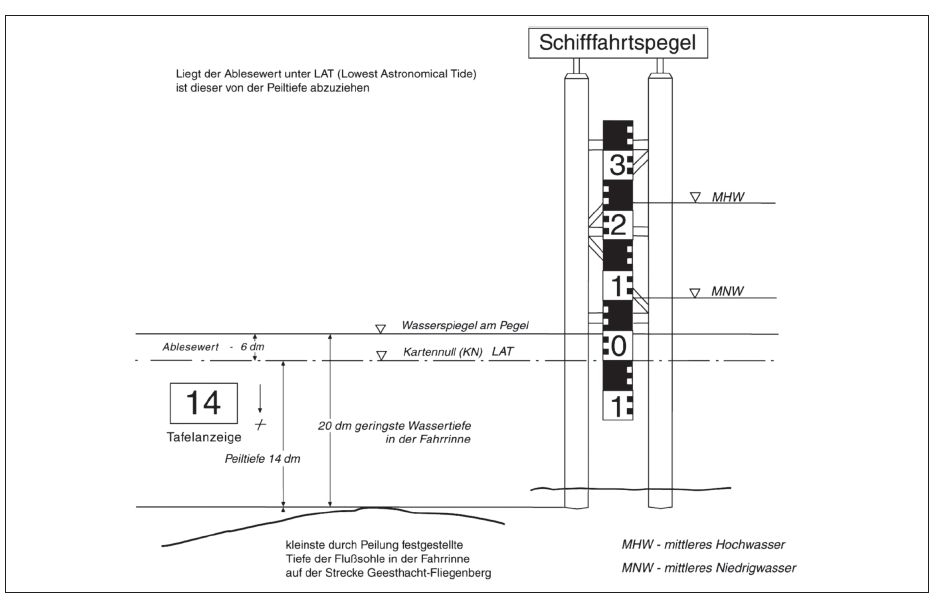
-
5.
-
The dimensions, drivings and unloading depths referred to in points 1, 2 and 4 shall not apply to the bulkhead and old canals, secondary arms and other secondary waterways of the main waterways, provided that these are not separately listed.
Unofficial table of contents
Section 17.03 Compilation of associations
-
1.
-
May be put into a tow
-
a)
-
in the descent, no more than two Annexes and
-
b)
-
in the case of a mountain trip, at most
set. By way of derogation from the first sentence of point (a), a maximum of an Annex may be placed in a towed train in the descent of km 56.80 to km 607,50 if the towing vehicle exceeds a length of 80.00 m. A trawl may not exceed a total length of 600.00 m from Wittenberge (km 455,00) to Oortkaten-boundary to the Port of Hamburg (km 607,50).
-
2.
-
If equipment floating in a towing assembly is towed directly one after the other, they shall be considered to be a vehicle if the total length of the tractor belt does not exceed 80.00 m. The vehicle at the last position of a tractor in accordance with the first sentence shall be equipped with a ruder.
-
3.
-
By way of derogation from section 1.02 (2), in the case of coupled vehicles, a vehicle not equipped for more than 80,00 m in length and not equipped with a propulsion engine shall not require a skipper, but shall be subject to the driver of the vehicle, which shall be subject to the following conditions: Drive machine is equipped.
-
4.
-
By way of derogation from Section 1.09 (1), in the case of coupled vehicles, the steering wheel of a vehicle which is not equipped with a driving machine need not be occupied. In this case, the ruder must be determined.
Unofficial table of contents
§ 17.04 Driving speed
On the Elbe, the minimum speed is set against the shore for a vehicle or an association, with the exception of small vehicles, in the mountain drive 4 km/h.
Unofficial table of contents
§ 17.05 Mountain ride
(no special provisions)
Unofficial table of contents
§ 17.06 Encounter
(no special provisions)
Unofficial table of contents
§ 17.07 Overhaul
(no special provisions)
Unofficial table of contents
§ 17.08 Contact
(no special provisions)
Unofficial table of contents
§ 17.09 Ankers
(no special provisions)
Unofficial table of contents
§ 17.10 Standstill
(no special provisions)
Unofficial table of contents
§ 17.11 Cruise ship at high tide
-
1.
-
If the water level reaches or exceeds the highest watermark (HSW)-Hochwassermarke (flood mark)-at the directional level for the section of the route listed in point 2, the vessel's navigation shall be reckless and the the competent authority may prohibit all or part of the shipping within the section of the route.
-
2.
-
The flood mark referred to in paragraph 1 shall be determined by the following water levels, and the indicative levels shall apply to the following section:
| Route |
Direction Level |
Flood mark |
German-Czech border (km 0.00)-
Port Riesa (km 109,40) |
Dresden |
500 cm |
| Harbour Riesa (km 109,40)-Elstermündung (km 198,60) |
Torgau |
620 cm |
Elstermündung (km 198,60)-
Saalemündung (km 290,70) |
Lutherstadt Wittenberg |
550 cm |
Saalemündung (km 290,70)-
Entry Port Frohse (km 314,50) |
Barby |
570 cm |
Entry Port Frohse (km 314,50)-
Einfahrt Industriehafen Magdeburg (km 332,80) |
Magdeburg-Strombrücke |
550 cm |
Einfahrt Industriehafen Magdeburg (km 332,80)-
Injunction Nieuerjunctedkanal (km 343,80) |
Rothensee |
745 cm |
Injunction Nieuerliaison Channel (km 343,80)-
Injunction Lower Havel waterway (km 422,80) |
Tangermünde |
620 cm |
Injunction Lower Havel waterway (km 422,80)-
Mouth Alte Löcknitz (km 502,25) |
Wittenberge |
610 cm |
Mouth Alte Löcknitz (km 502,25)-
Entry Port Bleckede (km 550,00) |
Dömitz |
580 cm |
Entry Port Bleckede (km 550,00)-
Injunction Elbe-Lübeck-Kanal (km 569,20) |
Hohnstorf |
820 cm. |
Unofficial table of contents
§ 17.12 Cruise ship on ice
If, as a result of increasing ice formation, the cessation of navigation is threatened, a vehicle or an association shall, on the notice of the competent authority, visit a port of protection or a suitable berth in good time.
Unofficial table of contents
§ 17.13 Night shipping
(no special provisions)
Unofficial table of contents
§ 17.14 Use of carrier ship lighters
(no special provisions)
Unofficial table of contents
Section 17.15 Reporting obligation
(no special provisions)
Unofficial table of contents
Section 17.16 Height of bridges, other fixed superstructures and overhead lines
(no special provisions)
Unofficial table of contents
§ 17.17 Marking of the bridges and weir runs
By way of derogation from the marking in accordance with § § 6.24 and 6.25, a bridge crossing at night can be marked as follows:
-
1.
-
on the sides of the passage: green lights;
-
2.
-
over the middle of the passage: yellow lights,
-
a)
-
in the case of traffic in mountain and descent: a yellow light,
-
b)
-
for traffic in just one direction: two yellow lights on top of each other.
Unofficial table of contents
Section 17.18 Passing through the bridges, barrier works,
Wehre, sluices and individual power lines
-
1.
-
The Magdeburg power line from km 324.50 to km 327,20 is a waterfront at water levels below 400 cm at the Magdeburg level.
-
2.
-
The entry into the waterway in accordance with point 1 shall be regulated by signal lights. They mean:
-
a)
-
a solid red light:
Ban on entry. If possible, a vehicle must be held outside the driving channel in such a way as to ensure that the countertraffic is safe;
-
b)
-
a firm green light:
Permission to enter.
The ban on entry must be taken into account. For lights taken out of service, the provisions of § 6.07 shall apply.
-
3.
-
The lights referred to in point 2 shall be located for:
-
a)
-
the Talers
at the western abutment of the Sternbrücke at km 325,10 and
-
b)
-
the mountain drivers
at the mouth of the Zollelbe estuary at km 327,10.
-
4.
-
At water levels of 400 cm and more at the Magdeburg-Strombrücke level, the regulation according to Num mer 2 does not apply.
-
5.
-
By way of derogation from point 2 (a), individual moving thrust or towing vehicles with a length of no more than 33,00 m or small vehicles may also enter the waterway in accordance with point 1, if the driveway is through a red Light is locked. However, they have to give an oncoming vehicle the unimpeded access.
-
6.
-
At the entrance to the upper lock channel of the double lock Geesthacht has a valley driver ancestor. At the latest after entry into the upper lock channel, a towing assembly must reduce the length of the towed connections to 50.00 m or less. By way of derogation from § § 7.02 and 7.03, the lounger and the use of the anchors in the upper lock channel is permitted.
Unofficial table of contents
§ 17.19 Use of the locks, boat locks and boat transfer systems
(no special provisions)
Unofficial table of contents
§ 17.20 Sailing
(no special provisions)
Unofficial table of contents
Section 17.21 Designation of vehicles
(no special provisions)
Unofficial table of contents
Section 17.22 Regulations on transport
-
1.
-
When approaching a rope ferry, a vehicle, with the exception of a small vehicle, has to give the signal "respect" in accordance with Appendix 6, at the level of the sign E.4a (Appendix 7), which shall be repeated as often as necessary. The giving of the signal can be omitted if a radio communication with the ferry guide has been effected.
-
2.
-
The passing of a rope ferry must take place only if it is still at its permanent berth.
-
3.
-
By way of derogation from point 2, the journey can be carried out on a rope ferry on the side on which a white flag is displayed by the rope ferry during the day and a yellow ordinary light, visible from all sides, is shown at night.
-
4.
-
The entrance to the Rothenseer connecting channel from the Elbe and the exit from the Rothenseer connecting channel into the Elbe can only be done via the marked turning point at km 333,25. Sentence 1 shall not apply to a small-scale muscle-powered vehicle.
Unofficial table of contents
§ 17.23 Regulations for the radio
Section 4.05 (3) shall also apply to a rope ferry.
Unofficial table of contents
Section 17.24 Special provisions for small vehicles
(no special provisions)
Unofficial table of contents
Section 17.25 Beating of waste water, canals and individual waterways
(no special provisions)
Unofficial table of contents
Section 17.26 Protection of the channels and installations
(no special provisions)
Unofficial table of contents
Section 17.27 Transport restrictions on shipping
(no special provisions)
Unofficial table of contents
Section 17.28 Use of waterways
(no special provisions)
Unofficial table of contents
§ 17.29 Code of conduct of the ship's guide, the crew on board, the owner and the exporter
-
1.
-
The skipper and the person responsible for the course and speed according to § 1.03 (3) shall each have
-
a)
-
ensure that the vehicle or the association does not fall below the required minimum speed in accordance with § 17.04, and
-
b)
-
the rules on
-
aa)
-
navigation in the case of floods in accordance with section 17.11 (1) and a ban on shipping ordered under this provision;
-
bb)
-
the behaviour of ice in accordance with § 17.12,
-
cc)
-
the behaviour of passing the group of floodgates pursuant to § 17.18 (6), first sentence, and (2),
-
dd)
-
the entry into and exit from the Rothenseer connecting channel in accordance with section 17.22 (4) and
-
ee)
-
the voice radio on a rope ferry pursuant to § 17.23 in conjunction with § 4.05 (3)
, or to ensure compliance with these provisions or an ordered ban on shipping.
-
2.
-
The ship's guide has
-
a)
-
to ensure that
-
aa)
-
the vehicle it passes, the vehicle with side-wheel drive it is guided, the towing vehicle carried by it or the association it is guided by the vehicle, the approved maximum dimensions in accordance with Article 17.02 (1) and (2), and the approved discharge depth in accordance with Section 17.02 (4) sentence 4, and
-
bb)
-
in the case referred to in Article 17.02 (2.1.3) and (2.2.7), respectively, the equipment or pre-credits indicated in each case in each of the cases referred to in paragraph 17.02 (2.1.3) and 2.2.7,
-
b)
-
the rules on
-
aa)
-
the compilation of the associations in accordance with Section 17.03 (1), 2 (2) and 4 (2) and (2) and
-
bb)
-
the behaviour towards a rope ferry pursuant to section 17.22 (1) and (2), also in conjunction with point 3,
, or to ensure that they are complied with, and
-
c)
-
comply with the prohibition of entry into the Magdeburg power line provided for in the third sentence of section 17.18 (2), or to ensure that it is observed.
-
3.
-
The owner and the equipment supplier may only arrange or permit the putting into service of a vehicle, a side-wheel drive vehicle, a towing vehicle or a vehicle, if:
-
a)
-
the vehicle, the vehicle with side-wheel drive, the towing vehicle or the bandage does not exceed the permitted maximum dimensions in accordance with Section 17.02 (1) and (2) and the approved depth of unloading in accordance with § 17.02 (4) sentence 4; and
-
b)
-
on the association, in the case referred to in § 17.02 (2.1.3) and 2.2.7 (s) respectively, the equipment or pre-credits specified therein.
Chapter 18
Ilmenau
Unofficial table of contents
Section 18.01 Scope
The regulations of this chapter apply on the Ilmenau (Im) from the northwest edge of the Brausebrücke at the Abtsmühle in Lüneburg (Im-km 0,00) to the mouth of the river Elbe (Im-km 28 ,84/El-km 598,97).
Unofficial table of contents
§ 18.02 Dimensions of vehicles and federations, unloading depth
A vehicle or a thrust body shall not exceed the following dimensions:
Inland waterway road Length-BreiteAbladedepth
mmm
| 1. |
km 0,50 (Warburg) to km 28,84 (Ilmenaumündung) |
|
|
|
| |
Vehicle/thrust dressing |
45.00 |
6.20 |
Depending on the water level |
| |
unless otherwise specified in the following text |
|
|
|
| 2. |
to km 17,75 (end of the port of Schleusenvorhafen Fahrenholz) to km 28,32 |
|
|
|
| |
Vehicle/thrust dressing |
67.00 |
9,00 |
Depending on the water level |
| 3. |
km 28,32 (port Hoopte) to km 28,84 (port of Ilmenaumündung) |
|
|
|
| |
Vehicle/thrust dressing |
80.00 |
9.50 |
depending on the water level. |
Unofficial table of contents
§ 18.03 compilation of the associations
-
1.
-
Only one annex in the mountain voyage may be placed in a trawl, and no more than two annexes may be set in the descent of the valley.
-
2.
-
Vehicles, other than small vehicles, may only be used for the towing of a damaged vehicle, for a brief pick-up or with the permission of the competent authority.
Unofficial table of contents
§ 18.04 Driving speed
The maximum permissible speed with respect to the shore is 7 km/h for a vehicle or a bandage.
Unofficial table of contents
§ 18.05 Mountain ride
(no special provisions)
Unofficial table of contents
§ 18.06 Encounter
(no special provisions)
Unofficial table of contents
§ 18.07 Overhaul
(no special provisions)
Unofficial table of contents
§ 18.08 Contact
A vehicle of more than 15,00 m in length shall only be used on a point indicated by the table sign E.8 (Appendix 7).
Unofficial table of contents
§ 18.09 Ankers
(no special provisions)
Unofficial table of contents
§ 18.10 Standstill
(no special provisions)
Unofficial table of contents
§ 18.11 Navigation at Hochwasser
(no special provisions)
Unofficial table of contents
§ 18.12 Shipping on ice
(no special provisions)
Unofficial table of contents
§ 18.13 Night shipping
(no special provisions)
Unofficial table of contents
§ 18.14 Use of carrier ship lighters
(no special provisions)
Unofficial table of contents
Section 18.15 Reporting obligation
(no special provisions)
Unofficial table of contents
Section 18.16 Height of bridges, other fixed superstructures and overhead lines
The lowest passing height under the unopened folding bridge Wittorf is at a water level of 5.00 m at the level Wittorf 1.40 m.
Unofficial table of contents
§ 18.17 Labelling of the bridges and weir passes
(no special provisions)
Unofficial table of contents
§ 18.18 Diing through the bridges, barrier works,
Wehre, sluices and individual power lines
The folding bridges Wittorf and Bardowick will only be opened after registration.
Unofficial table of contents
§ 18.19 Use of the locks, boat locks and boat transfer systems
(no special provisions)
Unofficial table of contents
§ 18.20 Sailing
(no special provisions)
Unofficial table of contents
Section 18.21 Designation of vehicles
(no special provisions)
Unofficial table of contents
Section 18.22 Regulations on transport
(no special provisions)
Unofficial table of contents
§ 18.23 Rules on speech radio
(no special provisions)
Unofficial table of contents
Section 18.24 Special provisions for small vehicles
(no special provisions)
Unofficial table of contents
§ 18.25 Waste water, canals and individual waterways
(no special provisions)
Unofficial table of contents
Section 18.26 Protection of the channels and installations
(no special provisions)
Unofficial table of contents
Section 18.27 Transport restrictions on shipping
The river Ilmenau from the North-West edge of the Brausebrücke at the Abtsmühle in Lüneburg (km 0,00) to Warburg (km 0.50) is forbidden. The competent authority may grant exemptions in individual cases. The first sentence shall not apply to a small vehicle without a driving machine.
Unofficial table of contents
Section 18.28 Use of waterways
(no special provisions)
Unofficial table of contents
§ 18.29 Code of conduct of the ship's guide,
the crew on board, the owner and the exporter
-
1.
-
The skipper and the person responsible for the course and speed according to § 1.03 (3) shall each have
-
a)
-
ensure that the vehicle or the association does not exceed the maximum permitted speed in accordance with § 18.04, and
-
b)
-
to comply with the provisions on the application in accordance with § 18.08, or to ensure that it is complied with.
-
2.
-
The ship's guide has
-
a)
-
ensure that the vehicle it is running or the association it is guided does not exceed the maximum authorised measurements and the depth of unloading according to § 18.02,
-
b)
-
comply with the rules on the compilation of the associations in accordance with § 18.03 or to ensure that they are complied with, and
-
c)
-
comply with the prohibition laid down in the first sentence of § 18.27, sentence 1, of the inland waterway transport route indicated therein, or to ensure that it is observed.
-
3.
-
The owner and the equipment supplier may only order or permit the entry into service of a vehicle or association if the vehicle or the association does not exceed the approved maximum dimensions and the unloading depths according to § 18.02.
Chapter 19
Elbe-Lübeck-Canal and Canal Trave
Unofficial table of contents
Section 19.01 Scope
The provisions of this Chapter shall apply to:
-
1.
-
the Elbe-Lübeck-Kanal (ELK) from the junction of the Trave, 71,00 m northeast of the axis of the Geniner Road Bridge (ELK-km 0,00) to the entrance to the Elbe near Lauenburg (ELK-km 61 ,55/El-km 569,23) and
-
2.
-
the canal trave from the junction of the Elbe-Lübeck-Canal to the north-western edge of the railway-lift bridge in Lübeck with the branch-arm Stadttrave from the junction from the canal trave to the south edge of the Wipperbrücke bridge.
Unofficial table of contents
Section 19.02 Dimensions of vehicles and federations, unloading depth
A vehicle or a thrust assembly shall not exceed the following dimensions and loading depths:
Inland waterway road Length-BreiteAbladedepth
mmm
| 1. |
Elbe-Lübeck-Kanal |
|
|
|
| 1.1 |
km 0,00 to km 61,55 (entrance to the Elbe) |
|
|
|
| |
Vehicle/thrust dressing |
80.00 |
9.50 |
2.00 |
| |
unless otherwise specified in the following text |
|
|
|
| 1.2 |
km 0,00 to km 59,40 (Umschlagstelle Horsterdamm) |
|
|
|
| |
Vehicle/thrust dressing |
80.00 |
8.20 |
2.10 |
| |
-from km 0,00 to km 3.43 (Büssau sluice) the depth of unloading at a water level below 500 cm at the level of lift bridges is reduced by the measure of the respective sinking of the water level- |
| 1.3 |
km 59,40 (Umschlagstelle Horsterdamm) to km 61,55 (Injunction to the Elbe) |
|
|
|
| |
Vehicle |
110,00 |
11.45 |
2.30 |
| |
Thrust Association |
125.00 |
9.60 |
2.30 |
| |
-from km 60,10 (Schleuse Lauenburg) to km 61,55 the permissible unloading depth of 2.30 m is valid only at a water level of ≥ 4.30 m at the level of Hohnstorf on the Elbe river- |
| 2. |
Channel Trave |
|
|
|
| |
km 0,00 to km 5,57 (Hubbrücken in Lübeck) |
|
|
|
| |
Vehicle/thrust dressing |
80.00 |
9.50 |
2.10 |
| |
-in the case of a water level at the level of lift bridges below 500 cm, the unloading depth shall be reduced by the respective measure of the lower water level; from km 4.26 to km 5.57, the unloading depth may be increased to up to 2.50 m if the water level at the level Lift bridges 500 cm (medium water level) has reached-. |
Unofficial table of contents
§ 19.03 compilation of the associations
-
1.
-
Only as many vehicles may be set in a towed dressing, that it does not require more than two locks. The distance between the machine-driven vehicle at the top of the body and the first attachment shall not exceed 50.00 m, and the distance between the appendices shall not exceed 25,00 m. A vehicle with a machine drive which is designed to be designed for the carriage of goods and which is permitted for towing, shall be allowed to tow only one annex.
-
2.
-
Vehicles, other than small vehicles, may, with the exception of the port of Lauenburg, be used for the towing of a damaged vehicle, for a brief pick-up or with the permission of the competent authority.
Unofficial table of contents
§ 19.04 Driving speed
| 1. |
The maximum permitted speed on the shore shall be for a vehicle or an association, with the exception of small vehicles, each of which shall be: |
|
| |
a) |
a loading depth of not more than 1,20 m and a width of not more than 8,30 m |
10 km/h, |
| |
b) |
a loading depth of not more than 1,20 m and a width of more than 8,30 m or with a discharge depth of more than 1,20 m and a width of not more than 8,30 m |
8 km/h, |
| |
c) |
a loading depth of more than 1,20 m and a width of more than 8.30 m |
6 km/h. |
| 2. |
The maximum permissible speed with respect to the shore shall be for a small vehicle |
10 km/h. |
| 3. |
The minimum speed with respect to the shore shall be for a vehicle or an association, with the exception of small vehicles, |
5 km/h. |
Unofficial table of contents
§ 19.05 Mountain ride
As a mountain ride on the Elbe-Lübeck-Canal, the trip is in the direction of the Elbe.
Unofficial table of contents
§ 19.06 Encounter
(no special provisions)
Unofficial table of contents
§ 19.07 Overhaul
-
1.
-
The overtaking at night is forbidden.
-
2.
-
By way of derogation from point 1, a small vehicle may be overhauled and overhauled.
Unofficial table of contents
§ 19.08 Contact
A vehicle may only apply if the maneuver can be carried out without contact between the banks and the structures.
Unofficial table of contents
§ 19.09 Ankers
(no special provisions)
Unofficial table of contents
§ 19.10 Standstill
The name prescribed in accordance with § 3.20 does not need to be carried out if the vehicle is stationary at a recumbering or transhipment point outside the continuous channel.
Unofficial table of contents
§ 19.11 Cruise ship at high tide
(no special provisions)
Unofficial table of contents
§ 19.12 Shipping on ice
(no special provisions)
Unofficial table of contents
§ 19.13 Night shipping
(no special provisions)
Unofficial table of contents
§ 19.14 Use of carrier ship lighters
(no special provisions)
Unofficial table of contents
Section 19.15 Reporting obligation
(no special provisions)
Unofficial table of contents
Section 19.16 Height of bridges, other fixed superstructures and overhead lines
-
1.
-
The passage height under a bridge is between the Schleusen Lauenburg and Büssau at normal canal water level 4.40 m.
-
2.
-
In the upper lifting position, the passage height under the lift bridge in Lübeck at medium water level (500 cm at the level of lift bridges) is 5.40 m. In addition to the signal lights according to § 6.26 (4) (b) or (c), white lights can be shown on the lifting bridges.
-
a)
-
two white lights above the left red lights: pass only for a vehicle at a height of 2.50 m above the middle water level;
-
b)
-
a white light above the left red light: passage only for a vehicle at a height of 1.45 m above the middle water level.
-
3.
-
At the Klughafen, the passage height at medium water level is 5.50 m.
-
4.
-
If the water level of the Elbe at the Hohnstorf level has reached 780 cm, the passage height under the Lauenburger Straßenbrücke (ELK-km 61,03) is 6.04 m.
-
5.
-
The passage heights can be reduced by water level fluctuations.
Unofficial table of contents
Section 19.17 Labelling of the bridges and weir runs
(no special provisions)
Unofficial table of contents
Section 19.18 Passing through the bridges, barrier works,
Wehre, sluices and individual power lines
(no special provisions)
Unofficial table of contents
§ 19.19 Use of the locks, boat locks and boat transfer systems
(no special provisions)
Unofficial table of contents
§ 19.20 Sailing
Sailing is forbidden. The competent authority may, on a case-by-case basis, allow exceptions to be made on the Channel Trave to the extent that the safety and lightness of the traffic is not affected.
Unofficial table of contents
Section 19.21 Designation of vehicles
(no special provisions)
Unofficial table of contents
Section 19.22 Regulations on transport
(no special provisions)
Unofficial table of contents
§ 19.23 Regulations for the radio
(no special provisions)
Unofficial table of contents
Section 19.24 Special provisions for small vehicles
(no special provisions)
Unofficial table of contents
Section 19.25 Waste water, canals and individual waterways
(no special provisions)
Unofficial table of contents
Section 19.26 Protection of the channels and installations
(no special provisions)
Unofficial table of contents
Section 19.27 Transport restrictions on shipping
(no special provisions)
Unofficial table of contents
Section 19.28 Use of waterways
(no special provisions)
Unofficial table of contents
§ 19.29 Code of conduct of the ship's guide,
the crew on board, the owner and the exporter
-
1.
-
The skipper and the person responsible for the course and speed according to § 1.03 (3) shall each have
-
a)
-
to ensure that the vehicle or the association
-
aa)
-
does not exceed the maximum permitted speed in accordance with section 19.04 (1) and (2); and
-
bb)
-
does not fall below the required minimum speed in accordance with § 19.04 (3); and
-
b)
-
the rules on
-
aa)
-
to overtake the prohibition in accordance with § 19.07 (1) and (1)
-
bb)
-
Turning in accordance with § 19.08
or to ensure that they are complied with.
-
2.
-
The ship's guide has
-
a)
-
ensure that the vehicle it is running or the association it is running does not exceed the maximum authorised measurements and the depth of unloading in accordance with section 19.02;
-
b)
-
comply with the rules on the compilation of the associations in accordance with § 19.03, or ensure that they are complied with, and
-
c)
-
prohibit, sail, observe or ensure compliance with the prohibition laid down in the first sentence of section 19.20, sentence 1.
-
3.
-
The owner and the equipment supplier may only order or permit the entry into service of a vehicle or association if the vehicle or the association does not exceed the approved maximum dimensions and the depth of unloading in accordance with § 19.02.
Chapter 20
Saar
Unofficial table of contents
§ 20.01 Scope
The provisions of this chapter apply on the Saar (Sa) from the mouth of the Moselle (Sa-km 0 ,00/Moselkm 200,81) to the German-French border at Saargemünd (lothr. km 64,975 re.U.).
Unofficial table of contents
Section 20.02 Dimensions of vehicles and federations, driverine depth
-
1.
-
A vehicle or an association shall not exceed the following dimensions:
-
| |
|
|
|
| Inland waterway |
Length
M |
Width
M |
| 1.1 |
km 0,00 (Saarmündung) to lothr. km 64,975 re.U. (German-French border at Saargemünd) |
|
|
| |
Vehicle |
38.50 |
5.05 |
| |
unless otherwise specified in the following text |
|
|
| |
|
|
|
|
| 1.2 |
km 0,00 (Saarmündung) to km 58,87 (Dillingen) |
|
|
| |
a) |
Vehicle (excluding passenger ships) |
135.00 |
11.45 |
| |
b) |
Passenger ship |
110,00 |
11.45 |
| |
c) |
Federation |
185.00 |
11.45 |
| |
|
|
|
|
| 1.3 |
km 58,87 (Dillingen) to km 87,20 (end of the developed route) |
|
|
| |
a) |
Vehicle |
110,00 |
11.45 |
| |
b) |
Federation |
185.00 |
11.45. |
-
A vehicle or a bandage with a length of more than 90.00 m may be used only if it is equipped with an active bow control device. A vehicle with a length of more than 110,00 m may be used only if it is in construction, equipment and propulsion to meet the requirements of Annex II, Chapter 22a of the inland waterway search order, including in conjunction with Article 1 (8) of the Rules of the Inland Waterway Inland waterway search order; this vehicle must:
-
a)
-
have an entry in the travel certificate under point 52 that it satisfies the specific requirements laid down in Annex II (2) (2) (2) (a) to (d) of the Inland Waterway Search Order;
-
b)
-
carry the proof of the swimming capacity, the trimming position and the stability (capsizing safety) of the separate parts of the ship,
-
c)
-
take special care in the use of shipping facilities and observe increased nautical care, and
-
may not use the machine drive as well as the bow blasting system beyond the nautical level. The proof referred to in the third sentence of paragraph 2 (b) shall, at the request of the water protection police and the officials of the competent authority, be handed over for inspection. A special permit issued by the competent authority and valid on 31 December 2009 for a vehicle having a length of more than 110.00 m which does not comply with the requirements of Annex II, Chapter 22a of the Inland Waterway Investigation Order, including in In accordance with § 1 (8) of the Inland Waterways investigation order, the conditions on the respective current section remain valid with the conditions given. This special permit shall be carried on board and shall be suspended for inspection at the request of the water protection police and the officials of the competent authority.
-
2.
-
The association referred to in point 1 shall be subject to only one thrust assembly and coupled vehicles.
-
3.
-
The driverine depth shall be
| a) |
From the mouth of the Saar (km 0,00) to the end of the distance (km 87,20) |
3.00 m |
| b) |
from the end of the developed route (km 87,20) to the German-French border at Saargemünd (lothr. km 64,975 re.U.) |
2.00 m. |
Unofficial table of contents
§ 20.03 compilation of the associations
Only as many vehicles may be set in a towed dressing, that it does not require more than one lock.
Unofficial table of contents
§ 20.04 Driving speed
-
1.
-
The maximum permissible speed with respect to the shore is for a vehicle or an association
-
| a) |
from km 0,00 (Saaründung) to km 87,20 (end of the developed route) |
16 km/h, |
| b) |
from km 87,20 (end of the route developed) to lothr. km 64,975 re.U. (German-French border at Saargemünd) |
8 km/h. |
-
2.
-
By way of derogation from point 1, the competent authority may allow higher speeds for a small vehicle, a passenger ship or a passenger barge, by way of derogation from point 1, if that means the condition and the use of the vehicle the waterway, as well as the rest of the shipping traffic, are not affected by a fee.
Unofficial table of contents
§ 20.05 Mountain ride
(no special provisions)
Unofficial table of contents
§ 20.06 Encounter
| 1. |
|
There is a ban on encounter on the following waterways: |
| |
|
|
|
|
| |
a) |
for a vehicle or a federation (excluding small vehicles): |
| |
|
Völklingen |
km Völklingen 75,20 to km 76,10; |
| |
|
|
|
|
| |
b) |
for a vehicle or an association (excluding small vehicles): |
| |
|
aa) |
Taben-Roth |
km 21,20 to km 23,40, |
| |
|
bb) |
Mettlach Oberwasser |
km 32,40 to km 33,00; |
| |
|
|
|
|
| |
c) |
for an association: |
|
| |
|
aa) |
WSA-Umschlagstelle im Schleusenkanal Kanzem |
km 5.70 to km 7,20, |
| |
|
bb) |
Saarburg |
km 11,70 to km 12,50, |
| |
|
cc) |
Serrig |
km 14,10 to km 16,20, |
| |
|
dd) |
Mettlach Unterwasser |
km 28,50 to km 30,50, |
| |
|
ee) |
Saarschleife |
km 33,60 to km 35,20, |
| |
|
ff) |
Pedestrian bridge Fremersdorf |
km 47,70 to km 48,90, |
| |
|
gg) |
Lisdorfer Au |
km 61,00 to km 64,00. |
| |
|
|
|
| 2. |
When approaching a waterway, a mountain driver has to call a driver on Channel 10 and ask him to inform him of the type, name, location and direction of travel of the vehicle. If there is no cyclist, the mountain driver is allowed to enter the waterways, except for the waterways |
| |
|
|
|
| |
a) |
Taben-Roth |
km 21,20 and |
| |
b) |
Saarschleife |
km 33.60. |
| |
|
| |
It shall only enter the waterways referred to in the second sentence if it has previously received two deep tones of one second duration in order to control the proper operation of the radio in the area of these waterways, on channel 10. |
| |
|
| 3. |
When approaching a waterway on Channel 10, a cyclist has to announce the type, name, location and direction of travel of his vehicle several times. He has to provide the same information when he is approached by a mountain driver. |
| |
|
| 4. |
Points 2 and 3 shall not apply to a small vehicle. |
Unofficial table of contents
§ 20.07 Overhaul
(no special provisions)
Unofficial table of contents
§ 20.08 Contact
A vehicle may only apply if the maneuver can be carried out without touching the shore and the buildings. For a vehicle up to 110,00 m in length there are turning points at Ensdorf (km 65,34), at Völklingen (km 77,52) and at Saarbrücken (km 86,42).
Unofficial table of contents
§ 20.09 Ankers
The anchorage is forbidden.
Unofficial table of contents
§ 20.10 Standstill
Breast-feeding is only permitted at the designated recumbering sites.
Unofficial table of contents
§ 20.11 Cruise ship at high tide
| 1. |
If the water level reaches or exceeds the highest watermark (HSW)-flood mark-at the guide level for the section of the route listed in point 2, the shipping is within the respective section of the route forbidden. |
| |
|
|
|
| 2. |
The flood mark referred to in paragraph 1 shall be determined by the following water levels, and the indicative levels shall apply to the following section: |
| |
|
|
|
|
| |
Route |
Direction Level |
Flood mark |
|
| |
Saarmündung (km 0,00) to the underwater of the |
|
|
|
| |
Schleuse Kanzem (km 5.10) |
Grevenmacher |
520 cm |
|
| |
|
(Mosel-km 212,50) |
|
|
| |
|
|
|
|
| |
Schleuse Kanzem (km 5.10) to the underwater
the Schleuse Lisdorf (km 66,10) including
Wiltinger bow |
Fremersdorf |
390 cm |
|
| |
|
|
|
|
| |
Schleuse Lisdorf (km 66,10) to the Unterwasser
the Schleuse Saarbrücken (km 82,50) |
Saarbrücken-St. Arnual |
290 cm |
|
| |
|
|
|
|
| |
Schleuse Saarbrücken (km 82,50) up to the lower
water of the Schleuse Güdingen (km 92,90) |
Saarbrücken-St. Arnual |
230 cm. |
|
| |
|
|
|
| 3. |
In the case of Saarbrücken (km 82.50 to km 92,90), the competent authority may, by way of derogation from point 2, allow exceptions. |
Unofficial table of contents
§ 20.12 Shipping on ice
(no special provisions)
Unofficial table of contents
§ 20.13 Night shipping
(no special provisions)
Unofficial table of contents
§ 20.14 Use of carrier ship lighters
A carrier ship lighter must not be placed at the top of a pusher belt. The competent authority may allow exceptions to this.
Unofficial table of contents
Section 20.15 Reporting obligation
-
1.
-
The skipper of a vehicle or of an association which is subject to the ADN, as well as the skipper of a tanker, a cabin vessel, a seagoing vessel or a special transport pursuant to § 1.21 shall be required to enter the Saarland before the entry into the vessel. report on Nautical Information at the "Kanzem Schleuse" radio station between the lock Kanzem (km 5, 17) and the mouth of the Moselle on the channel of the transport circuit known in the manual inland waterway (section 1.10 (1) (l)); and the following information:
-
a)
-
Ship's genus;
-
b)
-
Ship ' s name;
-
c)
-
Location, direction of travel;
-
d)
-
Uniform European ship number or official vessel number, in the case of sea-ships IMO-ship identification number and distinguishing signal;
-
e)
-
Carrying capacity;
-
f)
-
the length and width of the vehicle;
-
g)
-
the type, length and breadth of the association;
-
h)
-
driving route;
-
i)
-
Beladehafen;
-
j)
-
Unloading port;
-
k)
-
for dangerous goods by ADN:
-
aa)
-
the UN number or substance number,
-
bb)
-
the official designation for the carriage, if applicable supplemented by the technical name,
-
cc)
-
the class, classification code and, where appropriate, the packaging group;
-
dd)
-
the total quantity of dangerous goods for which this information applies;
-
K 1 )
-
in the case of other goods as dangerous goods: the type of cargo (substance name, quantity of substance);
-
l)
-
Number of blue lights/blue cones guided;
-
m)
-
Number of persons on board.
-
In the event of a special request from the "Kanzem Schleuse" radio station, the skipper shall make information on the draught of the vehicle, the association or the special transport carried out by him in accordance with § 1.21. The limitation of the route to be notified shall be indicated by Table Signs B.11 (Appendix 7) with an additional sign "Reporting obligation".
-
2.
-
Without prejudice to the obligation laid down in the first and second sentences of paragraph 1, the skipper of a vehicle, a federation or a special transport pursuant to section 1.21, excluding the skipper of a ferry or of a small vehicle, shall be required to enter the vessel before the entry into the Report on Nautical Information at the "Kanzem Schleuse" radio station on the Channel of the Transport Circle announced in the inland waterway transport manual (Section 1.10 (1) (l)) and the information referred to in the first sentence of point 1 (a) to g and the following additional information:
-
a)
-
loading condition (leer/laden);
-
b)
-
Expected arrival at the lock office (only Taldriver and if the notification is given before reaching the reporting point).
-
In the event of a special request from the "Kanzem Schleuse" radio station, the skipper shall make information on the draught of the vehicle, the association or the special transport carried out by him in accordance with § 1.21.
-
3.
-
The information referred to in paragraph 1, first sentence, excluding the provisions of point (c) and (m), and in point 2, with the exception of the draught of the vehicle, the association or the special transport in accordance with section 1.21, may also be provided by other bodies or persons in good time before the Entry of the vehicle, association or special transport according to § 1.21 into the notifiable route in writing, by telephone or by electronic means of the radio station "Kanzem Schleuse" are communicated. For a transport with a load of more than two dangerous goods, the notification must be made in writing or electronically. In any case, the ship's guide shall report to the "Kanzem Schleuse" radio station if he enters the notifiable route with the vehicle, association or special transport he/she is carrying in accordance with § 1.21 and leaves it again.
-
4.
-
If a vehicle, association or special transport according to § 1.21 interrupts the journey within the notifiable route for more than two hours, the ship's guide must report the beginning and end of the interruption to the "Kanzem Schleuse" radio station.
-
5.
-
If the particulars referred to in point 1 change during the journey in the notifiable route, the skipper must immediately inform the radio station "Kanzem Schleuse" of this.
-
6.
-
A vehicle, an association or a special transport pursuant to § 1.21, which has issued a complete notification in accordance with the first and second sentences of the first and second sentences of paragraph 1, and a vehicle, a federation or a special transport pursuant to § 1.21, the or the one on the Mosel has already issued a notification in accordance with § 9.05 of the Moselschifffahrtspolizeiverordnung (Moselschifffahrtspolizeiverordnung) and enters the Saar, must be at the reporting point located in front of the lock in the direction of travel, the one with the Table Signs B.11 (Appendix 7) and a supplementary board "Reporting obligation", the radio station "Kanzem Schleuse" is only the information referred to in point 1. Repeat the sentence 1 (a) to (d).
Unofficial table of contents
Section 20.16 Height of bridges, other fixed superstructures and overhead lines
| The passage height under the bridges is at the highest waterlevel (HSW)-Hochwassermarke- |
| |
|
|
| 1. |
From the mouth of the Saar (km 0,00) to the end of the distance (km 87,20) |
at least 5.25 m, |
| |
|
|
| 2. |
from the Luisenbrücke bridge (km 87,23) to the road bridge Güdingen (km 93.26) |
at least 4.90 m. |
Unofficial table of contents
§ 20.17 Labelling of the bridges and weir passes
(no special provisions)
Unofficial table of contents
§ 20.18 Passing through the bridges, barrier works,
Wehre, sluices and individual power lines
(no special provisions)
Unofficial table of contents
§ 20.19 Use of the locks, boat locks and boat transfer systems
A vehicle of no more than 40.00 m in length and not more than 6.40 m wide must be used in Kanzem, Serrig, Mettlach and Rehlingen the small ship lock. The control of the smuggling of the air can give a different instruction.
Unofficial table of contents
§ 20.20 Sailing
(no special provisions)
Unofficial table of contents
Section 20.21 Designation of vehicles
(no special provisions)
Unofficial table of contents
Section 20.22 Regulations on transport
(no special provisions)
Unofficial table of contents
§ 20.23 Rules for speech radio
(no special provisions)
Unofficial table of contents
Section 20.24 Special provisions for small vehicles
(no special provisions)
Unofficial table of contents
§ 20.25 Beating of waste water, canals and individual waterways
(no special provisions)
Unofficial table of contents
Section 20.26 Protection of the channels and installations
(no special provisions)
Unofficial table of contents
Section 20.27 Transport restrictions on shipping
(no special provisions)
Unofficial table of contents
Section 20.28 Use of waterways
(no special provisions)
Unofficial table of contents
§ 20.29 Code of conduct of the ship's guide,
the crew on board, the owner and the exporter
-
1.
-
The skipper and the person responsible for the course and speed according to § 1.03 (3) shall each have
-
a)
-
to ensure that
-
aa)
-
the vehicle or the association does not exceed the maximum authorised speed in accordance with section 20.04 (1), including in conjunction with point 2, and
-
bb)
-
in the case of a vehicle with a length of more than 110,00 m of the machine drive and the bow blasting system in accordance with Section 20.02 (1), sentence 3, half-sentence 2, not being used beyond the level of the nautical required; and
-
b)
-
the rules on
-
aa)
-
the behaviour or the drawing of the counter in accordance with § 20.06 (1), (2), first sentence, (3) and (3),
-
bb)
-
Turning in accordance with § 20.08, sentence 1,
-
cc)
-
Shipping in the case of floods pursuant to Section 20.11 (1) and
-
dd)
-
the use of the locks pursuant to § 20.19, sentence 1, also in conjunction with sentence 2,
-
or to ensure that they are complied with.
-
2.
-
The ship's guide has
-
a)
-
to ensure that
-
aa)
-
the vehicle it is running or the association it guided does not exceed the maximum authorised measurements in accordance with the first sentence of section 20.02 (1) of the first sentence,
-
bb)
-
on the vehicle or association which it has carried out in the case referred to in Section 20.02 (1), second sentence, of the equipment specified therein,
-
cc)
-
the vehicle it is being guided, with a length of more than 110.00 metres, corresponds to the requirements referred to in Article 20.02 (1), first sentence, first sentence, 1;
-
dd)
-
the proof of the safety of the separate parts of the ship pursuant to § 20.02 (1) sentence 3 (2) (2) (b) is carried on board and, in accordance with § 20.02 (1) sentence 4, at the request of the water protection police or the officials of the competent authority shall be suspended for control; and
-
ee)
-
the special permit pursuant to section 20.02 number 1 sentence 5 is carried on board and, in accordance with section 20.02 number 1 sentence 6, is handed out for inspection at the request of the water protection police or the staff of the competent authority; and
-
b)
-
the rules on
-
aa)
-
the compilation of the associations according to § 20.03,
-
bb)
-
the anchorage according to § 20.09,
-
cc)
-
Standstill according to § 20.10,
-
dd)
-
the use of carrier ship creators according to § 20.14 sentence 1 and
-
ee)
-
the obligation to notify pursuant to § 20.15 (1) sentence 1, 2, (2), (2), (2) and (3) and (4) to (6)
-
or to ensure that they are complied with.
-
3.
-
The owner and the exporter
-
a)
-
shall only place or permit the putting into service of a vehicle or association if:
-
aa)
-
the vehicle or the association does not exceed the permitted maximum dimensions in accordance with section 20.02 (1) sentence 1,
-
bb)
-
on the vehicle or association, in the case referred to in the second sentence of section 20.02 (1), the equipment specified therein, and
-
cc)
-
the vehicle with a length of more than 110,00 m corresponds to the requirements referred to in Article 20.02 (1) sentence 3, first sentence, 1; and
-
b)
-
shall ensure that:
-
aa)
-
the proof of the safety of the separate parts of the ship in accordance with section 20.02 (1) sentence 3 (2) (b) and (2) (b) and
-
bb)
-
the special permit pursuant to § 20.02 (1) sentence 5
-
be carried on board.
Chapter 21
Spree-Or-waterway,
Berliner and Brandenburger Waterways
Unofficial table of contents
Section 21.01 Scope
The provisions of this Chapter shall apply to the following waterways:
-
1.
-
the Spree-Oder-Wasserstraße (SOW) from the junction from the Havel-Oder-Waterway (HOW) near Spandau (SOW-km 0 ,15/HOW-km 0.13) to the entrance to the Oder (SOW-km 130 ,17/Od-km 553,40) including Untere Spree, Berliner Spree, Treptower Spree, Dahme (Langer See), Oder-Spree-Kanal and Fürstenwalder Spree with Ruhlebener Altarm, Landwehrkanal, Spreekanal/Kupfergraben, Rummelsburger See, Müggelspree (MgS) from the entrance into the Spree-Oder-Wasserstraße near Köpenick (SOW-km 32,85) to MgS-km 11,85 including the big müggelsee, little müggelsee, the benches and the Subwater of the Wehres Great potions (MgS-km 44.85) to the junction from the Spree-Oder-Wasserstraße (MgS-km 45 ,10/SOW-km 69,05), Große Krampe, Wasserstraße Seddinsee and Gosener Kanal (WSG), Gosener Graben, Dehmsee-entrance up to km 0,35, Drahendorfer Spree up to km 0,38, Kersdorfer See-entrance to km 0,12, Neuhauser dining channel to the end of the lower sluice front Neuhaus (km 2,81), Klein Müllroser See up to the mouth of the hose (km 0,40), Brieskower Canal to km 0,55,
-
2.
-
the Berlin-Spandauer Schifffahrtskanal (BSK) from the turn-off from the Havel-Oder-Wasserstraße (Spandauer Havel, BSK-km 0 ,42/HOW-km 3.37) to the entrance to the Spree-Oder-Wasserstraße, Humboldthafen (BSK-km 12 ,20/SOW-km 14,52), with Westhafen connecting channel, Westhafenkanal nebst Charlottenburger liaison channel (to the Spree),
-
3.
-
the Teltow Canal (TeK) from the junction from the Lower Havel waterway (Potsdamer Havel-km 28, 37) to the entrance to the Spree-Oder-Wasserstraße (Dahme, TeK-km 37 ,84/SOW-km 35,12) including Glienicker Lake, Griebnitzsee and Kleinmachnower See with Griebnitzkanal (including Stölpchensee, Pohlesee and Kleiner Wannsee), Zehlendorfer Stichkanal, Britzer liaison channel (to the Spree),
-
4.
-
the Rüdersdorfer waters (RüG) from the mouth of the Gosener Canal (RüG-km-0,50/WSG-km 5.73) to Tasdorf (RüG-km 10,48) including the Dämeritzsee, Flakensee, Kalksee, Stolpgraben, Hohler See and Strausberger Mühlenflet, Channel Langerhanskanal including Kriensee with Löcknitz up to km 10,64 (including Werlsee, Peetzsee and Möllensee) and
-
5.
-
the Dahme-Wasserstraße (DaW) from the entrance to the Spree-Oder-Wasserstraße near Schmöckwitz (DaW-km 0 ,06/SOW-km 43,99) to above the mouth of the Teupitzer waters (DaW-km 26,04 at Prieros) including Lake Zeuthener See, Sellenzugsee, Krimnicksee, Krüpelsee and Dolgensee with Wernsdorfer Seems to km 8,20 (including Großer Zug, Krossinsee and Wernsdorfer See, Möllenzugsee, Notte to km 0,99, Zernsdorfer Lanke), Storkower waters (Langer See, Wolziger See, Storkower Kanal, Storkower See and Scharmützelsee), Teupitzer waters (Huschtesee, Schmöldesee, Hölzerner See, Klein Köriser See, Kleiner and Großer Moddersee, Schulzensee, Zemminsee, Schweriner See and Teupitzer See).
Unofficial table of contents
Section 21.02 Dimensions of vehicles and federations, unloading depth
-
1.
-
A vehicle or an association shall not exceed the following dimensions and unloading depths:
| |
|
|
|
|
|
| Inland waterway |
Length
M |
Width
M |
Unloading depth
M |
| 1.1 |
Spree-Oder-Waterway |
|
|
|
| |
|
|
|
|
|
| 1.1.1 |
km 0.15 (Spreemündung) to km 130,17 (Oder) |
|
|
|
| |
a) |
Vehicle |
67.00 |
8.25 |
2.00 |
| |
b) |
Federation |
91,00 |
8.25 |
2.00 |
| |
|
|
|
|
|
| |
unless otherwise specified in the following text |
|
|
|
| |
|
|
|
|
|
| 1.1.2 |
km 0.15 to km 6.61 |
|
|
|
| |
a) |
Vehicle |
86.00 |
9.60 |
2.50 |
| |
b) |
Federation |
125.00 |
9.60 |
2.50 |
| |
|
|
|
|
|
| 1.1.3 |
km 6.61 to km 20.70 |
|
|
|
| |
a) |
Vehicle |
80.00 |
9,00 |
2.00 |
| |
b) |
Federation |
91,00 |
9,00 |
2.00 |
| -from km 6,61 to km 9,11 and from km 14,52 to km 20,70 a vehicle with a length of more than 80,00 m and not more than 82,00 m and a width of more than 9,00 m and not more than 9,50 m shall be used if it does not have a discharge depth of 1.90 m exceeds and is equipped with an active bow control device, |
| 1.1.4 |
km 20,70 to km 24,00 |
|
|
|
| |
a) |
Vehicle |
80.00 |
9,00 |
2.00 |
| |
b) |
Federation |
91,00
125.00 |
9,00
8.25 |
2.10
2.10 |
| |
|
|
| -a vehicle with a length of more than 80,00 m and not more than 82,00 m and a width of more than 9,00 m and not more than 9,50 m, if it does not exceed a discharge depth of 1.90 m and with an active bow control device - |
| 1.1.5 |
km 24,00 to km 44,00 |
|
|
|
| |
a) |
Vehicle |
80.00 |
9,00 |
2.00 |
| |
b) |
Federation |
125.00
156.00 |
9,00
8.25 |
2.10
2.10 |
| |
|
|
| -a vehicle with a length of more than 80,00 m and not more than 82,00 m and a width of more than 9,00 m and not more than 9,50 m, if it does not exceed a discharge depth of 1.90 m and with an active bow control device - |
| 1.1.6 |
km 44,00 to km 121,50 |
|
|
|
| |
Federation |
125.00 |
8.25 |
2.00 |
| |
|
|
125.00 |
9,00 |
1.85 |
| |
|
|
|
|
|
| 1.1.7 |
km 121,50 to km 127,50 |
|
|
|
| |
a) |
Vehicle |
82.00 |
9,00 |
2.00 |
| |
b) |
Federation |
91,00 |
9,00 |
2.00 |
| |
|
|
125.00 |
9,00 |
1.85 |
| |
|
|
156.00 |
8.25 |
2.00 |
| |
|
|
156.00 |
9.50 |
1.80 |
| |
|
|
|
|
|
| 1.1.8 |
km 127,50 to km 130,16 |
|
|
|
| |
a) |
Vehicle |
82.00 |
11.45 |
2.00 |
| |
b) |
Federation |
91,00 |
19.00 |
2.00 |
| |
|
|
125.00 |
9,00 |
1.85 |
| |
|
|
156.00 |
8.25 |
2.00 |
| |
|
|
156.00 |
9.50 |
1.80 |
| |
|
|
|
|
|
| 1.1.9 |
Low-level old arm |
|
|
|
| |
a) |
Vehicle |
86.00 |
9.60 |
2.50 |
| |
b) |
Federation |
125.00 |
8.25 |
2.50 |
| |
|
|
|
|
|
| 1.1.10 |
Landwehrkanal |
|
|
|
| |
km 0,00 (Berliner Spree) to km 10,73 |
|
|
|
| |
Vehicle/Association |
49,00 |
7.00 |
1.40 |
| |
|
|
|
|
|
| 1.1.11 |
Spreekanal/Kupfergraben |
|
|
|
| |
Vehicle/Association |
30,00 |
5.10 |
1.60 |
| |
|
|
|
|
|
| 1.1.12 |
Rummelsburger See |
|
|
|
| |
a) |
Vehicle |
80.00 |
9.50 |
2.00 |
| |
b) |
Federation |
91,00 |
9.50 |
2.00 |
| |
|
|
156.00 |
8.25 |
2.00 |
| |
|
|
|
|
|
| 1.1.13 |
Müggelspree |
|
|
|
| |
|
|
|
|
|
| 1.1.13.1 |
km 0,00 (Spree-Oder-Wasserstraße)
to km 11.85 (Dämeritzsee) |
|
|
|
| |
Vehicle/Association |
67.00 |
8.25 |
1.70 |
| |
|
|
|
|
|
| |
unless otherwise specified in the following text |
|
|
|
| |
|
|
|
|
|
| 1.1.13.2 |
km 0,00 (Spree-Oder-Wasserstraße) to km 7,44 |
|
|
|
| |
a) |
Vehicle |
67.00 |
8.25 |
1.75 |
| |
b) |
Federation |
100.00 |
8.25 |
1.85 |
| |
|
|
|
|
|
| 1.1.14 |
Large Krampe |
|
|
|
| |
Vehicle/Association |
67.00 |
8.25 |
1.50 |
| |
|
|
|
|
|
| 1.1.15 |
Seddinsee waterway and Gosener Canal |
|
|
|
| |
a) |
Vehicle |
67.00 |
8.25 |
2.00 |
| |
b) |
Federation |
125.00 |
8.25 |
2.00 |
| |
|
|
|
|
|
| 1.1.16 |
Gosener Graben |
|
|
|
| |
Vehicle |
6.00 |
3.00 |
0.50 |
| |
|
|
|
|
|
| 1.1.17 |
Neuhauser dining channel |
|
|
|
| |
Vehicle/Association |
41.60 |
5.20 |
1.30 |
| |
|
|
|
|
|
| 1.1.18 |
Small Lake Müllroser See |
|
|
|
| |
Vehicle/Association |
50,00 |
8.25 |
1.60 |
| |
|
|
|
|
|
| 1.2 |
Berlin-Spandauer Schifffahrtskanal |
|
|
|
| |
|
|
|
|
|
| 1.2.1 |
km 0,42 (Havel-Oder-Wasserstraße) to km 12,20 (Spree-Oder-Wasserstraße) including West harbour connection channel, Westhafenkanal, Charlottenburg connection channel |
|
|
|
| |
a) |
Vehicle |
67.00 |
9,00 |
2.00 |
| |
b) |
Federation |
91,00 |
9,00 |
2.00 |
| |
|
|
|
|
|
| |
unless otherwise specified in the following text |
|
|
|
| |
|
|
|
|
|
| 1.2.2 |
km 0,42 (Havel-Oder-Wasserstraße) to km 7,45 |
|
|
|
| |
a) |
Vehicle |
80.00 |
9,00 |
2.00 |
| |
b) |
Federation |
125.00 |
9,00 |
2.00 |
| |
|
|
|
|
|
| 1.2.3 |
km 8,30 to km 12,20 (Spree-Oder-Wasserstraße) |
|
|
|
| |
Vehicle |
80.00 |
9,00 |
2.00 |
| -a vehicle with a length of more than 80,00 m and not more than 82,00 m and a width of more than 9,00 m and not more than 9,50 m, if it does not exceed a discharge depth of 1.90 m and with an active bow control device - |
| 1.2.4 |
Westhafenkanal |
|
|
|
| |
a) |
Vehicle |
86.00 |
9.60 |
2.50 |
| |
b) |
Federation |
125.00 |
9.60 |
2.50 |
| |
|
|
|
|
|
| 1.2.5 |
Charlottenburg connection channel |
|
|
|
| |
Vehicle |
80.00 |
9,00 |
2.00 |
| |
|
|
|
|
|
| 1.3 |
TeltowChannel |
|
|
|
| |
|
|
|
|
|
| 1.3.1 |
km-0,55 (Potsdamer Havel) to km 37,84 (Spree-Oder-waterway) including Britzer connecting channel, without Griebnitzkanal |
|
|
|
| |
a) |
Vehicle |
80.00 |
9,00 |
1.75 |
| |
b) |
Federation |
91,00 |
9,00 |
1.75 |
| |
|
| |
-from km 34.10 to km 37,84 may be used for a vehicle or a wheelset with a length of more than 80,00 m and not more than 82,00 m and a width of more than 9,00 m and not more than 9,50 m if it or he has a loading depth of 1.75 m does not exceed and is equipped with an active bow control device, |
| |
|
|
|
|
| |
unless otherwise specified in the following text |
|
|
|
| |
|
|
|
|
|
| 1.3.2 |
km-0,55 (Potsdamer Havel) to km 34,10 including Britzer connecting channel |
|
|
|
| |
a) |
Vehicle |
80.00 |
9,00 |
2.00 |
| |
b) |
Federation |
91,00 |
9,00 |
2.00 |
| |
|
|
|
|
|
| |
-a vehicle or a thrust assembly with a length of more than 80,00 m and not more than 82,00 m and a width of more than 9,00 m and not exceeding 9,50 m, if it or he does not exceed a depth of 1.90 m; and is equipped with an active bow control device, |
| |
|
|
|
|
|
| 1.3.3 |
km 36,60 to km 37,84 |
|
|
|
| |
Federation |
125.00 |
8.25 |
1.75 |
| |
|
|
|
|
|
| 1.3.4 |
Griebnitzkanal |
|
|
|
| |
Vehicle/Association |
41,00 |
6.50 |
1.30 |
| |
|
|
|
|
|
| 1.4 |
Rüdersdorfer waters |
|
|
|
| |
|
|
|
|
|
| 1.4.1 |
km -0,50 (access Gosener Channel) to km 10,48 (Tasdorf) with runway Langerhanskanal |
|
|
|
| |
a) |
Vehicle |
46.50 |
8.25 |
1.20 |
| |
b) |
Federation |
52.00 |
6.60 |
1.65 |
| |
|
|
52.00 |
6.60 |
1.65 |
| |
unless otherwise specified in the following text |
|
|
|
| |
|
|
|
|
|
| 1.4.2 |
km -0,50 (entrance of Gosener Canal) to km 3,78 |
|
|
|
| |
a) |
Vehicle |
67.00 |
8.25 |
1.85 |
| |
b) |
Federation |
91,00 |
8.25 |
1.85 |
| |
|
|
|
|
|
| 1.4.3 |
km 3,78 to km 9,85 with runway Langerhanskanal |
|
|
|
| |
a) |
Vehicle |
67.00 |
8.25 |
1.85 |
| |
b) |
Federation |
91,00 |
8.25 |
1.85 |
| |
|
|
|
|
|
| 1.4.4 |
Löcknitz |
|
|
|
| |
Vehicle/Association |
32.00 |
5.25 |
1.25 |
| |
|
|
|
|
|
| 1.5 |
Dahme-Wasserstraße |
|
|
|
| |
|
|
|
|
|
| 1.5.1 |
km 0,07 (Spree-Oder-Wasserstraße) to km 26,04 (above the injunction of the Teupitzer waters near Prieros) |
|
|
|
| |
a) |
Vehicle |
40.20 |
5.10 |
1.60 |
| |
b) |
Federation |
70.00 |
5.10 |
1.60 |
| |
|
|
|
|
|
| |
unless otherwise specified in the following text |
|
|
|
| |
|
|
|
|
|
| 1.5.2 |
km 0,00 to km 8,65 |
|
|
|
| |
a) |
Vehicle |
80.00 |
9,00 |
2.10 |
| |
b) |
Federation |
91,00 |
9,00 |
2.20 |
| |
|
|
156.00 |
8.25 |
2.20 |
| |
|
|
|
|
|
| |
-a vehicle with a length of more than 80,00 m and not more than 82,00 m and a width of more than 9,00 m and not more than 9,50 m, if it does not exceed a discharge depth of 1.90 m and with an active bow control device - |
| |
|
|
|
|
|
| 1.5.3 |
Möllenzugsee |
|
|
|
| |
a) |
Vehicle |
80.00 |
9,00 |
2.00 |
| |
b) |
Federation |
91,00 |
9,00 |
2.00 |
| |
|
|
156.00 |
8.25 |
2.00 |
| |
|
|
|
|
|
| |
-a vehicle with a length of more than 80,00 m and not more than 82,00 m and a width of more than 9,00 m and not more than 9,50 m, if it does not exceed a discharge depth of 1.90 m and with an active bow control device - |
| |
|
|
|
|
|
| 1.5.4 |
km 8,65 to km 9,50 |
|
|
|
| |
a) |
Vehicle |
50,00 |
8.25 |
1.60 |
| |
b) |
Federation |
50,00 |
8.25 |
1.60 |
| |
|
|
82.00 |
5.10 |
1.60 |
| |
|
|
|
|
|
| 1.5.5 |
Wernsdorfer Sestring |
|
|
|
| |
km 0,00 (Dahme-Wasserstraße) to km 6.27 (Oder-Spree-Kanal) |
|
|
|
| |
Vehicle/Association |
67.00 |
7.00 |
1.50 |
| |
|
|
|
|
|
| 1.5.6 |
Notte |
|
|
|
| |
a) |
Vehicle |
80.00 |
9,00 |
2.10 |
| |
b) |
Federation |
91,00 |
9,00 |
2.20 |
| |
|
|
156.00 |
8.25 |
2.20 |
| |
|
|
|
|
|
| 1.5.7 |
Zernsdorfer Lanke |
|
|
|
| |
Vehicle/Association |
40.20 |
5.10 |
1.40 |
| |
|
|
|
|
|
| 1.5.8 |
Storkower Waters |
|
|
|
| |
Vehicle/Association |
34.25 |
5.20 |
1.40 |
| |
|
|
|
|
|
| 1.5.9 |
Teupitzer waters |
|
|
|
| |
|
|
|
|
|
| 1.5.9.1 |
km 0,00 (Dahme-Wasserstraße) to km 18,30 (end of Teupitzer waters) |
|
|
|
| |
|
|
|
|
|
| |
Vehicle/Association |
40.20 |
5.10 |
1.40 |
| |
|
|
|
|
|
| |
unless otherwise specified in the following text |
|
|
|
| |
|
|
|
|
|
| 1.5.9.2 |
km 0,00 to km 6,60 |
|
|
|
| |
Vehicle/Association |
40.20 |
5.10 |
1.60. |
| |
|
|
|
|
|
| |
|
|
|
|
|
-
2.
-
The dimensions and unloading depths referred to in point 1 shall not apply to the bullable and old canals, secondary arms and other secondary waterways of the main waterways referred to above, unless they are listed separately.
Unofficial table of contents
Section 21.03 Compilation of associations
-
1.
-
On a canal, vehicles, other than small vehicles, may only be coupled for the towing of a damaged vehicle, for a short catch or with the permission of the competent authority.
-
2.
-
No more than three annexes may be placed in a trawl. The first sentence shall not apply to the towing of small vehicles.
-
3.
-
The towed trousers for the first attachment shall not be longer than 60.00 m and the other towed trousers shall not be longer than the towed vehicle.
-
4.
-
The competent authority may, by way of derogation from the first sentence of point 2, allow exceptions.
Unofficial table of contents
§ 21.04 Driving speed
| 1. |
The maximum permissible speed with respect to the shore shall be for a vehicle or an association, with the exception of small-scale vehicles without machine drive, |
|
|
| |
|
|
|
|
| |
a) |
the Spree-Oder-waterway from the Spreemündung (km 0.15) to the entrance to the Oder (km 130,17) |
10 km/h, |
|
| |
b) |
the Landwehrkanal |
6 km/h, |
|
| |
c) |
the Müggelspree |
|
|
| |
|
from the entrance to the Spree-Oder-Wasserstraße (km 0,00) to the west end of the Großer Müggelsee (km 4, 00) and from the east end of the Großer Müggelsee (km 7,00) to the turn-off from the rooftops of the lake (km 11,38) |
10 km/h, |
|
| |
d) |
the Berlin-Spandauer Schifffahrtskanal |
|
|
| |
|
from the turn-off from the Havel-Or-waterway (km 0,42) to the Schleusengruppe Plötzensee (km 7.45) |
10 km/h, |
|
| |
e) |
the Glienicker Lake and the Griebnitzsee of the Teltow Canal |
10 km/h, |
|
| |
f) |
the Rüdersdorfer waters |
10 km/h, |
|
| |
g) |
the Löcknitz |
10 km/h, |
|
| |
h) |
the Dahme-waterway |
10 km/h, |
|
| |
i) |
the Storkower waters |
10 km/h, |
|
| |
j) |
the Teupitzer waters |
10 km/h, |
|
| |
k) |
the other channels |
10 km/h, |
|
| |
l) |
a branch channel, a side arm or an altarm |
5 km/h, |
|
| |
m) |
a lake or a sea-like extension, each with a water width of more than 250,00 m |
12 km/h. |
|
| |
|
|
|
|
| 2. |
By way of derogation from point 1 (a), the maximum permitted speed shall be greater than the shore for a vehicle having a width of more than 8.25 m and a discharge depth of more than 1,75 m or for a dressing of a width exceeding 8.25 m and a discharge depth of more than 1,85 m from the Schleuse Wernsdorf (km 47,60) to Spreenhagen (km 62,50), from the Schleuse Kersdorf (km 89,70) to the Neuhauser dining channel (km 96.00) and from Schlaubehammer (km 108,00) to Schleuse Eisenhüttenstadt (km 127.30) |
6 km/h. |
|
| |
|
|
|
|
| 3. |
For the Dehmsee-driveway, the wire endorfer Spree and the Kersdorfer See driveway, the speed of the main course is valid. |
| |
|
|
|
|
| 4. |
By way of derogation from point 1 (l), the maximum permitted speed shall be on a lake or a sea-like extension, each with a water width of more than 250,00 m for a sports car with a machine drive outside the shore. Protective strip close to the ufer |
|
|
| |
Sentence 1 shall not apply to: |
25 km/h |
|
| |
|
|
|
|
| |
a) |
the Spree-Oder-waterway from the Langen Brücke in Köpenick (km 33.24) to the start of the Regattastretch (km 39.30), |
|
|
| |
b) |
the Müggelspree from km 4.00 to km 7,00 (Großer Müggelsee) outside of the marked drivines, |
|
|
| |
c) |
the Dahme-Wasserstraße from Rauchfang-Werder (km 3.80) to Dolgenbrodt (km 25,00) including Sellenzugsee, Krimnicksee, Krüpelsee, Dolgensee with Wernsdorfer Sestring, Möllenzugsee and Zernsdorfer Lanke. |
|
|
| |
|
|
|
| |
A 100,00 m wide water surface running parallel to the shore line (land-water-junction) is available as a protective strip close to the uferon. |
|
|
| |
|
|
|
|
| 5. |
By way of derogation from points 1 to 4, the competent authority may, on a case-by-case basis, for a passenger ship which operates according to a fixed timetable according to § 9.01, for individual routes or for a special occasion for a passenger ship or a supervisory boat. of a sports club or association higher speeds, if this does not affect the condition and use of the waterway as well as the rest of the shipping traffic. |
|
| |
|
|
|
|
| 6. |
The minimum speed with respect to the shore shall be for a vehicle or an association, with the exception of small vehicles, |
4 km/h. |
|
| |
|
|
|
|
Unofficial table of contents
§ 21.05 Mountain ride
| As a mountain ride |
| |
|
| on the one hand, the |
the journey in the direction of |
| |
|
| Spree-Oder-Waterway |
Or |
| Landwehrkanal |
Oberschleuse |
| Spreekanal |
Mühlendammschleuse |
| Müggelspree |
Demmeritzsee |
| Seddinsee waterway and Gosener Canal |
Demmeritzsee |
| Gosener Graben |
Demmeritzsee |
| Neuhauser dining channel |
Upper Spree |
Berlin-Spandauer Schifffahrtskanal
from Havel-Oder-Wasserstraße to Schleusengruppe Plötzensee |
Havel-Oder-Waterway |
Berlin-Spandauer Schifffahrtskanal
from Schleusengruppe Plötzensee to Spree-Oder-Wasserstraße |
Spree-Oder-Waterway |
| Westhafen connection channel |
Westhafen |
| Westhafenkanal |
Westhafen |
| Charlottenburg connection channel |
Spree-Oder-Waterway |
| TeltowChannel |
Spree-Oder-Waterway |
| Griebnitzkanal |
Great Wannsee |
| Britzer connection channel |
Spree-Oder-Waterway |
| Rüdersdorfer waters, with the exception of Löcknitz |
Stienitzsee/Krienhafen |
| Löcknitz |
Möllensee |
| Dahme-Wasserstraße |
Prieros |
| Wernsdorfer Sestring |
Wernsdorf |
| Notte |
Schleuse Königswusterhausen |
| Storkower Waters |
Bad-Saarow-Pieskow |
| Teupitzer waters |
Teupitz |
| Other secondary routes mentioned in § 21.01, as well as branch channels and altarings |
Watered end. |
| |
|
| |
|
| |
|
| |
|
| |
|
Unofficial table of contents
§ 21.06 Encounter
-
1.
-
On the Teltow Canal, it is forbidden in the road from the Britzer Kreuz (km 28, 30) to the Spree-Oder-Wasserstraße (km 37,83), to encounter another vehicle or association. For this purpose, the following provisions shall be complied with:
-
a)
-
When approaching this waterway section and when passing through the line, a vehicle or an association has to register several times on VHF radio channel 10;
-
b)
-
is to be expected that an encounter with a vehicle running to a valley or an association running to the valley must take place, the vehicle travelling to the mountain or the bandage travelling to the mountain must stop at a waiting point in accordance with point (d) until the road to the valley the waiting area has passed the waiting point;
-
c)
-
if a vehicle moving to the mountain or a bandage moving to the mountain is already entered into this section of the waterway, the vehicle running to the valley or the association to the valley must stop at a waiting point in accordance with point (d), until: the vehicle running to the mountain or the bandage to the mountain has passed the waiting area;
-
d)
-
the waiting points are:
-
aa)
-
Spree-Oder-waterway km 35,25 to km 35,35 (left bank),
-
bb)
-
Teltowkanal km 35,60 to km 35,70 (right bank),
-
cc)
-
Teltowkanal km 33,12 to km 33,22 (left bank),
-
dd)
-
Teltowkanal km 30,52 to km 30,62 (right bank) and
-
ee)
-
Teltowkanal km 28,09 to km 28,19 (right bank).
-
2.
-
On the Spree-Oder-Wasserstraße, it is forbidden from km 36.80 to Roseneck (km 37,60) to encounter another vehicle or association.
-
3.
-
On the Spree-Oder waterway from km 44.00 to km 127.30 it is forbidden to a vehicle with a loading depth of more than 1.75 m or a wheelbarge with a loading depth of more than 1.85 m, another vehicle or a wheelset with the same To meet the unloading depth. Sentence 1 shall not apply in the following sections:
-
a)
-
km 62,00 to km 68,00;
-
b)
-
km 92,40 to km 97,70;
-
c)
-
km 100,20 to km 101,80;
-
d)
-
km 104,35 to km 105,10;
-
e)
-
km 106,70 to km 108,10;
-
f)
-
km 121.50 to km 127.30.
-
4.
-
Points 1 and 2 do not apply to the encounter with a small vehicle and to the encounter of small vehicles with one another.
Unofficial table of contents
§ 21.07 Overhaul
-
1.
-
The overtaking on the Spree-Oder waterway, a canal, a branch canal, a side arm or an old arm is forbidden.
-
2.
-
By way of derogation from point 1, the overtaking on the Spree-Oder-Waterway
-
a)
-
permit a vehicle or an association, if its loading depth is 1.30 m and its length does not exceed 82.00 m or its width does not exceed 8,25 m,
-
b)
-
permitted a vehicle if its length does not exceed 43,00 m or its width does not exceed 8,25 m,
-
c)
-
a vehicle or an association is permitted on a lake or a sea-like extension, each with a water width of more than 250,00 m and on the following routes of the Spree-Oder-Wasserstraße:
-
aa)
-
km 62,00 to km 68,00;
-
bb)
-
km 92,40 to km 94,70;
-
cd)
-
km 100,20 to km 101,80;
-
dd)
-
km 104,35 to km 105,10;
-
ee)
-
km 106,70 to km 108,10;
-
3.
-
By way of derogation from point 1, the overtaking on a canal shall be permitted on a day-to-day vehicle or association, if its loading depth is not more than 1.75 m and its length does not exceed 70.00 m or its width is 8.20 m. Sentence 1 does not apply on the Teltow Canal from the Britzer Kreuz (km 28, 30) to the Spree-Oder-Wasserstraße (km 37, 83).
-
4.
-
By way of derogation from point 1, a small vehicle may be overhauled and overtaken.
Unofficial table of contents
§ 21.08 Contact
A passenger ship which wants to turn on the Spree-Oder waterway in the area of the lower forage of the Schleuse Mühlendamm (km 17, 80), must be the planned turning maneuver of the radio station "Mühlendamm Schleuse" via VHF radio channel 20 before entry into the View the lock port area.
Unofficial table of contents
§ 21.09 Ankers
At the Müggelspree between km 0,00 and km 11,40 and on the Spree-Oder-waterway between km 26,50 and km 45,11 the anchor is prohibited. Sentence 1 shall not apply to a sports vehicle which is a small vehicle.
Unofficial table of contents
§ 21.10 Standstill
-
1.
-
The decommissioning of the recumbering sites in canals marked with table marks E.5, E.6 or E.7 (Appendix 7) is only permitted in a ship's width.
-
2.
-
On the inner-city waterways in Berlin, which are limited by the Schleusengruppe Plötzensee, the Schleusengruppe Charlottenburg, the Schleusengruppe Mühlendamm and the Oberschleuse, a vehicle may only be used with the permission of the competent authorities. Authority shall be shut down for more than two weeks. This does not apply to a passenger ship at its approved berth.
-
3.
-
By way of derogation from point 2, on the Spree-Oder-waterway from the mouth into the Lower Havel waterway (km 0,00) to the Stralauer Peak (km 23, 65), the still lying outside the recumbering sites marked E.5 to E.5.15 forbidden.
-
4.
-
In the case of a lake or a sea-like extension, section 7.01 (1), first sentence, shall not be applied on condition that the continuous navigation is not impeded.
-
5.
-
Special regulations concerning the standstill of small vehicles are contained in § 21.24.
Unofficial table of contents
Section 21.11 Shipping at high tide
(no special provisions)
Unofficial table of contents
§ 21.12 Shipping on ice
(no special provisions)
Unofficial table of contents
§ 21.13 Night shipping
(no special provisions)
Unofficial table of contents
Section 21.14 Use of carrier ship lighters
(no special provisions)
Unofficial table of contents
Section 21.15 Reporting obligation
(no special provisions)
Unofficial table of contents
Section 21.16 Height of bridges, other fixed superstructures and overhead lines
(no special provisions)
Unofficial table of contents
Section 21.17 Labelling of the bridges and fortifications
By way of derogation from the marking in accordance with § § 6.24 and 6.25, a bridge crossing at night can be marked as follows:
-
1.
-
on the sides of the passage:
green lights;
-
2.
-
above the middle of the passage:
yellow lights,
-
aa)
-
In the case of traffic in mountain and descent:
a yellow light,
-
bb)
-
in the case of traffic in one direction:
two yellow lights on top of each other.
Unofficial table of contents
Section 21.18 Passing through the bridges, barrier works,
Wehre, sluices and individual power lines
-
1.
-
A vehicle with a width of more than 5.05 m may be used for the lock Neue Mühle (Dahme-Wasserstraße) at a water level at the upper level below 270 cm only with a loading depth of not more than 1.50 m.
-
2.
-
On the Spree-Oder-Waterway is from a vehicle or an association with a width of more than 8.25 m each for the passage of the Wernsdorf lock systems (km 47,60) and Kersdorf (km 89,70) the respective North Chamber and for the passage the Schleusenanlage Fürstenwalde (km 74,70), to use the southern chamber.
Unofficial table of contents
§ 21.19 Use of the locks, boat locks and boat transfer systems
(no special provisions)
Unofficial table of contents
§ 21.20 Sailing
Sailing on a canal and the following routes
-
1.
-
Spree-Oder-waterway from the Spreemündung (km 0.15) to the Stralauer Church (km 23,50),
-
2.
-
Müggelspree from the east end of the Großer Müggelsee (km 7,00) to the west end of the Daedmeritzsee lake (km 11,38), with the exception of Kleiner Müggelsee,
-
3.
-
Dahme-Wasserstraße from the southern end of Lake Möllenzugsee (km 7.00) to the northern end of the Krimnicksee (km 10, 30),
-
4.
-
Notte
-
is prohibited.
Unofficial table of contents
Section 21.21 Designation of vehicles
In addition to the designation generally prescribed in accordance with this Regulation, a sports car from which sports diving is operated must lead the name in accordance with § 8.12.
Unofficial table of contents
Section 21.22 Regulations on transport
-
1.
-
On the Spree-Oder waterway from above the Spreekreuze (km 9, 20) to the Oberbaumbrücke (km 20, 70), the traffic of a vehicle which is subject to labelling by virtue of the transport of certain dangerous goods in accordance with § 3.14 is only possible with Permission of the competent authority shall be authorised.
-
2.
-
On the Spree-Oder waterway from km 9,08 (Spreekreuz) to km 17,80 (Schleuse Mühlendamm) and the Landwehrkanal from km 0,00 to km 10.74 it is forbidden to the ship's guide to carry out activities that are not directly to the guidance of the This applies in particular to urban education declarations, route descriptions and the maintenance of passengers.
-
3.
-
On the Griebnitzkanal (GrK) between the Teltow Canal (GrK-km 0 ,29/TeK-km 3.27) and the Stölpchensee (GrK-km 0,95) is
-
a)
-
the journey to the valley only at every hour to the maximum of 20 minutes after every hour of the hour,
-
b)
-
the trip to Berg only half an hour to a maximum of 20 minutes after every half hour
-
; this shall not apply to a small-scale vehicle with a width of not more than 2.00 m.
Unofficial table of contents
§ 21.23 Rules on speech radio
-
1.
-
By way of derogation from Section 4.05 (2), a passenger ship may be
-
a)
-
the Löcknitz,
-
b)
-
the Dahme-waterway from km 9,50 to km 26,04 (above the injunction of the Teupitzer waters near Prieros) and
-
c)
-
the Storkower and Teupitzer waters
-
also, if it is only equipped with an operating-safe speech sound system.
-
2.
-
During the voyage, the telephone system referred to in point 1 in the ship-ship must be constantly on the sending and listening level. This transport price may only be abandoned for the transmission or reception of messages on other channels in the short term.
Unofficial table of contents
Section 21.24 Special provisions for small vehicles
-
1.
-
On the Spree-Oder-Wasserstraße from the Kanzleramtssteg (km 14,10) to the Oberbaumbrücke (km 20,70)-including Spreekanal-is
-
a)
-
the transport of small vehicles,
-
aa)
-
which are equipped without a machine drive or are equipped with a drive engine with a maximum net output of less than 3.69 kW,
-
bb)
-
the sports cars are and according to the Sportbootführlicence-Binnen vom 22. März 1989 (BGBl. 536), as last amended by Article 1 of the Regulation of 2 October 2012 (BGBl I). 2102), which may in each case be subject to a valid version without driving licence;
-
b)
-
the towing or coupling of small vehicles, which are sports vehicles, by other small-scale vehicles which are sports vehicles,
-
forbidden. Sentence 1 (b) shall also apply to the Landwehrkanal. The competent authority may, by way of derogation from sentence 1 (b), also in conjunction with the second sentence, allow exceptions.
-
2.
-
On the Gosener Graben the traffic of a small vehicle with machine drive is prohibited.
-
3.
-
A small vehicle has to drive on a canal, in a narrow driverwater and on an inconspicuable section of the water in principle on the right.
-
4.
-
A towed small vehicle may not be used for a maximum of nine small vehicles in the Annex. A maximum of three small vehicles may be coupled.
-
5.
-
By way of derogation from § 3.20, a small vehicle does not need to carry a white light at night if it is still at an approved recumbering site.
-
6.
-
An unmanned small vehicle may only be shut down at an approved berth. By way of derogation from the first sentence, an unmanned small vehicle shall be stopped at an unauthorised reclining location for up to one day. Set 2 does not apply on a canal and not on the Spree-Oder-waterway from km 0,00 to the Stralauer peak (km 25,65).
Unofficial table of contents
Section 21.25 Irrigation of waste water, canals and individual waterways
(no special provisions)
Unofficial table of contents
Section 21.26 Protection of the channels and installations
-
1.
-
A shoe holder may only be used at the top of an association if its bow shape is rounded off on both sides in the ground plan and is tapered in such a way that the width of the bow wall is at least 1.50 m (1.50 m) ; the length of the rejuvenation shall be at least three times the half-width reduction of the bow wall. The same applies to the bow of an individually moving or towing vehicle with a pontoon shape.
-
2.
-
The competent authority may authorise a vehicle or association with a bow shape other than that of point 1, if it does not charge the condition or use of the waterways, as well as the safety and lightness of the vessel traffic. shall be affected. The authorisation referred to in the first sentence may be limited in time and place.
Unofficial table of contents
Section 21.27 Transport restrictions on shipping
-
1.
-
The driving of the Müggelspree (MgS) from the Unterwasser des Wehres Große potions (km 44.85) to the junction from the Spree-Oder-Wasserstraße (MgS-km 45,10), the Dehmsee-entrance to km 0.35, the wire endorfer Spree up to km 0.38, the KerdorferSee-entrance to km 0.12, the Brieskower Canal to km 0.55, the Zehlendorf branch canal and the Wernsdorfer Sestring from km 6.30 to km 8.60 is prohibited. Sentence 1 shall not apply to a small vehicle.
-
2.
-
The driving of the Landwehrkanal in the mountain ride is forbidden. The first sentence shall not apply to a vehicle without a prime mover and to a vehicle with a propulsion engine placed in activity, the maximum net power of which shall be less than 3.69 kW.
-
3.
-
On the Berlin-Spandauer Schifffahrtskanal from the Westhafen (km 8, 35) to the mouth of the Spree-Oder-Wasserstraße (km 12, 20), a sports car is not allowed to drive.
-
4.
-
On the following lakes and sea-like extensions:
-
a)
-
Little Müggelsee (Spree-Oder-Wasserstraße, Müggelspree),
-
b)
-
The benches (Spree-Oder-Wasserstraße, Müggelspree),
-
c)
-
Big Krampe (Spree-Or-waterway),
-
d)
-
Kalksee (Rüdersdorfer waters),
-
e)
-
Zernsdorfer Lanke (Dahme-Wasserstraße),
-
a sports car with an internal combustion engine in operation shall not be allowed to drive during the period from 22:00 to 05:00. A sports car, which has its permanent berth on the shore of one of the lakes or on the shore of one of the sea-like extensions, is allowed to visit it on the shortest path.
-
5.
-
The journey of the Müggelspree from Müggelhort (km 7.44) to Dämeritzsee (km 11,38) and the Wernsdorfer Selling chain is only permitted for a passenger ship, a single-running tug or a wheelbarrow or a small vehicle.
-
6.
-
On the Great Müggelsee, a sports car with an internal combustion engine in operation must not leave the marked driving trough. A sports car, which has its permanent berth on the shores of the lake, may leave it on the shortest route to the designated driving channel or visit it.
-
7.
-
The competent authority may, on a case-by-case basis, exempt wholly or in part from the prohibitions and restrictions laid down in the first sentence of point 1, the second sentence of paragraph 3, the first sentence of paragraph 3, and the The notification of the exemption from a driving ban or restriction shall be carried on board and shall be handed over to the persons authorised for inspection at the request of the person concerned.
Footnote
§ 21.27 No. 1: italic pressure should be right "Kersdorf"
Unofficial table of contents
Section 21.28 Use of waterways
(no special provisions)
Unofficial table of contents
§ 21.29 Conduct duties of the ship's guide, the crew on board, the owner and the exporter
-
1.
-
The skipper and the person responsible for the course and speed according to § 1.03 (3) shall each have
-
a)
-
to ensure that the vehicle or the association
-
aa)
-
the maximum permitted speed in accordance with section 21.04, points 1 to 3 and 4, sentence 1, in each case also in conjunction with point 5, does not exceed and
-
bb)
-
does not fall below the required minimum speed in accordance with Section 21.04 (6), and
-
b)
-
the rules on
-
aa)
-
The behaviour of the counter in accordance with section 21.06 (1), (2) and (3), first sentence,
-
bb)
-
to overtake the prohibition in accordance with section 21.07, point 1, also in conjunction with point 2 and 3 sentence 1,
-
cc)
-
Turning in accordance with § 21.08,
-
dd)
-
the behaviour of the sluices passing through according to § 21.18 and
-
ee)
-
the voice radio according to § 21.23, point 2
-
or to ensure that they are complied with.
-
2.
-
The ship's guide has
-
a)
-
to ensure that
-
aa)
-
the vehicle it is running or the association it is running does not exceed the maximum authorised measurements and the depth of unloading in accordance with section 21.02 (1);
-
bb)
-
on the vehicle or association it is guided in the case referred to in section 21.02 (1.3.1) and 1.3.2 (s) respectively, where the equipment specified therein is available,
-
cc)
-
in the case referred to in section 21.02 (1.1.3), 1.1.4, 1.1.5, 1.2.3, 1.5.2 and 1.5.3 of the vehicle which it is guided, the equipment specified therein,
-
dd)
-
on the sports vehicle which it is guided, which is operated from scuba diving, the name shall be referred to in accordance with section 21.21;
-
ee)
-
the bow of an individually moving or towing vehicle with a pontoon shape guided by it is in accordance with the first sentence of section 21.26 (1) of the first sentence, and
-
ff)
-
the notification of the exemption from a driving ban or a restriction pursuant to section 21.27 (7), second sentence, is carried on board and, on request, is handed over to the persons authorized for inspection,
-
b)
-
the rules on
-
aa)
-
the compilation of the associations in accordance with Section 21.03 (1), (2) sentence 1 and (3),
-
bb)
-
the anchorage according to § 21.09 sentence 1,
-
cc)
-
decommissioning in accordance with section 21.10 (1), (2) sentence 1 and (3) and
-
dd)
-
the keeping of a shoe holder according to § 21.26 (1) sentence 1
-
, or to ensure that they are complied with,
-
c)
-
prohibiting, sailing, respecting or ensuring compliance with the prohibition laid down in section 21.20;
-
d)
-
to comply with the traffic regulations in accordance with Section 21.22 (1), (2) and (3) (1), or to ensure that they are respected,
-
e)
-
to comply with the special provisions relating to small vehicles in accordance with Section 21.24 (1) to (4) and (6), first sentence, or to ensure that they are complied with,
-
f)
-
to comply with the prohibition laid down in the first sentence of Article 21 27 (1), the first sentence of the first sentence of the first sentence and the third sentence of the first sentence of paragraph 2, to enter into the inland waterways specified therein, or to ensure that it is complied with in each case; and
-
g)
-
comply with the traffic restrictions in accordance with Section 21.27 (4), first sentence, (5) and (6) sentence 1, or to ensure that they are complied with.
-
3.
-
The owner and the exporter
-
a)
-
shall only place or permit the putting into service of a vehicle or association if:
-
aa)
-
the vehicle or the association does not exceed the permitted maximum dimensions and the depth of unloading in accordance with section 21.02, point 1,
-
bb)
-
on the vehicle or consist, in the case referred to in section 21.02, points 1.3.1 and 1.3.2, of the equipment specified there, and
-
cc)
-
on the vehicle in the case referred to in § 21.02, points 1.1.3, 1.1.4, 1.1.5, 1.2.3, 1.5.2 and 1.5.3 respectively, where the equipment specified there is available; and
-
b)
-
ensure that the notification of the exemption from a driving ban or a restriction pursuant to section 21.27, point 7, sentence 2, is carried on board.
Chapter 22
Lower Havel waterway and Havelkanal
Unofficial table of contents
Section 22.01 Scope
The provisions of this Chapter shall apply to the following waterways:
-
1.
-
the Unteren Havel-Wasserstraße (UHW) from the Spreemündung near Spandau (UHW-km 0,00) to the entrance of the Havelberger Schleusenkanal into the Elbe (UHW-km 148 ,43/El-km 422,79) including Pichelsdorfer Havel (Pichelsee), Kladower Seestrecke including Havelalongside arm, Scharfe Lanke and Sacrower Lanke, Jungfernsee, Sacrow-Paretzer Kanal (Weißer See), Brandenburger Oberhavel (Trebelsee), Silokanal, Quenzsee and Plauer See with Großer Wannsee, Potsdamer Havel (including Tiefer See, Templiner See, Großer and Kleiner Zernsee nebst Petziensee, Schwielowsee, Glindowsee and Wublitz (Schlänitzsee) to km 8,65, Nedlitzer Alte Fahrt nebst Lehnitzsee and Krampnitzsee, Ketziner Havel, Brandenburger Stadtkanal, Beetzsee-Riewendsee-Wasserstraße to km 21,80, Brandenburger Niederhavel, Breitlingsee and Möserscher See, Rathenower Havel (including Rathenower Stadtkanal), Hohennauener Wasserstraße up to km 10,40 (including Hohennauener Kanal, Hohennauener See and Ferchesarer See), Mündungsstretch Untere Havel to Gnevsdorfer Vorfluter (km 156.75) and
-
2.
-
the Havelkanal.
Unofficial table of contents
Section 22.02 Dimensions of vehicles and federations, driverine depth and unloading depth
-
1.
-
A vehicle or an association shall not exceed the following dimensions and unloading depths:
| |
|
|
|
|
|
| Inland waterway |
Length
M |
Width
M |
Unloading depth
M |
| 1.1 |
Lower Havel waterway |
|
|
|
| |
|
|
|
|
|
| 1.1.1 |
km 0,00 (Spreemündung) to km 104,20 (mouth Rathenower Havel) and km 145,06 (junction Stadtgraben Havelberg) to km 148,48 (Elbe) with muzzle Untere Havel km 146,03 to km 156,75 |
|
|
|
| |
Vehicle/Association |
41.50 |
5.10 |
|
| |
|
|
|
|
|
| |
-the depth of unloading depends on the depth of the journey; the minimum depth of the journey shall be made known by the competent authority, |
| |
|
|
|
|
|
| |
unless otherwise specified in the following text |
|
|
| |
|
|
|
|
|
| 1.1.2 |
km 0,00 (Spreemündung) to km 104,20 (Einmündung Rathenower Havel) and km 145,06 (junction Stadtgraben Havelberg) to km 148,48 (Elbe) without Großer Wannsee, Pots dam Havel with Schwielowsee, Ketziner Havel, Brandenburger Stadtkanal, Beetzsee-Riewendsee-Wasserstraße, Brandenburger Niederhavel, Breitlingsee and Möserscher See, Rathenower Havel including Rathenower Stadtkanal |
|
|
|
| |
a) |
Vehicle |
82.00 |
9,00 |
|
| |
|
|
86.00 |
8.25 |
|
| |
b) |
Federation |
82.00 |
9,00 |
|
| |
|
|
100.00 |
8.25 |
|
| |
|
|
|
|
|
| |
-the depth of the unloading shall be determined in accordance with the driving depth of the journey; the depth of the journey shall be made known by the competent authority; a vehicle with a length of more than 80,00 m and not more than 86,00 m and a width of not more than 9,00 m shall be allowed to: if it is equipped with an active bow control device, the depth of charge is determined by the water level in such a vehicle- |
| |
|
|
|
|
|
| |
unless otherwise specified in the following text |
|
|
| |
|
|
|
|
|
| 1.1.2.1 |
km 0,00 (Spreemündung) up to km 2,00 |
|
|
|
| |
Federation |
91,00 |
9,00 |
|
| |
|
|
115,00 |
8.25 |
|
| |
|
|
|
|
|
| |
-the depth of unloading depends on the depth of the journey; the minimum depth of the journey shall be made known by the competent authority, |
| |
|
|
|
|
|
| 1.1.2.2 |
km 2,00 to km 20,00 |
|
|
|
| |
Federation |
125.00 |
9,00 |
|
| |
|
|
147,00 |
8.25 |
|
| |
|
|
|
|
|
| |
-the depth of unloading depends on the depth of the journey; the minimum depth of the journey shall be made known by the competent authority, |
| |
|
|
|
|
|
| 1.1.2.3 |
km 20,00 to km 69,00 |
|
|
|
| |
Federation |
125.00 |
9,00 |
|
| |
|
|
156.00 |
8.25 |
|
| |
|
|
|
|
|
| |
-the depth of unloading depends on the depth of the journey; the minimum depth of the journey shall be made known by the competent authority, |
| |
|
|
|
|
|
| 1.1.2.4 |
km 145,60 (Havelberger Umschlagstellen) to
km 147,40 (Schleuse Havelberg including) |
|
|
|
| |
a) |
Vehicle |
86.00 |
11.45 |
|
| |
b) |
Federation |
82.00 |
9,00 |
|
| |
|
|
100.00 |
8.25 |
|
| |
c) |
Thrust Association |
91,00 |
11.45 |
|
| |
|
|
|
|
| |
-the depth of unloading depends on the depth of the journey; the minimum depth of the journey shall be made known by the competent authority; a vehicle with a length of more than 80,00 m and not more than 86,00 m and a width of not more than 9,00 (m) if it is equipped with an active bow control device, the depth of the unloading shall be determined in the case of such a vehicle in accordance with the water level, |
| |
|
|
|
|
|
| 1.1.2.5 |
km 147,40 to km 148,48 |
|
|
|
| |
a) |
Vehicle |
110,00 |
11.45 |
|
| |
b) |
Federation |
147,00 |
22.90 |
|
| |
|
|
|
|
|
| |
-the depth of unloading depends on the depth of the journey; the minimum depth of the journey shall be made known by the competent authority; a vehicle with a length of more than 80,00 m and not more than 86,00 m and a width of not more than 9,00 (m) if it is equipped with an active bow control device, the depth of the unloading shall be determined in the case of such a vehicle in accordance with the water level, |
| |
|
|
|
|
|
| 1.1.3 |
Great Wannsee |
|
|
|
| |
a) |
Vehicle |
82.00 |
9.50 |
2.00 |
| |
|
|
86.00 |
8.25 |
2.00 |
| |
b) |
Federation |
125.00 |
9.50 |
2.00 |
| |
|
|
|
|
|
| 1.1.4 |
Potsdamer Havel with Lake Schwielowsee |
|
|
|
| |
|
|
|
|
| 1.1.4.1 |
Potsdamer Havel |
|
|
|
| |
a) |
Vehicle |
82.00 |
9,00 |
|
| |
b) |
Federation |
91,00 |
9,00 |
|
| |
|
|
|
|
| |
-the depth of unloading depends on the depth of the journey; the minimum depth of the journey is made known by the competent authority; in the choice of the depth of unloading, the known driverine depth and the current level of water level are to be taken into account. a vehicle with a length of more than 80,00 m and not more than 86,00 m and a width of more than 9,00 m and not more than 9,60 m may be used when fitted with an active bow control means, |
| |
|
|
|
|
| 1.1.4.2 |
Schwielowsee |
|
|
|
| |
a) |
Vehicle |
82.00 |
9,00 |
|
| |
b) |
Federation |
91,00 |
9,00 |
|
| |
|
|
|
|
| |
-the depth of unloading depends on the depth of the journey, and shall be made known by the competent authority, |
| |
|
|
|
|
|
| 1.1.5 |
Ketziner Havel |
|
|
|
| |
|
|
|
|
|
| 1.1.5.1 |
km 0,05 to km 3,21 |
|
|
|
| |
Vehicle/Association |
41.50 |
5.10 |
|
| |
|
|
|
|
| |
-the depth of unloading depends on the depth of the journey, and shall be made known by the competent authority, |
| |
|
|
|
|
|
| |
unless otherwise specified in the following text |
|
|
|
| |
|
|
|
|
|
| 1.1.5.2 |
km 0,05 to km 1,10 |
|
|
|
| |
Vehicle/Association |
67.00 |
8.25 |
2.50 |
| |
|
|
|
|
|
| |
-a vehicle with a length of more than 67,00 m and not more than 86,00 m and a width of more than 8.25 m and not more than 9.60 m may only be used on the day and in the case of good visibility and only if it is equipped with an active bow control device - |
| |
|
|
|
|
| 1.1.5.3 |
km 1,10 to km 1,30 |
|
|
|
| |
Vehicle/Association |
67.00 |
8.25 |
|
| |
|
|
|
|
| |
-the depth of unloading depends on the depth of the journey, and shall be made known by the competent authority, |
| |
|
|
|
|
|
| 1.1.6 |
Brandenburger Stadtkanal |
|
|
|
| |
|
|
|
|
| 1.1.6.1 |
km 54,38 (Untere Havel-Wasserstraße) to
km 58,48 (Brandenburger Niederhavel)
including urban lock |
|
|
|
| |
Vehicle |
22.00 |
4.50 |
|
| |
|
|
|
|
|
| |
unless otherwise specified in the following text |
|
|
|
| |
|
|
|
|
| 1.1.6.2 |
km 54,38 (Untere Havel-Wasserstraße) to
km 58,48 (Brandenburger Niederhavel)
exclusively city lock |
|
|
|
| |
Vehicle/Association |
41.50 |
5.10 |
|
| |
|
|
|
|
|
| |
unless otherwise specified in the following text |
|
|
|
| |
|
|
|
|
|
| 1.1.6.2.1 |
km 54,38 (Untere Havel-Wasserstraße) to km 56,50 |
|
|
|
| |
Vehicle/Association |
67.00 |
8.25 |
|
| |
|
|
|
|
|
| 1.1.6.2.2 |
km 56,50 to km 58,48 (Brandenburger Niederhavel)
exclusively city lock |
|
|
|
| |
Federation |
58.00 |
8.25 |
|
| |
|
|
|
|
| The depth of charge shall be determined by the competent authority in point 1.1.6 and shall be made known by the authority responsible for the journey. |
| |
|
|
|
|
|
| 1.1.7 |
Beetzsee-Riewendsee-Wasserstraße |
|
|
|
| |
|
|
|
|
| 1.1.7.1 |
km 0,26 (Untere Havel-Wasserstraße) to km 17,80
(Paedily Strict) |
|
|
|
| |
Vehicle/Association |
46.00 |
6.60 |
|
| |
|
|
|
|
|
| |
unless otherwise specified in the following text |
|
|
|
| |
|
|
|
|
|
| 1.1.7.2 |
km 0,26 (Untere Havel-Wasserstraße) to km 7,44 |
|
|
|
| |
a) |
Vehicle |
82.00 |
9.50 |
|
| |
|
|
86.00 |
8.25 |
|
| |
b) |
Federation |
82.00 |
9.50 |
|
| |
|
100.00 |
8.25 |
|
| |
|
|
|
|
|
| The depth of charge shall be determined by the competent authority in point 1.1.7 after the taps of the taps and shall be made known by the competent authority. |
| |
|
|
|
|
| 1.1.8 |
Brandenburger Niederhavel |
|
|
|
| |
|
|
|
|
|
| 1.1.8.1 |
km 56,24 to km 64,83 (Plauer See) |
|
|
|
| |
Vehicle/Association |
67.00 |
8.25 |
|
| |
|
|
|
|
|
| |
unless otherwise specified in the following text |
|
|
|
| |
|
|
|
|
|
| 1.1.8.2 |
km 56,24 (Untere Havel-Wasserstraße) to km 56,86 |
| |
a) |
Vehicle |
83.00 |
9.50 |
|
| |
|
|
86.00 |
8.25 |
|
| |
b) |
Federation |
82.00 |
9.50 |
|
| |
|
100.00 |
8.25 |
|
| |
|
|
|
|
| The depth of charge shall be determined by the competent authority in point 1.1.8 and shall be referred to in paragraph 1.1.8 of the driving channel. |
| |
|
|
|
|
| 1.1.9 |
Breitlingsee and Möserscher See |
|
|
|
| |
km 0.15 (Brandenburger Niederhavel) to km 6,80
(Kirchmöser Ost) |
|
|
|
| |
Vehicle/Association |
67.00 |
8.25 |
|
| |
|
|
|
|
|
| |
-the depth of unloading depends on the depth of the journey, and shall be made known by the competent authority, |
| |
|
|
|
|
| 1.1.10 |
Rathenower Havel |
|
|
|
| |
|
|
|
|
| 1.1.10.1 |
km 102,75 (Untere Havel-Wasserstraße) to
km 106,50 (Untere Havel-Wasserstraße
including Rathenower Stadtkanal) |
|
|
|
| |
Vehicle/Association |
41.50 |
5.10 |
|
| |
|
|
|
|
|
| |
unless otherwise specified in the following text |
|
|
|
| |
|
|
|
|
| 1.1.10.2 |
from km 102.75 (Untere Havel-Wasserstraße) to
km 104.55 (Town lock Rathenow) and from
km 105,50 to km 106,50 (Lower Havel-Water-
street) |
|
|
|
| |
Vehicle/Association |
67.00 |
8.25 |
|
| |
|
|
|
|
|
| The depth of charge shall be set at 1.1.10 and shall be made known by the competent authority in the case of the tachoke. |
| |
|
|
|
|
| 1.2 |
Havelkanal |
|
|
|
| |
a) |
Vehicle |
82.00 |
9,00 |
2.00 |
| |
b) |
Federation |
82.00 |
9,00 |
2.00 |
| |
|
125.00 |
8.25 |
2.00 |
| |
|
|
|
|
|
| A vehicle with a length of more than 82,00 m and not more than 86,00 m and a width of more than 9,00 m and not more than 9,60 m shall be allowed to drive when fitted with an active bow control device and a discharge depth of 1.90 m is not ; this does not apply to the area of the Schönwalde sluice. |
-
2.
-
The dimensions, drivings and unloading depths referred to in point 1 shall not apply to the bulkhead and old canals, secondary arms and other secondary waterways of the main waterways mentioned, unless they are listed separately.
Unofficial table of contents
Section 22.03 Compilation of associations
-
1.
-
On a canal, vehicles, other than small vehicles, may only be coupled for the towing of a damaged vehicle, for a short catch or with the permission of the competent authority.
-
2.
-
No more than two annexes may be placed in a trawl. This does not apply to the towing of small vehicles.
-
3.
-
The competent authority may, by way of derogation from the first sentence of point 2, allow exceptions.
Unofficial table of contents
§ 22.04 Driving speed
| 1. |
The maximum permissible speed with respect to the shore shall be for a vehicle or an association, with the exception of small-scale vehicles without machine drive, |
|
|
| |
a) |
der Unteren Havel-Wasserstraße |
|
|
| |
|
aa) |
From the Spreemündung (km 0,00) to the beacon Quapphorn (km 17,80) |
12 km/h, |
|
| |
|
bb) |
from km 17,80 to km 32,60 |
9 km/h, |
|
| |
|
cc) |
from km 32,60 to km 55,00 |
12 km/h, |
|
| |
|
dd) |
from km 55,00 to the silo canal (km 61,48) each time |
|
|
| |
|
|
aaa) |
a unloading depth of more than 1.30 m |
10 km/h, |
|
| |
|
|
bbb) |
a loading depth of not more than 1.30 m |
12 km/h, |
|
| |
|
ee) |
from km 61,48 to the entrance to the Elbe (km 148,48) and on the estuary Untere Havel from the junction of the Lower Havel waterway (km 146.03) to the Gnevsdorfer Vorfluter (km 156.75) |
9 km/h, |
|
| |
b) |
the Potsdam Havel |
12 km/h, |
|
| |
c) |
the Ketziner Havel |
9 km/h, |
|
| |
d) |
the Brandenburger Niederhavel, the Rathenower Havel |
8 km/h, |
|
| |
e) |
the other channels |
8 km/h, |
|
| |
f) |
a branch channel, a side arm or an altarm |
5 km/h, |
|
| |
g) |
a lake or a sea-like extension, each with a water width of more than 250,00 m |
12 km/h. |
|
| |
|
|
|
|
|
|
| 2. |
By way of derogation from point 1 (a), double-letter bb and ee and point (c), the maximum permitted speed shall be on the shore for a vehicle or an association, with the exception of small vehicles, |
|
|
| |
a) |
on the Untere Havel-waterway in the valley |
|
|
| |
|
aa) |
From the beacon Quapphorn (km 17,80) to km 32,60 at a discharge depth of not more than 1.30 m |
12 km/h, |
|
| |
|
bb) |
from the Schleuse Bahnitz (km 81,95) to the Schleuse Havelberg (km 147,09) at a water level > 130 cm at the lower level of the Schleuse Rathenow |
12 km/h, |
|
| |
b) |
on the Ketziner Havel from the branch from the Lower Havel waterway (km 0,00) to the port basin 1 (km 1,10) at a discharge depth of more than 2,00 m |
6 km/h. |
|
| |
|
|
|
|
|
|
| 3. |
By way of derogation from point 1 (a), double letter, bb, dd and ee, the maximum permitted speed shall be on the shore for a small vehicle, with the exception of a small vehicle without machine drive, on the lower Havel waterway; |
|
|
| |
a) |
from the beacon Quapphorn (km 17,80) to km 32,60, |
|
|
| |
b) |
from km 55,00 to the entrance to the Elbe (km 148,48) and on the estuary Untere Havel from the junction of the Lower Havel waterway (km 146.03) to the Gnevsdorfer Vorfluter (km 156.75) |
12 km/h. |
|
| |
|
|
|
|
|
|
| 4. |
By way of derogation from point 1 (g), the maximum permitted speed shall be on the shore for a sports car with a machine drive on a lake or a sea-like extension, each with a water width of more than 250,00 m outside the shore. Protective strip close to the ufer |
25 km/h. |
|
| |
Sentence 1 shall not apply on the Kladower Seestrecke of the Lower Havel waterway from Schwemmhorn (km 13, 00) to the Leuchtfeuer Meedehorn (km 15.50) including Havelalongside arm south of the Pfaueninsel and Sacrower Lanke. A 100,00 m wide water surface running parallel to the shore line (land-water-junction) is available as a protective strip close to the uferon. |
|
|
| |
|
|
|
|
|
| 5. |
By way of derogation from paragraphs 1 to 4, the competent authority may, on a case-by-case basis, for a passenger ship operating in accordance with a fixed road map in accordance with § 9.01, on individual routes or on a specific occasion for a passenger ship or a supervisory boat of a passenger ship or a passenger ship. Sports club or association allow higher speeds if this does not affect the condition and use of the waterway as well as the rest of the shipping traffic. |
| |
|
|
|
|
|
| 6. |
The minimum speed with respect to the shore shall be for a vehicle or an association, with the exception of small vehicles, |
4 km/h. |
Unofficial table of contents
§ 22.05 Mountain ride
| As a mountain ride |
| |
|
| on the one hand, the |
the journey in the direction of |
Lower Havel waterway with Großer Wannsee
and all parallel secondary routes |
Spreemündung |
| |
|
| Potsdamer Havel |
Jungfernsee |
| |
|
| Havelkanal |
Havel-Oder-Waterway |
| |
|
| Other secondary routes mentioned in § 22.01, as well as branch channels and altarings |
Watered end. |
| |
|
| |
|
| |
|
| |
|
| |
|
| |
|
| |
|
| |
|
| |
|
| |
|
| |
|
| |
|
| |
|
Unofficial table of contents
§ 22.06 Encounter
-
1.
-
On the Untere Havel-waterway on the routes
-
a)
-
from km 68,50 to Schleuse Bahnitz (km 81,95),
-
b)
-
from km 81,95 to the main lock Rathenow (km 103,30),
-
c)
-
from km 103,30 to Schleuse Grütz (km 118,98),
-
d)
-
from km 118,98 to Schleuse Garz (km 129,02),
-
e)
-
from km 129,02 to Schleuse Havelberg (km 147.09),
-
f)
-
from km 147,09 to the Elbe (km 148,48) and
-
g)
-
on the estuary Untere Havel km 145,80 to km 156,75
-
vehicles and associations are not allowed to meet each other. For this purpose, the following provisions shall be complied with:
-
a)
-
in the case of the approximation to and passing through of the lines in accordance with the first sentence, a vehicle or association shall report several times on the first assigned radio channel ship ship;
-
b)
-
If it is to be seen that an encounter with a vehicle running to a valley or a bandage travelling to the valley would take place, the vehicle running up to the mountain or the bandage travelling to the mountain must stop below the routes until the road to the valley is The vehicle or the association to be run to the valley has passed it;
-
c)
-
if a vehicle moving to the mountain or a bandage moving to the mountain has already been driven into the track beforehand, the vehicle running to the valley or the association to the valley must stop above the routes until the vehicle to be uphold or the association that is going up to the mountain has passed through it.
-
Sentence 1 shall not apply to:
-
a)
-
small vehicles,
-
b)
-
Sports vehicles,
-
c)
-
Vehicles of the supervisory authorities according to § 1.20,
-
d)
-
fire extinguishers,
-
e)
-
Duty-boats,
-
f)
-
Water rescue vehicles in accordance with section 1.24 (2) in the rescue mission or in the case of a control journey,
-
g)
-
Vehicles of the Federal Police or
-
h)
-
Vehicles of the Bundeswehr,
-
even if they encounter another vehicle or a bandage.
-
2.
-
On the Ketziner Havel from the branch of the Lower Havel waterway (km 0,00) to the port basin 1 (km 1,10), a vehicle or a dressing with a loading depth of more than 2.00 m must not meet another vehicle or association. The required agreements are to be made in radio self-perception via the first assigned radio channel ship-ship before the start of the journey. The first sentence shall not apply to the encounter with a small vehicle or to the encounter of small vehicles with one another.
Unofficial table of contents
§ 22.07 Overtaking
-
1.
-
The overtaking on a branch canal, a side arm and an old arm is forbidden.
-
2.
-
An association is prohibited from overtaking on the Lower Havel waterway, the Potsdam Havel and the Havelkanal.
-
3.
-
By way of derogation from point 2, an association shall be overhauled
-
a)
-
On the Lower Havel waterway from the Spreemündung (km 0.00) to Pritzerbe (km 78,75), if its dimensions do not exceed the approved dimensions for a single vehicle,
-
b)
-
on a lake and a sea-like extension with a watered width of more than 250,00 m
-
permitted.
Unofficial table of contents
§ 22.08 Contact
(no special provisions)
Unofficial table of contents
§ 22.09 Ankern
(no special provisions)
Unofficial table of contents
§ 22.10 Standstill
-
1.
-
In the case of a lake or a sea-like extension, section 7.01 (1), first sentence, shall not be applied on condition that the continuous navigation is not impeded.
-
2.
-
Special regulations concerning the standstill of small vehicles are contained in § 22.24.
Unofficial table of contents
Section 22.11 Shipping at high tide
At a water level of more than 200 cm at the lower level of Rathenow, the operation of the Lower Havel waterway is prohibited from the Oberwasser (Oberwasser) of the main lock Rathenow (km 103,00) to the junction of the estuary (km 145.80) at night.
Unofficial table of contents
§ 22.12 Shipping on ice
(no special provisions)
Unofficial table of contents
§ 22.13 Night shipping
(no special provisions)
Unofficial table of contents
§ 22.14 Use of carrier ship lighters
(no special provisions)
Unofficial table of contents
Section 22.15 Reporting obligation
-
1.
-
The skipper of a vehicle or association must take the route of the Lower Havel waterway between km 69,00 and the mouth of the Rathenower Havel (km 104,20) on the inland waterway handbook (§ 1.10 number 1) before the entrance to the Havel waterway. (l) announced channel of the nautical information transport circuit at the radio station "Fernbedienzentrale Rathenow" (remote control centre Rathenow). This notification may also be made in writing, by telephone or by electronic means. Sentence 1 shall not apply to the skipper of a small or sports vehicle.
-
2.
-
If a vehicle or association interrupts the journey within the notifiable route in accordance with point 1 for more than two hours, the ship's guide must report the beginning and end of the interruption to the radio station "Fernbedienzentrale Rathenow".
-
3.
-
The ship's guide of a vehicle or association must take the route of the Lower Havel waterway between the junction of the city grave of Havelberg (km 145,06) to the Elbe (km 148,48) with muzzle section Untere Havel km 145,80 to km 156.75 report Nautical Information at the radio station "Fernbedienzentrale Rathenow" on the Channel of the Transport Circle, which is known in the manual inland waterway radio (Section 1.10 (1) (l)). This notification may also be made in writing, by telephone or by electronic means. Sentence 1 shall not apply to the skipper of a small or sports vehicle.
-
4.
-
If a vehicle or association interrupts the journey within the notifiable route in accordance with point 3 for more than two hours, the ship's guide must notify the radio station "Fernbedienzentrale Rathenow" in the beginning and end of the interruption.
Unofficial table of contents
Section 22.16 Height of bridges, other fixed superstructures and overhead lines
(no special provisions)
Unofficial table of contents
Section 22.17 Labelling of the bridges and weir passes
By way of derogation from the marking in accordance with § § 6.24 and 6.25, a bridge crossing at night can be marked as follows:
-
1.
-
on the sides of the passage:
green lights;
-
2.
-
above the middle of the passage:
yellow lights,
-
a)
-
In the case of traffic in mountain and descent:
a yellow light,
-
b)
-
in the case of traffic in one direction:
two yellow lights on top of each other.
Unofficial table of contents
Section 22.18 Passing through the bridges, barrier works,
Wehre, sluices and individual power lines
In the case of an increased water supply, the boat trip is guided over the needle tubes at the dust levels of Grütz and Garz.
Unofficial table of contents
§ 22.19 Use of the locks, boat locks and boat transfer systems
(no special provisions)
Unofficial table of contents
§ 22.20 Sailing
The sailing on a canal and on the road Untere Havel-Wasserstraßevon der Spreemündung (km 0,00) to the Pichelsdorfer Gemünd (km 4) is prohibited.
Unofficial table of contents
Section 22.21 Designation of vehicles
In addition to the designation generally prescribed in accordance with this Regulation, a sports car from which sports diving is operated must lead the name in accordance with § 8.12.
Unofficial table of contents
Section 22.22 Rules on transport
-
1.
-
By way of derogation from § 22.27 (1), a vehicle or an association with a length of not more than 41.50 m and a width of not more than 5.10 m may be permitted for the time of a traffic disruption on the Elbe-Havel Canal on the Lower Havel waterway from the entrance of the Rathenower Havel (km 104,20) to the junction of the town of Havelberg (km 145,06) according to the rates 2 and 3. The beginning and end of the period referred to in the first sentence shall be made public by the competent authority in the Official Journal or in the Federal Gazette. *) made known. The competent authority may restrict or impose conditions on the movement referred to in the first sentence, if the condition of the route referred to in the first sentence or its use so requires.
-
2.
-
By way of derogation from § 22.27, point 1,
-
a)
-
a passenger ship with a length of not more than 41,50 m and a width of not more than 5,10 m,
-
b)
-
a sports car,
-
c)
-
a vehicle of the surveillance authorities in accordance with § 1.20;
-
d)
-
a fire-extinguishing boat,
-
e)
-
a customs boat,
-
f)
-
a water rescue vehicle in accordance with Section 1.24 (2) in the rescue mission or in the case of a control journey;
-
g)
-
a vehicle of the Federal Police,
-
h)
-
a vehicle of the Bundeswehr,
-
i)
-
a vehicle carrying out hydraulic engineering works,
-
j)
-
a vehicle carrying out transport operations in connection with hydraulic engineering works; or
-
k)
-
a fishing vessel
-
on the Lower Havel waterway from the entrance of the Rathenower Havel (km 104,20) to the junction of the town of Havelberg (km 145,06) and the Hohennauener Wasserstraße in accordance with the rates 2 to 7. The competent authority may restrict or impose conditions on the movement referred to in the first sentence, if the condition of the routes referred to in the first sentence or the use thereof require it. During the descent, the entrance to the Hohennauener waterway is to take place by means of a turning maneuver above the port below the entrance with the emission of a sound signal (long, short, short). The exit has to be done with course over starboard. After a turning-on maneuver via the bord with the output of the corresponding sound signal, the mountain ride can be taken up. Meetings on bridges over the Hohennauener Wasserstraße have to be made in accordance with the rules on the encounter in tight waterways according to § 6.07. The provisions of sentences 3 to 6 shall apply only to sports vehicles with a machine drive which may be guided without driving licence or with a charter certificate after the inland waterway-the sports boat hire regulation.
-
3.
-
The unloading depth on the Lower Havel waterway from the mouth of the Rathenower Havel (km 104.20) to the junction of the town graves Havelberg (km 145,06) depends on the driveway depth of the road. The minimum driving depth for the distance referred to in the first sentence shall be made known daily by the competent authority. The maximum permissible discharge depth on the distance referred to in the first sentence shall be 1.40 m, depending on the depth of the journey, and shall not apply to the vehicles referred to in the first sentence of point 2 (a) to (k).
-
4.
-
The unloading depth on the Hohennauener Wasserstraße is based on the driverine depth. The slightest driving depth shall be determined and made known by the competent authority as a function of the level of the level. The maximum discharge depth shall be 1.40 m, except in the case of the vehicles referred to in the first sentence of point 2 (a) to (h).
-
5.
-
The first sentence of paragraph 1 shall apply only until the completion of a second chamber at the lock Wusterwitz and Zerben. The date of completion of the second chamber referred to in the first sentence of the first subparagraph shall be made public by the competent authority in the Official Journal of the European Union.
-
6.
-
The first sentence of the first sentence of the first sentence of paragraph 2, the first sentence of the first sentence of paragraph 3, the first sentence of the first sentence of paragraph 3 and the first sentence of the first sentence of paragraph 4 shall also apply to another vehicle for which the competent authority shall be responsible for driving the Lower Havel waterway from the mouth of the Havel Rathenow (km 104.20) until the junction of the town graves Havelberg (km 145,06) and the Hohennauener Wasserstraße in individual cases or with general disposal. It may restrict or impose conditions on the movement referred to in the first sentence, in particular with regard to the permissible dimensions and loading depths, if the condition of the routes referred to in the first sentence or the use thereof so require.
Unofficial table of contents
§ 22.23 Rules on speech radio
(no special provisions)
Unofficial table of contents
Section 22.24 Special provisions for small vehicles
-
1.
-
A small vehicle has to drive on a canal, in a narrow driverwater and on an inconspicuable section of the water in principle on the right.
-
2.
-
A towed small vehicle may not be used for a maximum of nine small vehicles in the Annex. It is allowed to drive the highest three small vehicles.
-
3.
-
By way of derogation from § 3.20, a small vehicle does not need to carry a white light at night if it is still at an approved recumbering site.
-
4.
-
A small vehicle shall be allowed to be shut down without the permission of the competent authority only for up to three days.
-
5.
-
A small vehicle shall, if possible, be shut down only at the ends of a reclining location.
-
6.
-
An unmanned small vehicle may only be located at an approved reclining location. By way of derogation from the first sentence, an unmanned small vehicle shall be stopped at an unauthorised reclining location for up to one day. Set 2 does not apply on the Lower Havel waterway from km 0,00 to km 4.00.
Footnote
§ 22.24 No. 6 italic print: Should be properly "stopped"
Unofficial table of contents
Section 22.25 Beating of waste water, canals and individual waterways
(no special provisions)
Unofficial table of contents
Section 22.26 Protection of the channels and installations
-
1.
-
A shoe holder may only be used at the top of an association if its bow shape is rounded off on both sides in the ground plan and is tapered in such a way that the width of the bow wall is at least 1.50 m (1.50 m) ; the length of the rejuvenation shall be at least three times the half-width reduction of the bow wall. The same applies to the bow of an individually moving or towing vehicle with a pontoon shape.
-
2.
-
The competent authority may authorise a vehicle or association with a bow shape other than that of point 1, if it does not charge the condition or use of the waterways, as well as the safety and lightness of the vessel traffic. shall be affected. The authorisation referred to in the first sentence may be limited in time and place.
Unofficial table of contents
Section 22.27 Transport restrictions on shipping
-
1.
-
The operation of the Untere Havel waterway between km 104.20 and km 145.06 and the Hohennauener Wasserstraße is prohibited.
-
2.
-
The ascent of the Scharfen Lanke, the Sacrower Lanke, the Petziensee, the Glindowsee (Potsdamer Havel), the Wublitz (Schlänitzsee) to km 8.65, the Nedlitzer Alte Fahrt nebst Lehnitzsee and Krampnitzsee, the Beetzsee-Riewendsee-waterway from the Päwesiner Strictly (km 17,80) to the mouth of the Klinkgraben (km 21,80) and the Breitlingsee and Möserschen Sees from km 6.80 to km 9,13 is prohibited. Sentence 1 shall not apply to a small vehicle.
-
3.
-
On the following lakes and seearful expansions:
Sharp Lanke and Sacrower Lanke (Kladower Seestrecke), Petziensee and Glindowsee (Potsdamer Havel) as well as Lehnitzsee and Krampnitzsee (Nedlitzer Alte Fahrt)
a small vehicle, which is a sports car, must not drive with an internal combustion engine in operation during the period from 22:00 to 05:00. Such a small vehicle, which has its permanent berth on the right bank of the lakes, is allowed to visit it on the shortest path.
-
4.
-
By way of derogation from the first sentence of point 2, a passenger ship with a length of no more than 55.00 m and a width of no more than 8.00 m shall be the driving of the Glindowsee (Potsdam Havel), the Lehnitz lake, the Krampnitzsee and derBeetzsee-Riewendsee-Wasserstraße from the Päwesiner Strictly (km 17, 80) to the mouth of the Klinkgraben (km 21, 80).
-
5.
-
The driving of the Wublitz (Potsdamer Havel) is only allowed for small vehicles without combustion engines.
-
6.
-
The ride through the Havelalongside arm south of the Pfaueninsel (Kladower Seestrecke) is only permitted to a passenger ship, a ferry or a small vehicle.
-
7.
-
A vehicle or a federation with a width of more than 8.25 m may travel through the main lock Rathenow of the Lower Havel waterway with a discharge depth equal to or smaller than the water level at the lower level Rathenow + 85 cm.
-
8.
-
The competent authority may, on a case-by-case basis, exempt from the prohibitions and restrictions referred to in the first sentence of point 2, points 3, 5, 6 and 7, sentence 1. The notification of the exemption from a driving ban or restriction shall be carried on board and shall be handed over to the persons authorised for inspection at the request of the person concerned.
Unofficial table of contents
Section 22.28 Use of waterways
(no special provisions)
Unofficial table of contents
§ 22.29 Code of conduct of the ship's guide, the crew on board, the owner and the exporter
-
1.
-
The skipper and the person responsible for the course and speed according to § 1.03 (3) shall each have
-
a)
-
to ensure that the vehicle or the association
-
aa)
-
the maximum permitted speed in accordance with § 22.04, points 1 to 3 and 4, sentence 1, in each case also in conjunction with point 5, does not exceed and
-
bb)
-
does not fall below the required minimum speed in accordance with § 22.04, point 6; and
-
b)
-
the rules on
-
aa)
-
The behaviour of the counter according to § 22.06 (1) sentence 1 and 2 and 2 sentence 1 and 2,
-
bb)
-
to overtake the prohibition in accordance with § 22.07 (1) and (2), also in conjunction with point 3 (a), and
-
cc)
-
Shipping in the case of flooding according to § 22.11
-
or to ensure that they are complied with.
-
2.
-
The ship's guide has
-
a)
-
to ensure that
-
aa)
-
the vehicle it is running or the association it is running
-
aaa)
-
the permitted maximum dimensions according to § 22.02 (1) and 22.22 (1) (1) and (2), first sentence, (1) (a), also in conjunction with point 6, and the approved discharge depths in accordance with § 22.02, point 1.1.3, 1.1.4.2, 1.1.5 to 1.1.10 and 1.2 and Section 22.22 (4), third sentence, first sentence, 1, also in conjunction with point 6, and
-
bbb)
-
the approved discharge depths in accordance with § 22.02 number 1.1.1, 1.1.2 and 1.1.4.1 and § 22.22 number 3 sentence 1 in conjunction with the second sentence and the third sentence of 1 and also in conjunction with point 6
-
does not exceed
-
bb)
-
in the case referred to in section 22.02, point 1.1.2, 1.1.2.4, 1.1.2.5, 1.1.4.1, 1.1.5.2 and 1.2, the equipment specified in each case shall be the equipment specified therein,
-
cc)
-
on the sports car which it operates, which is operated from scuba diving, the name shall be referred to in accordance with section 22.21;
-
dd)
-
the bow of an individually moving or towing vehicle with a pontoon shape guided by it is in accordance with the first sentence of section 22.26 (1), and
-
ee)
-
the notification of the exemption from a driving ban or a restriction pursuant to section 22.27 (8), second sentence, is carried on board and, on request, is handed over to the persons authorized for inspection,
-
b)
-
the rules on
-
aa)
-
the compilation of the associations in accordance with Section 22.03 (1) and (2), first sentence,
-
bb)
-
the obligation to notify pursuant to section 22.15 (1), first sentence, (2), (3), first sentence, and (4), and
-
cc)
-
Keeping a Shoe Lead according to § 22.26 Number 1 sentence 1
-
, or to ensure that they are complied with,
-
c)
-
prohibiting, sailing, respecting or ensuring compliance with the prohibition laid down in section 22.20;
-
d)
-
comply with the traffic regulations in accordance with § 22.22, paragraph 2, sentence 3, 4, 5 and 6, in each case in conjunction with sentence 7, or to ensure that they are complied with,
-
e)
-
to comply with the special provisions for small vehicles in accordance with Section 22.24 (1), (2), (4) and (6), or to ensure that they are complied with,
-
f)
-
comply with the prohibition laid down in Article 22.27 (1) and (2), first sentence, of the inland waterway routes specified therein, or to ensure that it is respected in each case; and
-
g)
-
to comply with the traffic restrictions in accordance with § 22.27 (3), first sentence, and (4) to (7), or to ensure that they are complied with.
-
3.
-
The owner and the exporter
-
a)
-
shall only place or permit the putting into service of a vehicle or association if:
-
aa)
-
the vehicle or the association
-
aaa)
-
the permitted maximum dimensions according to § 22.02 (1) and 22.22 (1) (1) and (2), first sentence, (1) (a), also in conjunction with point 6, and the approved discharge depths in accordance with § 22.02, point 1.1.3, 1.1.4.2, 1.1.5 to 1.1.10 and 1.2 and Section 22.22 (4), third sentence, first sentence, 1, also in conjunction with point 6, and
-
bbb)
-
the approved discharge depths in accordance with § 22.02 number 1.1.1, 1.1.2 and 1.1.4.1 and § 22.22 number 3 sentence 1 in conjunction with the second sentence and the third sentence of 1 and also in conjunction with point 6
does not exceed
-
bb)
-
on the vehicle in the case referred to in section 22.02, point 1.1.2, 1.1.2.4, 1.1.2.5, 1.1.4.1, 1.1.5.2 and 1.2 respectively, where the equipment specified there is present, and
-
b)
-
ensure that the notification of the exemption from a driving ban or a restriction pursuant to § 22.27, point 8, sentence 2, is carried on board.
Chapter 23
Havel-Oder-Waterway
Unofficial table of contents
Section 23.01 Scope
The provisions of this chapter apply on the Havel-Oder-Waterway (HOW) from the Spreemündung near Spandau (HOW-km 0 ,00/SOW-km 0.15) to the entrance to the West or (HOW-km 134 ,96/WOd-km 2.75) including Spandauer Havel (Spandauer See, Nieder Neuendorfer See), Oder-Havel-Kanal (Lehnitzsee), Oderberger waters (Lieper See, Oderberger See, Alte Oder) and Hohensaaten-Friedrichsthaler Wasserstraße with Lake Tegeler See, Veltener Stichkanal, Oranienburger Kanal, Friedrichsthaler Havel, Malzer Kanal (bei Malz), Oranienburger Havel (from km 3.91 to the HOW) in addition to Großer Wehrarm Sachsenhausen, Finowkanal (FiK) nebst Mäckerseekanal (Mäckersee), Werbelliner waters of km 2.73 (Werbellinsee, Werbellinkanal, northern Oder-Havel-Kanal and Pechteichsee), Wriezener Alte Oder to Bralitz (km 2,53), connecting channel Hohensaaten Ost (zur Oder), Connection Channel Schwedter Querfahrt (zur Oder).
Unofficial table of contents
Section 23.02 Dimensions of vehicles and associations, depth of diving, depth of driveway and depth of unloading
-
1.
-
A vehicle or an association shall not exceed the following dimensions and unloading depths:
| |
|
|
|
|
|
| Inland waterway |
Length
M |
Width
M |
Unloading depth
M |
| 1.1 |
Havel-Oder-Waterway |
|
|
|
| |
|
|
|
|
|
| 1.1.1 |
km 0,00 (Spreemündung) to km 134,96 (Westoder) |
|
|
|
| |
a) |
Vehicle |
82.00 |
9,00 |
2.00 |
| |
|
|
82.00 |
9.50 |
1.85 |
| |
b) |
Federation |
82.00 |
9.50 |
1.85 |
| |
|
|
120,00 |
9,00 |
1.85 |
| |
|
|
125.00 |
8.25 |
2.00 |
| |
|
|
|
|
| |
-by km 28, 60, a vehicle or a thrust assembly of a length of more than 80,00 m and not more than 82,00 m and a width of more than 9,00 m and not more than 9,50 m shall be allowed to travel if it or he does not have a loading depth of 1.90 m exceeds and is equipped with an active bow control device, |
| |
|
|
|
|
|
| |
unless otherwise specified in the following text |
|
|
|
| |
|
|
|
|
|
| 1.1.2 |
km 0,00 to km 3,50 |
|
|
|
| |
Federation |
125.00 |
9,00 |
2.00 |
| |
|
|
|
|
|
| 1.1.3 |
km 3,50 to km 15,20 |
|
|
|
| |
Federation |
125.00 |
9,00 |
1.85 |
| |
|
135.00 |
8.25 |
2.00 |
| |
|
|
|
|
| |
-a thrust assembly with a length of more than 80,00 m and not more than 82,00 m and a width of more than 9,00 m and not more than 9,50 m, if it does not exceed a loading depth of 1.90 m and with an active load of more than 9,00 m Bow control device is equipped- |
| |
|
|
|
|
|
| 1.1.4 |
km 15,20 to km 77,89 |
|
|
|
| |
a) |
Vehicle |
82.00 |
9,00 |
2.00 |
| |
|
|
82.00 |
9.50 |
1.85 |
| |
b) |
Federation |
126.00 |
9,00 |
1.85 |
| |
|
126.00 |
8.25 |
2.00 |
| |
|
|
|
|
|
| |
-from km 15,20 to km 28,60 the permissible discharge depths are reduced if the water level at the lower level Lehnitz falls below the mark 225, in order to reduce the level of the respective sinking of the water level, from km 28.60 to km 77.89 the permissible Discharge depths when the water level at the upper level of the ship lift Niederfinow drops below the mark 829 to the extent of the respective sinking of the water level- |
| |
|
|
|
|
|
| 1.1.5 |
km 77,89 to km 87,00 (Werft Oderberg) |
|
|
|
| |
a) |
Vehicle |
82.00 |
9.50 |
2.00 |
| |
b) |
Federation |
147,00 |
9.50 |
1.80 |
| |
|
|
|
|
| 1.1.6 |
km 87,00 to km 92,47 |
|
|
|
| |
Federation |
82.00 |
11.45 |
1.65 |
| |
|
100.00 |
10.45 |
1.65 |
| |
|
147,00 |
9.50 |
1.80 |
| |
|
|
|
|
| 1.1.7 |
km 92,47 to km 92,89 (Westschleuse Hohensaaten) |
|
|
|
| |
a) |
Vehicle |
82.00 |
9.50 |
2.00 |
| |
b) |
Federation |
91,00 |
9.50 |
2.00 |
| |
|
120,00 |
9,00 |
2.00 |
| |
|
135.00 |
8.25 |
2.00 |
| |
|
|
|
|
| 1.1.8 |
km 92,89 to km 123,50 (branch Schwedter Querfahrt) |
|
|
|
| |
a) |
Vehicle |
82.00 |
9.50 |
|
| |
b) |
Federation |
91,00 |
9.50 |
|
| |
|
120,00 |
9,00 |
|
| |
|
135.00 |
8.25 |
|
| |
|
|
|
|
|
| |
-the depth of the unloading shall be determined by the water level and shall be determined and made known by the competent authority as diving depth; this depth shall not be exceeded; an association with a length of no more than 156,00 m and a width of not more than 8.25 m may be used when the water level at the external level of the western lock Hohensaaten is more than 115 cm- |
| |
|
|
|
|
| 1.1.9 |
km 123,50 to km 134,96 |
|
|
|
| |
a) |
Vehicle |
82.00 |
9.50 |
|
| |
b) |
Federation |
156.00 |
9.50 |
|
| |
|
|
|
|
|
| |
-the depth of charge shall be determined according to the level of water and shall be determined and made known by the competent authority as diving depth; this depth shall not be exceeded, |
| |
|
|
|
|
|
| |
|
|
|
|
| 1.1.10 |
Connecting channel Hohensaaten East |
|
|
|
| |
a) |
Vehicle |
82.00 |
11.45 |
|
| |
|
|
100.00 |
10.45 |
|
| |
b) |
Federation |
82.00 |
11.45 |
|
| |
|
|
100.00 |
10.45 |
|
| |
|
|
147,00 |
9.50 |
|
| |
|
|
|
|
| |
-the depth of unloading depends on the depth of the journey; the minimum depth of the journey is made public by the competent authority on a daily basis. |
| |
|
|
|
|
| 1.1.11 |
Tegeler See |
|
|
|
| |
a) |
Vehicle |
82.00 |
9,00 |
2.00 |
| |
b) |
Federation |
91,00 |
9,00 |
2.00 |
| |
|
|
|
|
|
| |
-a vehicle or a thrust assembly with a length of more than 80,00 m and not more than 82,00 m and a width of more than 9,00 m and not exceeding 9,50 m, if it or he does not exceed a depth of 1.90 m; and is equipped with an active bow control device, |
| |
|
|
|
|
| 1.1.12 |
Veltener stitch channel |
|
|
|
| |
a) |
Vehicle |
82.00 |
9.50 |
1.90 |
| |
b) |
Thrust Association |
82.00 |
9.50 |
1.90 |
| |
|
91,00 |
8.25 |
2.00 |
| |
|
|
|
|
| 1.1.13 |
Oranienburger Kanal |
|
|
|
| |
km 21,01 (Havel-Oder-Wasserstraße) to km 28,77 (Kanalkreuz) |
|
|
|
| |
Vehicle/Association |
41.50 |
5.10 |
1.30 |
| |
|
|
|
|
| 1.1.14 |
Oranienburger Havel |
|
|
|
| |
|
|
|
|
|
| 1.1.14.1 |
km 0,13 (Havel-Oder-Wasserstraße) to km 2,81 |
|
|
|
| |
Vehicle |
20.00 |
5.10 |
1.40 |
| |
|
|
|
|
|
| |
unless otherwise specified in the following text |
|
|
|
| |
|
|
|
|
| 1.1.14.2 |
km 0,13 to km 1,83 |
|
|
|
| |
Vehicle/Association |
41.50 |
5.10 |
1.40 |
| |
|
|
|
|
| 1.1.15 |
Malzer Kanal (near Malz) |
|
|
|
| |
km 35,54 (Havel-Oder-Water road) to km 35,16 (Oberwasser Schleuse Malz) |
|
|
|
| |
a) |
Vehicle |
80.00 |
9.50 |
1.75 |
| |
b) |
Federation |
82.00 |
9.50 |
1.75 |
| |
|
91,00 |
8.25 |
1.85 |
| |
|
|
|
|
|
| 1.1.16 |
Finowkanal |
|
|
|
| |
Vehicle/Association |
41.50 |
5.10 |
|
| |
|
|
|
|
|
| |
-the depth of charge shall be determined according to the level of water and shall be determined and made known by the competent authority as diving depth; this depth shall not be exceeded, |
| |
|
|
|
|
|
| 1.1.17 |
Werbelliner Waters |
|
|
|
| |
|
|
|
|
|
| 1.1.17.1 |
km 2,73 to km 20,00 |
|
|
|
| |
Vehicle/Association |
25.00 |
5.10 |
|
| |
|
|
|
|
|
| |
-from km 3.38 to km 10, 48 may be used for a vehicle or a pusher assembly with a length of more than 25,00 m and not more than 32.50 m if it is equipped with an active bow control device, |
| |
|
|
|
|
|
| |
unless otherwise specified in the following text |
|
|
|
| |
|
|
|
|
|
| 1.1.17.2 |
km 2,73 to km 3,15 |
|
|
|
| |
Vehicle/Association |
41.50 |
5.10 |
|
| |
|
|
|
|
|
| 1.1.17.3 |
km 10,48 to km 20,00 |
|
|
|
| |
Vehicle/Association |
41.50 |
5.10 |
|
| |
|
|
|
|
|
| The depth of unloading is based on the water level on the basis of diving depths in the number 1.1.17. These are |
| |
-from km 2.73 to km 3.20 and from km 3.40 to km 6,10 120 cm each at a water level of 829 cm at the upper level of the ship's lift Niederfinow; |
|
|
|
| |
-from km 6,10 to km 8,70 120 cm at a water level of 400 cm at the upper level of the Schleuse Rosenbeck; |
|
|
|
| |
-from km 8,70 to km 10,48 120 cm at a water level of 400 cm at the upper level of the Schleuse Eichhorst; |
|
|
|
| |
-from km 10,48 to km 20,00 140 cm. |
|
|
|
| If the water level drops at the respective reference levels, the depth of immersion is reduced accordingly. From km 3.20 to km 3.40, the depth of diving is determined by the competent authority and is made known. The diving depths must not be exceeded. |
| 1.1.18 |
Wriezener Old Or |
|
|
|
| |
Vehicle/Association |
67.00 |
8.25 |
|
| The depth of charge depends on the water level on the basis of a diving depth of 150 cm at a water level of 199 cm at the level Hohensaaten West Binnen. If the water level drops at the reference level, the depth of immersion decreases accordingly. The immersion depth must not be exceeded. |
| |
|
|
|
|
|
| 1.1.19 |
Connecting channel Schwedter Querfahrt |
|
|
|
| |
a) |
Vehicle |
67.00 |
9,00 |
|
| |
b) |
Federation |
156.00 |
9.50 |
|
| |
|
|
|
|
|
| |
-the depth of unloading depends on the depth of the journey; the minimum depth of the journey is made public by the competent authority on a daily basis; in the selection of the depth of unloading, the known driving channel depth and the current level of the running channel are Water level development should be taken into account. |
-
2.
-
The dimensions, immersion depths, landing depths and unloading depths referred to in point 1 shall not apply to the bulkhead and old canals, secondary arms and other secondary waterways of the main waterways mentioned, unless they are listed separately.
Unofficial table of contents
Section 23.03 Compilation of associations
-
1.
-
On a canal, vehicles, other than small vehicles, may only be coupled for the towing of a damaged vehicle, for a short catch or with the permission of the competent authority.
-
2.
-
No more than two annexes may be placed in a trawl. The first sentence shall not apply to the towing of small vehicles.
-
3.
-
By way of derogation from point 2, the Tegeler See, the Oranienburger Havel and the Werbelliner waters may only be set up in an annex to a trawl.
-
4.
-
The competent authority may, by way of derogation from the first sentence of point 2 and the third sentence, allow exceptions.
Unofficial table of contents
§ 23.04 Driving speed
| 1. |
The maximum permissible speed with respect to the shore shall be for a vehicle or an association, with the exception of small-scale vehicles without machine drive, |
|
|
| |
a) |
the Havel-Oder-Waterway |
|
|
| |
|
aa) |
From the Spreemündung (km 0,00) to the junction of the Havelkanal (km 10,20) |
10 km/h, |
|
| |
|
bb) |
from the branch of the Havelkanal (km 10, 20) to the entrance to the West or (km 134,96) |
9 km/h, |
|
| |
b) |
the Oranienburger Havel, the Wriezener Alte Oder |
6 km/h, |
|
| |
c) |
the other channels |
6 km/h, |
|
| |
d) |
a branch channel, a side arm or an altarm |
5 km/h, |
|
| |
e) |
a lake or a sea-like extension, each with a water width of more than 250,00 m |
12 km/h. |
|
| |
|
|
|
|
|
|
| 2. |
By way of derogation from point 1 (e), the maximum permitted speed shall be on the shore for a sports car with a machine drive on a lake or a sea-like extension, each with a water width of more than 250,00 m outside the shore. Protective strip close to the ufer |
25 km/h. |
|
| |
Set 1 shall not apply on the Havel or waterway from the Spandau sluice to the junction of the Havelkanal, including the northern part of Lake Neuendorfer and on Lake Tegeler See. A 100,00 m wide water surface running parallel to the shore line (land-water-junction) is available as a protective strip close to the uferon. |
|
|
| |
|
|
|
|
|
|
| 3. |
By way of derogation from paragraphs 1 and 2, the competent authority may, on a case-by-case basis, for a passenger ship operating in accordance with a fixed road map in accordance with § 9.01, on individual routes or on a specific occasion for a passenger ship or a supervisory boat of a passenger ship or a passenger ship. Sports club or association allow higher speeds if this does not affect the condition of the waterway as well as the rest of the shipping traffic. |
| |
|
|
|
|
|
|
| 4. |
The minimum speed with respect to the shore shall be for a vehicle or an association, with the exception of small vehicles, |
4 km/h. |
|
Unofficial table of contents
§ 23.05 Mountain ride
| As a mountain ride |
| |
|
| on the one hand, the |
the journey in the direction of |
| Havel-Oder-waterway (to Hohensaaten) with |
|
| Connecting channel Hohensaaten East |
Or |
| |
|
| Hohensaaten-Friedrichsthaler Wasserstraße |
Sluice Hohensaaten |
| |
|
| Oranienburger Kanal |
Sachsenhausen |
| |
|
| Finowkanal |
Liepe |
| |
|
| Werbellin Waters |
Joachimsthal |
| |
|
| Wriezener Old Or |
Bralitz |
| |
|
| Connecting channel Schwedter Querfahrt |
Schwedt |
| |
|
| other secondary routes referred to in Article 23.01, and |
|
| Stitch channels and altarmen |
Watered end. |
Unofficial table of contents
§ 23.06 Encounter
(no special provisions)
Unofficial table of contents
§ 23.07 Overhaul
-
1.
-
Overtaking is forbidden.
-
2.
-
By way of derogation from point 1, the overtaking
-
a)
-
permit a vehicle or an association, if its loading depth is 1.30 m and its length does not exceed 82.00 m or its width does not exceed 8,25 m,
-
b)
-
permitted a vehicle if its length does not exceed 43,00 m or its width does not exceed 8,25 m,
-
c)
-
a vehicle or an association on a lake or a sea-like extension, each with a water width of more than 250,00 m.
-
3.
-
By way of derogation from point 1, a small vehicle may be overhauled and overtaken.
Unofficial table of contents
§ 23.08 Contact
(no special provisions)
Unofficial table of contents
§ 23.09 Ankers
(no special provisions)
Unofficial table of contents
§ 23.10 Standstill
-
1.
-
In the case of a lake or a sea-like extension, section 7.01 (1), first sentence, shall not be applied on condition that the continuous navigation is not impeded.
-
2.
-
On the Havel-Oder-waterway from the east of the railway bridge Kreuzbruch (km 41,50) to the upper separation dammspitze Niederfinow (km 76,50), the standstill is prohibited. Sentence 1 shall not apply to the standstill
-
a)
-
on the reclining posts designated by the competent authority,
-
b)
-
at the designated waiting and transhipment points, subject to authorisation by the operator, and
-
c)
-
of construction site vehicles in the approved construction site area.
-
3.
-
On the Werbellinsee Lake, the standstill in the near-shore area is forbidden to a vehicle, a swimming body or a floating facility. The near-shore area is a 10,00 m wide water surface running parallel to the shore line or reed edge. The provisions of the first sentence shall not apply to the standstill of the stegants and ship-laying sites approved by the competent authority.
-
4.
-
Special regulations concerning the standstill of small vehicles are contained in § 23.24.
-
5.
-
The competent authority may grant derogations from the first sentence of point 2 if the state of the waterway and the rest of the transport are not affected by a fee.
Unofficial table of contents
§ 23.11 Cruise ship at high tide
If the water level reaches or exceeds the maximum shipping water level (HSW) of 660 cm at the directional level of Friedrichsthal, then the navigation on the route from the entrance of the inland port Schwedt (km 126,10) to the entrance into the Western or (km 134.96) is prohibited.
Unofficial table of contents
§ 23.12 Shipping on ice
If, as a result of increasing ice formation, the cessation of navigation is threatened, a vehicle or an association shall, on the notice of the competent authority, visit a port of protection or a suitable berth in good time.
Unofficial table of contents
§ 23.13 Night shipping
(no special provisions)
Unofficial table of contents
§ 23.14 Use of carrier ship lighters
(no special provisions)
Unofficial table of contents
Section 23.15 Reporting obligation
(no special provisions)
Unofficial table of contents
Section 23.16 Height of bridges, other fixed superstructures and overhead lines
(no special provisions)
Unofficial table of contents
Section 23.17 Labelling of the bridges and weir passes
By way of derogation from the marking in accordance with § § 6.24 and 6.25, a bridge crossing at night can be marked as follows:
-
1.
-
on the sides of the passage:
green lights;
-
2.
-
above the middle of the passage:
yellow lights,
-
a)
-
In the case of traffic in mountain and descent:
a yellow light,
-
b)
-
in the case of traffic in one direction:
two yellow lights on top of each other.
Unofficial table of contents
Section 23.18 passing through the bridges, barrier works,
Wehre, sluices and individual power lines
On the Finow Canal is the clear passage width of the Schleusenbrücke Schöpfurth (FiK-km 67,56) 5,10 m.
Unofficial table of contents
§ 23.19 Use of the locks, boat locks and boat transfer systems
(no special provisions)
Unofficial table of contents
§ 23.20 Sailing
Sailing on the Havel-Oder-waterway is forbidden. This shall not apply to:
-
1.
-
the Havel-Oder-waterway
-
a)
-
from km 1,00 to km 10,58 (including the northern part of Lake Neuendorfer and Lake Tegeler),
-
b)
-
from km 25,76 to Lehnitzsee (km 28,00),
-
c)
-
from km 87,50 to Oderberger waters (km 90,50),
-
d)
-
from km 120,70 to Schwedt (km 121,50) and
-
2.
-
the Werbelline waters from km 10,40 to km 20,00.
Unofficial table of contents
Section 23.21 Designation of vehicles
In addition to the designation generally prescribed in accordance with this Regulation, a sports car from which sports diving is operated must lead the name in accordance with § 8.12.
Unofficial table of contents
Section 23.22 Regulations on transport
(no special provisions)
Unofficial table of contents
§ 23.23 Rules on speech radio
-
1.
-
By way of derogation from Section 4.05 (2), a passenger ship may be
-
a)
-
the Oranienburger Canal,
-
b)
-
the Finowkanal and
-
c)
-
the Werbelline waters
-
also, if it is only equipped with an operating-safe speech sound system.
-
2.
-
During the voyage, the telephone system referred to in point 1 in the ship-ship must be constantly on the sending and listening level. This transport price may only be abandoned for the transmission or reception of messages on other channels in the short term.
Unofficial table of contents
Section 23.24 Special provisions for small vehicles
-
1.
-
A small vehicle has to drive on a canal, in a narrow driverwater and on an inconspicuable section of the water in principle on the right.
-
2.
-
A towed small vehicle may not be used for a maximum of nine small vehicles in the Annex. It is allowed to drive the highest three small vehicles.
-
3.
-
By way of derogation from § 3.20, a small vehicle does not need to carry a white light at night if it is still at approved berth.
-
4.
-
An unmanned small vehicle may only be shut down at an approved berth.
Unofficial table of contents
Section 23.25 Beating of waste water, canals and individual waterways
(no special provisions)
Unofficial table of contents
Section 23.26 Protection of the channels and installations
(no special provisions)
Unofficial table of contents
Section 23.27 Transport restrictions on shipping
-
1.
-
The northern part of Lake Neuendorfer Lake from km 10,00, Oranienburger Canal from km 28.77 to km 29,99, the Friedrichsthaler Havel, the Malzer Canal (near Malz) from km 35,16 to km 33,42, the Oranienburger Havel from km 2,81 to km 3.91 and the Major Wehrarm Sachsenhausen is prohibited. Sentence 1 shall not apply to a small vehicle.
-
2.
-
The driving of the Mäckerseekanal is forbidden. The first sentence shall not apply to a small-scale vehicle without a machine drive.
-
3.
-
On the Tegeler See, a vehicle or association shall be allowed to use the water areas between the islands
-
a)
-
Maienwerder and Valentinswerder,
-
b)
-
Valentinswerder and Baumwerder,
-
c)
-
Baumwerder and Scharfenberg as well as the island Reiswerder and the eastern shore of the Tegeler Sees
-
do not drive. The first sentence shall not apply to a vehicle of the public ferry and to a vehicle without a driving machine.
-
4.
-
On the Tegeler See and Werbellinsee Lake, a sports car with an internal combustion engine in operation must not drive during the time from 22:00 to 5:00 (driving ban). Such a sports car, which has its permanent berth on the shores of the lakes, is allowed to visit it on the shortest path. The rates 1 and 2 apply on the northern part of the lower Neuendorfer Lake from km 10.00 for a small vehicle, which is a sports car, accordingly.
-
5.
-
The competent authority may, on a case-by-case basis, exempt from the prohibitions or restrictions referred to in the first sentence of point 1, the first sentence of the first sentence of the first sentence of paragraph 3 and the first The notification of the exemption from a driving ban or restriction shall be carried on board and shall be handed over to the persons authorised for inspection at the request of the person concerned.
Unofficial table of contents
Section 23.28 Use of waterways
(no special provisions)
Unofficial table of contents
§ 23.29 Conduct obligations of the ship's guide, the crew on board, the owner and the supplier
-
1.
-
The skipper and the person responsible for the course and speed according to § 1.03 (3) shall each have
-
a)
-
to ensure that the vehicle or the association
-
aa)
-
the maximum authorised speed in accordance with § 23.04, points 1 and 2, first sentence, in each case also in conjunction with point 3, does not exceed:
-
bb)
-
does not fall below the required minimum speed in accordance with Section 23.04, point 4, and
-
b)
-
the rules on
-
aa)
-
to overtake the prohibition in accordance with section 23.07, point 1, also in conjunction with point 2 (a) and (b),
-
bb)
-
the shipping of flood waters according to § 23.11,
-
cc)
-
the behaviour of ice in accordance with § 23.12 and
-
dd)
-
the voice radio in accordance with § 23.23, point 2
-
or to ensure that they are complied with.
-
2.
-
The ship's guide has
-
a)
-
to ensure that
-
aa)
-
the vehicle it is running or the association it is running
-
aaa)
-
the approved maximum dimensions and discharge depths in accordance with § 23.02, points 1.1.1 to 1.1.7 and 1.1.11 to 1.1.15 and the approved maximum dimensions in accordance with § 23.02, point 1.1.8 to 1.1.10 and 1.1.16 to 1.1.19 and
-
bbb)
-
the approved discharge depths according to § 23.02, points 1.1.8 to 1.1.10 and 1.1.16 to 1.1.19
does not exceed
-
bb)
-
on the vehicle or association which he/she is taking in the case referred to in section 23.02, point 1.1.1, 1.1.3, 1.1.11 and 1.1.17.1 respectively, where the equipment specified therein is available,
-
cc)
-
on the sports car which it operates, which is operated from scuba diving, the name shall be referred to in accordance with section 23.21; and
-
dd)
-
a communication on the exemption from a driving ban or a restriction pursuant to section 23.27 (5), second sentence, is carried on board and, on request, is handed over to the persons authorized for inspection,
-
b)
-
the rules on
-
aa)
-
the compilation of the associations in accordance with Section 23.03 (1), (2) sentence 1 or (3) and
-
bb)
-
decommissioning pursuant to § 23.10 (2) (1) and (3) sentence 1
-
, or to ensure that they are complied with,
-
c)
-
prohibit, sail, observe or ensure compliance with the prohibition laid down in the first sentence of section 23.20, sentence 1;
-
d)
-
to comply with the special provisions for small vehicles in accordance with Section 23.24 (1), (2) and (4), or to ensure that they are complied with,
-
e)
-
to comply with the prohibition laid down in the first sentence of Article 23.27 (1) and (2), first sentence, of the inland waterway routes specified therein, or to ensure that it is complied with; and
-
f)
-
comply with the traffic restrictions in accordance with § 23.27 (3) sentence 1 and point 4 sentence 1, also in conjunction with sentence 3, or to ensure that these are observed.
-
3.
-
The owner and the exporter
-
a)
-
shall only place or permit the putting into service of a vehicle or association if:
-
aa)
-
the vehicle or the association
-
aaa)
-
the approved maximum dimensions and discharge depths in accordance with § 23.02, points 1.1.1 to 1.1.7 and 1.1.11 to 1.1.15 and the approved maximum dimensions in accordance with § 23.02, point 1.1.8 to 1.1.10 and 1.1.16 to 1.1.19 and
-
bbb)
-
the approved discharge depths according to § 23.02, points 1.1.8 to 1.1.10 and 1.1.16 to 1.1.19
does not exceed
-
bb)
-
on the vehicle or association in the case referred to in section 23.02, point 1.1.1, 1.1.3, 1.1.11 and 1.1.17.1 respectively, the equipment specified therein, and
-
b)
-
ensure that a notification of exemption from a driving ban or a restriction pursuant to section 23.27, point 5, sentence 2, is carried on board.
Chapter 24
Upper Havel-Wasserstraße, Müritz-Havel-Wasserstraße and Müritz-Elde-Wasserstraße
Unofficial table of contents
§ 24.01 Scope
The provisions of this Chapter shall apply to the following waterways:
-
1.
-
the Malzer Kanal (MzK) from the entrance to the Havel-Oder-Waterway (HOW) at HOW-km 40,51 (MzK-km 43,95) to the Abzweig Langer Trödel (MzK-km 46,90),
-
2.
-
the Oberen Havel-Wasserstraße (OHW) from the Langer Trödel branch (OHW-km 0 ,00/MzK-km 46.90) to Neustrelitz (northeast end of Zierker See at OHW-km 94.41) including Vosskanal, Upper Havel (Stolpsee, Schwedtsee, Baalensee, Röblinsee, Menowsee, Ziernsee, Eastern part of the Ellbogensee, Großer and Kleiner Priepertsee, western part of Lake Wangnitzsee, Finowsee, western part of Lake Drewensee, Woblitzsee and Zierker See) with Wentow waters and drive to Tornow and Tornowfletting (including Wentowkanal, Großer and Kleiner) Lake Wentowsee), Templiner waters (Templiner Wasser, Kuhwallsee, Kleiner) Lankensee, Röddelinsee, Templiner Kanal, Templiner See, Bruchsee, ferry lake and Zaarsee nebst Großer Lankensee and Gleuensee (Gleuenflet)), Lychener waters (Haussee, Woblitz, Großer Lychensee and Stadtsee), Quassower Havel from the injunction in the Woblitzsee at km 87,23 to Unterwasser Schleuse Zwenzow (km 92,09) including Großer Labussee,
-
3.
-
the Müritz-Havel-Wasserstraße (MHW) from the entrance to the Obere Havel-Wasserstraße (MHW-km 0 ,00/Ellbogensee near Priepert, OHW-km 72,45) to the junction from the Müritz-Elde-Wasserstraße (MHW-km 32,02/Kleine Müritz, at MEW-km 171,68), including Western part of the Ellbogensee, northern part of the Großer Pälitzsee, northern part of the Kleiner Pälitzsee, Canower See, Labussee, Kleiner Peetschsee, northern part of the Great Peetschsee, eastern part of the Vilzsee, Mössensee, Zotzensee and Mirower Canal (Ragunsee, Sumpfsee) with Southwest part of the Großer Pälitzsee, Rheinsberger waters (southern part of the lake) Small Pälitzsee, Wolfsbrucher Schleusenkanal, Prebelowsee, Prebelowkanal, Tietzowsee, Hüttenkanal, Schlabornsee, Schlabornkanal, Rheinsberger See, Rheinsberger Kanal und Grienericksee) nebst Dollgowkanal und Dollgowsee, Zechliner waters (Zootzenkanal, Zootzensee, Repenter Kanal, Large Zechliner Lake, Zechliner Canal, Schwarzer See), Great Peetschsee, western part of the Vilzsee and Mirower Adlersee to Holmer Kamp (km 3.06), Mirower See, Bolter Channel of the Oberwasser of the former lock Bolt at km 1.97 to the junction from the Müritz-Elde-Wasserstraße (Müritz) and
-
4.
-
the Müritz-Elde-Wasserstraße (MEW) from the mouth of the Elbe tributary canal into the Elbe (MEW-km 0,00/El-km 504.08) to Buchholz (MEW-km 180,00) including Elde-Seitenkanal and Mecklenburgische Oberseen (Plauer See, Petersdorfer See, Malchower See, Fleesensee, Kölpinsee, Müritz) with connection channel Elde-Dreieck, Stör-Wasserstraße (StW-Störkanal, Stör and Schweriner See (from the mouth of the Stangengraben into the Schweriner See (Lake Inner), at StW-km 25.29) to the turn-off of the Wickendorfer Canal/Langen Graben from the Schweriner outdoor lake at StW-km 30,34) Ziegelsee).
Unofficial table of contents
§ 24.02 Dimensions of vehicles and associations, diving depth and unloading depth
-
1.
-
A vehicle or an association shall not exceed the following dimensions and unloading depths:
| |
|
|
|
|
|
| Inland waterway |
Length
M |
Width
M |
Unloading depth
M |
| 1.1 |
Malzer Channel |
|
|
|
| |
MzK-km 43,95 (entrance to Havel-Oder-waterway at HOW-km 40,51) to MzK-km 46,90 (Abzweig Langer Trödel, OHW-km 0,00) |
|
|
|
| |
a) |
Vehicle |
41.60 |
8.25 |
|
| |
b) |
Federation |
82.00 |
8.25 |
|
| |
The depth of charge depends on the water level on the basis of a diving depth of 160 cm. This depth of immersion must not be exceeded. |
| |
|
|
|
|
|
| 1.2 |
Upper Havel waterway |
|
|
|
| 1.2.1 |
MzK-km 46,90 (branch long Trödel, OHW-km 0,00) to OHW-km 94,41 (North-East end of Zierker See, Neustrelitz) |
|
|
|
| |
Vehicle/Association |
41.60 |
5.10 |
|
| |
unless otherwise specified in the following text |
|
|
|
| 1.2.2 |
km 0,00 to km 14,60 |
|
|
|
| |
a) |
Vehicle |
41.60 |
8.25 |
|
| |
b) |
Federation |
82.00 |
8.25 |
|
| 1.2.3 |
km 14,60 to km 22,00 |
|
|
|
| |
a) |
Vehicle |
41.60 |
8.25 |
|
| |
b) |
Federation |
82.00 |
8.25 |
|
| |
-a thrust body must not be returned with more than one pushed vehicle, |
| |
|
| 1.2.4 |
Wentow waters |
|
|
|
| |
km 0,00 (Obere Havel-Wasserstraße) to km 11,00 |
|
|
|
| |
Vehicle/Association |
41.60 |
5.20 |
|
| |
-a thrust body must not be returned with more than one pushed vehicle, |
| |
|
| 1.2.5 |
Templine waters |
|
|
|
| |
|
|
|
|
| 1.2.5.1 |
km 0,00 to km 22,00 |
|
|
|
| |
Vehicle |
27.00 |
4.70 |
|
| |
unless otherwise specified in the following text |
|
|
|
| 1.2.5.2 |
km 0,00 to km 9,50 |
|
|
|
| |
Vehicle/Association |
41.60 |
4.70 |
|
| 1.2.5.3 |
km 9,50 to km 22,00 |
|
|
|
| |
Thrust Association |
41.60 |
4.70 |
|
| |
-a thrust body must not be returned with more than one pushed vehicle, |
| |
|
|
|
|
| 1.2.6 |
Lychener waters |
|
|
|
| |
Vehicle/Association |
41.60 |
5.10 |
|
| |
|
|
|
|
| 1.2.7 |
Quassower Havel |
|
|
|
| |
Vehicle/Association |
41.60 |
4.60 |
|
| The unloading depth is determined in point 1.2 after the water level on the basis of diving depths. These are |
| |
-from OHW-km 0,00 to OHW-km 22,00 160 cm; |
|
|
|
| |
-from OHW-km 22.00 to OHW-km 94,41 140 cm; |
|
|
|
| |
-on the Wentow waters, 120 cm at a water level of 275 cm at the upper level of Schleuse Marienthal; |
|
|
|
| |
-120 cm in each case on the Templin waters and the Lychener waters; |
|
|
|
| |
-on the Quassower Havel from km 87,23 (Woblitzsee) to km 90,75 (Großer Labussee) 90 cm. If the water level at the upper level of Wesenberg drops to 260 cm or at the lower level Voßwinkel to 174 cm, the immersion depth is 80 cm. If the water level drops further at the reference levels, the depth of immersion decreases accordingly. |
|
|
|
| In so far as the diving depths are not laid down in the second sentence, they shall be determined and made known by the competent authority. The diving depths must not be exceeded. |
| |
|
|
|
|
|
| 1.3 |
Müritz-Havel-Waterway |
|
|
|
| 1.3.1 |
km 0,00 (entry into Obere Havel-Wasserstraße) to km 32, 02 (junction from Müritz-Elde-Wasserstraße) |
|
|
|
| |
Vehicle/Association |
41.60 |
5.10 |
|
| |
unless otherwise specified in the following text |
|
|
|
| |
|
|
|
|
| 1.3.2 |
Rheinsberger waters |
|
|
|
| |
Vehicle/Association |
41.60 |
5.10 |
|
| |
|
|
|
|
| 1.3.3 |
Zechliner waters |
|
|
|
| |
a) |
Vehicle |
41.60 |
5.10 |
|
| |
b) |
Federation |
41.60 |
4.60 |
|
| |
|
|
|
|
|
| 1.3.4 |
Dollgowkanal |
|
|
|
| |
a) |
Vehicle |
41.60 |
5.10 |
|
| |
b) |
Federation |
41.60 |
4.60 |
|
| The depth of unloading is based on the water level in point 1.3 on the basis of diving depths. These are |
| |
-from MHW-km 0,00 to MHW-km 32,02 and on the Rheinsberger waters 140 cm each; |
|
|
|
| |
-on the Zechliner waters 100 cm; |
|
|
|
| |
-from the Schlabornsee to the Dollgowsee 110 cm. |
|
|
|
| In so far as the diving depths are not laid down in the second sentence, they shall be determined and made known by the competent authority. The diving depths must not be exceeded. |
| |
|
|
|
|
|
| 1.4 |
Müritz-Elde-Waterway with connection channel Elde-Dreieck |
|
|
|
| |
|
| 1.4.1 |
km 0,00 (Elbe) to km 180,00 |
|
|
|
| |
Vehicle/Association |
41.60 |
5.20 |
1.20 |
| |
|
|
|
|
|
| |
unless otherwise specified in the following text |
|
|
|
| |
|
|
|
|
|
| 1.4.2 |
km 120,05 to km 180,00 (Buchholz) |
|
|
|
| |
Vehicle/Association |
41.60 |
5.20 |
1.40 |
| |
|
|
|
|
| 1.4.3 |
Disruptive waterway |
|
|
|
| |
|
|
|
|
|
| 1.4.3.1 |
km 0,00 (Müritz-Elde-Wasserstraße)
to km 44,90 (for high cattle) |
|
|
|
| |
Vehicle/Association |
41.60 |
5.20 |
1.20 |
| |
|
|
|
|
|
| |
unless otherwise specified in the following text |
|
|
|
| |
|
|
|
|
| 1.4.3.2 |
km 19,71 to km 44,70 (for High Viecheln) |
|
|
|
| |
Vehicle/Association |
41.60 |
5.20 |
1.40. |
-
2.
-
The dimensions, immersion depths and depth of charge referred to in point 1 shall not apply to the bulkhead and old canals, secondary arms and other secondary waterways of the main waterways where these are not listed separately.
Unofficial table of contents
§ 24.03 Compilation of associations
-
1.
-
Vehicles, other than small vehicles, may only be used for the towing of a damaged vehicle, for a brief pick-up or with the permission of the competent authority.
-
2.
-
No more than two annexes may be placed in a trawl. This does not apply to the towing of small vehicles.
-
3.
-
The competent authority may, by way of derogation from the first sentence of point 2, allow exceptions.
Unofficial table of contents
§ 24.04 Driving speed
| 1. |
The maximum permissible speed with respect to the shore shall be for a vehicle or an association, with the exception of small-scale vehicles without a machine drive, |
6 km/h. |
|
| |
|
|
|
|
| 2. |
By way of derogation from point 1, the maximum permissible speed on the shore for a small vehicle with a machine drive shall be: |
9 km/h. |
|
| |
The first sentence shall not apply to the waters of Wentow, from km 0,00 to km 2,00 (Wentowkanal), to the Templin waters from km 0,00 to km 22.00, on the Dollgowkanal, on the channels of the Zechliner waters, on the Bolter Canal, on the Müritz-Elde-waterway from km 0,00 to km 121,00 and on the disturbance waterway from km 0,00 to km 19,90. |
|
|
| |
|
|
|
|
| 3. |
By way of derogation from point 1, the maximum permitted speed shall be on the shore for a vehicle or consist, excluding small vehicles without machine drive, on the Malzer Canal and on the Obere Havel waterway, from km 0,00 to km 23.50 |
9 km/h. |
|
| |
|
|
|
|
| 4. |
By way of derogation from point 1, 2, first sentence and point 3, the maximum permitted speed shall be on the shore for a vehicle or an association on a lake or a sea-like extension, each with a water width exceeding 250,00 m |
12 km/h. |
|
| |
|
|
|
| 5. |
By way of derogation from point 1, 2 sentence 1 and point 3, the maximum permitted speed shall be on the shore for a sports car with a machine drive on a lake or a sea-like extension, each with a water width of more than 250,00 m outside the protective strip close to the ufer |
25 km/h. |
|
| |
A 100,00 m wide water surface running parallel to the shore line (land-water-junction) is available as a protective strip close to the uferon. |
|
|
| |
|
|
|
|
| 6. |
By way of derogation from points 1, 4 and 5, the competent authority may, on a case-by-case basis, for a passenger ship operating in accordance with a fixed road map in accordance with § 9.01, for individual routes or for a special occasion for a passenger ship or a passenger ship. Supervisory board of sports clubs or associations shall allow higher speeds if this does not affect the condition of the waterway as well as the rest of the shipping traffic. |
|
| |
|
|
|
| 7. |
The minimum speed with respect to the shore is for a vehicle or an association, with the exception of small vehicles, on the Obere Havel waterway from the entrance into the Havel or waterway to km 23,50 |
4 km/h. |
|
Unofficial table of contents
§ 24.05 Mountain ride
| As a mountain ride |
| |
|
| on the one hand, the |
the journey in the direction of |
| Malzer Channel |
Liebenwalde |
| |
|
| Upper Havel waterway |
Neustrelitz |
| |
|
| Wentow waters |
Little Wentowsee |
| |
|
| Templiner waters |
Gleuensee/Zaarsee |
| |
|
| Lychener waters |
Lychen |
| |
|
| Quassower Havel |
Large Lake Labussee |
| |
|
| Müritz-Havel-Waterway |
Müritz |
| |
|
| Rheinsberger waters |
Small Pälitzsee |
| |
|
| Zechliner waters |
Flecken Zechlin |
| |
|
| Müritz-Elde-Wasserstraße |
Buchholz |
| |
|
| Disruptive waterway with Ziegelsee |
High Viecheln |
| |
|
| Other secondary routes referred to in § 24.01 |
|
| as well as stitch channels and altarmen |
Watered end. |
Unofficial table of contents
§ 24.06 Encounter
On the Zechliner waters and the Dollgowkanal, a vehicle with a width of 5.10 m may only meet a vehicle with a width of up to 4.60 m.
Unofficial table of contents
§ 24.07 Overhaul
(no special provisions)
Unofficial table of contents
§ 24.08 Contact
(no special provisions)
Unofficial table of contents
§ 24.09 Ankers
(no special provisions)
Unofficial table of contents
§ 24.10 Downtime
-
1.
-
In the case of a lake or a sea-like extension, section 7.01 (1), first sentence, shall not be applied on condition that the continuous navigation is not impeded.
-
2.
-
On sections of the Müritz-Elde-Wasserstraße and the Stör-Wasserstraße with a water level of less than 40.00 m, the breastfeeding is prohibited.
Unofficial table of contents
§ 24.11 Shipping at high tide
(no special provisions)
Unofficial table of contents
§ 24.12 Shipping on ice
If, as a result of increasing ice formation, the cessation of navigation is threatened, a vehicle or an association shall, on the notice of the competent authority, visit a port of protection or a suitable berth in good time.
Unofficial table of contents
§ 24.13 Night shipping
(no special provisions)
Unofficial table of contents
§ 24.14 Use of carrier ship lighters
(no special provisions)
Unofficial table of contents
§ 24.15 Reporting obligation
(no special provisions)
Unofficial table of contents
§ 24.16 Height of bridges, other fixed superstructures and overhead lines
(no special provisions)
Unofficial table of contents
§ 24.17 Marking of the Bridges And Weir Runs
By way of derogation from the marking in accordance with § § 6.24 and 6.25, a bridge crossing at night can be marked as follows:
-
1.
-
on the sides of the passage:
green lights;
-
2.
-
above the middle of the passage:
yellow lights,
-
a)
-
In the case of traffic in mountain and descent:
a yellow light,
-
b)
-
for traffic in just one direction: two yellow lights on top of each other.
Unofficial table of contents
§ 24.18 Passing of bridges, barrier works,
Wehre, sluices and individual power lines
(no special provisions)
Unofficial table of contents
§ 24.19 Use of the locks, boat locks and boat transfer systems
(no special provisions)
Unofficial table of contents
§ 24.20 Sailing
Sailing on a canal and on the following routes
-
1.
-
Müritz-Elde-Wasserstraße
-
a)
-
From the Elbe (km 0,00) to the entrance to the lake of Ppland (km 121,00),
-
b)
-
from the exit of the Plauer Lake (km 126,20) to the entrance of the Petersdorfer Sees (km 126,60),
-
c)
-
from the exit of the Petersdorfer Sees (km 129,50) to the entrance of the Malchower Lake (km 130,70),
-
d)
-
from the exit of the Fleesensee lake (km 139,10) to the entrance of the Kölpinsee (km 139,30),
-
e)
-
from the exit of the Kölpinsee (km 147,00) to the entrance of the Müritz (km 149,50),
-
2.
-
Disturbing waterway from the Müritz-Elde-Wasserstraße (km 0,00) to the lake Schweriner See (km 19,87) is forbidden.
Unofficial table of contents
Section 24.21 Designation of vehicles
In addition to the designation generally prescribed in accordance with this Regulation, a sports car from which sports diving is operated must lead the name in accordance with § 8.12.
Unofficial table of contents
Section 24.22 Regulations on transport
(no special provisions)
Unofficial table of contents
§ 24.23 Rules on speech radio
-
1.
-
By way of derogation from Section 4.05 (2), a passenger ship may be
-
a)
-
the Obere Havel waterway from km 22.00 to km 94,40 (Neustrelitz),
-
b)
-
the Wentower waters,
-
c)
-
the waters of Templin,
-
d)
-
the Lychener waters,
-
e)
-
the Quassower Havel,
-
f)
-
the Müritz-Havel-waterway,
-
g)
-
the Rheinsberg waters,
-
h)
-
the Zechliner waters,
-
i)
-
the Müritz-Elde-waterway and
-
j)
-
the interference waterway
-
also, if it is only equipped with an operating-safe speech sound system.
-
2.
-
During the voyage, the telephone system referred to in point 1 in the ship-ship must be constantly on the sending and listening level. This transport price may only be abandoned for the transmission or reception of messages on other channels in the short term.
Unofficial table of contents
Section 24.24 Special provisions for small vehicles
(no special provisions)
Unofficial table of contents
§ 24.25 Beating of waste water, canals and individual waterways
(no special provisions)
Unofficial table of contents
§ 24.26 Protection of the channels and installations
(no special provisions)
Unofficial table of contents
Section 24.27 Transport restrictions on shipping
-
1.
-
The drive of the Bolter Canal (Alte-Müritz-Havel-Wasserstraße) from km 0.06 to km 1.97 is prohibited. This shall not apply to a small vehicle with a length of not more than 10.00 m and a draught of not more than 0.60 m.
-
2.
-
The Beride of the Wehrarmes Wesenberg is prohibited between the mouth of the Schwaanhavel and the Wehr Wesenberg.
-
3.
-
The driving of the Tornowflowes is prohibited for a vehicle with a machine drive.
-
4.
-
The winding of the Wickendorfer Canal/Langen Graben from the Ziegelsee to the Schweriner outdoor lake is prohibited. The first sentence shall not apply to a small vehicle with a draught of not more than 0.60 m.
Unofficial table of contents
§ 24.28 Use of waterways
(no special provisions)
Unofficial table of contents
§ 24.29 Conduct obligations of the ship's guide, the crew on board, the owner and the equipment supplier
-
1.
-
The skipper and the person responsible for the course and speed according to § 1.03 (3) shall each have
-
a)
-
to ensure that the vehicle or the association
-
aa)
-
the maximum authorised speed in accordance with section 24.04, point 1, also in conjunction with point 6, and the first sentence of the first sentence of paragraph 2, the first sentence of 5, the first sentence of the first sentence of paragraph 5 and the first sentence of the first sentence of paragraph 5, in conjunction with point 6, shall not exceed:
-
bb)
-
does not fall below the required minimum speed in accordance with § 24.04, point 7; and
-
b)
-
the rules on
-
aa)
-
The behavior of the encounter according to § 24.06,
-
bb)
-
the behaviour of ice in accordance with § 24.12 and
-
cc)
-
the voice radio in accordance with § 24.23, point 2
-
or to ensure that they are complied with.
-
2.
-
The ship's guide has
-
a)
-
to ensure that
-
aa)
-
the vehicle it is running or the association it is running
-
aaa)
-
the permitted maximum dimensions in accordance with § 24.02 (1) and the approved discharge depths according to § 24.02 (1.4) and
-
bbb)
-
the approved discharge depths according to § 24.02 number 1.1 to 1.3
does not exceed
-
bb)
-
on the sports vehicle which it is guided, which is operated from scuba diving, the name shall be referred to in accordance with section 24.21;
-
b)
-
the rules on
-
aa)
-
the compilation of the associations according to § 24.02, points 1.2.3, 1.2.4 and 1.2.5.3 and § 24.03 number 1 and 2 sentence 1 and
-
bb)
-
Standstill according to § 24.10, point 2
-
, or to ensure that they are complied with,
-
c)
-
prohibiting, sailing, respecting or ensuring compliance with the prohibition laid down in § 24.20; and
-
d)
-
to comply with the prohibition laid down in the first sentence of section 24.27 (1) and (2), (2), (3) and (4), respectively, of the inland waterway transport route specified therein, or to ensure that it is respected.
-
3.
-
The owner and the equipment supplier may only arrange or permit the putting into service of a vehicle or association if the vehicle or the association is
-
a)
-
the permitted maximum dimensions in accordance with § 24.02 (1) and the approved discharge depths according to § 24.02 (1.4) and
-
b)
-
the approved discharge depths according to § 24.02 number 1.1 to 1.3
does not exceed.
Chapter 25
Saale and Saale-Leipzig-Kanal
Unofficial table of contents
Section 25.01 Scope
The provisions of this Chapter shall apply to the following waterways:
-
1.
-
the Saale (Sl) from the mouth into the Elbe (Sl-km 0 ,00/El-km 290,78) to Bad Dürrenberg (Sl-km 124.16) and
-
2.
-
the Saale-Leipzig-Kanal (SLK) from security gate West (SLK-km 7,74) to the port of Leipzig (SLK-km 18,93).
Unofficial table of contents
Section 25.02 Dimensions of vehicles and federations, driverine depth and unloading depth
-
1.
-
A vehicle or an association shall not exceed the following dimensions:
-
| |
|
|
|
| Inland waterway |
Length
M |
Width
M |
| 1.1 |
Saale |
|
|
| |
|
|
|
| 1.1.1 |
km 0,00 (Saalemündung) to km 124,16 (Bad Dürrenberg) |
|
|
| |
Vehicle/Association |
45.00 |
5.10 |
| |
unless otherwise specified in the following text |
|
|
| |
|
|
|
|
| 1.1.2 |
km 0,00 (Saalemündung) to km 20,00 |
|
|
| |
a) |
Vehicle |
85.00 |
9.50 |
| |
b) |
Federation |
100.00 |
9.50 |
| |
|
|
|
| 1.1.3 |
km 20,00 to km 88,00 |
|
|
| |
a) |
Vehicle |
85.00 |
9.50 |
| |
b) |
Federation |
100.00 |
9.50 |
| |
|
|
125.00 |
8.25 |
| |
|
|
|
|
| |
-in the case of a water level at the Bernburg sublevel of more than 270 cm, the length of an association for the valley entrance to the Bernburg lock shall not exceed 100.00 m; the permissible length of a conveyor belt shall be reduced for the descent into the valley Lock and for the mountain exit from the lock Bernburg to not more than 82,00 m at a water level at the underlevel Bernburg of more than 300 cm- |
| |
|
|
|
|
| 1.1.4 |
km 88,00 to km 92,80 |
|
|
| |
Vehicle/Association |
51.00 |
6.00. |
-
2.
-
The driverine depth is determined by the water level. The minimum number of driving animals shall be notified by the competent authority. In the selection of the unloading depth, the known driving trough depth as well as the current water level development must be taken into account.
-
3.
-
The dimensions, drivings and unloading depths referred to in paragraphs 1 and 2 shall not apply to the bulkhead and old canals, secondary arms and other secondary waterways of the main waterway, where these are not separately listed.
Unofficial table of contents
Section 25.03 compilation of the associations
-
1.
-
Vehicles, other than small vehicles, may only be used for the towing of a damaged vehicle, for a brief pick-up or with the permission of the competent authority.
-
2.
-
No more than two annexes may be placed in a trawl. This does not apply to the towing of small vehicles.
-
3.
-
The competent authority may, by way of derogation from the first sentence of point 2, allow exceptions.
Unofficial table of contents
§ 25.04 Driving speed
| 1. |
The maximum permissible speed with respect to the shore shall be for a vehicle or an association, with the exception of small-scale vehicles without a machine drive, |
12 km/h. |
|
| |
|
|
|
|
| 2. |
By way of derogation from point 1, the maximum permissible speed on the shore for a small vehicle with a machine drive shall be: |
|
|
| |
|
|
|
|
| |
a) |
on the Saale |
16 km/h, |
|
| |
b) |
on the Saale-Leipzig-Kanal |
8 km/h. |
|
| |
|
|
|
|
| 3. |
The minimum speed with respect to the shore shall be for a vehicle or an association, with the exception of small vehicles, |
4 km/h. |
|
Unofficial table of contents
§ 25.05 Mountain ride
(no special provisions)
Unofficial table of contents
§ 25.06 Encounter
A vehicle or a bandage with a length of more than 67,00 m may be used.
-
1.
-
the distance from km 20.00 to km 0,00 only if the train has been released for this purpose by the lock inspection in Calbe,
-
2.
-
the distance from km 0,50 to km 20,00 is only allowed with permission of the lock inspection in Calbe.
Unofficial table of contents
§ 25.07 Overhaul
(no special provisions)
Unofficial table of contents
§ 25.08 Contact
(no special provisions)
Unofficial table of contents
§ 25.09 Ankers
(no special provisions)
Unofficial table of contents
§ 25.10 Standstill
(no special provisions)
Unofficial table of contents
§ 25.11 Shipping at high tide
| 1. |
If the water level reaches or exceeds the highest watermark (HSW)-flood mark-at the level for the route section listed in point 2 above, the water mark shall be reckless with the cessation of shipping and the the competent authority may prohibit in whole or in part the shipping within the section of the route, including the Wehrsaalen. |
| |
|
|
|
| 2. |
The flood mark referred to in paragraph 1 shall be determined by the following water levels, and the indicative levels shall apply to the following section: |
| |
|
|
|
|
| |
Route |
Direction Level |
Flood mark |
|
| |
Saalemündung (Sl-km 0,00)-
Schleuse Calbe (Sl-km 20,00) |
Calbe, lower level |
690 cm |
|
| |
|
|
|
|
| |
Sluice Calbe (Sl-km 20,00)-
Sluice Gimritz (Sl-km 92,60) |
Hall-Trotha, lower level |
440 cm |
|
| |
|
|
|
|
| |
Sluice Gimritz (Sl-km 92,60)-
Schleuse Planena (Sl-km 104,44) |
Hall-Trotha, lower level |
400 cm |
|
| |
|
|
|
|
| |
Schleuse Planena (Sl-km 104,44)-
Bad Dürrenberg (Sl-km 124,16) |
Naumburg/Grochlitz |
400 cm. |
|
| |
|
|
|
|
Unofficial table of contents
§ 25.12 Shipping on ice
(no special provisions)
Unofficial table of contents
§ 25.13 Night shipping
(no special provisions)
Unofficial table of contents
§ 25.14 Use of carrier ship lighters
(no special provisions)
Unofficial table of contents
Section 25.15 Reporting obligation
(no special provisions)
Unofficial table of contents
Section 25.16 Height of bridges, other fixed superstructures and overhead lines
(no special provisions)
Unofficial table of contents
Section 25.17 Marking of the bridges and weir runs
By way of derogation from the marking in accordance with § § 6.24 and 6.25, a bridge crossing at night can be marked as follows:
-
1.
-
on the sides of the passage:
green lights;
-
2.
-
above the middle of the passage:
yellow lights,
-
a)
-
In the case of traffic in mountain and descent:
a yellow light,
-
b)
-
in the case of traffic in one direction:
two yellow lights on top of each other.
Unofficial table of contents
Section 25.18 Passing through the bridges, barrier works,
Wehre, sluices and individual power lines
-
1.
-
When driving to the valley, at a water level of more than
-
a)
-
270 cm and not more than 300 cm at the underlevel of Bernburg, an unladen vehicle with a machine drive, an unladen wheelbase or a passenger ship,
-
b)
-
300 cm at the underlevel Bernburg a loaded vehicle with machine drive or a loaded wheelset
-
are driven into the Bernburg sluice with a land-line tour.
-
2.
-
Point 1 shall not apply to a vehicle or a pusher assembly fitted with an active bow control device.
Unofficial table of contents
§ 25.19 Use of the locks, boat locks and boat transfer systems
(no special provisions)
Unofficial table of contents
§ 25.20 Sailing
(no special provisions)
Unofficial table of contents
Section 25.21 Designation of vehicles
(no special provisions)
Unofficial table of contents
Section 25.22 Regulations on transport
-
1.
-
When approaching a rope ferry, a vehicle, with the exception of a small vehicle, must give the "respect" signal at the level of the E.4a character (Appendix 7) in accordance with Appendix 6, which is to be repeated as often as necessary. The giving of the signal can be omitted if a radio communication with the ferry guide has been effected.
-
2.
-
The passing of a rope ferry must take place only if it is still at its permanent berth.
-
3.
-
By way of derogation from point 2, the journey can be carried out on a rope ferry on the side on which a white flag is displayed by the rope ferry during the day and a yellow ordinary light, visible from all sides, is shown at night.
Unofficial table of contents
§ 25.23 Rules for speech radio
-
1.
-
By way of derogation from § 4.05 (2), a passenger ship on the Saale from km 88.00 to Bad Dürrenberg (km 124,16) may also drive if it is equipped with only a safe operating radiotelephone system.
-
2.
-
During the voyage, the telephone system referred to in point 1 in the ship-ship must be constantly on the sending and listening level. This transport price may only be abandoned for the transmission or reception of messages on other channels in the short term.
-
3.
-
Section 4.05 (3) shall also apply to a rope ferry.
Unofficial table of contents
Section 25.24 Special provisions for small vehicles
(no special provisions)
Unofficial table of contents
Section 25.25 Seating of waste water, canals and individual waterways
(no special provisions)
Unofficial table of contents
Section 25.26 Protection of the channels and installations
(no special provisions)
Unofficial table of contents
Section 25.27 Transport restrictions on shipping
The Saale-Leipzig-Canal is forbidden. Sentence 1 shall not apply to a small vehicle.
Unofficial table of contents
Section 25.28 Use of waterways
(no special provisions)
Unofficial table of contents
§ 25.29 Code of conduct of the ship's guide,
the crew on board, the owner and the exporter
-
1.
-
The skipper and the person responsible for the course and speed according to § 1.03 (3) shall each have
-
a)
-
to ensure that the vehicle or the association
-
aa)
-
does not exceed the maximum authorised speed in accordance with § 25.04 (1) and (2); and
-
bb)
-
does not fall below the required minimum speed in accordance with section 25.04 (3), and
-
b)
-
the rules on
-
aa)
-
The behavior of the encounter according to § 25.06,
-
bb)
-
navigation in the case of floods pursuant to section 25.11 (1) and a ban on shipping pursuant to that provision;
-
cc)
-
the behaviour of passing the lock Bernburg pursuant to section 25.18 (1) and
-
dd)
-
the radio according to § 25.23 (2) and (3)
-
, or to ensure compliance with these provisions or an ordered ban on shipping.
-
2.
-
The ship's guide has
-
a)
-
ensure that the vehicle it is running or the association it is guided does not exceed the maximum authorised dimensions in accordance with section 25.02 (1) and the authorised discharge depth in accordance with section 25.02 (2) sentence 3;
-
b)
-
the rules on
-
aa)
-
the compilation of the associations pursuant to section 25.03 (1) and (2), first sentence, and
-
bb)
-
the behaviour towards a rope ferry pursuant to section 25.22 (1) and (2), also in conjunction with point 3,
-
, or to ensure that they are complied with, and
-
c)
-
comply with the prohibition laid down in the first sentence of section 25.27, the inland waterway transport route specified therein, or ensure that it is observed.
-
3.
-
The owner and the equipment supplier may only order or permit the entry into service of a vehicle or association if the vehicle or the association has the approved maximum dimensions in accordance with section 25.02 (1) and the approved discharge depth according to Section 25.02, point 2, third sentence, not exceeding.
Chapter 26
Border Waters Or,
West or Lausitzer Neisse
Unofficial table of contents
Section 26.01 Scope
The provisions of this Chapter shall apply to the following waterways:
-
1.
-
the Oder (Od) from the German-Polish border at Ratzdorf (Od-km 542,40 left bank) to the German-Polish border at the branch of the West or (Od-km 704,10 left bank),
-
2.
-
the West or (WOd) from the Wehr Mariendorf (WOd-km 0,00 left bank) to the German-Polish border at Mescherin (WOd-km 17,10 left bank) and
-
3.
-
the Lusatian Neisse (LsN) from the mouth into the Oder at Ratzdorf (LsN-km 0,04 left bank/Od-km 542,40) to LsN-km 0,45 (from km 0,45 to Guben apply exclusively regulations of the State of Brandenburg)
as well as on the links to the ports located on these waterways.
Unofficial table of contents
Section 26.02 Dimensions of vehicles and associations, depth of travel and unloading depth
-
1.
-
A vehicle shall not exceed 82.00 m and a width of 11.45 m on the Oder and West or on the west or west.
-
2.
-
An association shall not exceed, on the following routes, the following dimensions in connection with the driving trough:
| |
|
|
|
|
|
|
| Inland waterway |
Length
M |
Width
M |
|
Driverine depth
M |
| 2.1 |
Or |
|
|
|
|
| |
|
|
|
|
|
|
| 2.1.1 |
Downhill |
|
|
|
|
| |
|
|
|
|
|
|
| 2.1.1.1 |
km 542,40 to km 704,10 |
|
|
|
|
| |
Federation |
125.00 |
11.45 |
|
|
| |
|
94.00 |
18.00 |
|
only applies in the case of
Driving depth of the driverine
from > 1,60 |
| |
|
|
|
|
|
|
| 2.1.1.2 |
km 542,40 to km 617,60 |
|
|
|
|
| |
unladen wheelbase |
125.00 |
22.90 |
|
only applies in the case of
Driving depth of the driverine
from > 1,60 |
| |
|
|
|
|
|
| 2.1.1.3 |
km 617,60 to km 667,20 |
|
|
|
|
| |
a) |
Federation |
137.00 |
11.45 |
} |
only applies in the case of
Driving depth of the driverine
from > 1.80 |
| |
|
|
125.00 |
18.00 |
| |
b) |
unladen wheelbase |
125.00 |
22.90 |
|
|
| |
|
|
|
|
|
|
| 2.1.1.4 |
km 667,20 to km 704,10 |
|
|
|
|
| |
a) |
Federation |
137.00 |
18.00 |
} |
only applies in the case of
Driving depth of the driverine
from > 1.80 |
| |
|
156.00 |
11.45 |
| |
b) |
unladen wheelbase |
125.00 |
22.90 |
|
|
| |
|
|
|
|
|
|
| 2.1.2 |
Uphill |
|
|
|
|
| |
|
|
|
|
|
|
| 2.1.2.1 |
km 704,10 to km 542,40 |
|
|
|
|
| |
Federation |
125.00 |
11.45 |
|
|
| |
|
|
137.00 |
11.45 |
} |
only applies in the case of
Driving depth of the driverine
from > 1.50 |
| |
|
|
156.00 |
9.50 |
| |
|
|
|
|
|
| 2.1.2.2 |
km 704,10 to km 667,20 |
|
|
|
|
| |
a) |
Federation |
125.00 |
18.00 |
|
|
| |
|
|
137.00 |
11.45 |
|
|
| |
|
|
156.00 |
11.45 |
|
only applies in the case of
Driving depth of the driverine
from > 1.70 |
| |
b) |
unladen wheelbase |
125.00 |
22.90 |
|
|
| |
|
|
|
|
|
|
| 2.1.2.3 |
km 667,20 to km 617,60 |
|
|
|
|
| |
a) |
Federation |
156.00 |
11.45 |
|
only applies in the case of
Driving depth of the driverine
from > 1.80 |
| |
b) |
unladen wheelbase |
125.00 |
22.90 |
|
only applies in the case of
Driving depth of the driverine
from > 1.50 |
| |
|
|
|
|
|
|
| 2.1.2.4 |
km 617,60 to km 542,40 |
|
|
|
|
| |
Federation |
156.00 |
11.45 |
|
only applies in the case of
Driving depth of the driverine
from > 1.80 |
| |
|
|
|
|
|
|
| 2.2 |
West or |
|
|
|
|
| |
km 2,70 to km 17,10 |
|
|
|
|
| |
Federation |
156.00 |
11.45 |
|
|
| |
|
|
125.00 |
18,00. |
|
|
-
3.
-
The association referred to in point 2 shall be subject to only one thrust assembly and coupled vehicles.
-
4.
-
The driverine depth is determined by the water level. The lowest driving depth is made public by the competent authority on a daily basis. In the selection of the unloading depth, the known driving trough depth as well as the current water level development must be taken into account.
Unofficial table of contents
Section 26.03 Compilation of associations
-
1.
-
A thrust bandage may only tow other vehicles and pusher dressings if the dragged pusher assembly
-
a)
-
does not exceed a length of 100,00 m and
-
b)
-
the sliders are pushed forward in line.
-
No more than two annexes, including drawers, may be dragged.
-
2.
-
A towed pusher assembly shall not exceed a length of 82.00 m and a width of 11.45 m.
-
3.
-
On the Oder
-
a)
-
a towing vehicle may carry at most two annexes,
-
b)
-
may be used for towing vehicles
-
aa)
-
the width of the loaded appendices 11.45 m and
-
bb)
-
the width of unladen appendices 22,90 m, in the range of km 617,60 to km 542,40 11,45 m,
-
do not exceed.
-
4.
-
On the west side, or a towing vehicle may carry not more than two annexes with a width of not more than 11.45 m.
-
5.
-
By way of derogation from paragraphs 3 and 4, floating devices shall be towed in a length of no more than 80.00 m in succession; at least the floating device, set at the last position of a tractor in accordance with the first half-set, shall be replaced by: equipped with a ruder.
Unofficial table of contents
§ 26.04 Driving speed
| 1. |
The maximum permissible speed with respect to the shore shall be for a vehicle or a bandage on the west or |
10 km/h. |
| 2. |
The minimum speed with respect to the shore shall be for a vehicle or an association |
4km/h. |
| |
The first sentence shall not apply to an individually moving floating device, a small vehicle or a special transport. |
|
Unofficial table of contents
§ 26.05 Mountain ride
(no special provisions)
Unofficial table of contents
§ 26.06 Encounter
(no special provisions)
Unofficial table of contents
§ 26.07 Overhaul
(no special provisions)
Unofficial table of contents
§ 26.08 Contact
(no special provisions)
Unofficial table of contents
§ 26.09 Ankers
(no special provisions)
Unofficial table of contents
§ 26.10 Standstill
The standstill for the assembly and dissolution of an association may take place at the junction of the connecting channel Hohensaaten Ost only from km 665.00 to km 665.80 of the Oder on the left bank of the bank.
Unofficial table of contents
§ 26.11 Shipping at high tide
| 1. |
If the water level reaches or exceeds the flood mark I at one of the two directional levels for the section of the route listed in point 4, the shipping shall be prohibited for a small vehicle, a ferry or a floating device. |
| |
|
| 2. |
If the water level reaches or exceeds the flood mark I at one of the two directional levels for the section of the section referred to in point 4, a vehicle may only operate on the day and only if it is in good operating condition shall be equipped in accordance with § 4.05. |
| |
|
| 3. |
If the water level reaches or exceeds the maximum waterway level (Hochwassermarke II) at one of the two directional levels for the section of the route listed in point 4, the shipping is prohibited. A vehicle or an association shall visit a port of protection in good time before the flood mark II is exceeded. |
| |
|
| 4. |
The flood marks referred to in points 1, 2 and 3 shall be determined by the following water levels, and the indicative levels shall apply to the following section: |
| |
|
|
|
| |
Route |
Direction Level |
Flood mark |
| |
|
|
I |
II |
| |
Or |
|
|
|
| |
Mouth of Lusatian Neisse (Od-km 542,40)- |
Eisenhüttenstadt |
490 cm |
535 cm |
| |
Frankfurt (Oder) (Od-km 584,00) |
Biala Góra |
425 cm |
465 cm |
| |
|
|
|
|
| |
Or |
|
|
|
| |
Frankfurt (Oder) (Od-km 584,00)- |
Frankfurt 1 |
435 cm |
480 cm |
| |
Mouth of the Warta/Warthe |
|
|
|
| |
(Od-km 617,60) |
Slubice |
430 cm |
475 cm |
| |
|
|
|
|
| |
Or |
|
|
|
| |
Mouth of the Warta/Warthe (Od-km 617,60)- |
Kienitz |
495 cm |
535 cm |
| |
Hohensaaten (Od-km 667,20) |
Gozdowice |
490 cm |
530 cm |
| |
|
|
|
|
| |
Or |
|
|
|
| |
Hohensaaten (Od-km 667,20)- |
Prop |
860 cm |
920 cm |
| |
Connecting channel Schwedter Querfahrt |
|
|
|
| |
(Od-km 696,94) |
Bielinek |
540 cm |
600 cm |
| |
|
|
|
|
| |
Or |
|
|
|
| |
Connecting channel Schwedter Querfahrt |
|
|
|
| |
(Od-km 696,94)- |
Schwedter-Oderbrücke |
- |
790 cm |
| |
Widuchowa (Od-km 704,10) |
Widuchowa |
- |
660 cm |
| |
Westoder (WOd-km 0,00 to WOd-km 17,10) |
Gartz |
- |
630 cm |
| |
|
Gryfino |
- |
600 cm. |
| |
|
Unofficial table of contents
§ 26.12 Shipping on ice
In the case of ice formation, the waterways or subsections of the waterways are blocked by the competent authority. If, as a result of increasing ice formation, the cessation of navigation is threatened, a vehicle or an association shall, on the notice of the competent authority, visit a port of protection or a suitable berth in good time. The shipping must not be resumed until after release by the competent authority.
Unofficial table of contents
§ 26.13 Night shipping
-
1.
-
The night shipping on the Oder shall take place only if the full name of the waterway is known to be known and only if a shipping sign meets the following conditions:
-
a)
-
a ship sign on land must be provided with at least reflecting foil;
-
b)
-
a floating navigational sign must be provided with at least reflecting foil and, in addition, with a radar reflector;
-
c)
-
A ship sign on a bridge, a ship sign for a waterway crossing, a port of danger, a ship ' s obstacle or a fishing facility, as well as the table signs B.8 and A.1, with which a complicated route section or area, must be illuminated.
-
2.
-
Night-time shipping on the Oder shall be prohibited if the water level reaches or exceeds the flood mark I at least at one of the directional levels for the section referred to in Article 26.11 (4).
-
3.
-
On the Oder the driving classes are prohibited at night; § 6.19 remains unaffected.
-
4.
-
The night boat ride on the Oder is forbidden in the case of unsatiable weather.
-
5.
-
A vehicle must be equipped for night-time shipping on the Oder river or as follows:
-
a)
-
with a radar device and a device for displaying the turning speed in accordance with § 4.06 (1) (a);
-
b)
-
with telephone equipment in accordance with § 4.05;
-
c)
-
with headlights suitable for the blasting of a watermark and lights of the shore.
-
The equipment referred to in the first sentence must be in a good technical and operational state.
-
6.
-
There must be a person on board who is entitled to operate the radar device and the speech radio equipment.
Unofficial table of contents
§ 26.14 Use of carrier ship lighters
(no special provisions)
Unofficial table of contents
Section 26.15 Reporting obligation
(no special provisions)
Unofficial table of contents
Section 26.16 Height of bridges, other fixed superstructures and overhead lines
(no special provisions)
Unofficial table of contents
Section 26.17 Labelling of the bridges and weir passes
By way of derogation from Section 6.24 (2) (a), two green lights may also be shown in addition to the A.10 Table sign.
Unofficial table of contents
Section 26.18 Passing through the bridges, barrier works,
Wehre, sluices and individual power lines
(no special provisions)
Unofficial table of contents
§ 26.19 Use of the locks, boat locks and boat transfer systems
(no special provisions)
Unofficial table of contents
§ 26.20 Sailing
(no special provisions)
Unofficial table of contents
Section 26.21 Designation of vehicles
(no special provisions)
Unofficial table of contents
Section 26.22 Regulations on transport
-
1.
-
A cyclist on the Oder, who wants to enter the Spree-Oder-Wasserstraße (Od-km 553,40), has to note the following:
-
a)
-
A trawl with more than one appendix must stop above Od-km 552,90 on the left bank of the bank. The annexes may only be dragged individually into the Spree-Or-Waterway;
-
b)
-
an individual driving vehicle, for which the entrance is temporarily not permitted, must wait above Od-km 552,40 or below Od-km 554.20 on the left bank until the entrance of the driveway.
-
2.
-
The gathering of an entrainment association may take place at the entrance of the Spree-Oder-Wasserstraße only below Od-km 554,20.
-
3.
-
Points 1 and 2 shall not apply to a small vehicle or to an association consisting exclusively of small vehicles.
Unofficial table of contents
§ 26.23 Rules on speech radio
-
1.
-
A vehicle with a machine drive, with the exception of a small vehicle, must be equipped with operating radio equipment in good operating condition in accordance with § 4.05.
-
2.
-
The radio traffic for the transport circuit ship-ship has to be carried out on channel 10.
Unofficial table of contents
Section 26.24 Special provisions for small vehicles
(no special provisions)
Unofficial table of contents
Section 26.25 Beating of waste water, canals and individual waterways
(no special provisions)
Unofficial table of contents
Section 26.26 Protection of the channels and installations
(no special provisions)
Unofficial table of contents
Section 26.27 Transport restrictions on shipping
-
1.
-
The ascend of the Lusatian Neisse is forbidden. The first sentence shall not apply to a small-scale vehicle without a machine drive.
-
2.
-
The driving of the west or from km 0,00 to km 2.70 is prohibited. Sentence 1 shall not apply to a small vehicle.
Unofficial table of contents
Section 26.28 Use of waterways
(no special provisions)
Unofficial table of contents
§ 26.29 Behavioural duties of the ship's guide,
the crew on board, the owner and the exporter
-
1.
-
The skipper and the person responsible for the course and speed according to § 1.03 (3) shall each have
-
a)
-
to ensure that the vehicle or the association
-
aa)
-
shall not exceed the maximum permitted speed in accordance with Section 26.04 (1); and
-
bb)
-
the minimum required speed in accordance with section 26.04 (2), first sentence, shall not be less than
-
b)
-
the rules on
-
aa)
-
Shipping in the case of floods according to § 26.11 (1) to (3),
-
bb)
-
the behaviour of ice in accordance with § 26.12, sentences 1 and 2,
-
cc)
-
Night shipping pursuant to Section 26.13 (2), (3) (1) and (4) and
-
dd)
-
the voice radio in accordance with § 26.23, point 2
-
or to ensure that they are complied with, and
-
c)
-
The shipping of ice is to be resumed after release pursuant to § 26.12 sentence 3, or to be taken up.
-
2.
-
The ship's guide has
-
a)
-
ensure that the vehicle it is running or the association it is guided does not exceed the maximum authorised dimensions in accordance with section 26.02 (1) and (2) and the authorised discharge depth in accordance with section 26.02 (4) sentence 3;
-
b)
-
the rules on
-
aa)
-
the compilation of the associations in accordance with Section 26.03 (1) to (4) and (5), (2),
-
bb)
-
Decommissioning according to § 26.10 and
-
cc)
-
night shipping pursuant to Section 26.13 (5), first sentence, (a) and (c), also in conjunction with the second sentence,
-
, or to ensure that they are complied with,
-
c)
-
comply with the traffic regulations in accordance with § 26.22, points 1 and 2, or ensure that they are complied with, and
-
d)
-
comply with the prohibition laid down in the first sentence of section 26.27 (1) and (2), first sentence, of the inland waterway route indicated in each case, or to ensure that it is respected in each case.
-
3.
-
By way of derogation from § 1.02 (7), second sentence, the skipper shall be prohibited from carrying the vehicle at 0.2 per mille or more alcohol in the blood or in an amount of alcohol in the body which leads to such a concentration of alcohol.
-
4.
-
By way of derogation from § 1.03 (4), sentence 2, the members of the minimum remuneration in accordance with Section 1.03 (4) sentence 1 shall be prohibited, at 0.2 per mille or more alcohol in the blood or an amount of alcohol in the body, which shall be subject to such a Blood alcohol concentration leads to determining the course and the speed of the vehicle.
-
5.
-
The skipper shall ensure that, by way of derogation from § 1.03 (4), second sentence, no member of the minimum duty of service in accordance with § 1.03 (4) sentence 1 shall determine the course and speed of the vehicle which shall be 0.2 per mille or more alcohol in the Blood or an amount of alcohol in the body that leads to such a blood alcohol concentration.
-
6.
-
The owner and the equipment shall be allowed to
-
a)
-
only order or permit the entry into service of a vehicle or association if the vehicle or the association does not have the approved maximum dimensions in accordance with § 26.02 (1) and (2) and the approved loading depth in accordance with § 26.02 (4) sentence 3 exceeds and
-
b)
-
The night shipping of a vehicle or association shall only be arranged or permitted if the vehicle or the association is equipped with a radar device and a device for displaying the turning speed in accordance with section 26.13, point 5, first sentence, point (a), also in connection with Sentence 2, and with headlamps in accordance with Section 26.13 (5), first sentence, point (c), also in conjunction with the second sentence of paragraph 5, point (c).
Chapter 27
Peene
Unofficial table of contents
Section 27.01 Scope
The provisions of this chapter apply to the Peene from the mouth of the Malchiner Peenekanal to the West Peene (km 2, 50) to the point of entry into the Peenestrom at the connecting line between the Oberfeuer Jahnkenort and the Peenestrom. Unterfeuer Pinnow (km 98.16) including Lake Kummerow.
Unofficial table of contents
Section 27.02 Dimensions of vehicles and federations, driverine depth
-
1.
-
A vehicle or an association shall not exceed the following dimensions:
-
| |
|
|
|
| Inland waterway |
Length
M |
Width
M |
| 1.1 |
Peene |
|
|
| |
|
|
|
| 1.1.1 |
km 2,50 (below Malchin) to km 98,16 (Peenestrom) |
|
|
| |
a) |
Vehicle |
67.00 |
8.25 |
| |
b) |
Federation |
100.00 |
8.25 |
| |
unless otherwise specified in the following text |
|
|
| |
|
|
|
|
| 1.1.2 |
km 30,02 (Demmin) to km 89,33 (Anklam coupling site) |
|
|
| |
a) |
Vehicle |
82.00 |
9.50 |
| |
b) |
Federation |
156.00 |
9.50 |
| |
|
|
|
|
| 1.1.3 |
km 89,33 to km 98,16 |
|
|
| |
a) |
Vehicle |
82.00 |
9.50 |
| |
b) |
unladen vehicle |
95.00 |
19.00 |
| |
c) |
Federation |
156.00 |
16.50. |
-
2.
-
The driverine depth shall be
| a) |
from km 2,50 to the north-east end of Lake Kummerower (km 14,75) |
2,00 m, |
| b) |
from Kummerower Lake to Anklam port (km 88,63) |
2.50 m, |
| c) |
from the port of Anklam to the mouth of the Peenestrom (km 98,16) |
3,00 m. |
Unofficial table of contents
§ 27.03 compilation of the associations
May be put into a tow
-
1.
-
from km 2,50 to Demmin no more than two annexes and
-
2.
-
from Demmin to Peenestrom no more than three annexes
set.
Unofficial table of contents
§ 27.04 Driving speed
| 1. |
The maximum permissible speed with respect to the shore shall be for a vehicle or an association, with the exception of a small-scale vehicle without a machine drive, |
12 km/h. |
| |
|
|
| 2. |
By way of derogation from point 1, the maximum permitted speed shall be on the shore for a sports car with a machine drive on the Kummerower See outside the |
|
| |
Close Protective Strip |
25 km/h. |
| |
A 100,00 m wide water surface, running parallel to the shore line (land-water transition), is available as a protective strip close to the uferon. |
|
| |
|
|
| 3. |
The minimum speed with respect to the shore shall be for a vehicle or an association, with the exception of a small vehicle, |
4 km/h. |
Unofficial table of contents
§ 27.05 Mountain ride
(no special provisions)
Unofficial table of contents
§ 27.06 Encounter
(no special provisions)
Unofficial table of contents
§ 27.07 Overhaul
(no special provisions)
Unofficial table of contents
§ 27.08 Contact
(no special provisions)
Unofficial table of contents
§ 27.09 Ankern
(no special provisions)
Unofficial table of contents
§ 27.10 Downtime
(no special provisions)
Unofficial table of contents
§ 27.11 Shipping at high tide
(no special provisions)
Unofficial table of contents
§ 27.12 Shipping on ice
(no special provisions)
Unofficial table of contents
§ 27.13 Night shipping
(no special provisions)
Unofficial table of contents
§ 27.14 Use of carrier ship lighters
(no special provisions)
Unofficial table of contents
§ 27.15 Reporting obligation
(no special provisions)
Unofficial table of contents
Section 27.16 Height of bridges, other fixed superstructures and overhead lines
(no special provisions)
Unofficial table of contents
§ 27.17 Labelling of the bridges and weir passes
(no special provisions)
Unofficial table of contents
§ 27.18 Passing through the bridges, barrier works,
Wehre, sluices and individual power lines
(no special provisions)
Unofficial table of contents
§ 27.19 Use of the locks, boat locks and boat transfer systems
(no special provisions)
Unofficial table of contents
§ 27.20 Sailing
(no special provisions)
Unofficial table of contents
Section 27.21 Designation of vehicles
(no special provisions)
Unofficial table of contents
Section 27.22 Rules on transport
(no special provisions)
Unofficial table of contents
§ 27.23 Rules on speech radio
(no special provisions)
Unofficial table of contents
Section 27.24 Special provisions for small vehicles
(no special provisions)
Unofficial table of contents
Section 27.25 Waste water, canals and individual waterways
(no special provisions)
Unofficial table of contents
Section 27.26 Protection of the channels and installations
(no special provisions)
Unofficial table of contents
§ 27.27 Traffic restrictions
(no special provisions)
Unofficial table of contents
§ 27.28 Use of waterways
(no special provisions)
Unofficial table of contents
§ 27.29 Code of conduct of the ship's guide,
the crew on board, the owner and the exporter
-
1.
-
The skipper and the person responsible pursuant to Section 1.03 (3) for the course and speed shall each ensure that the vehicle or the association
-
a)
-
does not exceed the maximum permitted speed in accordance with § 27.04 (1) and (2) sentence 1; and
-
b)
-
is not less than the required minimum speed in accordance with § 27.04, point 3.
-
2.
-
The ship's guide has
-
a)
-
ensure that the vehicle it is running or the association it is guided does not exceed the maximum authorised dimensions in accordance with section 27.02 (1), and
-
b)
-
comply with the rules on the compilation of the associations in accordance with § 27.03 or ensure that they are complied with.
-
3.
-
The owner and the equipment supplier may only order or permit the entry into service of a vehicle or association if the vehicle or the association does not exceed the permitted maximum dimensions in accordance with Section 27.02 (1).
Part Three
Environmental provisions
Chapter 28
Water protection and waste disposal on vehicles
Unofficial table of contents
Section 28.01 Treatment of ship's waste
The provisions of the Convention of 9 September 1996 concerning the collection, delivery and acceptance of waste in the Rhine and inland waterways shall apply to the treatment of ship's waste, including its introduction or introduction into the water. (BGBl. 1799), as well as the provisions of its implementation.
Unofficial table of contents
§ 28.02 General due diligence
The ship's guide, the rest of the crew and other persons on board shall use the diligence required in the circumstances to avoid pollution of the waterway. In particular, the ship's guide has to ensure that no fuel or lubricant enters the waterway.
Unofficial table of contents
§ 28.03 Due diligence in the case of bunkers
-
1.
-
The ship's guide shall ensure that, when bunkering fuels and lubricants,
-
a)
-
the quantity to be bunkering is within the readable area of the pliners,
-
b)
-
in the case of separate filling of the tanks, the shut-off valves within the tank connection pipes are closed,
-
c)
-
the bunker process is monitored and
-
d)
-
one of the facilities referred to in Annex II, Section 8.05 (10) of the Inland Waterway Search Order.
-
2.
-
The ship's guide shall continue to ensure that the persons responsible for the bunker operation and the vehicle, before the start of the bunker operation, have laid down the following:
-
a)
-
ensuring the functioning of the system in accordance with section 8.05 (10) of Annex II to the internal vessel search order and a communication between the ship and the bunkerstelle,
-
b)
-
the quantity to be bunkering per tank and filling capacity, in particular with regard to possible tank venting problems,
-
c)
-
the order of the tank filling and
-
d)
-
the speed of travel when bunkered during the journey.
-
3.
-
The ship's driver of the bunker boat shall not start the bunker operation until the provisions of point 2 have been made.
-
4.
-
Points 1 to 3 shall not apply to a small vehicle.
Unofficial table of contents
§ 28.04 Paint and exterior cleaning of the vehicles
It shall be prohibited to paint the outer skin of a vehicle with oil or to clean it with means which are not allowed to enter the body of water.
Unofficial table of contents
Appendix 1 State distinguishing letter or group of letters of the State,
where the home or register location of the vehicle is located
(note only)
(Fundstelle: BGBl. I 2012, investment volume on No. 1, p. 213)
| |
A |
: |
Austria |
|
| |
B |
: |
Belgium |
|
| |
BG |
: |
Bulgaria |
|
| |
BIH |
: |
Bosnia and Herzegovina |
|
| |
BY |
: |
Belarus |
|
| |
CH |
: |
Switzerland |
|
| |
CZ |
: |
Czech Republic |
|
| |
D |
: |
Germany |
|
| |
F |
: |
France |
|
| |
FI |
: |
Finland |
|
| |
HR |
: |
Croatia |
|
| |
HU |
: |
Hungary |
|
| |
I |
: |
Italy |
|
| |
L |
: |
Luxembourg |
|
| |
LT |
: |
Lithuania |
|
| |
MD |
: |
Republic of Moldavia |
|
| |
MLT |
: |
Malta |
|
| |
N |
: |
Netherlands |
|
| |
NO |
: |
Norway |
|
| |
P |
: |
Portugal: |
|
| |
PL |
: |
Poland |
|
| |
R |
: |
Romania |
|
| |
RUS |
: |
Russian Federation |
|
| |
SE |
: |
Sweden |
|
| |
SI |
: |
Slovenia |
|
| |
SRB |
: |
Serbia |
|
| |
SK |
: |
Slovakia |
|
| |
UA |
: |
Ukraine |
|
Unofficial table of contents
Appendix 2
(no content)
Unofficial table of contents
Appendix 3 Designation of vehicles
(Fundstelle: BGBl. I 2012, investment country to No. 1, p. 214-232)
I. General
-
1.
-
The following pictures are only available for explanation. It is always the text of the regulation that is valid only.
-
2.
-
A thrust assembly, the length of which does not exceed 110,00 m, shall be considered to be the same length of vehicle as the vehicle.
-
3.
-
Drawing explanation:
-
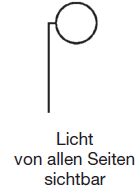
|
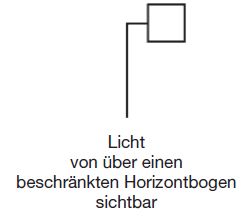
|

|
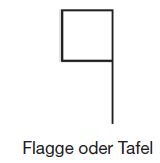
|
 |
 |
 |
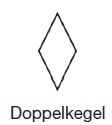 |
| |
| A light that is actually removed from the eyes of the shaker is provided with a point in the middle. Images with a black background contain the lights at night. |
-
| Night Name |
Image |
Tag Name |
-
| |
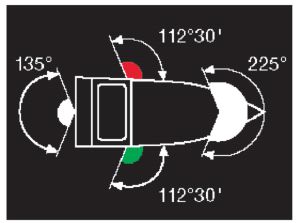
|
1 |
|
| § 3.01 |
Definitions and applications
Number 1: The horizontal arc above which the topplight, the side lights and the rear light are visible.
|
| |
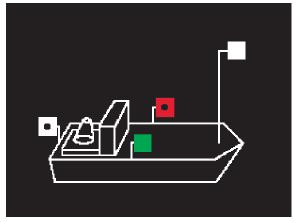
|
2 |
|
| § 3.08 |
Individual moving vehicle with machine drive
Number 1: Length up to 110,00 m
|
| |
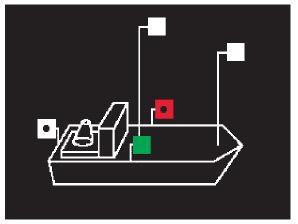
|
3 |
|
| § 3.08 |
Individual moving vehicle with machine drive
Number 1 and 2: Length more than 110,00 m
|
| |
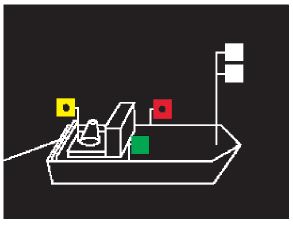
|
4 |
|
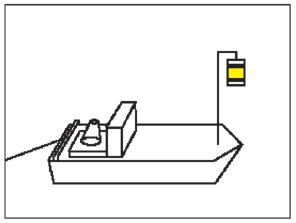
|
| § 3.09 |
Drag dressing
Number 1: Vehicle with machine drive, which travels alone at the top of an association
|
| |
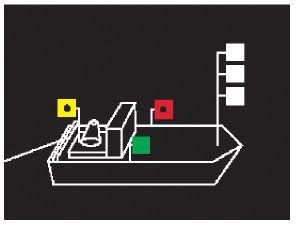
|
5/4 |
|
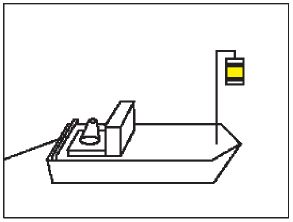
|
| § 3.09 |
Drag dressing
Number 2: Vehicles with machine drive, which travel to several side-by-side at the top of the association
|
| |
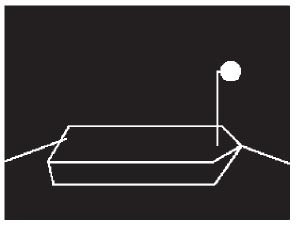
|
6 |
|
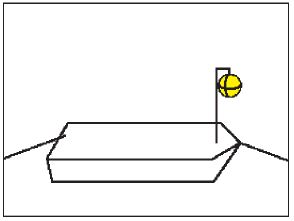
|
| § 3.09 |
Drag
Number 3, sentence 1: Sexual Vehicle
|
| |
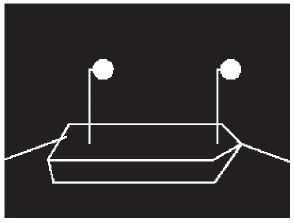
|
7 |
|
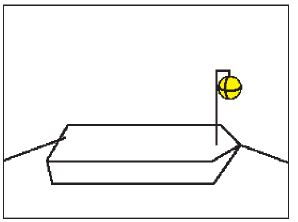
|
| § 3.09 |
Drag
Point 3, sentence 3, point (a): Attachment length of the association over 110,00 m
|
| |
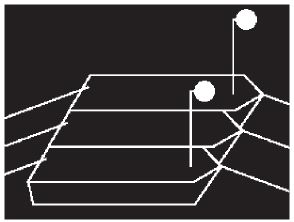
|
8 |
|
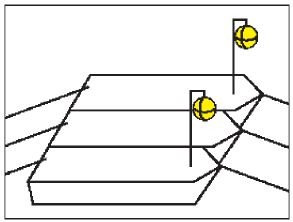
|
| § 3.09 |
Drag
Point 3, third sentence, point (b): Annex length of the association with more than two vehicles connected on the side
|
| |
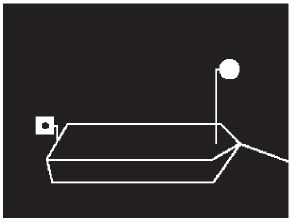
|
9 |
|
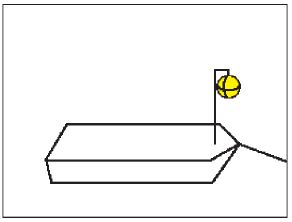
|
| § 3.09 |
Drag
Number 3 and 4: The vehicle as the last attachment length of a towing association
|
| |
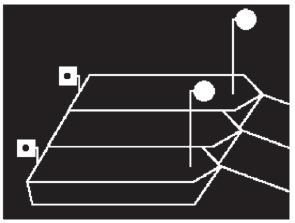
|
10 |
|
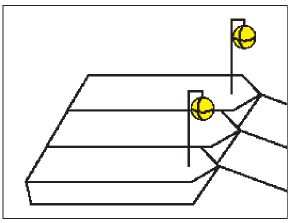
|
| § 3.09 |
Drag
Number 3 and 4: Several vehicles as the last attachment length of a towing association
|
| |
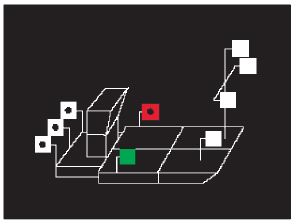
|
11 |
|
|
| § 3.10 |
Thrust Association
Number 1: Drawers
|
| |
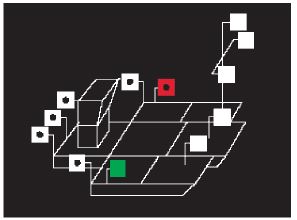
|
12 |
|
|
| § 3.10 |
Thrust Association
Point 1 (c): In addition to the sliding vehicle, more than two vehicles visible from the rear in whole width
|
| |
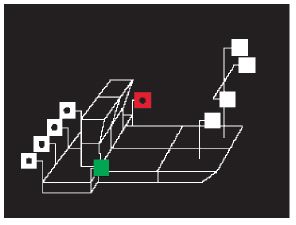
|
13 |
|
|
| § 3.10 |
Thrust Association
Number 2: Two pushing vehicles
|
| |
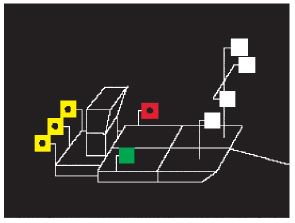
|
14 |
|
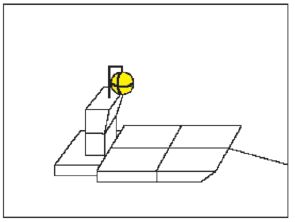
|
| § 3.10 |
Thrust Association
Number 3 and 4: Sexy thrust dressing
|
| |
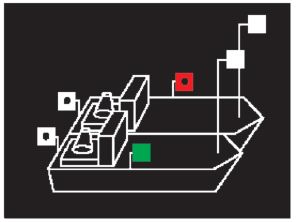
|
15 |
|
|
| § 3.11 |
Coupled vehicles
Number 1: Two vehicles with machine drive
|
| |
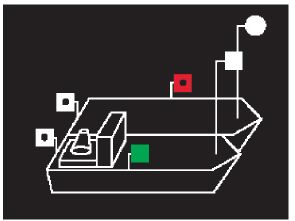
|
16 |
|
|
| § 3.11 |
Coupled vehicles
Number 1: A vehicle with a machine drive and a vehicle without a machine drive
|
| |
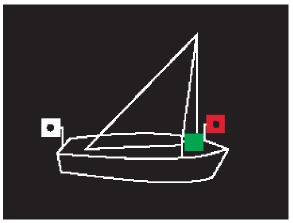
|
17 |
|
|
| § 3.12 |
Vehicle under sail
|
| |
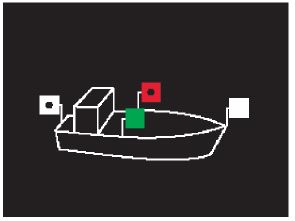
|
18 |
|
|
| § 3.13 |
Small vehicle
Point 1 (a), (b) and (c): Small vehicle with machine drive
|
| |
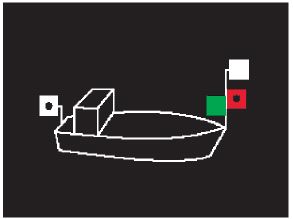
|
19 |
|
|
| § 3.13 |
Small vehicle
Point 1 (d), (e) and (f): small vehicle with machine drive with side lights directly adjacent to each other or in a single lantern
|
| |
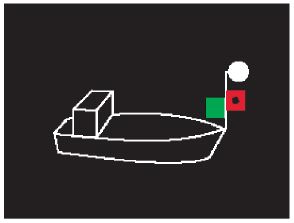
|
20 |
|
|
| § 3.13 |
Small vehicle
Point 1 (f): a small vehicle with a machine drive with a visible light from all sides
|
| |
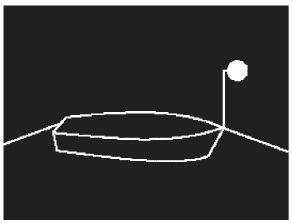
|
21 |
|
|
| § 3.13 |
Small vehicle
Number 3: Sexy or longitudinally coupled
|
| |
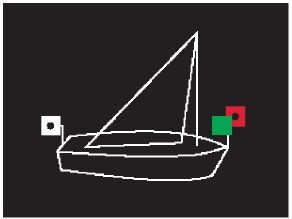
|
22 |
|
|
| § 3.13 |
Small vehicle
Number 4: sailing under sail
|
| |
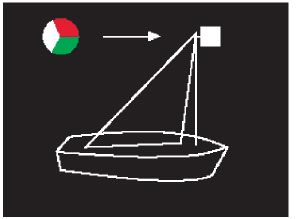
|
23 |
|
|
| § 3.13 |
Small vehicle
Number 4: Under sail with a single lantern on the topp
|
| |
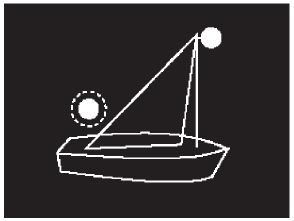
|
24 |
|
|
| § 3.13 |
Small vehicle
Number 4: Under sail, with a light visible from all sides, and showing a second light when approaching another vehicle
|
| |
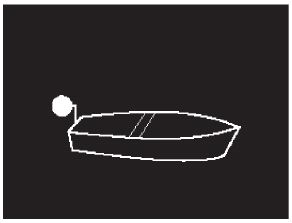
|
25 |
|
|
| § 3.13 |
Small vehicle
Number 5: Single use neither with drive machine nor under sail
|
| |
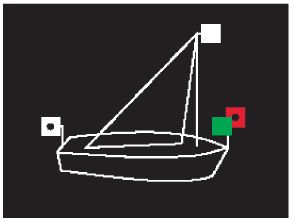
|
26 |
|
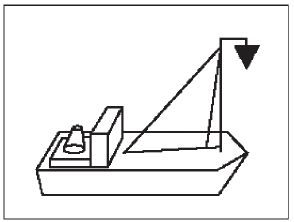
|
| § 3.13 |
Small vehicle
Number 1 and 6: sailing under sail and simultaneously with a driving machine
|
| |
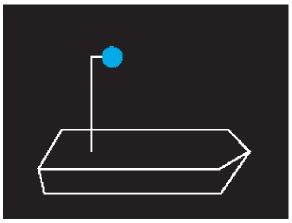
|
27a |
|
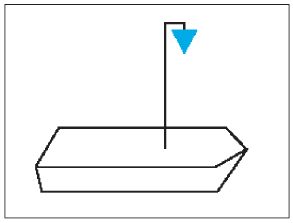
|
| |
|
27b |
|
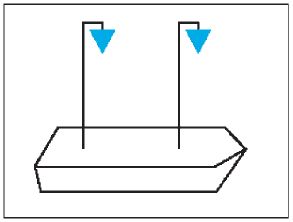
|
| § 3.14 |
Vehicle for the transport of certain dangerous goods
Number 1: Certain flammable substances according to Chapter 3.2 Table A ADN
|
| |
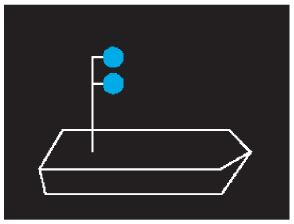
|
28 |
|
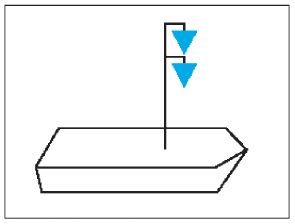
|
| |
|
28b |
|
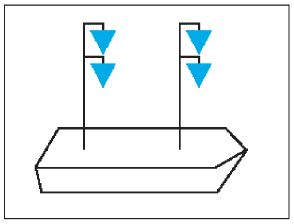
|
| § 3.14 |
Vehicle for the transport of certain dangerous goods
Number 2: Certain substances harmful to health according to Chapter 3.2 Table A ADN
|
| |
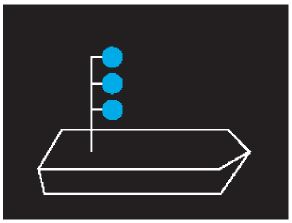
|
29a |
|
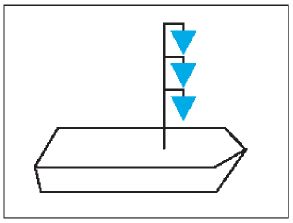
|
| |
|
29b |
|
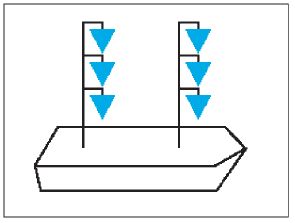
|
| § 3.14 |
Vehicle for the transport of certain dangerous goods
Number 3: Certain explosive substances under Chapter 3.2 Table A ADN
|
| |
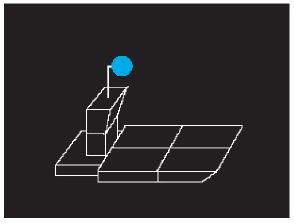
|
30 |
|
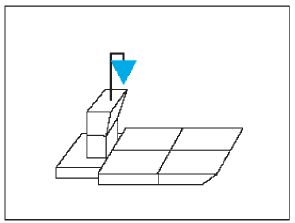
|
| § 3.14 |
Vehicle for the transport of certain dangerous goods
Number 4: Drawers
|
| |
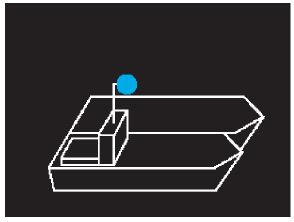
|
31 |
|
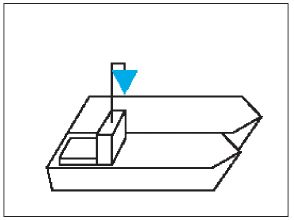
|
| § 3.14 |
Vehicles for the transport of certain dangerous goods
Number 4: Coupled vehicles
|
| |
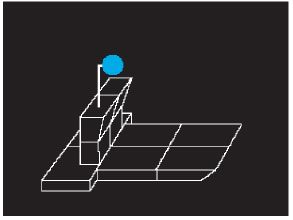
|
32 |
|
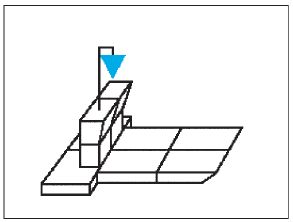
|
| § 3.14 |
Vehicles for the transport of certain dangerous goods
Number 5: Drawers ' Federation with Two Pushing Vehicles
|
| |
|
33 |
|
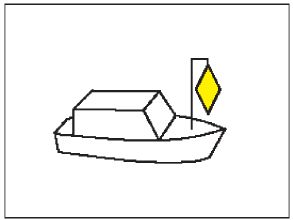
|
| § 3.15 |
Vehicle registered for the carriage of more than 12 passengers and the length of which shall be less than
20.00 m
|
| |
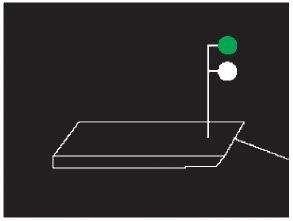
|
34 |
|
|
| § 3.16 |
Ferry
Number 1: Non-free ferry
|
| |
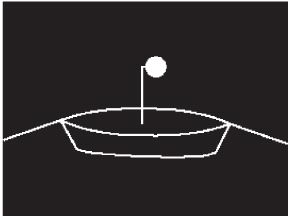
|
35 |
|
|
| § 3.16 |
Ferry
Number 2: Top Buchtnachen or Döpper at a yaw tube on the longitudinal cable
|
| |
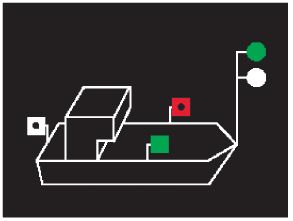
|
36 |
|
|
| § 3.16 |
Ferry
Number 3: Frei-travelling Ferry
|
| |
|
37 |
|
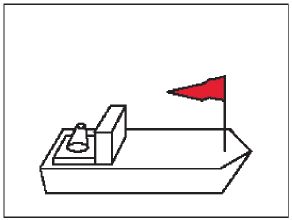
|
| § 3.17 |
Vehicle which has priority
|
| |
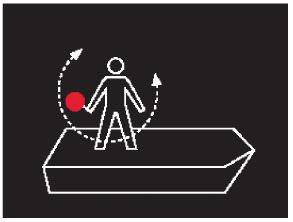
|
38 |
|
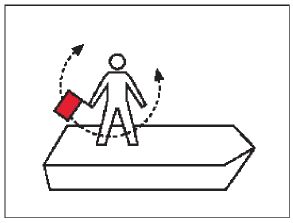
|
| § 3.18 |
Maneuverable vehicle
|
| |
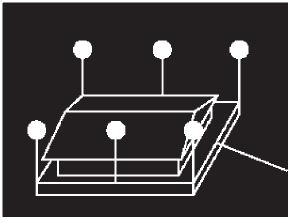
|
39 |
|
|
| § 3.19 |
Floating body and floating installation
|
| |
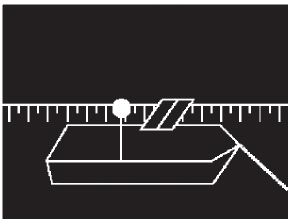
|
40 |
|
|
| § 3.20 |
Vehicle during standstill
Number 1: Vehicle with the exception of a small vehicle, a ferry and a floating device at work
|
| |
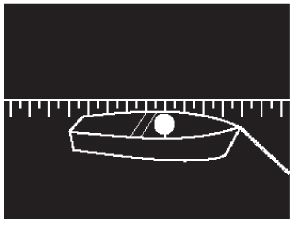
|
41 |
|
|
| § 3.20 |
Vehicle during standstill
Number 2: Small vehicle with the exception of the seatboat
|
| |
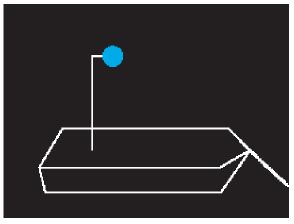
|
42 |
|
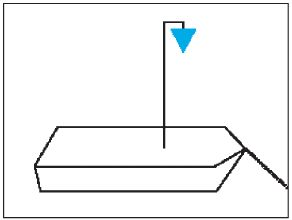
|
| § 3.21 |
Stationary vehicle in the case of transport of certain dangerous goods
|
| |
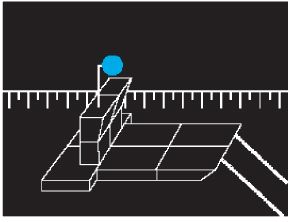
|
43 |
|
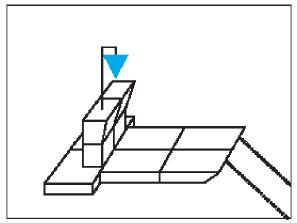
|
| § 3.21 |
Stationary vehicle in the case of transport of certain dangerous goods: Pusher
|
| |
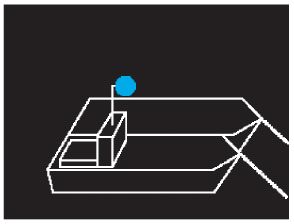
|
44 |
|
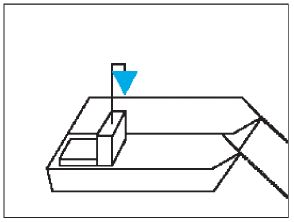
|
| § 3.21 |
Stationary vehicles for the transport of certain dangerous goods: Coupled Vehicles
|
| |
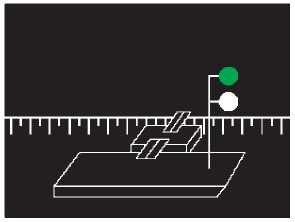
|
45 |
|
|
| § 3.22 |
Ferry, which is still at its landing
Number 1: Non-free ferry
|
| |
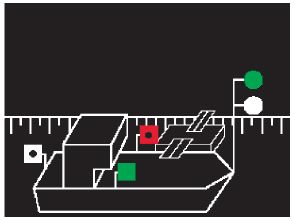
|
46 |
|
|
| § 3.22 |
Ferry, which is still at its landing
Number 2: Ferry Ferry
|
| |
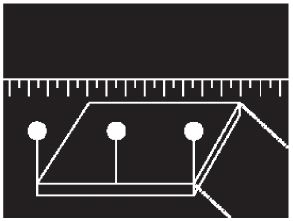
|
47 |
|
|
| § 3.23 |
Floating body and floating installation
|
| |
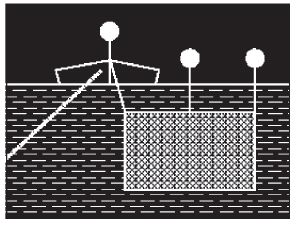
|
48 |
|

|
| § 3.24 |
Fishing vessel with net or boom
|
| |
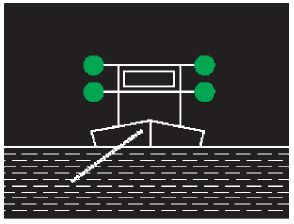
|
49a |
|
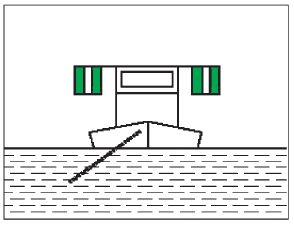
|
| |
|
49b |
|
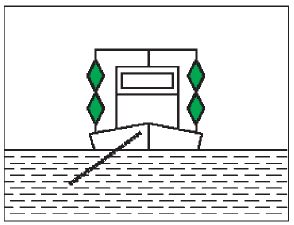
|
| § 3.25 |
Floating device at work, as well as fixed or sunken vehicle
Point 1 (a): Free passage on both sides
|
| |
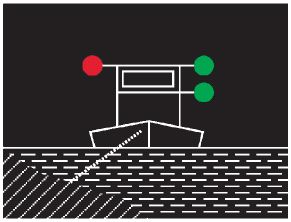
|
50a |
|
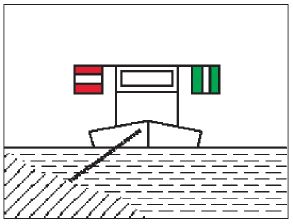
|
| |
|
50b |
|
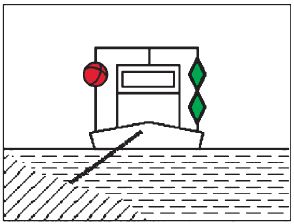
|
| § 3.25 |
Floating device at work, as well as fixed or sunken vehicle
Point 1 (a) and (b): free passage on one side
|
| |
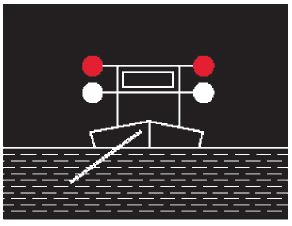
|
51 |
|
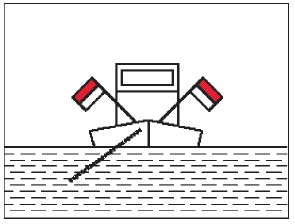
|
| § 3.25 |
Floating device at work, as well as fixed or sunken vehicle
Point 1 (c): Protection against waving; pass free on both sides
|
| |
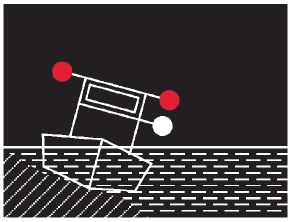
|
52 |
|
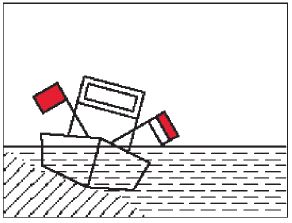
|
| § 3.25 |
Floating device at work, as well as fixed or sunken vehicle
Number 2: fixed or sunken vehicle; free travel on one side
|
| |
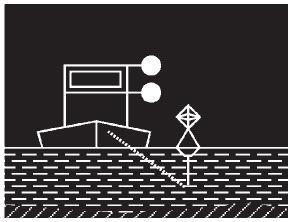
|
53 |
|
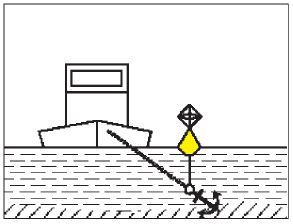
|
| § 3.26 |
A vehicle, a floating body and a floating facility, the anchor of which may endanger shipping
Number 1 and 3: Vehicle and Anchor
|
| |
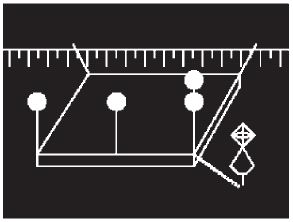
|
54 |
|
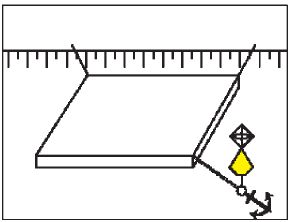
|
| § 3.26 |
A vehicle, a floating body and a floating facility, the anchor of which may endanger shipping
Number 2 and 3: floating body, floating facility and its anchor or anchor
|
| |
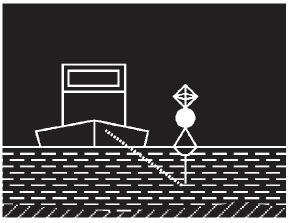
|
55 |
|
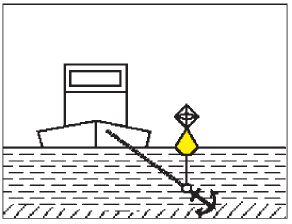
|
| § 3.26 |
A vehicle, a floating body and a floating facility, the anchor of which may endanger shipping
Number 4: Anchor of a floating device
|
| |
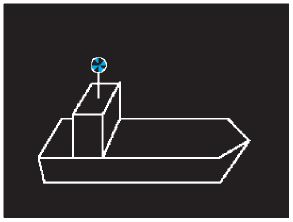
|
56 |
|
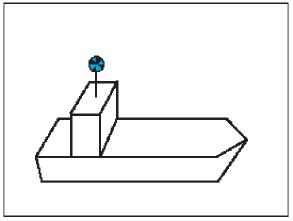
|
| § 3.27 |
Vehicle of the surveillance authorities
|
| |

|
57 |
|
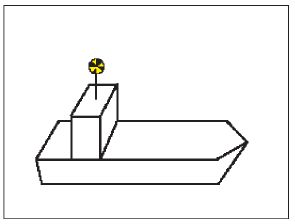
|
| § 3.28 |
The vehicle carrying out work on the waterway
|
| § 3.28a |
Multi-purpose vehicle of the Bundeswehr
|
| |
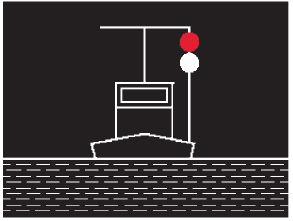
|
58 |
|
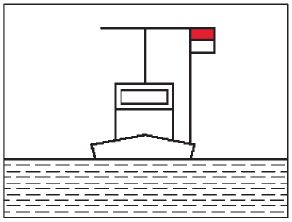
|
| § 3.29 |
Protection against sog and wave impact
|
| |
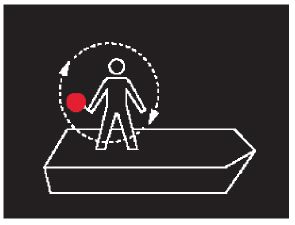
|
59 |
|
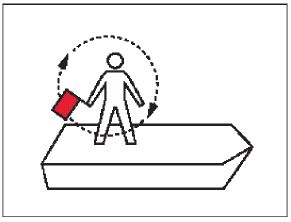
|
| § 3.30 |
NotCharacter
|
| |
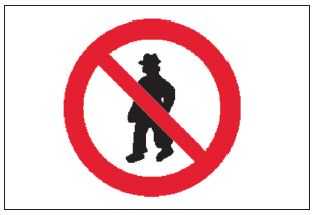
|
60 |
|
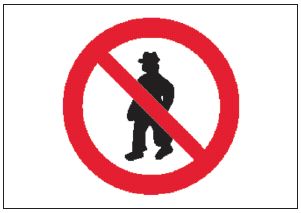
|
| § 3.31 |
Sentence 1 (a) Prohibition to enter the vehicle
|
| |
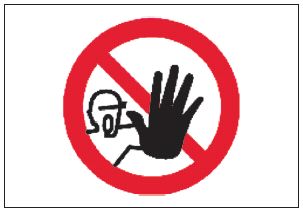
|
60a |
|
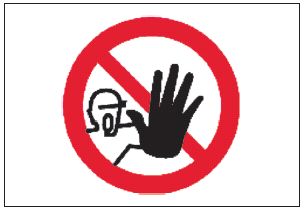
|
| § 3.31 |
Sentence 1 (b) Prohibition to enter the vehicle
|
| |
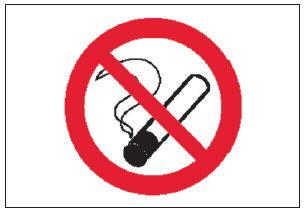
|
61 |
|
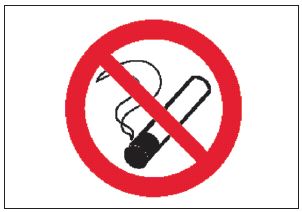
|
| § 3.32 |
Sentence 1 (a) prohibiting, smoking, using unprotected light or fire
|
| |
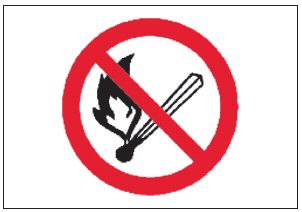
|
61a |
|
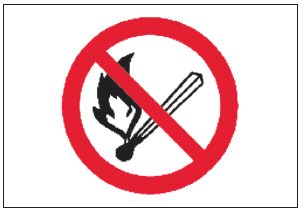
|
| § 3.32 |
Sentence 1 (b) Prohibition, smoking, use of unprotected light or fire
|
| |
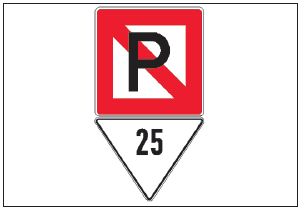
|
62 |
|
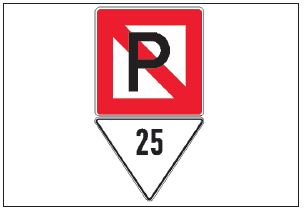
|
| § 3.33 |
Ban on breast-feeding side by side
|
| |
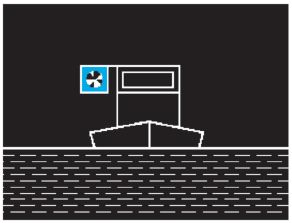
|
63 |
|
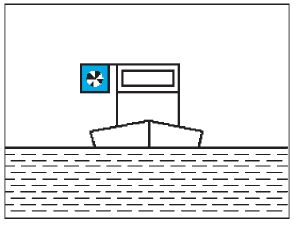
|
| § 6.04 |
Encounter
Number 3: encounter on the starboard side
|
| |
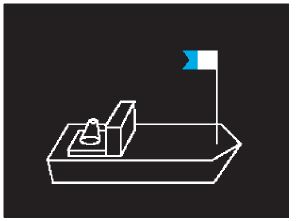
|
64 |
|
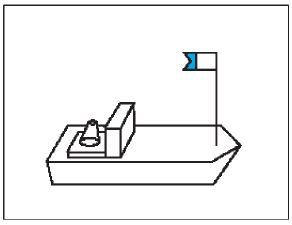
|
| § 8.12 |
Name when used by divers
|
§ § 21.21, 22.21, 23.21, 24.21 designation of a sports vehicle when using divers
|
Unofficial table of contents
Appendix 4
(no content)
Unofficial table of contents
Appendix 5
(no content)
Unofficial table of contents
Appendix 6 Sound signs
(Fundstelle: BGBl. I 2012, investment volume to No. 1, pp. 233-235)
Preliminary note:
The sound signs, with the exception of the bell-blows, consist in the delivery of a tone or several tones in succession, with the following characteristics:
-short sound: a tone of about one second duration;
-Long sound: a tone of about four seconds duration.
The pause between two consecutive tones is about one second.
However, the sign "sequence of very short tones" consists of a sequence of at least six tones each of about a quarter-second duration, with the pause between the tones being as long as it is.
A group of bell-blows must take about four seconds. It can be replaced by blows of metal on metal of the same duration.
-
A.
-
Common characters
-
| ▬ |
|
1 Long Sound |
"Attention" |
| |
|
|
|
| ■ |
|
1 short sound |
"I do my course for starboard" |
| |
|
|
|
| ■ ■ |
|
2 short notes |
"I judge my course to backbord" |
| |
|
|
|
| ■ ■ ■ |
|
3 short notes |
"My machine goes backwards" |
| |
|
|
|
| ■ ■ ■ ■ |
|
4 short notes |
"I am maneuverable" |
| |
|
|
|
| ▪▪▪▪▪▪▪▪▪Hand side of the wall |
|
Sequence of very short notes |
"Danger of a collision" |
| |
|
|
|
| ▬ ▬ Hand side of the wall |
|
Repeated long tones |
"Emergency signal" |
Section 4.04 (1) |
| |
|
|
|
 |
|
Group of Glockenstrikes |
"Emergency signal" |
Section 4.04 (1) |
| |
|
|
|
| ▪ ▬ ▪ ▬ |
|
At least 15 minutes
long uninterrupted
Repeats-
blessed a short and
of a long tone in
Connect to the
Light character after
Section 4.01, point 2 |
"Bleib-Weg-Signal" |
Section 8.09, point 2
in conjunction with point 1 |
-
B.
-
Encounters sign
-
| Passing by Backbord requires |
|
|
| |
|
|
|
|
| Normal case: |
■ |
|
1 short sound |
"I want to go past backbord" |
| |
|
|
of the mountain driver |
|
Section 6.04 (4) (a) |
| |
|
|
|
|
| |
■ |
|
1 short sound |
"Agree, drive past backbord" |
| |
|
|
of the valley driver |
|
Section 6.04, point 5 |
| |
|
|
|
|
|
| Deviation: |
■ ■ |
|
2 short notes |
"Don't agree, drive past tax board" |
| |
|
|
of the valley driver |
|
Section 6.05 (2) (b) |
| |
|
|
|
|
|
| |
■ ■ |
|
2 short notes |
"Agree, I'm going to pass on starboard" |
| |
|
|
of the mountain driver |
|
Section 6.05 (3) (b) |
| |
|
|
|
|
|
| Passing by tax board requires |
|
|
| |
|
|
|
|
| Normal case: |
■ ■ |
|
2 short notes |
'I want to drive past starboard' |
| |
|
|
of the mountain driver |
|
Section 6.04 (4) (b) |
| |
|
|
|
|
| |
■ ■ |
|
2 short notes |
"Agree, drive past tax board" |
| |
|
|
of the valley driver |
|
Section 6.04, point 5 |
| |
|
|
|
|
|
| Deviation: |
■ |
|
1 short sound |
"Don't agree, drive past backbord" |
| |
|
|
of the valley driver |
|
Section 6.05 (2) (a) |
| |
|
|
|
|
| |
■ |
|
1 short sound |
"Agree, I'm going to go past backbord" |
| |
|
|
of the mountain driver |
|
Section 6.05 (3) (a) |
-
C.
-
Overtaking characters
-
| Overhauled to the backbord of the front-end driver required |
|
|
| |
|
|
|
|
| |
▬ ▬ ▪▪ |
|
2 long tones, |
"I want to overtake on your back-bord side" |
| |
|
|
2 short notes |
|
Section 6.10 (2) (a) |
| |
|
|
of the overtaking |
|
|
| |
|
|
|
|
|
| |
|
|
|
|
| Normal case: |
|
|
No character |
"Agree, you can overtake on my back-board page" |
| |
|
|
of the preceding |
|
Section 6.10 (3) |
| |
|
|
|
|
|
| Deviation: |
■ ■ |
|
2 short notes |
"Don't agree, overtake you on my starboard page" |
| |
|
|
of the preceding |
|
Section 6.10 (4), first sentence, point (b) |
| |
|
|
|
|
|
| |
■ |
|
1 short sound |
"Agree, I'm going to overtake on your starboard page" |
| |
|
|
of the overtaking |
|
Section 6.10 (4), second sentence, point (b) |
| |
|
|
| Overhauled to the starboard of the forecasting |
|
|
| |
|
|
|
|
| |
▬ ▬ ▪ |
|
2 long tones, |
"I want to overtake on your starboard page" |
| |
|
|
1 short sound |
|
Section 6.10 (2) (b) |
| |
|
|
of the overtaking |
|
|
| |
|
|
|
|
|
| |
|
|
|
|
| Normal case: |
|
|
No sound character |
"Agree, you can overtake on my tax board page" |
| |
|
|
of the preceding |
|
Section 6.10 (3) |
| |
|
|
|
|
|
| Deviation: |
■ |
|
1 short sound |
"Don't agree, overtake on my back-board page" |
| |
|
|
of the preceding |
|
Section 6.10 (4), first sentence, point (a) |
| |
|
|
|
|
| |
■ ■ |
|
2 short notes |
"Agree, I'm going to overtake on your back-board page" |
| |
|
|
of the overtaking |
|
Section 6.10 (4), second sentence, point (b) |
| |
|
|
|
|
| Impossibility of overtaking |
|
|
| |
|
|
|
|
| |
■ ■ ■ ■ ■ |
|
5 short notes |
"You can't overtake me" |
| |
|
|
of the preceding |
|
Section 6.10 (5) |
-
D.
-
Watermark
-
| |
▬ ▪ |
|
1 long sound, |
"I turn over Tax Bord" |
| |
|
|
1 short sound |
|
Section 6.13 (2) (a),
Section 6.16 (2) (c)
Double letter aa |
| |
|
|
|
|
|
| |
|
|
|
|
| |
▬ ▪▪ |
|
1 long sound, |
"I turn over backbord" |
| |
|
|
2 short notes |
|
Section 6.13 (2) (b),
Section 6.16 (2) (c)
Double letter bb |
| |
|
|
|
|
|
| |
|
|
|
|
|
-
E.
-
Signs at the entrance to and exit from ports and side waterways
-
| |
▬ ▬ ▬ ▪ |
|
3 long tones, |
"I want to set my course for starboard." |
| |
|
|
1 short sound |
|
Section 6.16 (2), first sentence, point (a) |
| |
|
|
|
|
|
| |
|
|
|
|
| |
▬ ▬ ▬ ▪▪ |
|
3 long tones, |
"I want to set my course to backbord." |
| |
|
|
2 short notes |
|
Section 6.16 (2), first sentence, point (b) |
| |
|
|
|
|
|
| |
|
|
|
|
|
| |
▬ ▬ ▬ |
|
3 long tones |
"I want to cross" |
| |
|
|
|
|
Section 6.16 (2), first sentence, point (c) |
-
F.
-
(no content)
-
G.
-
Signs in unsatiable weather
-
| (a) individual driving vehicle and bandage which does not use radar |
|
| |
|
|
|
|
|
| |
▬ |
|
1 long sound,
no more than every minute
repeated |
|
Section 6.33 (2), first sentence,
Section 6.34, point 3, also in
Connection with Number 8
Sentence 1 |
| |
|
|
|
|
|
| b) (no content) |
|
| |
|
|
|
|
| (c) vehicle in the radar journey, if there is no talk radio contact |
|
| |
|
|
|
|
|
| |
▬ |
|
1 long sound,
repeated |
|
Section 6.32 (2) (d)
Double letter aa |
| |
|
|
|
|
|
| (d) Still-lying vehicle |
|
| |
|
|
|
|
|
| |
 |
|
1 group of bell-blows,
Repeat at the most every minute |
|
Section 6.31, point 2, also in
Connection with Number 3
Set 2 |
Unofficial table of contents
Appendix 7 Shipping signs
(Fundstelle: BGBl. I 2012, investment volume on No. 1, pp. 236-255)
Preliminary note:
-
1.
-
The signs in Section I may be supplemented or explained, as indicated in Section II.
-
2.
-
In order to be better recognizable, a panel can be enclosed with a narrow white strip.
-
3.
-
The end of a ban, a bid, or a restriction is indicated by the E.11 sign.
Section I-Main character
| A. |
Forbidden sign |
|
| |
|
|
| A.1 |
Prohibition of passage and closure of navigation
-general prohibitions-
(Section 3.25, point 1, first sentence, point (b), bb, triple letter, aaa, § 6.08, point 2, first sentence, point (a), 6.16 (4), 6.22 (1), 6.22a (2), 6.25 (1), 6.27 (1), and 6.28a (4). |
|
| |
|
|
| |
either panel |
|
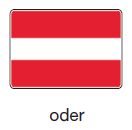
|
| |
or red lights |

|
| |
or red flags |
 |
| |
|
|
| |
If two lights or two flags are shown on top of each other, this means a long-lasting ban. |
|
| |
|
|
| |
|
|
| A.1a |
Blocked water surfaces; however, can be used for a small vehicle without a drive machine.
(Section 6.22 (2)) |
|
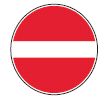 |
| |
|
|
| |
|
|
| A.2 |
Ban on overtaking, general
(Section 6.11 (1)) |
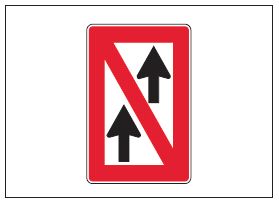 |
| |
|
|
| |
|
|
| A.3 |
Prohibition of overtaking for associations between themselves and between an association and coupled vehicles. Sentence 1 shall not apply if one of the associations is a thrust body, the length of which shall not exceed 110,00 m and the width of which shall not exceed 12,00 m.
(Section 6.11 (2)) |
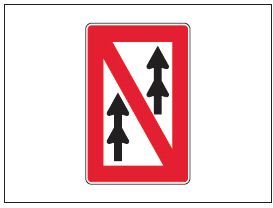 |
| |
|
|
| |
|
|
| A.4 |
Ban on meeting and overtaking
(Section 6.08, point 1, sentence 1) |
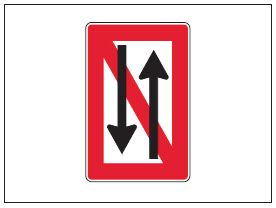 |
| |
|
|
| |
|
|
| A.5 |
Prohibition of breast-feeding on the side of the waterway on which the tabular symbol stands
(Section 7.02 (1) (c)) |
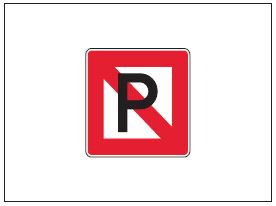 |
| |
|
|
| |
|
|
| A.5.1 |
Prohibition of breast-feeding on the water surface, the width of which, as measured by the place of installation, is indicated on the table symbol in metres
(Section 7.02 (1) (k)) |
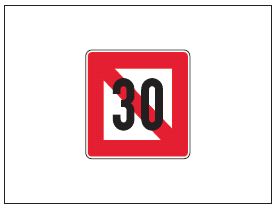 |
| |
|
|
| |
|
|
| A.6 |
Prohibition of anchorage and prohibition of looping of anchors, rungs or chains on the side of the waterway on which the tabular symbol stands
(Section 6.18, point 2, sentence 2 and 7.03 (1) (b)) |
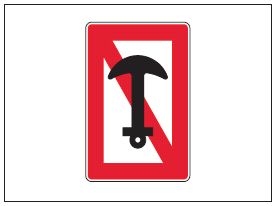 |
| |
|
|
| |
|
|
| A.7 |
Festmacheverbot on the shore on the side of the waterway on which the table sign stands
(Section 7.04 (1) (b)) |
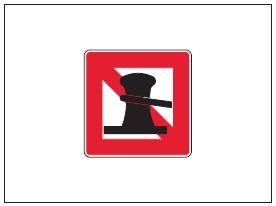 |
| |
|
|
| |
|
|
| A.8 |
Ban on turning
(Section 6.13, point 4, sentence 1) |
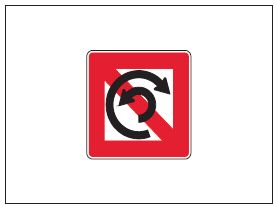 |
| |
|
|
| |
|
|
| A.9 |
Avoidance of wave impact or sogeffects
(Section 6.20, point 1, second sentence, point (e)) |
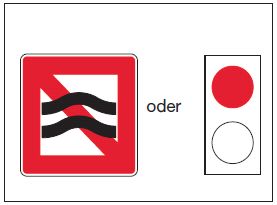 |
| |
|
|
| |
|
|
| A.10 |
Prohibited to drive outside the displayed boundary
(Section 6.24 (2) (a)) |
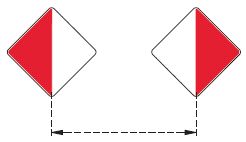 |
| |
|
|
| |
|
|
| A.11 |
Ban on entry, but preparations to continue the journey are to be made
(Section 6.28a, point 2, sentence 1, point (c)) |
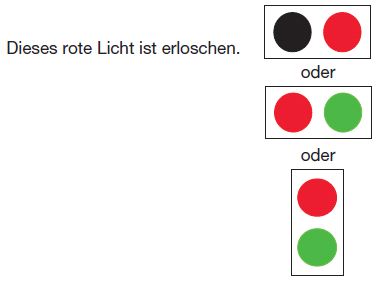 |
| |
|
|
| |
|
|
| A.12 |
Driving ban for a vehicle with machine drive |
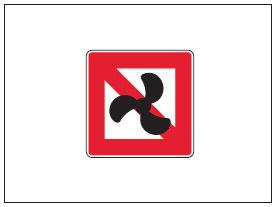 |
| |
|
|
| |
|
|
| A.13 |
Driving ban for a sports boat |
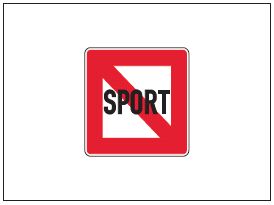 |
| |
|
|
| |
|
|
| A.14 |
Ban on water skiing |
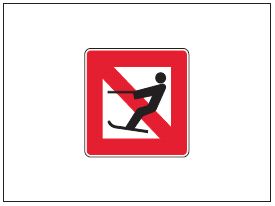 |
| |
|
|
| |
|
|
| A.15 |
Driving ban for a sailing vehicle |
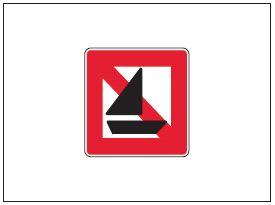 |
| |
|
|
| |
|
|
| A.16 |
Driving ban for a vehicle that does not drive with machine drive or under sail |
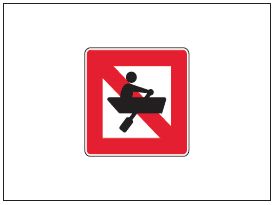 |
| |
|
|
| |
|
|
| A.17 |
Ban on sailing surfing |
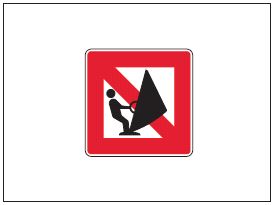 |
| |
|
|
| |
|
|
| A.18 |
Driving ban on a water motorcycle (Waterscooter, Jetski, etc.) |
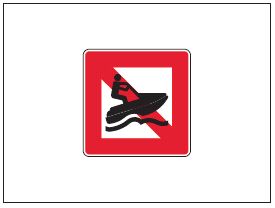 |
| |
|
|
| |
|
|
| A.19 |
(no content) |
|
| |
|
|
| |
|
|
| A.20 |
Bade and swimming ban
(Section 8.10 (1) (d)) |
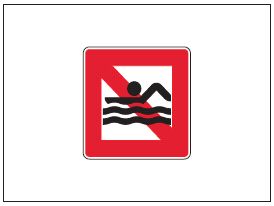 |
| |
|
|
| |
|
|
| B. |
Bid Sign |
|
| |
|
|
| B.1 |
Bid to hit the direction indicated by the arrow
(§ 6.12) |
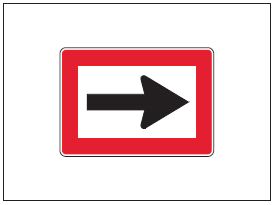 |
| |
|
|
| |
|
|
| B.2 |
a) |
Offer to go over to the side of the road that is on the back of the vehicle
(§ 6.12) |
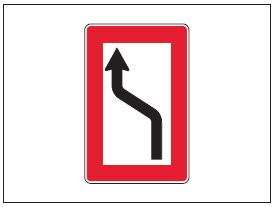 |
| |
|
|
| |
b) |
Bid to move over to the waterside of the vehicle on the starboard side of the vehicle
(§ 6.12) |
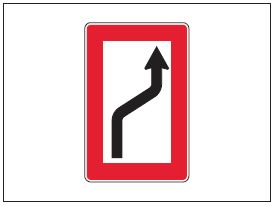 |
| |
|
|
| |
|
|
| B.3 |
a) |
Offer to keep the running water side, which is on the back-board side of the vehicle
(§ 6.12) |
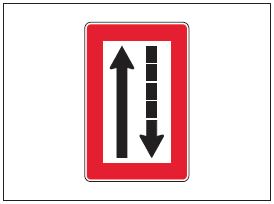 |
| |
|
|
| |
b) |
Bid to keep the running water side, which is on the starboard side of the vehicle
(§ 6.12) |
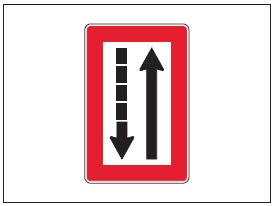 |
| |
|
|
| |
|
|
| B.4 |
a) |
Bid to cross the running water to Backbord
(§ 6.12) |
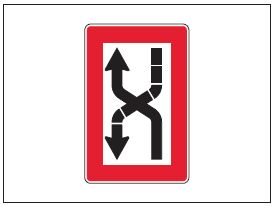 |
| |
|
|
| |
b) |
Bid to cross the drip to starboard
(§ 6.12) |
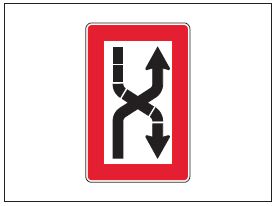 |
| |
|
|
| |
|
|
| B.5 |
Offer to stop under certain conditions
(Section 6.26, point 2, sentence 2, section 6.28, point 2, sentence 2 and section 6.29, point 2, sentence 1) |
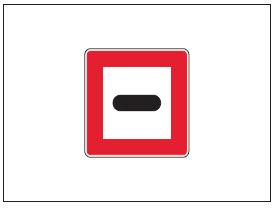 |
| |
|
|
| |
|
|
| B.6 |
Offer not to exceed the specified speed with respect to the shore (in km/h) |
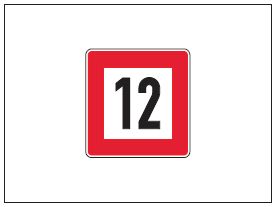 |
| |
|
|
| |
|
|
| B.7 |
Bid to give sound signs |
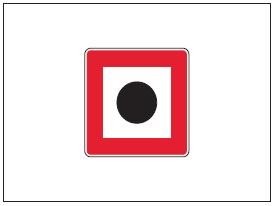 |
| |
|
|
| |
|
|
| B.8 |
Bid to exercise special caution
(Section 6.08, paragraph 2, sentence 2) |
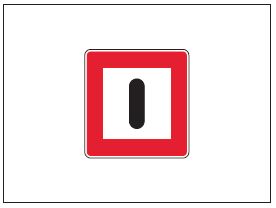 |
| |
|
|
| |
|
|
| B.9 |
a) |
Offer to enter the main waterway or cross it only if it does not force a vehicle on the main waterway to change its course or speed
(Section 6.16 (3)) |
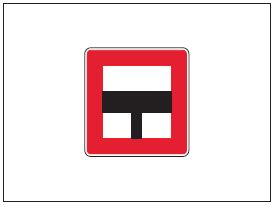 |
| |
|
|
| |
b) |
as before |
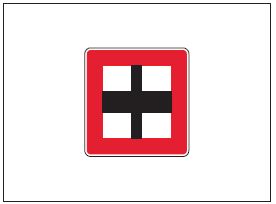 |
| |
|
|
| |
|
|
| B.10 |
Offer to take the measures referred to in Section 8.09 (3) to (5), in conjunction with point 6, in this "lead-way signal" given by the Land; the sound symbol shall consist of a continuous repetition of at least 15 minutes alternating between a short and a long tone, the light sign corresponds to that according to § 4.01 (2). |
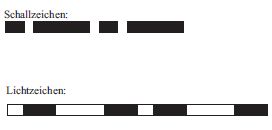 |
| |
|
|
| |
|
|
| B.11 |
a) |
Bid to use speaking radio
(Section 4.05 (4)) |
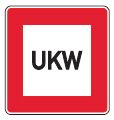 |
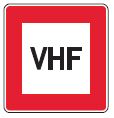 |
| |
|
|
| |
b) |
Offer to use voice radio on the specified channel
(Section 4.05 (4))
Example: Channel 11 |
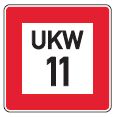 |
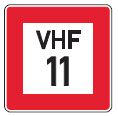 |
| |
|
|
| |
|
|
| C. |
Constraint characters |
|
| |
|
|
| C.1 |
The depth of the running water is limited. |
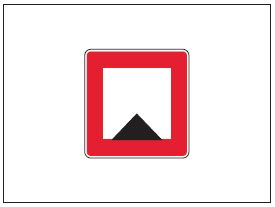 |
| |
|
|
| |
|
|
| C.2 |
The clear height above the water level is limited. |
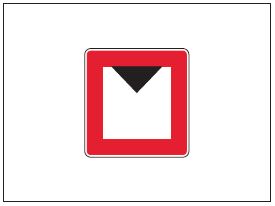 |
| |
|
|
| |
|
|
| C.3 |
The width of the passage opening or of the running water is
limited. |
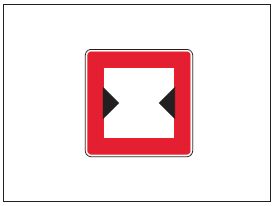 |
| |
|
|
| |
|
|
| C.4 |
There are shipping restrictions; they are indicated on an additional sign under the shipping sign. |
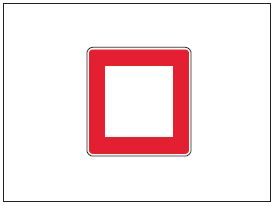 |
| |
|
|
| |
|
|
| C.5 |
The water is concentrated on the right (left) shore; the number on the sign indicates the distance in metres where a vehicle must be kept away from the table sign. |
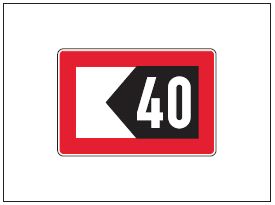 |
| |
|
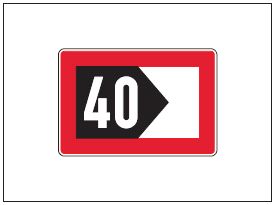 |
| |
|
|
| |
|
|
| D. |
Recommended characters |
|
| |
|
|
| D.1 |
Recommended pass-through opening |
|
| |
|
|
| |
a) |
for transport in both directions;
(Section 6.25, point 2, first sentence, point (a) and section 6.27 (2) sentence 2) |
 |
| |
|
|
| |
b) |
for traffic only in the direction in which the characters are visible
(in the other direction prohibited).
(Section 6.25, point 2, first sentence, point (b) and section 6.27 (2) sentence 2) |
 |
| |
|
 |
| |
|
|
| |
|
|
| D.2 |
Recommendation to stay in the room delimited by the panels
(Section 6.24 (2) (b)) |
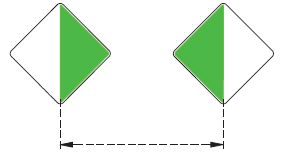 |
| |
|
|
| |
|
|
| D.3 |
recommendation to move in the direction of the arrow; |
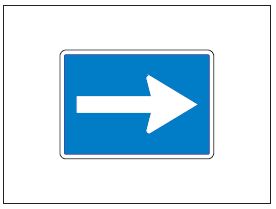 |
| |
|
|
| |
in the direction from the fixed signal light to the common-mode signal light. |
|
 |
| |
|
|
| |
|
|
| E. |
Cue characters |
|
| |
|
|
| E.1 |
Permission to pass through (general signs)
(Section 3.25, point 1, point (a), double letter bb, triple letter aaa, § 6.08 (2) sentence 1 (b), 6.27 (2) sentence 1 and section 6.28a (4)) |
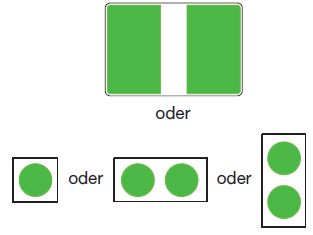 |
| |
|
|
| |
|
|
| E.2 |
Crossing of a high voltage line |
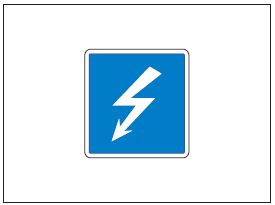 |
| |
|
|
| |
|
|
| E.3 |
Note on a weir |
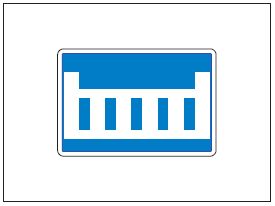 |
| |
|
|
| |
|
|
| E.4a |
Non-free-moving ferry |
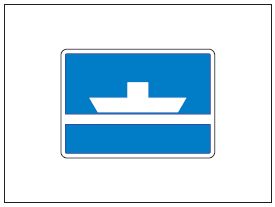 |
| |
|
|
| |
|
|
| E.4b |
Free Travelling Ferry |
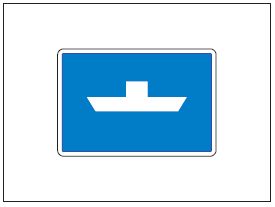 |
| |
|
|
| |
|
|
| E.5 |
Permission to lie down on the side of the waterway on which the sign stands
(Section 7.05 (1)) |
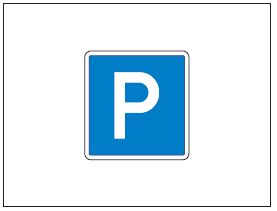 |
| |
|
|
| |
|
|
| E.5.1 |
Permission to depart on the water surface, the width of which, measured from the place of installation, is indicated on the table symbol in metres.
(Section 7.05 (2)) |
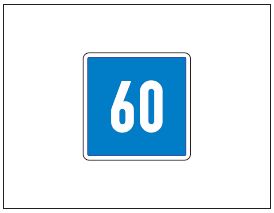 |
| |
|
|
| |
|
|
| E.5.2 |
Permission to depart on the surface of the water between the two distances, measured by the place of installation, on the table symbol in metres
(Section 7.05 (3)) |
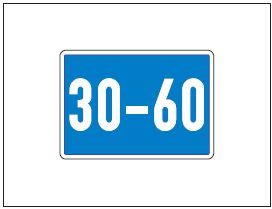 |
| |
|
|
| |
|
|
| E.5.3 |
The maximum number of vehicles on the side of the waterway on which the sign is standing may be set aside for a period of time
(Section 7.05 (4)) |
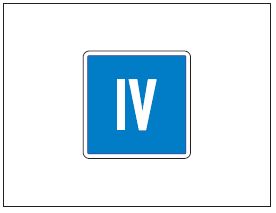 |
| |
|
|
| |
|
|
| E.5.4 |
Reclining station for a vehicle of a wheelbarn which does not have to be named according to § 3.14
(Section 7.06, point 1) |
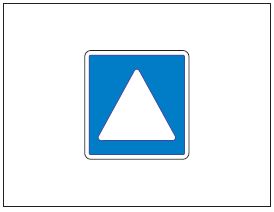 |
| |
|
|
| |
|
|
| E.5.5 |
Berth for a wheelbarn vehicle which must lead the name in accordance with section 3.14 (1)
(Section 7.06, point 1) |
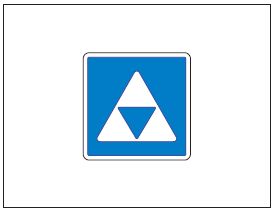 |
| |
|
|
| |
|
|
| E.5.6 |
Berth for a vehicle of the wheelbarge which must lead the name in accordance with section 3.14 (2)
(Section 7.06, point 1) |
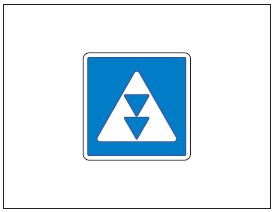 |
| |
|
|
| |
|
|
| E.5.7 |
Berth for a vehicle of the carriage ride, that the name must lead according to section 3.14 (3)
(Section 7.06, point 1) |
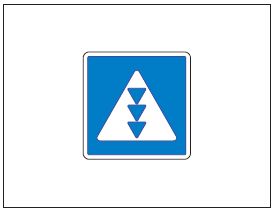 |
| |
|
|
| |
|
|
| E.5.8 |
Reclining location for a vehicle other than a vehicle of a wheelbarge that does not have to be named according to § 3.14
(Section 7.06, point 1) |
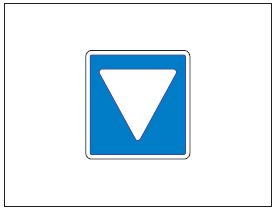 |
| |
|
|
| |
|
|
| E.5.9 |
The main waterway used meets a side waterway that opens from both sides.
(Section 6.16 (1), third sentence, and 4) |
-
a)
-
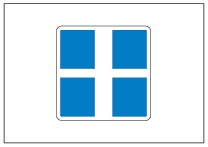
|
| |
|
|
|
|
|
|
| |
The main waterway used meets a side waterway that leads from starboard
(Section 6.16 (1), third sentence and (5)) |
-
b)
-
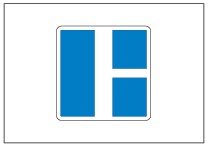
|
| |
|
|
|
|
|
|
| |
The main waterway, which is used, meets a side waterway that leads from the backboard
(Section 6.16 (1), third sentence and (6)) |
-
c)
-
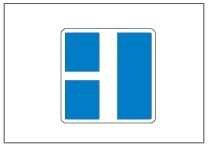
|
| |
|
|
| |
|
|
| E.5.10 |
Reclining location for a vehicle other than a vehicle of a wheelbarge which must lead the name in accordance with section 3.14 (2)
(Section 7.06, point 1) |
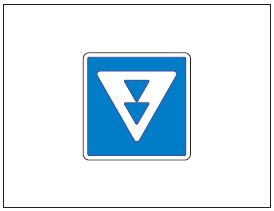 |
| |
|
|
| |
|
|
| E.5.11 |
Reclining location for a vehicle other than a wheelbarn vehicle, which must lead the name in accordance with section 3.14 (3)
(Section 7.06, point 1) |
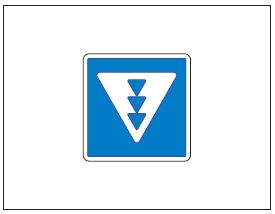 |
| |
|
|
| |
|
|
| E.5.12 |
Berth for a vehicle, which does not have to be named according to § 3.14
(Section 7.06, point 1) |
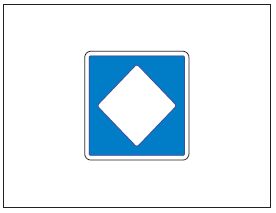 |
| |
|
|
| |
|
|
| E.5.13 |
Berth for a vehicle which must lead the name in accordance with section 3.14 (1)
(Section 7.06, point 1) |
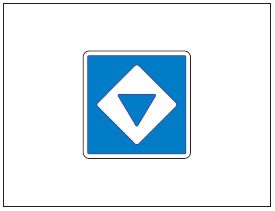 |
| |
|
|
| |
|
|
| E.5.14 |
Berth for a vehicle which must lead the name in accordance with section 3.14 (2)
(Section 7.06, point 1) |
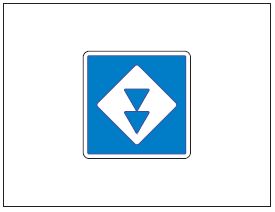 |
| |
|
|
| |
|
|
| E.5.15 |
Berth for a vehicle which must lead the name in accordance with section 3.14 (3)
(Section 7.06, point 1) |
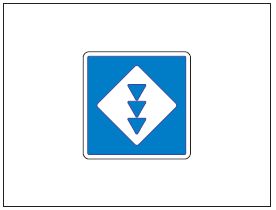 |
| |
|
|
| |
|
|
| E.6 |
Permission to anchor on the side of the waterway on which the table sign stands
(Section 7.03 (2)) |
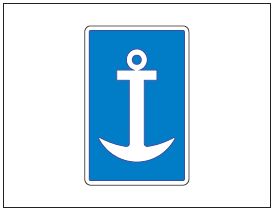 |
| |
|
|
| |
|
|
| E.7 |
Permission to mourn on the shore on the side of the waterway on which the table sign stands
(Section 7.04 (2)) |
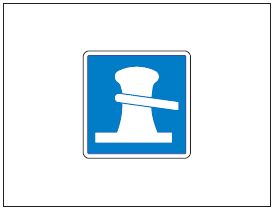 |
| |
|
|
| |
|
|
| E.7.1 |
Permission to make a mooring on the shore for the immediate loading or loading of a motor vehicle
(Section 7.04 (2)) |
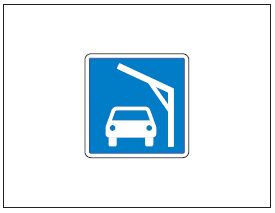 |
| |
|
|
| |
|
|
| E.8 |
Hint at a turning point
(Section 6.13, point 4, sentence 2 and paragraph 7.02, point 1, point (i)) |
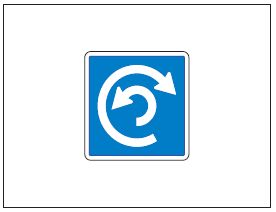 |
| |
|
|
| |
|
|
E.8
with
one
In addition,
The
right-
angular
white
Table |
Indication of a turning point for vehicles up to the length indicated on the additional board
(Section 6.13, point 4, sentence 3) |
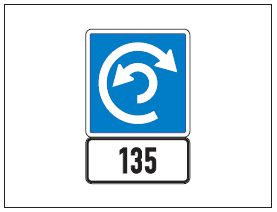 |
| |
|
|
| |
|
|
| E.9 |
The main waterway used meets a side waterway that opens from both sides.
(Section 6.16 (1), third sentence, and 4) |
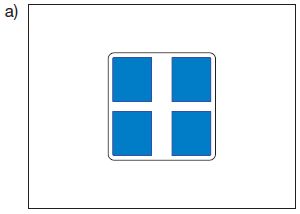 |
| |
|
|
| |
The main waterway used meets a side waterway that leads from starboard
(Section 6.16 (1), third sentence and (5)) |
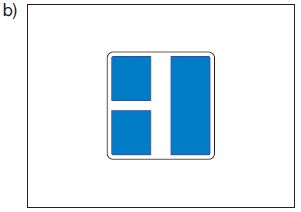 |
| |
|
|
| |
The main waterway, which is used, meets a side waterway that leads from the backboard
(Section 6.16 (1), third sentence and (6)) |
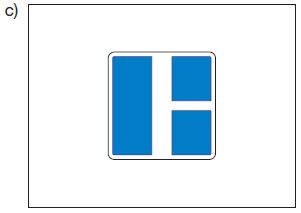 |
| |
|
|
| |
|
|
| E.10 |
The side waterway used meets a main waterway that opens from both sides
(Section 6.16, point 1, sentences 3 and 7) |
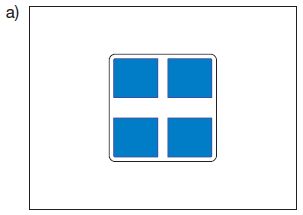 |
| |
|
|
| |
The used secondary waterway leads into a main waterway.
(Section 6.16 (1), third sentence and (8)) |
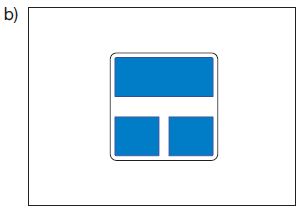 |
| |
|
|
| |
|
|
| E.11 |
End of a ban or bid that applies only in a traffic direction, or end of a restriction. |
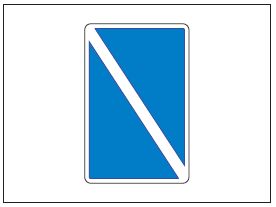 |
| |
|
|
| |
|
|
| E.12 |
without content |
|
| |
|
|
| |
|
|
| E.12a |
Indication of a moving vehicle
(Section 6.16, point 5, sentence 1) |
|
 |
| |
|
|
| |
|
|
| E.13 |
Drinking water tap |
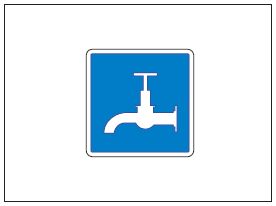 |
| |
|
|
| |
|
|
| E.14 |
Telephone Office |
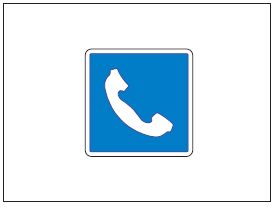 |
| |
|
|
| |
|
|
| E.15 |
Driving licence for a vehicle with a machine drive |
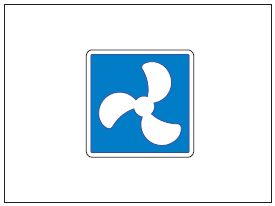 |
| |
|
|
| |
|
|
| E.16 |
Driving licence for a sports boat |
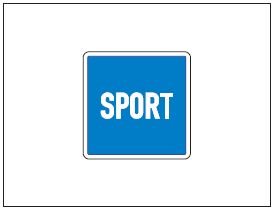 |
| |
|
|
| |
|
|
| E.17 |
Water skistreck |
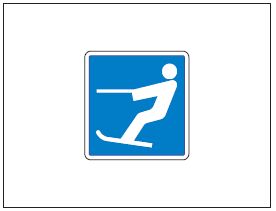 |
| |
|
|
| |
|
|
| E.18 |
Driving licence for a sailing vehicle |
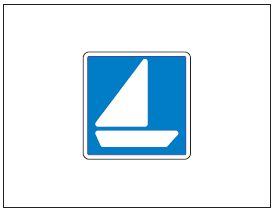 |
| |
|
|
| |
|
|
| E.19 |
Driving licence for a vehicle that does not drive either with machine drive or under sail |
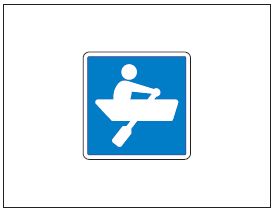 |
| |
|
|
| |
|
|
| E.20 |
Permission for sailing surfing |
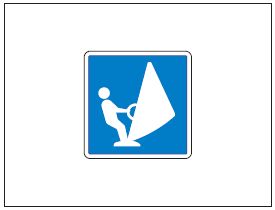 |
| |
|
|
| |
|
|
| E.21 |
Nautical Information Radio
Example: Channel 18 |
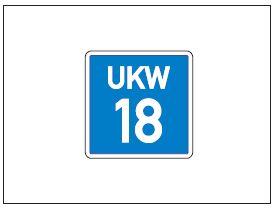 |
| |
|
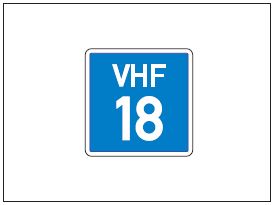 |
| |
|
|
| |
|
|
| E.22 |
Driving licence for a water motorbike
(Waterscooter, Jetski, etc.) |
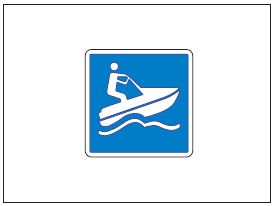 |
| |
|
|
| |
|
|
| E.23 |
Flood Marks |
 |
| |
|
|
| |
|
 |
| |
|
|
| |
The brands are placed in bright colour on a dark background or in a dark colour on a bright surface. |
| |
|
|
| |
|
|
| E.24 |
Permission for kitesurfing |
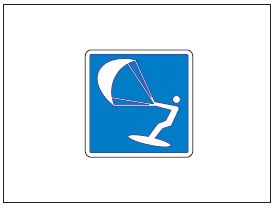 |
| |
|
|
| |
|
|
| E.25 |
Landstromanlock exists |
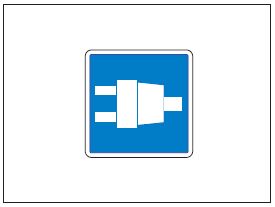 |
| |
|
|
| |
|
|
| E.26 |
Indication of an existing bathing and/or swimming ban |
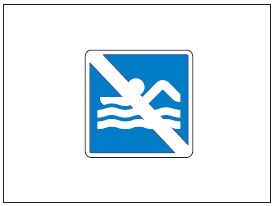 |
| |
|
|
| |
|
|
Section II
Additional signs, arrows, or inscriptions |
| |
|
|
| The main characters in Section I can be supplemented by an additional sign, an additional arrow, or an additional inscription. |
| |
|
| 1. |
A sign indicating the distance in which the determination or specificity indicated by the main character must be taken into account. |
| |
The sign is placed above the main sign. |
| |
Examples: |
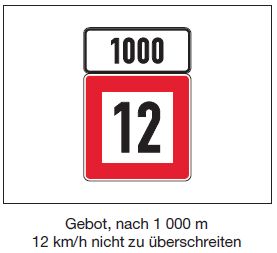 |
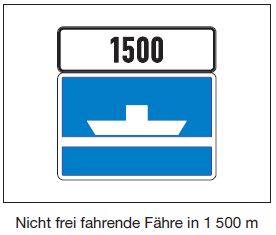 |
| |
|
|
| 2. |
An arrow indicating the direction in which the route is the main character. |
| |
Examples: |
|
| |
a) |
|
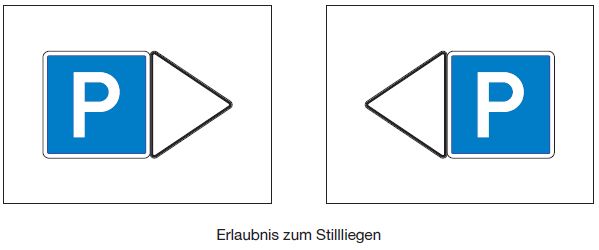 |
| |
|
|
| |
b) |
|
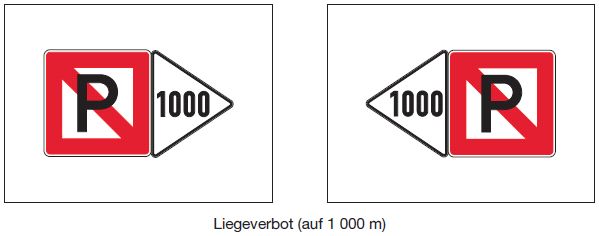 |
| |
|
|
|
| |
c) |
Prohibition of entry into a port or a side waterway which lies in the indicated direction: red light A.1 and luminous arrow
(Section 6.16 (4)) |
|
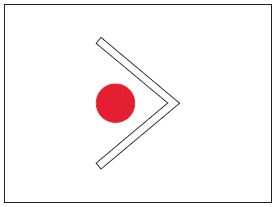 |
| |
|
|
| 3. |
A sign that gives additional explanations or indications. The sign is placed under the main sign. |
| |
Examples: |
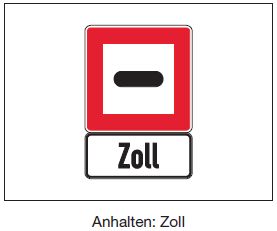 |
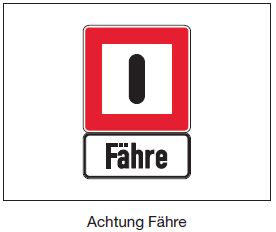 |
| |
|
|
|
|
| |
|
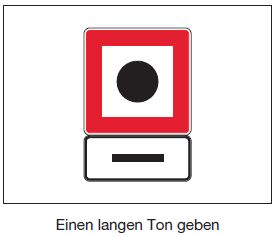 |
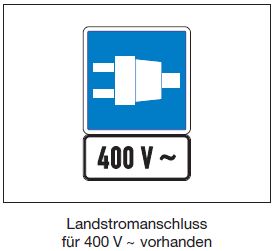 |
Unofficial table of contents
Appendix 8 Designation of the waterway
(Fundstelle: BGBl. I 2012, investment band at No. 1, p. 256-271)
I. General
-
1.
-
Shipping signs
Signs of shipping for the designation of the waterway, the driving channel and the dangerous places and obstacles in and on the water are not continuously set.
A floating navigational sign is anchored about 5 m outside the limits to be recorded.
A buhne or a parallel movement can be designated by a floating or fixed shipping sign. This is generally mounted between or on the poppy head and parallel movement.
A ship's sign must be kept at a sufficient distance, otherwise there is a risk of raking or running up.
A shipping sign can be supplemented with clock fire.
In spite of all the precautionary measures taken by the competent authority, there may be an impairment of a shipping sign; a tonne may be sunk or driven off, and a fire may be extinguishing due to external effects. In the case of high water or ice, the emphasis can be temporarily drawn in. It is the responsibility of the shipowners to take these risks into account when using the shipping signs.
-
2.
-
Terms
-
| |
|
| Fire: |
Light with an identifier that is used for firing. |
|
| |
|
| Bonfire: |
Uninterrupted light appearance of constant strength and colour. |
|
| |
|
| Clock fire: |
A fire with regular reversals in the rhythm of a characteristic rhythm. |
|
| |
|
|
| The following are used: |
|
| |
|
|
| - |
Uninterrupted fire with single interruption:
Ubr. |
 |
| |
|
|
| |
or |
|
| |
with groups of interruptions
Example: 2 interruptions: Ubr. (2) |
 |
| |
|
|
| - |
Common-mode fire: Glt. |
 |
| |
|
|
| - |
Flash fire with single flashes: Blz. |
 |
| |
|
|
| |
or |
|
| |
with groups of 2 flashes: Blz. (2) |
 |
| |
|
|
| |
or |
|
| |
with groups of 2 + 1 flashes: Blz. (2 + 1) |
 |
| |
|
|
| - |
Sparkle fire with permanent sparkle: Fkl. |
 |
| |
|
|
| |
or |
|
| |
with groups of sparkles |
 |
| |
|
| |
Example: 3 Funkel: Fkl. (3) |
| |
|
|
| |
Example: 9 Funkel: Fkl. (9) |
 |
| |
|
|
| |
or |
|
| |
with groups of sparkles and 1 blink |
 |
| |
|
| |
Example: 6 Funkel + 1 Blink: Fkl. (6) + Blk. |
| |
|
|
| - |
Fast sparkle with permanent fast sparkle: SFkl. |
 |
| |
|
|
| |
or |
|
| |
with groups of fast sparkles |
 |
| |
|
| |
Example: 3 fast sparkle: SFkl. (3) |
| |
|
|
| |
Example: 9 fast sparkle: SFkl. (9) |
 |
| |
|
|
| |
or |
|
| |
with groups of fast sparkles and 1 blink |
 |
| |
|
| |
Example: 6 fast Funkel + 1 Blink: SFkl. (6) + Blk. |
| |
|
|
| |
A sparkle fire is sent out with 60 lights/minute and a fast sparkle fire with 100 to 120 light appearances/minute. A Blink will be visible as a light appearance of more than two seconds duration. |
| |
|
|
| |
A fire with individual interruptions or single flashes and with groups of three interruptions or three flashes is referred to as a fire with an odd identifier. A fire with groups of two and four interruptions or lightning flashes is called a fire with a straight handle. |
| |
| II. Designation of the driving channel |
| |
|
|
| 1. |
Right Side |
|
| |
|
|
| |
 |
| |
|
|
| |
Color: |
red |
| |
Form: |
Blunt sun, ton with toppmarks, beacon, float rod (spers) |
| |
Toppcharacters (if present): |
red cylinder (as a rule as a radar reflector) |
| |
Fire (if available): |
red clock fire |
| |
|
|
| 2. |
left side |
|
| |
|
|
| |
 |
| |
|
|
| |
Color: |
green |
| |
Form: |
Dustbin, ton with toppmarks, beacon, floating bar (Spiere) |
| |
Toppcharacters (if present): |
green cone-top top-(usually as a radar reflector) |
| |
Fire (if available): |
green clock fire |
| |
|
|
| 3. |
Fission |
|
| |
|
|
| |
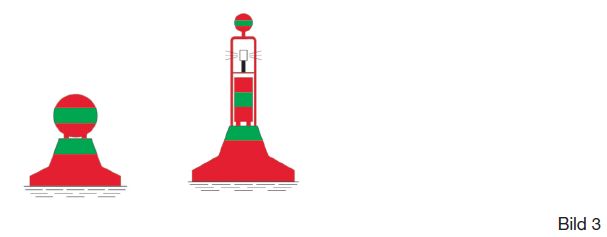 |
| |
|
|
| |
Color: |
red-green striped |
| |
Form: |
Tonne with Toppzeichen, Light Bulb |
| |
Toppcharacters (if present): |
red-green horizontal striped ball (as a rule as a radar reflector) |
| |
Fire (if available): |
white sparkle or common-mode fire: Fkl. or Glt. |
| |
|
|
| |
If necessary, a red cylinder-shaped or a green-cone-shaped toppet above the sign for the splitting of the lane indicates on which side the pre-travel is to be carried out. |
| |
|
|
| 4. |
diversion, injunction, port entrance |
| |
|
| 4.1 |
Right side of the continuous running trough/left side of the branching or injunction drier |
| |
|
|
| |
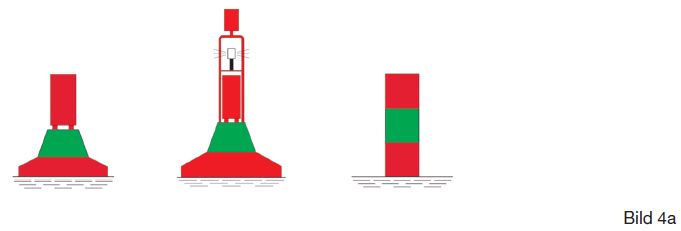 |
| |
|
|
| |
Color: |
red with a green horizontal stripe |
| |
Form: |
Tonne with Toppzeichen, Light Bulb, Swimming Bar (Spiere) |
| |
Toppcharacters (if present): |
red cylinder (as a rule as a radar reflector) |
| |
Fire (if available): |
red flash fire: Blz. (2 + 1) |
| |
|
|
| 4.2 |
Left side of the continuous running trough/right side of the branching or inconding drier |
| |
|
|
| |
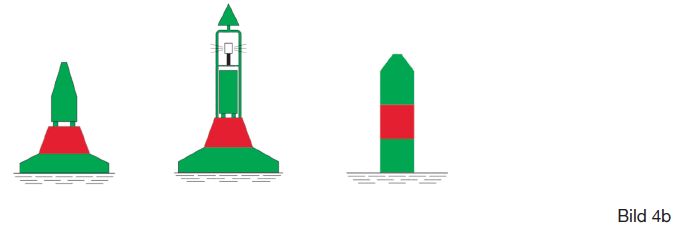 |
| |
|
|
| |
Color: |
green with a red horizontal stripe |
| |
Form: |
Tonne with Toppzeichen, Light Bulb, Swimming Bar (Spiere) |
| |
Toppcharacters (if present): |
green cone-top top-(usually as a radar reflector) |
| |
Fire (if available): |
green lightning fire: Blz. (2 + 1) |
| |
|
|
| |
The positions on the right side of the continuous running trough/right side of the branching or opening lane and the left side of the continuous driving trough/left side of the branching or opening lane shall be taken with the signs according to Figure 1 and Image 2. |
| |
|
|
| 5. |
Interplay between images 1 to 3 (example): |
| |
|
|
| |
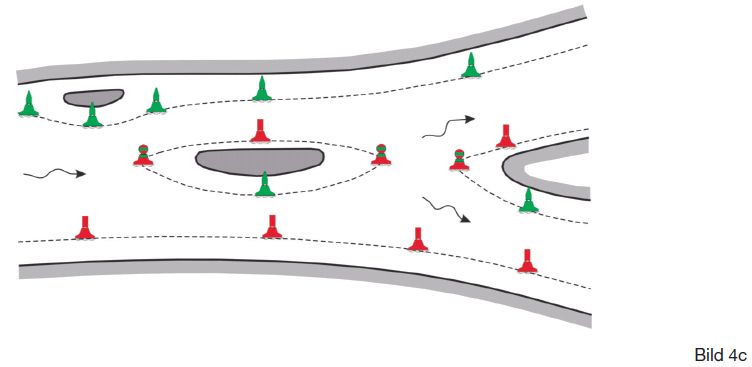 |
| |
|
|
| |
|
|
| III. Name of the waterway as well as an obstacle in or on the waterway |
| |
|
|
| A. |
Fixed characters |
|
| |
|
|
| 1. |
Right Side |
|
| |
|
|
| |
Color: |
red |
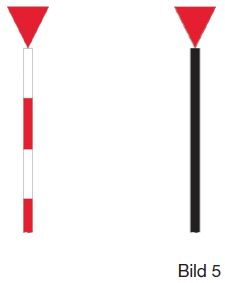 |
| |
Form: |
Pole with Toppzeichen |
| |
Toppcharacters: |
red cone-top bottom-
(as a rule, as a radar reflector) |
| |
Fire (if available): |
red clock fire |
| |
|
|
| 2. |
left side |
|
| |
|
|
| |
Color: |
green |
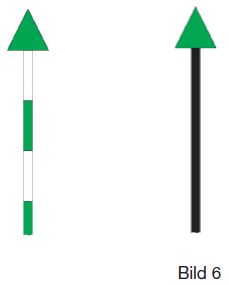 |
| |
Form: |
Pole with Toppzeichen |
| |
Toppcharacters: |
green cone top-top-
(as a rule, as a radar reflector) |
| |
Fire (if available): |
green clock fire |
| |
|
|
| 3. |
Fission |
|
| |
|
|
| |
Color: |
red-green |
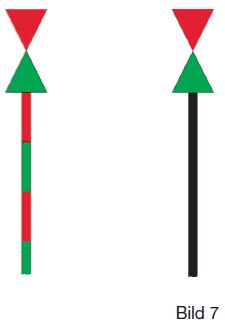 |
| |
Form: |
Pole with Toppzeichen |
| |
Toppcharacters: |
red cone-top bottom-
over green cone top-top-
(as a rule, as a radar reflector) |
| |
Fire (if available): |
white sparkle or common-mode fire:
Fkl. or Glt. |
| |
|
|
| 4. |
diversion, injunction, port entrance |
| |
|
|
| |
In the area of a branch, entrance and port entrance, the waterway can be marked for each side of the waterway to the point of separation by means of the fixed shipping signs as shown in points 1 and 2 (pictures 5 and 6). The trip from the port entrance to the port is considered to be a mountain ride. |
| |
|
|
| B. |
Floating characters (only to name an obstacle) |
| |
|
|
| 1. |
Right Side |
|
| |
|
|
| |
Color: |
red-white horizontal striped |
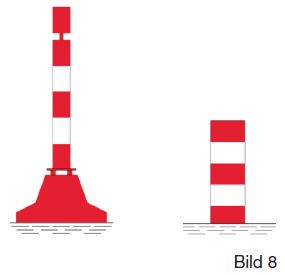 |
| |
Form: |
Spierentonne mit Toppzeichen,
Float rod (Spiere), in which
Rule with radar reflector |
| |
Toppcharacters
(if available): |
red cylinder |
| |
Fire (if available): |
red clock fire |
| |
|
|
| 2. |
left side |
|
| |
|
|
| |
Color: |
green-white horizontal striped |
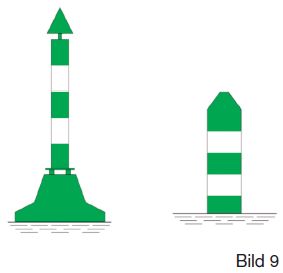 |
| |
Form: |
Spierentonne mit Toppzeichen,
Float rod (Spiere), in which
Rule with radar reflector |
| |
Toppcharacters
(if available): |
green cone top-top- |
| |
Fire (if available): |
green clock fire (usually with radar reflector) |
| |
|
|
| C. |
Interplay between images 5 to 9 with A.4 (example) |
| |
|
|
| |
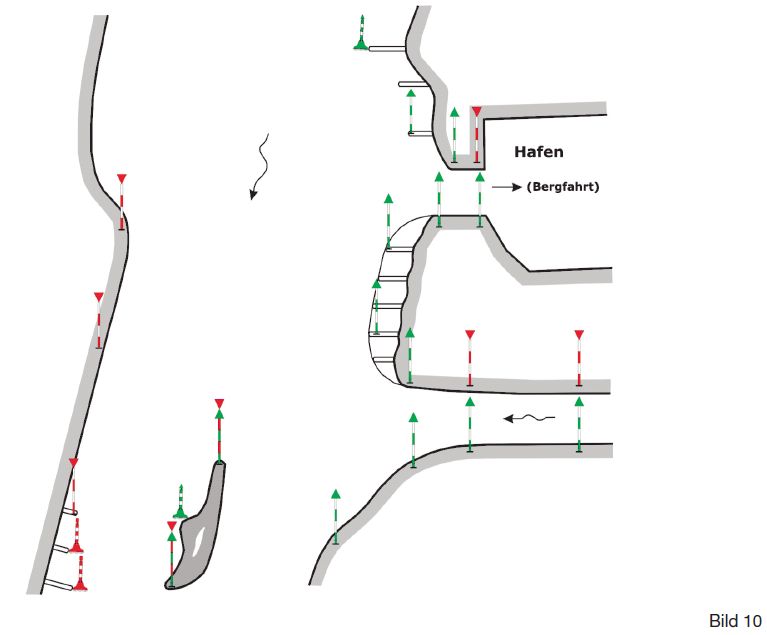 |
| |
|
|
IV. Other options to name
a dangerous spot and an obstacle in the waterway |
| |
|
| 1. |
Passing the speed without lowering the speed on the free side |
| |
|
| |
at night |
by day |
| |
locked page |
locked page |
| |
|
Forbidden sign A.1 |
| |
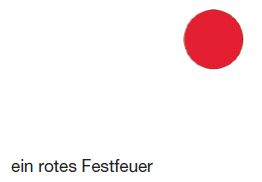 |
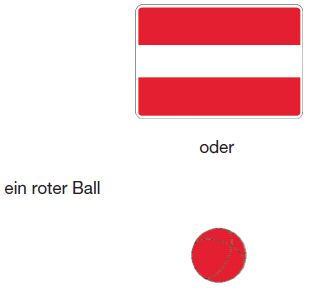 |
| |
|
|
| |
free page |
free page |
| |
|
Note E.1 |
| |
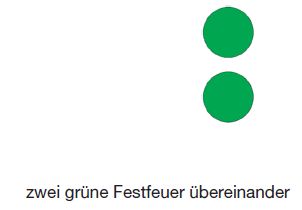 |
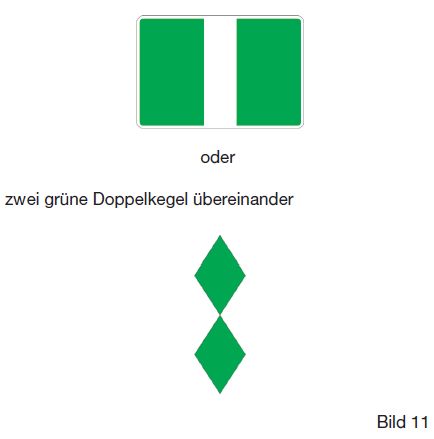 |
| |
|
|
| |
at night |
by day |
| |
|
|
| |
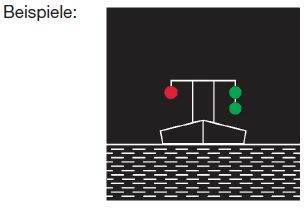 |
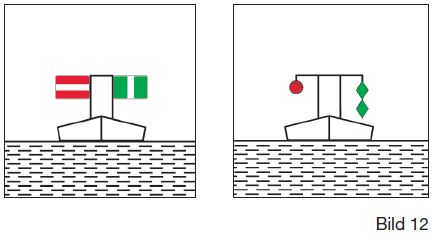 |
| |
|
|
| |
|
| 2. |
Driving past only with reduction of speed allowed on the free side
(Avoid wave stroke) |
| |
|
| |
at night |
by day |
| |
locked page |
locked page |
| |
|
|
| |
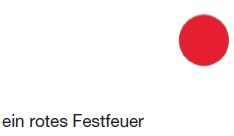 |
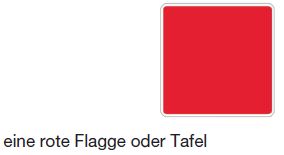 |
| |
|
|
| |
free page |
free page |
| |
|
|
| |
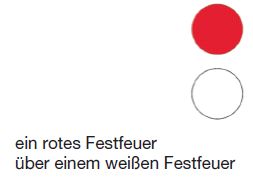 |
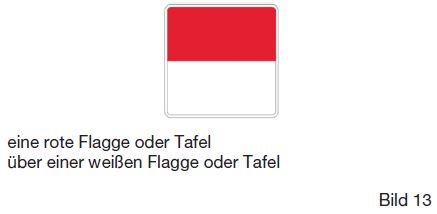 |
| |
|
|
| |
at night |
by day |
| |
|
|
| |
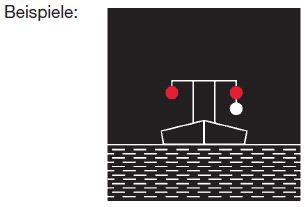 |
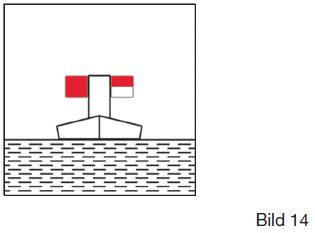 |
| |
|
|
| |
|
|
| V. Additional signs for radar navigation (if necessary) |
| |
|
|
| A. |
Name of a radar target |
|
| |
|
|
| 1. |
Color: |
yellow |
|
| |
Form: |
Tonne with Toppzeichen as a radar reflector
Floating pole (Spiere) with Toppzeichen as radar reflector |
| |
|
| |
in each case, for example, above or below a bridge pillar |
| |
|
|
| |
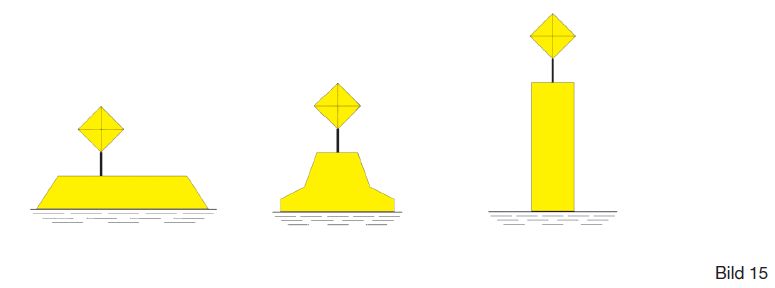 |
| |
|
|
| |
|
|
| 2. |
Pole with radar reflector
(above and below a bridge pillar) |
|
| |
|
|
| |
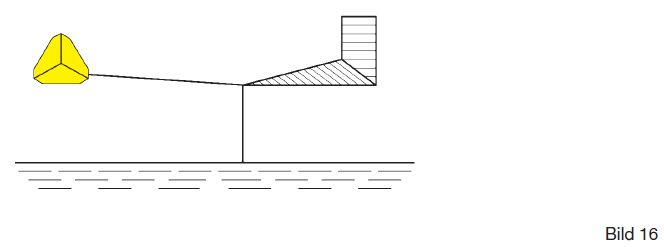 |
| |
|
|
| |
|
| B. |
Designation of a overhead line |
|
| |
|
|
| 1. |
Radar reflectors attached to overhead line
(result in a row of points in the radar image for identification of the overhead line) |
|
| |
|
|
| |
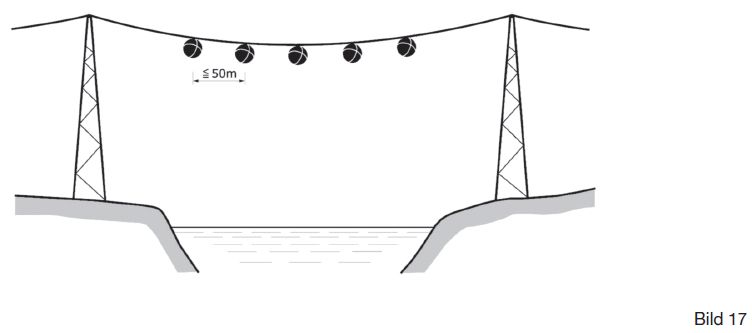 |
| |
|
|
| |
|
|
| 2. |
Radar reflectors on yellow tons on both shores designed in pairs
(in the radar image two points lying next to each other for identification of the overhead line) |
| |
|
|
| |
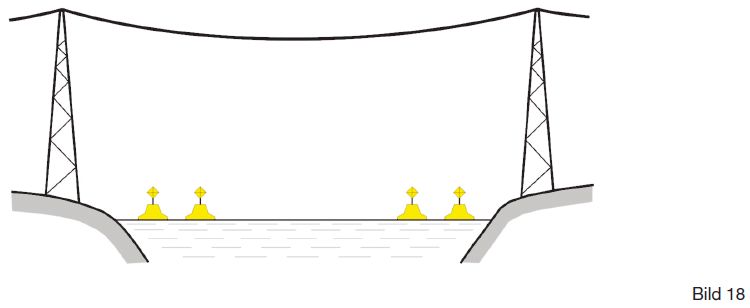 |
| |
|
|
| |
|
|
VI. Description of the location of the driverine to the shore
as well as the transition of the driving channel from one bank to the other |
| |
|
|
| A. |
Location of the driverine to the shore |
|
| |
|
|
| 1. |
Right Side |
|
| |
|
| |
Color: |
red/white |
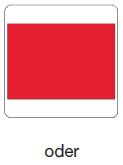 |
| |
Form: |
Pole with Toppzeichen |
| |
Toppcharacters: |
red square table with white horizontal stripes at the top and bottom |
| |
|
|
|
| |
|
or |
| |
|
|
|
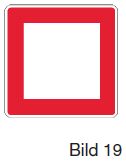 |
| |
|
red square slatted frame |
| |
Fire (if available): |
red clock fire |
| |
|
| |
|
|
| 2. |
left side |
|
| |
|
|
| |
Color: |
green/white |
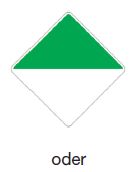 |
| |
Form: |
Pole with Toppzeichen |
| |
Toppcharacters: |
on the top square table, upper half green, lower half white |
| |
|
|
| |
|
or |
| |
|
|
 |
| |
|
green square on the tip of standing slatted frame |
| |
Fire (if available): |
green clock fire |
| |
|
|
|
| |
|
|
|
| 3. |
Interplay of images 19 and 20 (example) |
|
| |
|
|
| |
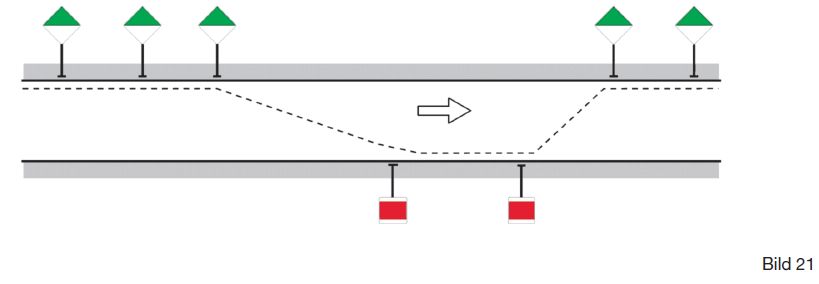 |
| |
|
|
| |
|
|
| B. |
Crossing of the running channel from one bank to the other |
|
| |
|
|
| 1. |
Right Side |
|
| |
|
|
| |
Color: |
gelb/black |
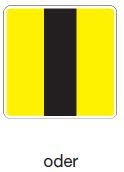 |
| |
Form: |
Pole with Toppzeichen |
| |
Toppcharacters: |
yellow square board with a vertical black midstripe |
| |
|
|
| |
|
or |
| |
|
|
|
| |
|
yellow standing Lattenkreuz |
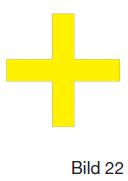 |
| |
|
|
| |
|
|
| 2. |
left side |
|
| |
|
|
| |
Color: |
gelb/black |
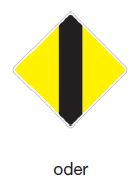 |
| |
Form: |
Pole with Toppzeichen |
| |
Toppcharacters: |
yellow on the top square panel with a vertical black midstripe |
| |
|
|
| |
|
or |
| |
|
|
|
| |
|
yellow lying slatted cross |
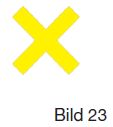 |
| |
|
|
| |
|
|
| 3. |
Interplay of images 22 and 23 (examples) |
|
| |
|
|
| 3.1 |
Label by individual beacons |
|
| |
|
|
| |
 |
| |
|
|
| |
Fire (if available): |
left side: |
yellow clock fire with odd identification |
| |
|
right side: |
yellow clock fire with a straight handle |
| |
|
|
|
| |
|
|
|
| 3.2 |
Designation by straightening beacons |
|
| |
|
|
|
| |
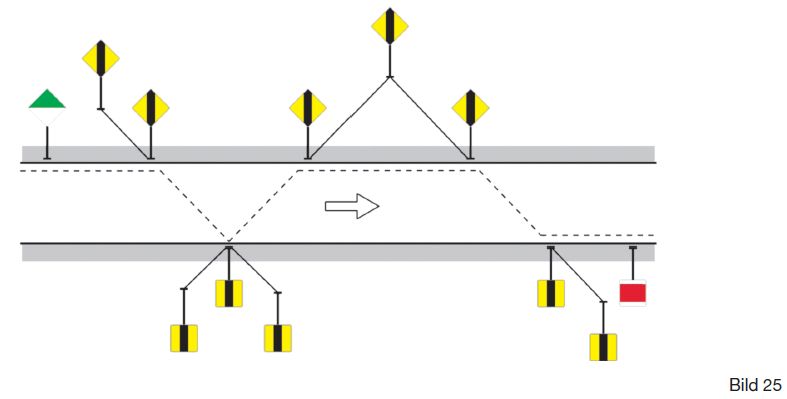 |
| |
|
|
|
| |
A pair of directional bakers consists of upper and lower beacs. They denote the direction of the transition in the cover bearing. The upper bake is seen from the ship behind the lower beacon and is higher than this. |
| |
|
|
|
| |
Fire (if available): |
both sides |
Unterfeuer: |
yellow common-mode fire |
| |
|
|
Oberfeuer: |
equal to Unterfeuer or yellow bonfire |
| |
|
|
|
| |
|
|
|
| VII. Additional designation for a lake and a sea-like extension |
| |
|
|
|
| A. |
Designation of a dangerous site and an obstacle |
| |
|
|
|
| 1. |
Cardinal characters |
|
| |
|
|
|
| |
A general danger site (e.g. B. Indepth, wreckage, bugles and other shipping notices) is usually referred to as one or more cardinal signs indicating the location of the danger site for the different quadrants. |
| |
|
|
|
| 1.1 |
Definition of the quadrants and cardinal characters |
| |
|
|
|
| |
The four quadrants (North, East, South and West) are limited by the directions NW-NO, NO-SO, SO-SW and SW-NW from the reference point. |
| |
|
|
|
| |
A cardinal character is named after the quadrant in which it is located. |
| |
|
|
|
| |
The name of the cardinal character indicates that it is to be passed along the page of the character after which it is named. |
| |
|
|
|
| |
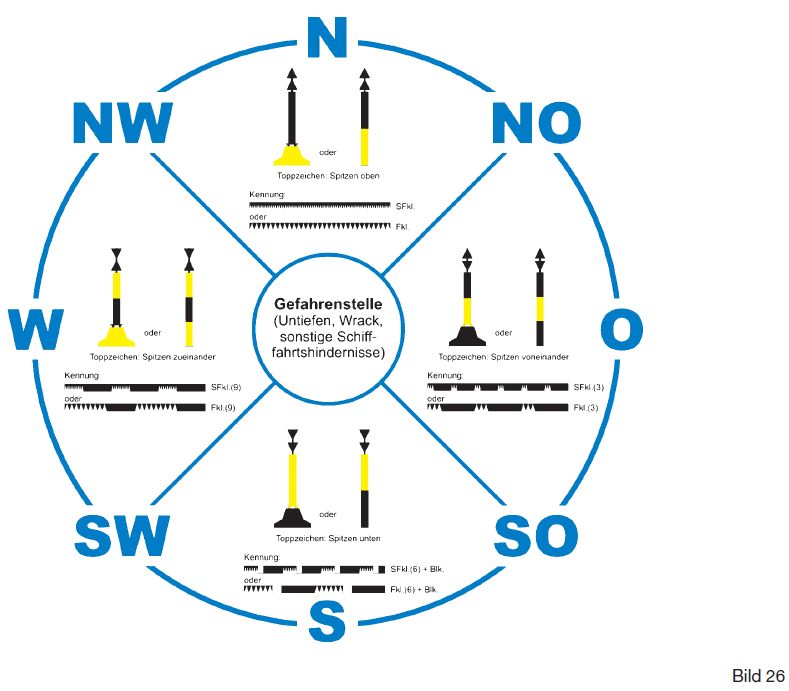 |
| |
|
|
|
| 1.2 |
Cardinal Character Description |
|
| |
North Cardinals |
|
| |
|
|
|
| |
Color: |
black over yellow |
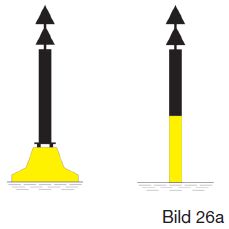 |
| |
Form: |
Spierentonne with Toppzeichen, Swimming rod
(Spiere) with Toppzeichen |
| |
Toppcharacters: |
two black cones one above the other
-Tops up- |
| |
Fire (if available): |
white sparkle Fkl. or white snoring
Funkelfeuer SFkl. |
| |
|
|
|
| |
|
|
|
| |
East Cardinals |
|
|
| |
|
|
|
| |
Color: |
black with a broad yellow horizontal stripe |
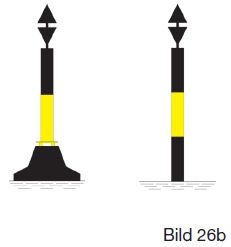 |
| |
Form: |
Spierentonne with Toppzeichen, Swimming rod
(Spiere) with Toppzeichen |
| |
Toppcharacters: |
two black cones one above the other
-tips from each other- |
| |
Fire (if available): |
white sparkle Fkl. (3) or white snoring
Funkelfeuer SFkl. (3) |
| |
|
|
|
| |
|
|
|
| |
South Cardinals |
|
| |
|
|
|
| |
Color: |
yellow over black |
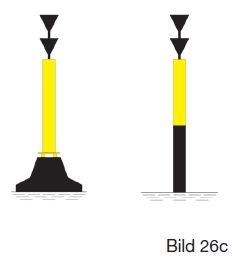 |
| |
Form: |
Spierentonne mit Toppzeichen, Floating Bar (Spiere) mit Toppzeichen |
| |
Toppcharacters: |
two black cones one above the other
-Tops down- |
| |
Fire (if available): |
white sparkle Fkl. (6) + Blk. or white
Fast sparkle fire SFkl. (6) + Blk. |
| |
|
|
|
| |
|
| |
West Cardinals |
|
| |
|
|
|
| |
Color: |
yellow with a wide black horizontal stripe |
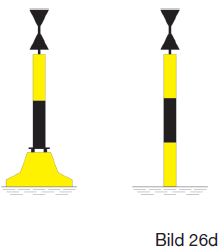 |
| |
Form: |
Spierentonne with Toppzeichen, Swimming rod
(Spiere) with Toppzeichen |
| |
Toppcharacters: |
two black cones one above the other
-Points to each other- |
| |
Fire (if available): |
white sparkle Fkl. (9) or white snoring
Funkelfeuer SFkl. (9) |
| |
|
|
|
| |
|
|
|
| 2. |
Single-Signed |
|
|
| |
|
|
|
| |
A single sign is erected or designed above a single hazard. The danger site can be passed on all sides. |
| |
|
|
|
| |
Color: |
black with one or more wide red
horizontal stripes |
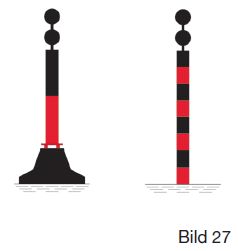 |
| |
Form: |
Spierentonne with Toppzeichen, Swimming rod
(Spiere) with Toppzeichen |
| |
Toppcharacters: |
Two black balls one above the other |
| |
Fire (if available): |
white lightning flare. (2) |
| |
|
|
|
| |
|
|
|
| B. |
Designation of the middle of a driveway, a waterway, a control and a driveway entry |
| |
|
|
|
| 1. |
Mittefahrwasserzeichen |
|
| |
|
| |
At both sides of the driving watermark, a water depth corresponding to the approved discharge depth is provided. |
| |
|
|
|
| |
Color: |
red-white vertical striped |
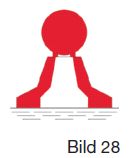 |
| |
Form: |
Metric ton with Toppcharacters (usually as a radar reflector) |
| |
Toppcharacters: |
red ball |
| |
Fire (if available): |
white clock fire: Ubr., Glt. or Blz. |
| |
|
|
|
| |
|
|
|
| 2. |
Additional designation of a drivetrain and a control |
| |
|
|
|
| |
A control fire is a single fire, which in general refers to a driveway, a port entrance or a free space between shunts by sectors of different colour and identification. The running water section is identical to the white sector of the guide fire. |
| |
|
|
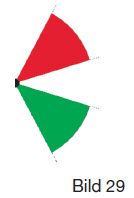 |
| |
Fire: |
white clock fire: Ubr. or Glt. with warning sectors red and green. |
| |
|
|
|
| |
|
|
|
| 3. |
One-way character |
|
| |
|
| |
The entry mark is used to identify the entry of a lake or a sea-like extension into a relatively narrow waterway section. |
| |
|
|
|
| |
Color: |
white-black striped or black-and-white striped |
|
| |
Form: |
Pole with Toppzeichen |
|
| |
Toppcharacters: |
Right bank: |
Diamond from vertical latchwork |
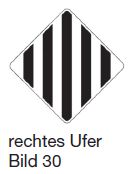 |
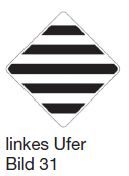 |
| |
|
Linke's bank: |
Rushing out of horizontal slats |
| |
Fire (if available): |
Right bank: |
red clock fire |
| |
|
Linke's bank: |
green clock fire |
| |
|
|
|
| |
|
|
|
| 4. |
Interplay between images 26 to 31 and image 34 (example) |
| |
|
|
|
| |
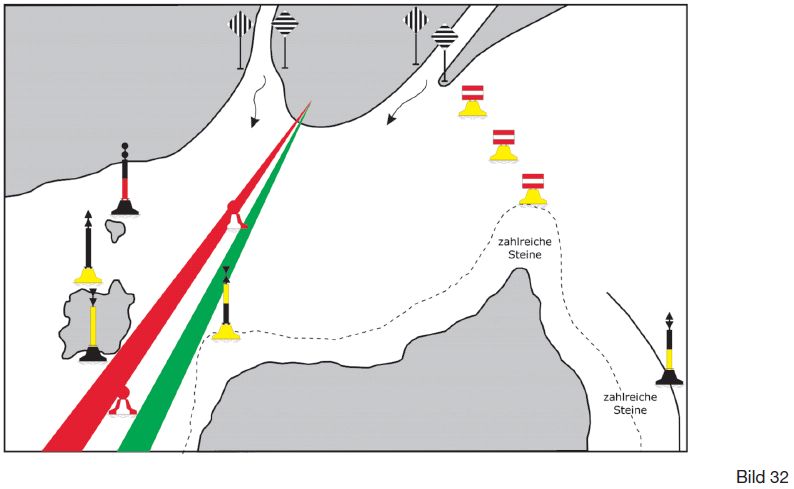 |
| |
|
|
|
| |
|
|
|
| VIII. Name of a special water surface |
| |
|
|
|
| 1. |
Tonnes for a blocked water surface |
| |
|
| |
Yellow dull columns (picture 33) or yellow tons (picture 34) with or without radar reflectors or with or without toppmarks characterize a locked water surface. In particular, the characters according to Appendix 7 can be used in the form of plates or cylinders as a toppy character. |
| |
|
|
|
| |
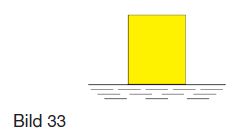 |
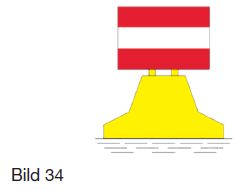 |
| |
|
|
|
| |
|
|
|
| 2. |
Tonnes for other purposes |
| |
|
| |
White tonnes may be used for purposes other than those mentioned above. In particular, the characters according to Appendix 7 can be used in the form of plates or cylinders as a toppy character. |
| |
|
|
|
| |
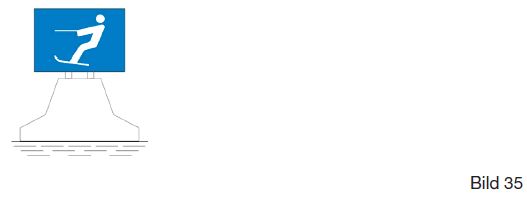 |
| |
|
|
|








































